THE ROYAL LOGISTIC CORPS FOUNDATION
REVIEW


#BritishArmyLogistics
Bringing together logistics professionals from Defence, Industry and Academia 2024 THE RLC
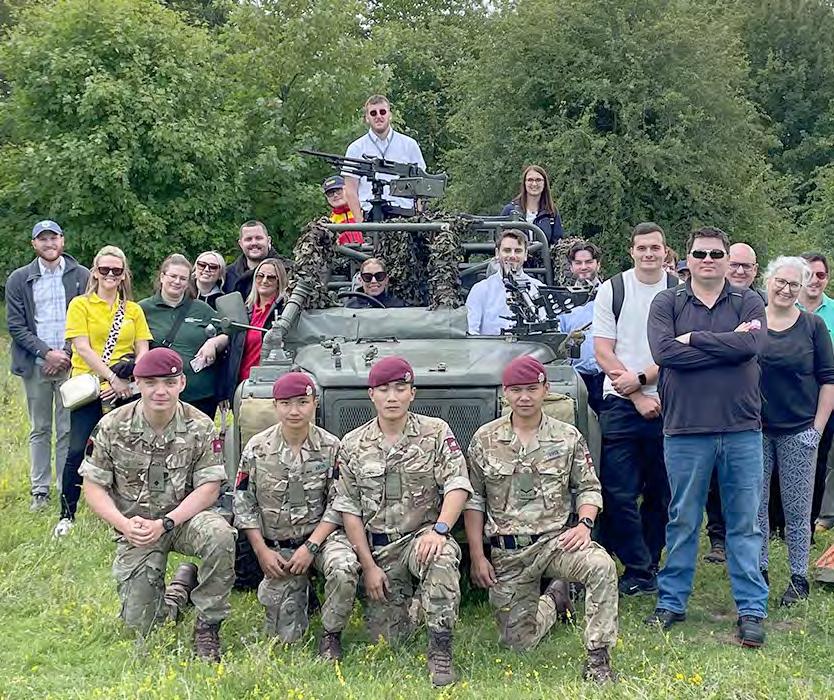

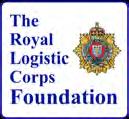


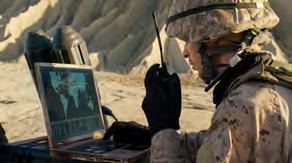
Care & protection of materials Land Sea Inbound to manufacturing Defence logistics compliance Physical movement of assets internationally Air
THE ROYAL LOGISTIC CORPS FOUNDATION THE REVIEW 2024 | 1 CONTENTS 8
2 – Foreword. By Maj Gen Angus Fay CB 6 – Great leaders must also be good followers. An interview with Brig Patch Reehal MBE 14 - Was it easy? Was it worth it? An interview with WO1 Susan Kier RLCF SPECIAL 18 – Additive manufacturing and the MOD. By Mr Peter Shakespeare HISTORY 22 – Cutting the Centre Line. Op GARDEN case study. By Maj Colin Taylor RLC 35 – Promotional Feature. The Duke of York’s Royal Military School. 36 – The Arsenal of the Alliance. Lend and Lease. By Maj Andrew Cox RLC PROFESSIONAL DEVELOPMENT 42 – The Army Higher Education Pathway. 44 – Understanding Effective Reflective Practice. By Maj Leon Berry AGC 47 – Leading Through Workforce Challenges. By Capt Louis Trup RE 52 – Leading a Different Generation. By Capt Aidan Welch R IRISH OPERATIONS & TRAINING 55 – The Enablement and Reinforcement of NATO. By Maj Nicole Evans RLC 61 – 17 Port & Maritime Regiment RLC. By Maj David Levens RLC GENERAL INTEREST 66 – Is the Ukraine Crisis the West’s Fault? By Lt Bethan Lambe RAMC 70 – Recognising Health as a Vital Component of Security. By Lt Gethyn Chadwick RLC 76 – How will Robotics and AI shape conflict? By Capt Simon Smith RLC 80 – Should The RLC adopt a four-day week? By Lt Barney Lowe RLC 84 – The Prince Consort’s Library 86 – The MGL’s Reading List 2024 90 – The RLC Foundation Book Club 97 – Glossary of Terms Security: This Review contains official information. It should be treated with discretion by the recipient. ©Crown Copyright: All material in this Review is Crown Copyright and may not be reproduced without the permission of the Regimental Association of The Royal Logistic Corps. ©Cartoons are copyright. Disclaimer: No responsibility for the quality of the goods or services advertised in this Journal can be accepted by the publishers or their agents. Advertisements are included in good faith. The contents of this Journal and views of individual authors or units does not necessarily reflect the policy and views, official or otherwise, of the Corps or Ministry of Defence. Data Privacy: We distribute The Review using mailing data held in a secure contacts database within RHQ The RLC. Your inclusion on this database is by virtue of the fact you are serving in the military, or you are a current member of the RLC or Forming Corps Associations. The RLC Association only uses your personal data for the purpose of sending you the magazine. The mailing data is treated in the strictest confidence, is password protected, is only shared with our printer and is deleted after each use. If any serving RLC personnel have concerns with regards to the storage and use of their personal data they should contact RHQ The RLC's Data Protection Officer is Maj Carnegie-Brown. Email: Alistair.Carnegie-Brown100@ mod.gov.uk. Members of the Associations should contact RHQ The RLC's Personal Information Risk Manager. Email: RLC RHQ-RegtSec-SO2-Asst@mod.gov.uk Cover photographs are from The Sustainer magazine Editor: Mr Peter Shakespeare Assistant Editor: Anne Pullenkav Graphic Design: David Blake Printed by: Holbrooks Printers Ltd.
THOUGH LEADERSHIP

Welcome to the RLC Foundation’s 2024 Review. For industry, wider Defence, the Army and the Corps, the marked increase in polarization of international relations over the past year has resulted in a significant shift in the character of a broad range of security concerns.
The war in Ukraine continues to refocus how NATO and its allies have to address the immediate European threat posed by Russia, made more challenging by conflict in the Middle East. In CGS’ last two RUSI Land Warfare keynote speeches, he emphasised his singular focus; Operation MOBILISE, with the strategic intent to help prevent a general war in Europe. Whilst he identified that the Army, within a wider joint/coalition context, must be able to function across all five operational domains, he stipulated that any decisive effect would probably take place within the Land domain. The implications for The RLC and its corporate partners might seem obvious, but there are some nuances which may determine how some of the Corps’ functions are to be delivered in the near future.
Whilst there are similarities to the conflicts in Ukraine and Gaza, there are also some stark dichotomies which need to be considered if our contingency plans are to remain credible. Experiences from Ukraine could generally be considered as a contest to survive and operate in a dispersed battlespace where deep strike, stand-off surveillance and temporal mass all play a part in state-on-state actions – not so in Gaza. As witnessed in the cities of Grozny and Sadr, the urban environment presents a different character to the spectrum of conflict and requires the careful application of a diverse set of skills and technologies to operate within them. Today, over half of us live in urban areas, with more than 80% of GDP generated from within this subenvironment. To support efficient social living, by 2050, it is envisaged that 68% of the world’s population will dwell in what could be categorised as an urban area. Congestion epitomises this land sub-domain, made up of thousands of structures, millions of civilians and reduced opportunity to employ complex weapon systems or the ability to manoeuvre for advantage. It seems logical therefore that if a desired military effect is to be realised in this domain, military forces will be compelled to compete in this highly attritional, uniquely human environment, whilst concurrently prosecuting other operational lines of development across a dispersed battlespace. For liberal democracies, applying military power within urban areas poses a myriad of complex challenges.
Due to their adopted doctrines, Western armies generally want to operate across broad vistas, where
their manoeuvrist approach and complementary technologies can best be applied, and where advantage is maximised by deep strike, teed-up by stand-off intelligence assets, all designed to mitigate risk to friendly forces. Based on the actions of the belligerents participating in the 55 global conflicts currently recognised by the UN, it seems unlikely that technology alone will help formulate credible strategies. Challenging economic factors, partially driven by growing environmental considerations, are likely to accelerate this belief in efficient urban living, posing further challenges for our armed forces. These challenges are exacerbated by the adherence to accepted democratic liberal values, monitored by a rules-based international system, fueled by a 24-hour media cycle. In this fetid environment, potential breaches of legality and proportionality not only threaten to compromise coalition consent but may also jeopardise the support from national home fronts. Technological solutions that offer an advantage across a dispersed battlespace can be significantly nullified in these choked and scrutinized urban areas. Even stand-off weapon systems, slaved to the latest sensor technologies, can be compromised in cities. The lethal effects of precision weapon systems are likely to be degraded due to risk aversion or may even be deemed unsuitable. In this context, the complex operating environment just got more complex, with the result that the British Army, and by default The RLC, must possess the capabilities to survive and operate against a peer enemy, using a broad spectrum of skills and technologies. In order to compete in such a febrile environment, the current CGS identified that Defence must harness every advantage where, “we must take industry with us and have the right relationships with our enabling agents to deliver…the ambitious targets we have set ourselves.”
The RLC Foundation was designed to operate within this broad coalition of military and commercial enabling partners. If the Army is to mobilise and meet the nation’s immediate threats, CGS recognises that industry is a vital component in achieving the desired future strategic and operational endstates. Every generation believes it lives in extraordinary times, but we must be careful that our lived experiences are not allowed to skew our vision for future contingency planning or fall into the trap that specific novel technologies offer a panacea to combatting every emerging threat. What is clear is that we have to continually adapt and adopt approaches that support what has been labelled a high tempo prototype war, whilst cognisant of the relevance of hard-won historic experiences.
Anyone who participated in, or witnessed, the
8 FOREWORD
2 | THE REVIEW 2024 THE ROYAL LOGISTIC CORPS FOUNDATION
British Army’s largest formation exercise in two decades (Exercise IRON TITAN 2023), will be left in no doubt what Commanders 3rd UK Division and 101 Operational Sustainment Brigade were aiming to expose. We are now clearly evolving from a mechanized force to a digitized one. If we are to harness the benefits of the fourth industrial revolution, we have to quickly identify emerging technologies, reinvest in stockpiles, become comfortable with rapid training regimes and normalize the fielding of partial solutions, whilst continually upskilling our workforce - all in line with commercially competitive timelines. This is why, with industry’s support, we have to accept the necessity of deploying with a large proportion of prototype solutions. Whilst our workforce has proven to be agile at rapidly adopting cutting-edge technologies, we have to recognise the capabilities and limitations of our industry partners. Perversely, in an effort to maintain a competitive edge, successful commercial enterprises have operated for decades with a lean approach to managing expensive resources. Unlike the shadow factories administered and funded by central government in the last war, industry, by design, has little built-in latent capacity for increasing productivity at short notice. Mobilisation is therefore not restricted to the military domain, and a greater understanding of commercial practices, capabilities and limitations is needed if expectations are to be managed and Defence is to avoid being caught short.
In essence, this is where the RLC Foundation offers an insight for all its members into the capacities and capabilities of the military and corporate worlds. Over the last year, over 400 members have physically participated in a dozen Foundation events across the country, with many more benefiting virtually. We have successfully attracted three new corporate organisations and welcomed individual honorary membership from senior appointments in the Royal Navy and Royal Air Force. In line with CGS’ intent, the critical requirement to develop deep seated understanding across Defence and industry is being directly supported by the RLC Foundation and its corporate members. In many ways, the articles in this Review are testament to this augmented partnership approach. The four submission categories have once again attracted some high-quality articles ranging from specific NATO structural transition, to upskilling opportunities, analysis of historic campaigns which help to expand our lived experiences and reflection on some emerging technologies. I’m also delighted that
RLC Foundation Review
The 2024 RLCF Review Best Article: Major Colin Taylor RLC - £200
for the first time we have submissions from students on the Army Higher Education Pathway (AHEP) together with their reflection pieces. Whilst readers may not agree with all of the author’s conclusions and recommendations, each article has been selected for its thought-provoking analysis and insights. Once again, I congratulate all authors who have been selected for publication. Some authors have the added bonus of being recognised with the award of a cash prize and I thank our corporate members for their continued generosity and support to the RLC Foundation Review in this particular area. With this in mind, I encourage commanders and managers at all levels and from across every category of membership, to seek out and support potential authors in submitting articles – everyone has a valid opinion, lived experience and/or vision, I would ask that you enable them to share it in the 2025 RLC Foundation Review.
As well as the Review articles, I am delighted that much of the changing environment described above is captured in interviews from two of the RLC’s gifted leaders; Brigadier Patch Reehal MBE and WO1 Susan Kier. Their backgrounds, experiences, challenges and opinions are unsurprisingly different, but their attitudes and thoughts on the British Army are candid and reassuringly similar.
Finally, for the first time, you will find MGL’s Professional Reading List has been published in full in this Review. This list was initiated by the Foundation some years ago and publication entrees have been managed over the last three years on our member website. The quarterly updating of the list is undertaken by systematic corralling of publications and mixed-media from across a broad spectrum of disciplines – all relevant to military/commercial logistic practitioners. To date, well over a hundred books, journal articles and mixed-media products have been reviewed and published on the Foundation website by the in-house Book Club, whose aim is to keep MGL’s list current. To supplement MGL’s Reading List, this Review also includes an extended Book Club, authored by an academic who focuses on one of the acute conundrums for the human race – adaptive AI and some of its potential implications.
I hope you enjoy this year’s wide-ranging RLC Foundation Review. I look forward to receiving your submissions, ideas and publication selections for our 2025 edition.
Angus Fay CB MMAS FCMI FCILT Chairman, The Royal Logistic Corps Foundation
2024 Prize Winners
History Category: Maj Colin Taylor RLC - £150 ‘Cutting the Centre Line - Operation Garden, ‘Hell’s Highway’ and ‘Porous’ front lines’.
Professional Development CategoryMaj Leon Berry AGC - £150 - Understanding Effective Reflective Practice.
Ops & Trg Category: Maj Nicole Evans RLC£150 - Planning Enablement and Reinforcement of NATO forces at scale; the key role of the Joint
Support and Enabling Command (JSEC) in NATOs Deterrence and Defence of the Euro Atlantic Area and implications for the UK.
General Interest Category: Lt Bethan Lambe RAMC£150 - The Ukraine Crisis is the West’s Fault: An Evaluation of John Mearsheimer’s Structural Realist Claim.
Special Merit Award - Capt Simon Smith RLC - £100 - How will robotics, autonomous systems, and artificial intelligence shape conflict?
FOREWORD 8 THE ROYAL LOGISTIC CORPS FOUNDATION THE REVIEW 2024 | 3
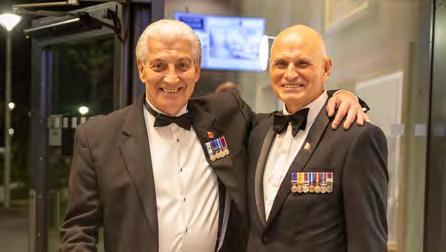
What is it?
The RLC Foundation was established in 2015 to provide the focus for engagement with industry and academia, for the purpose of professionalising
The RLC’s officers and soldiers. As we enter our eighth year, we have established strong working relationships with a wide range of industry partners and many academic institutions. Our corporate partners, supporters and friends continue to enable the Foundation to flourish and develop it’s professional and academic standing within the community at large. One of our main objectives is to enable members of the Corps (regular, reserve and veterans) to follow a professional career development path which is recognised with credibility as logistic professionals within Defence and across industry. We are already seeing the benefits of our collaboration with industry and academia across many on-going initiatives. There are obvious benefits for those in career transition and our website www.rlcfoundation.com has links to career opportunities with our corporate partners.
Where is it?
The RLC Foundation is based at 101 Log Bde, Wellington House, St Omer Bks, Aldershot. Both Alan and Marti work from the office and occasionally from home and can be contacted at: rlcfwoods@ gmail.com or therlcfoundation@gmail.com
What does it do?
The Foundation runs a diverse range of national events with industry and academia as well as supporting
regional events in support of the RLC’s Regular and Reserve regiments. Over the past year we have run a hybrid of live and virtual events and these have both been well supported by the Corps at large and our corporate membership. Our main events for 2024 are:
15 Feb - Defence Support Training & Transformation Conference, T1, Bldg 101, Worth Down Camp
18 Apr - DHL Supply Chain Insight Day at East Midlands Gateway, Kegworth, Derby
Apr (date tbc) - Unipart event
15 May - Navy Command HQ visit and brief of maritime logistics, Portsmouth
Jun (date tbc) - RAF event. Either Air Power demo or visit to a RAF operational airbase
5 Jul - Corps Cocktail Party, Worth Down Camp
16 Jul - Exercise LOG SAFARI, Barton Stacey Training Area
Sep (date tbc) - 13AASR Military Planning Event, Colchester Oct (date tbc) - PA Consulting event, Cambridge
19 Oct - Logistic Leaders Network Annual Awards Dinner, Crowne Plaza Hotel, Stratford-upon-Avon
26 Nov - RLCF Awards Dinner, Combined Mess, Worthy Down Camp
Why Should I join the RLC Foundation?
We offer a wide range of events throughout the year, giving our corporate members exposure to The RLC and its people. This is a unique opportunity to interact over evolving logistic capability and promote best practice between The RLC, industry and academia. We are actively seeking new members and the three levels of membership can be seen below.
Our website address is www.rlcfoundation.com
We are also on Facebook and LinkedIn. Please feel free to contact us if you need more information about the RLC Foundation.
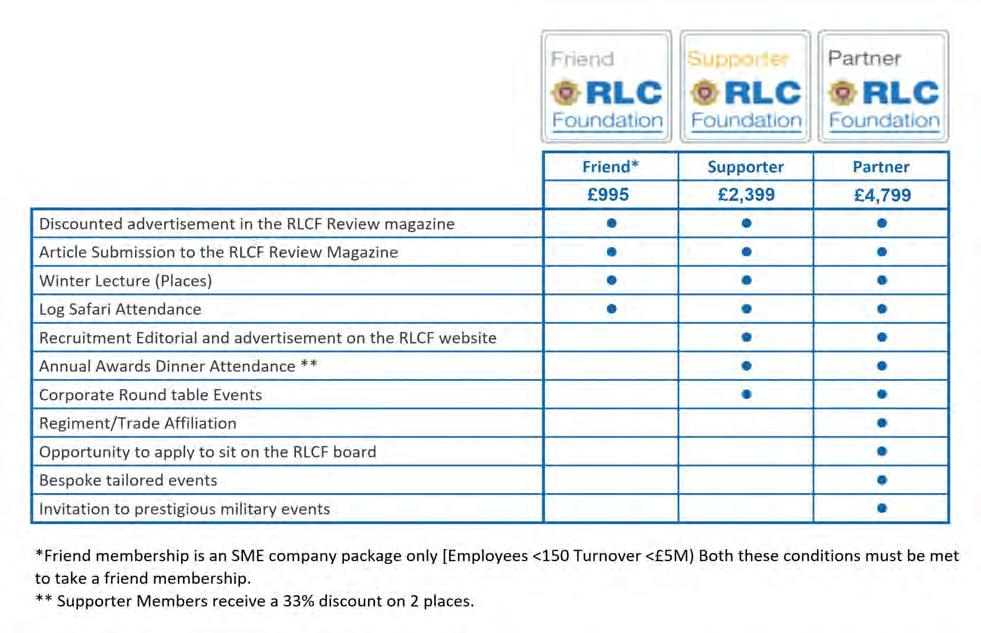

8 ABOUT THE RLC FOUNDATION 4 | THE REVIEW 2024 THE ROYAL LOGISTIC CORPS FOUNDATION
C M Y CM MY CY CMY K
8 RLC Foundation Director, Alan Woods and Business Support Manager, Marti Jerrard
In spi r e. Empo w er. Deliv er.
Proudly committed to supporting service leavers in pursuing new careers
From Drivers to Warehouse tradespeople, Account Managers to Solution Developers, we’ve got a range of roles available across the UK. Join our team and you’ll get extensive training, professional development, CPC driver license conversion and competitive rates of pay.
As a Gold Armed Forces Covenant holder, we’re committed to supporting the Armed Forces and Defence communities. We believe in bringing people and goods closer together by innovative and sustainable business solutions across air, road, sea and contract logistics.


Scan this QR code to find your next career opportunity

Great leaders, must also be good followers
In late 2023 The RLC Foundation was fortunate to speak at length with the then Commander 101 Operational Sustainment Brigade, Brigadier P.S. Reehal MBE, about leadership, the future direction of CSS and the vital part reading plays in personal and professional development
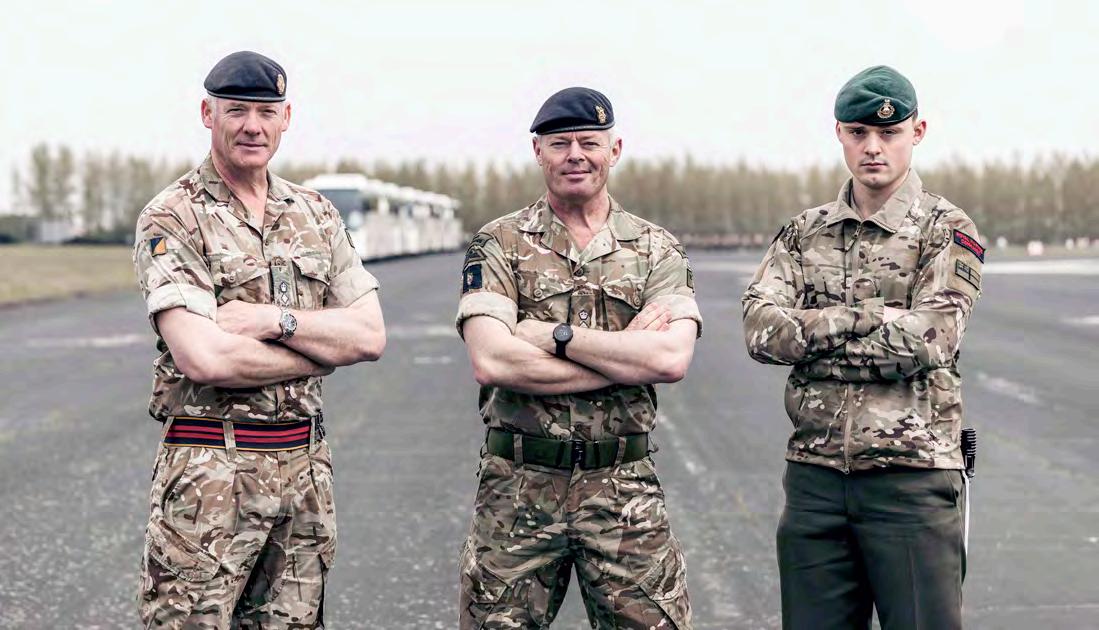
Considering your previous postings, training and experiences, how well prepared were you for your formation command appointment?
Pretty quickly, you come to realise that everyone is an incomplete leader and that we all need to adopt a philosophy of persistent learning. With effort, no matter how good you are, or think you are, we can all get better. I come from a background with a very long martial apprentiship – some outside of the Army. I’m one of three brothers, all of us have served. My middle brother, Ben, is currently one of my commanding officers (27 Regt) and my youngest brother, now a doctor, served as a pilot in the Fleet Air Arm. He continues to serve as a medical officer to one of the Rifle battalions. So, there is a common thread between us, and I’m being sincere when I say that I’m a patriot. I believe in service to the nation, albeit that I recognise that it’s a slightly unfashionable way of expressing your convictions. Much of my belief is cultivated from a rich seam of military service throughout my family. Both my parents served. My mother, despite having to leave the Army in 1975 to have me, still looks back at her service with a sense of pride. My father, with three serving generations from Irish heritage before him, completed 36 years in the military. He started in the Royal Marines then
transferred to the Royal Signals, later commissioning into the Royal Corps of Transport, the first officer in the family. He finished his long career in the RLC. At one point, the three serving Reehals were joined by my uncle’s son Jamie. Now, without prompting, both of my sons are serving with the Royal Marines.
I’m in no doubt that this formative growing up period overseas, within a close Army community, helped to shape my character. This positive cultural experience still influences my contemporary decision making. I came to appreciate what the Army could offer, not only as a career, but a way of life. When I look back at my family lived experiences, and I sometimes employ this knowledge on our operational teamwork days, I use it to exemplar the significant changes that have occurred in the military during the relatively short period of my and my parent’s lifetime. This is important. There might be points in time when we think that the Army is trying to overcorrect something very quicky, instant reaction if you like. In reality however, it has just reached a natural pivot where the Army is correcting something that it has always suspected to be wrong. My pre-service, lived experiences have therefore provided me with a degree of first-hand knowledge of an Army in a state of constant transition, albeit, Q A
8 RLC FOUNDATION INTERVIEW 6 | THE REVIEW 2024 THE ROYAL LOGISTIC CORPS FOUNDATION
sometimes at a frustratingly pedestrian pace. From these experiences, I find that I can better judge the changing environment we find ourselves in. I suppose what I’m talking about is having the luxury of a longer perspective on the military community at large – an extended lived martial experience compared to many of my peer group. It’s something that I find myself tapping into when I’m required to consider a whole range of complex cultural and operational challenges. Taking my mother’s experience as a single frame of reference; it wasn’t until the 1990s that the regulations were changed for pregnant personnel to remain in service. When we therefore think of short, medium and long-term changes, I have witnessed, first-hand, the military institution making some significant modifications and amendments to our conditions of service. So, this was the environment that I was incubated in, a long and informal apprentiship with priceless experiences of the conceptual, physical and moral components of the Army. To offer another personal insight, my father served in the first Gulf War whilst I was at school. I remember watching the operation on television. From that immersive experience I have always thought more broadly than operational missions. I constantly reason how we prepare and stay connected with the home base to support our families as part of the wider moral component. I think this is largely down to the fact that before I joined the Army, I’d experienced over ten years of schooling in garrison life and was subsequently immersed in the broader aspects of the Army’s values, standards and challenges.
Looking back, I recognise that I was always going to join the services, it was a moral calling if you like. I care deeply about the institution, what the Army stands for - a force for good, with an enviable global reputation. I’m conscious that in the cold light of day, such a confession could well be construed as sycophantic and/or cheesy – but I really mean it, so there it is. Now we get to my time in the Army and how I think it has prepared me for formation command. If I were to summarise it with a bumper sticker, it would be, ‘very well prepared,’ but my answer comes in two qualified and distinct parts; separated into formal and informal components.
The formal demarcation runs through staff training periods, your staff colleges and programmed learning episodes. Here you are tutored in land or joint environment experiences in the conduct of warfighting/soldiering. Overall, I believe this tutoring equipped me well in applying the basic tools in terms of understanding the application of fighting power, both conceptually and physically within a joint environment. I was fortunate that these periods of formal learning were further honed in my joint postings in Permanent Joint Headquarters. These postings allowed me to experience different parts of defence and build a network which has helped me breakdown some unhelpful single service bias, judgements and apocryphal tales. I suppose the formal training, combined with my postings, have allowed me to develop into a joint officer conceptually and physically.
Perhaps however, my formal training has been less valuable within the moral component space. I’m comfortable in recognising that I’m more EQ than IQ, which is undoubtedly a product of my family wrapper.
The best moral component learning I’ve had has been informally from others. Good leaders, not so good leaders, good followers and not so good followers. I’ve been fortunate in that I’ve been immersed in situations where I’ve witnessed people arrive at logic and make good decisions using the information they have. What’s struck me is that as officers, we are obsessed with being good leaders as opposed to also being good followers. In my experience, the academies have come to this space late and left the crucial traits of leadership; decision making, listening and following - largely to the informal periods of learning. Emotional agility and intelligence, where you deliberately explore introverted/extraverted characteristics and the way people think, was a taboo area and when I was a junior officer, people would either have shunned it or wouldn’t have known what you were talking about. I often think about simple things that I’ve now done, and wish I’d done them earlier in my career. I completed a change management course as a full colonel, where I learnt about the psychoanalyst, Elisabeth Kübler-Ross. I quickly realised that I aligned to Ross’ curve, more by trying to be a decent human being, listening to people and luck, rather than through training. If I’d known more about the fundamentals of change management as a second lieutenant, my goodness, as an officer working in an army that was required to anticipate and respond to constant change, I think I’d have been better equipped to make sound decisions and been an all-round better leader. If I’d known the difference between someone being very quiet and sitting in a corner and assuming that they’re a bit dull or without zest, to realising that they’re an introvert and probably taking everything in, I think I would’ve made better decisions. As a leader, the challenge is not only identifying the characterises of the individuals in your team, but how to get the best out of them for the benefit of the whole organisation by capturing their ideas. I’m not saying that you need to Myers-Briggs everyone, but there are fundamental aspects of personality, nuanced inter-personal skills, and a way of developing empathy that I should have learnt a lot earlier in my career. These personal management skills are what I regard as being key to establishing a moral component baseline. From this foundation, leaders can equip themselves to better execute their responsibilities. Using these invaluable facets in my command appointments, I’ve learnt the importance of listening, not just the popular ‘active listening,’ but genuinely listening. I’ve also learnt to identify the best time to make a decision. If time allows, I don’t see asking for more information to help contextualise issues, as a weakness – on the contrary, rushing to a judgment is. These learnt leadership and management traits have allowed me to understand how my team are constructed and equipped mentally. You need to be aware how individual members think and problem solve, if you’re to avoid ‘group think’ ideas and solutions. If you get this right, you may be able to blend a gifted group of introverts and extroverts, often working to different design systems and problem-solving techniques, to deliver credible solutions that can be communicated and understood. Ultimately, these carefully considered decisions normally far exceed the sum of the parts of the team. I learnt how to communicate at different levels as
RLC FOUNDATION INTERVIEW 8 THE ROYAL LOGISTIC CORPS FOUNDATION THE REVIEW 2024 | 7
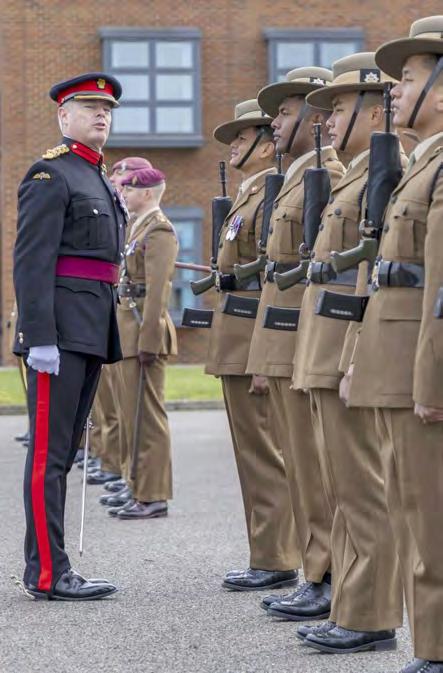
a commanding officer, but I believe that I’ve really improved this essential skill as a brigade commander. I’m now better at recognising the needs of different audiences and can adjust my style of communicating to ensure they get an unambiguous message. In a way, being able to judge what your audience needs, for their immediate and longer-term understanding, allows them to distil the information and pass it on in a timely fashion, with brevity and clarity – it’s an invaluable learnt skill. Everyone will be schooled to some degree by their experiences, but good leaders will recognise that they need to constantly improve the way they communicate if they want to have real impact across their commands.
I acknowledge the importance of formal training, but I also recognise that in this long apprentiship, many skills will be learnt, re-learnt and improved in an informal way. That’s not to say that some aspects of leadership should be explored in greater depth in the formal training environment, especially at the more junior levels. That said, recognising the informal opportunities to improve, challenging yourself, forcing yourself to operate outside of your comfort zone, can pay real dividends throughout your career. As people progress through the ranks, what might be regarded as soft skills, have a habit of quickly developing into critical skills in hard environments, especially as responsibilities increase. What I’d say is that everyone should make the most of the time and opportunities available to them to hone their leadership skills - otherwise you might, as I’ve alluded to, regret not investing in the available time and space when you find yourself in command. When you get there however, don’t be afraid of recognising that you’ll likely still be an incomplete leader – what counts
is recognising what you haven’t got and formulating a plan of what you’re going to do to improve yourself.
Finally, what I’ve learnt in the last five years is that it’s perfectly OK not to change some of our inherited plans. With the two-year cyclical nature of many appointments, there is definitely a temptation to believe that we have to articulate something in a plan that needs to be delivered within the life of a single incumbent. What I’ve realised is that this is unlikely to be helpful to an organisation and the people in it, because it’s unnatural. Although you could argue that there is a degree of narcissistic behaviour in all of us, we should be aware of it. Imposing change within a self-imposed timeframe can be deeply unhelpful and, where appropriate, we should refrain from making change for change’s sake. In the last job I did, in Head Personnel Strategy, it would have been easy to have been a disrupting force and orchestrate change, but sometimes it takes a degree of experience and confidence to acknowledge when your predecessor has done a great job, and the plan remains extant. If this is the case, don’t change things unless you are convinced that the evolving context warrants it. If you’re fortunate to be in this position, then you should lead the plan and support the staff in delivering it. This aspect of leadership comes back to my point of being a good follower. Sometimes we should refrain from the obsessive temptation of consistently demonstrating the outward traits of leadership and instead adopt the stance of an engaged follower, ready to touch the tiller, if necessary, but offering space for teams to deliver their prescribed outputs.
QThe 2021 Integrated Review of Security, Defence, Development and Foreign Policy (IR) provided the strategic direction which led to a general logistic disaggregation as CSS units were either task organised into the division or disbanded. Notwithstanding that, as a result of the IR, 101 Bde is smaller in form but not function, how confident are you that after IRON VIPER, and predetermining the outcome of IRON TITAN, that land logistics is now better aligned to delivering the outcomes articulated in the IR? Given that much of the Army structural changes have largely been actioned, how does future CSS training get included in combined arms manoeuvre and who is championing this?
AThe way I think about these questions is that morally and conceptually, we’ve been in the gym preparing. We’ve achieved a lot through hard, focussed training, and we’ve got our core fitness into reasonable shape. From this I’m very confident that, in these two areas of warfighting, we have a proven capability we can build on. We’ve also supplemented this with activities in support of Ukraine and the NHS, which has generally been conducted at very high readiness, undertaking life-saving interventions which required instant decision making. We should gain some confidence that these activities have all been achieved at reach, by some of our most junior people. So, morally and conceptually, I have a very high degree of confidence in our fielded abilities. I think I can continue to say that; as long as we continue to train the moral component and keep it strong in the conceptual space, whilst also ensuring we understand our role, purpose and prioritisation
8 RLC FOUNDATION INTERVIEW 8 | THE REVIEW 2024 THE ROYAL LOGISTIC CORPS FOUNDATION
towards sustaining combined arms manoeuvre in a multi-dimensional domain, we’ll remain in a good place. Physically, there is a different challenge.
In many ways, there’s nothing new in these questions and the answers form part of the broader philosophical historical debate between the physical and conceptual components [of fighting power]. All my predecessors have, to greater or lesser degrees, had to grapple with this challenge, albeit the context has been in a continual state of change for each of them. Inevitably, when they’ve deployed, they had to start the operation with the equipment they had and the associated tactics to complement their order of battle. So, when I look back at the historic evidence, in the physical space and the part of the fight that we own; the tactical and operational level, in the short, medium or long-term, I’ve a massive degree of confidence in the British soldier. I believe they retain the will, tenacity, initiative, guile and the innovative genius to deliver. That’s demonstrably been our strength, and I feel the same way about this brigade. What we need to be conscious of however, is that we don’t get seduced into accepting our frames of reference from the type of operations where we’ve proved very successful in the recent past. In logistic, and probably every other critical line of capability development, the recent past is a foreign country. The potential frictions we face in the contemporary operating environments are likely to be significantly different to what we’ve encountered and generally mastered. Conceptually, I don’t think the battlespace is going to look linear, and so we mustn’t restrict our thinking and physical laydown to lines of support through lozenges of logistic mass, but something much more fluid. The possible contemporary, not future laydown, is one that demands a consistently high tempo from all force elements, prioritised to meet credible and sustainable plans of manoeuvre. We must therefore practice and demonstrate agility at every level but especially the tactical and operational, if we’re to compete with a peer enemy. As the Deputy Chief of Staff in 3 Division, and as Brigade Commander here, I’ve attempted to enable the development of these necessary capabilities. This is uppermost in my mind when we conduct Exercise IRON TITAN. By concentrating on sustaining some selected bulk commodities, I intend that we attempt to prove and dispel some logistic myths. You can therefore expect the exercising of three things. To achieve and maintain momentum we will develop our ability to generate high tempo relative to the enemy, we will practice our ability to survive and operate in complex terrain and I aim to comprehensively demonstrate frequent logistic resource flow - rather than operate large, semi-permanent lozenges of default stocked materiel. Mass will always be a factor, but it will - by necessity against a peer enemy - be a temporal one which needs to ebb-and-flow to meet operational demands. Where I believe mass is unnecessary, commanders at all levels should act as a repellent and develop a standard operating philosophy of dispersal rather than permanent or semi-permanent massing. It's also worth mentioning tempo; how we generate it and what to expect. When you study the relative tempo of the belligerents on an historic operation, a pattern emerges. Nobody can sustain more than three or four days of high

intensity combat before you witness a cliff-edge drop in capability. We should therefore expect periods of lesser intensity where we optimise our refurbishment and, if necessary, regeneration. There may well be what I call a cheeky week of activity which will prove testing, but I would argue is realistic. We shouldn’t expect a cheeky week every week however – if it is, our capability will undoubtedly show some decline and our resilience will be eroded, together with our end user’s confidence.
It’s probably worth mentioning that I don’t intend to conduct this level of training and investigation in isolation. Uppermost in my mind are the other operating environments and likely partners which bring greater enabling and force-multiplying capabilities - but also some potential friction. I intend to conduct some deep dives into our partner’s requirements and our ability to cross service specific commodities. So many of the things that can restrict the flow of commodities through our supply chains need to be identified and explored. Only when we’ve done this will we be able to quantify what can be sustained, under what conditions and what the inherent risks are. If we can get all this right, we can avoid what General Rupert Smith referred to as, ‘logistic constipation.’
So, the question of fit-for-purpose structures is answered only by doing, not just as a single event but repeated over time, with logistic ‘load’ placed on specific functions. Some of the answers I already have, but you’ll not be surprised that I want to go further, validate, consolidate and go again; to not only prove our concepts but to make them more agile, relevant and resilient.
The IR describes how 'Global Britain in a Competitive Age' intends to conduct itself utilising cross government departments to deliver desired strategic and operational outcomes. To help deliver this competitive edge, technology is recognised as playing a big part. How confident are you that a technological edge is being maintained across the CSS functions which optimizes the talents of our people?
This is one of our most challenging areas for development and maintenance of competency - not just for CSS or the Army, but for wider Defence
RLC FOUNDATION INTERVIEW 8 THE ROYAL LOGISTIC CORPS FOUNDATION THE REVIEW 2024 | 9
Q A
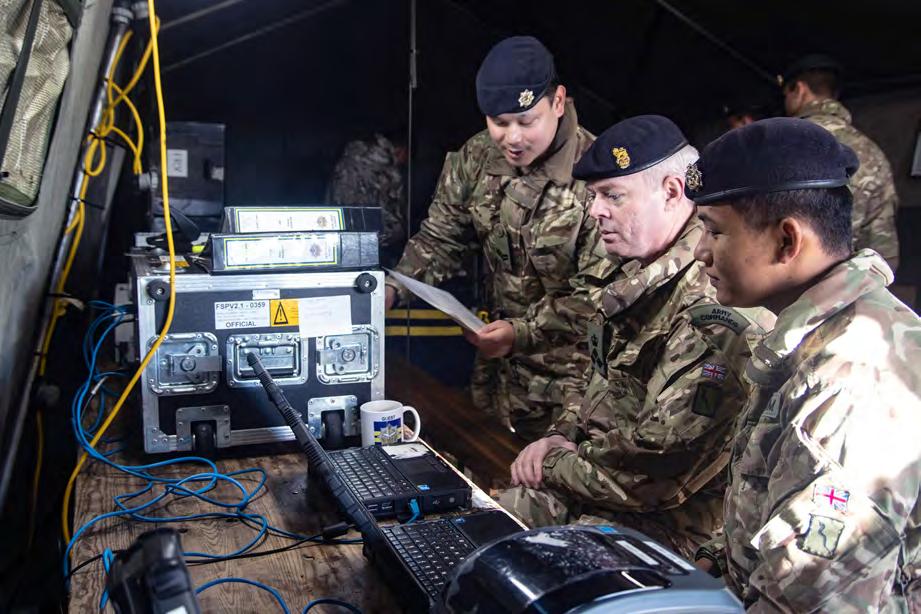
and our potential coalition partners. I’m confident that in some areas we are making real progress, but the challenge is so great that it shouldn’t come as a surprise that there are some areas where we need to do more – and at a high tempo. I’ve full confidence in our people’s ability to adapt and progress through a learning curve where they master some of the emerging technologies and deliver favourable operational outcomes. How acute that learning curve is, however, is down to a number of supporting and conflicting areas. Identifying technologies early is one factor, but just as important is being prepared to take procurement risk i.e. weigh up the dangers of adhering to a procurement cycle which attempts to de-risk all the financial and delivery requirements - against the physical dangers of not fielding a capability in a timely manner. This has been a recent discussion point for the Defence Select Committee and Service Chiefs. With this in mind, we should develop an expectation that sometimes we may fail in seeking novel solutions rather than restricting procurement activity to narrow financial and overly exacting technical requirement boundaries. So, our people have the skills sets which allow them to adapt quickly but they have to be afforded a high tempo mechanism which supports timely innovation and fielding. What we need to ensure is that we continue to attract people who have the ability to adapt and give them the confidence that they’ll be supported when they make suggestions on how solutions can be grown. When we recruit, I’m convinced that we not only need people to start on a common baseline where they learn from a mixture of formal training and doing, but we must also look to the gains we can make through adopting a programme of lateral entry.
Again, this is all part of the contemporary leadership and management conundrum, but there is definite merit in considering selection and recruitment
in a new paradigm, something which allows us to move away from thinking in narrow echelons of age and experience. We should take confidence that there is nothing new in this. In the thick of the 1915 British artillery shell production crisis and mobilisation of a million-strong deployed army, Prime Minister Lloyd George and Field Marshall Haig’s appointment of Sir Eric Geddes, a civilian railway executive, as an honorary Major General was inspired. Geddes, and his lateral entry hiring of civilian experts, can be credited with transforming our inefficient and stovepiped force support chains with the multi-nodal network of docks, railways, canals, light railway, and roads that would ultimately culminate in the success of the Hundred Days advance in 1918. Further British administrative agility was evidenced when Geddes later became First Lord of the Admiralty. I cannot recommend enough, the Corps’ very own Clem Maginniss and his ‘An unappreciated field of endeavour: Logistics and the BEF’ as an authoritative work on sustainment on the Western Front. The evidence that Clem provides explains both how we have historically exploited a wider than regular workforce and used it to power through the learning curve which every conflict demands. You can find similar examples of lateral entry from WW2 right up to Operation TELIC. As well as some lateral thinking on widening our human resource base, there are also some fundamental operating tools that we must get right.
All of our plans, and the opportunities we seek, are built on establishing and utilising a sustained operating picture. Commercial business struggles with this vital element in its various operating models. It supports their core business and allows them to manage their cash flow – so we’re not alone. I know where I want to go with optimising our logistic picture performance, and there’s much work to be done to
8 RLC FOUNDATION INTERVIEW 10 | THE REVIEW 2024 THE ROYAL LOGISTIC CORPS FOUNDATION
incorporate machine learning, ensuring we maintain a stable, deployable bearer system, where we can incorporate selected coalition partners. I’m in no doubt that if we optimise the technologies available and get the training line of development right, we’ll gain and maintain a competitive edge.
With regards to recognising, verifying and incorporating emerging technologies to allow us to optimise our deployed form and functions, it’s vital that we overcome some divergent challenges. I’ve already mentioned our procurement cycle, but at least for the various software applications and agile capabilities that we require, we need to adopt a flexible approach. If we get this right; from 3D printing, to avoiding bias in AI, (which could lead to poor provisioning), to using drones for distribution, to ensuring machine-human interfaces are constructed and assured within deployed systems – we can ensure each component part of our sustainment system is available for service when we need it. The challenge is that we have to be able to offer sustainment in an agile way; with a high degree of end-user confidence, using an optimised footprint which monopolises technologies that offer advantage but in an affordable way. Our procurement, training and fielding mindset will undoubtedly need to evolve. We’re not talking about capital items of bespoke military equipment that generations will work on, but relatively niche, high tech, transient capabilities, that may offer only temporal advantage. Pedestrian procurement models are an anathema to industry and our workforce when we seek competitive edge within our deployed supply chains. The current generation have no problem with adopting a prototype mindset, in fact, they expect technology to be superseded at a superfast speed. We need to recognise that if you don’t continually plan for upgrade then you risk user, and end-user, confidence in our sustainment system. Now we’ve mentioned risk, it’s probably also worth mentioning that to realise the potential advantages of adopting niche technology you need to encourage a new threshold for taking risk with our procurements in specific areas. 3D printed component parts may not be ISO 9001 compliant, but as long as we know the range of the operating spec within the mainframe they are being issued against, then it’s probably less risky to get the asset back in a potentially less capable state than wait. Whatever the technologies we adopt, they must offer us the ability to make timely decisions at a known level of risk, at a consistently higher tempo than a peer enemy. Technology must also make our support chains more resilient, definitely in the deployed space, but also in-barracks. If we can achieve this, then we would have gained a relatively high level of supply chain assurance for our end-users.
It’s clear that you’re an avid book reader, so can you describe how you find the time and space to read and digest your chosen material?
Yes, I am an avid reader. I probably read two books a week and I’m forced to clear about twenty books out of the family home every two months. My main focus is non-fiction, but I do steer into fiction as well. I don’t read one book at a time but have several on the go that I dip into. I tend to write
notes in each as ideas are triggered and keep them in the book for future reference (if I’m allowed to keep the book!). Currently, I think I’ve about five books on the go.
With regards military topics, I’m a big fan of the Pulitzer Prize winner, Rick Atkinson (The Liberation Trilogy: An Army at Dawn (2003), The Day of Battle (2007), The Guns at Last Light (2013) – all reviewed on the Foundation website and included in MGL’s Professional Reading List), which I really value. I’ve taken Atkinson’s books to Sicily and Normandy and found them so informative and emotive. I also read John Keegan (The Mask of Command, (1987) – MGL’s Reading List), General Stanley McCrystal (Team of Teams – New Rules of Engagement for a Complex World, (2015)). On the more academic/strategic side, I enjoy Lawrence Freedman (Strategy (2013) – MGL’s Reading List).
I’m currently reading a book titled, The Wager: A Tail of Shipwreck, Mutiny and Murder by David Grann (2023), a book about leadership of a ship’s crew pursuing the Spanish Armada. When it comes to leadership, I read a lot of 18th and 19th century naval books. I find life and death within the wooden walls fascinating. I’m a big fan of NAM Rodger (The Wooden World (1986), The Safeguard of the Sea (1997), The Command of the Ocean (2004) and Sam Wills, the Heart of Oak Series (The Fighting Temeraire (2009), The Admiral Benbow (2010) and The Glorious First of June (2011), is fantastic. Another book on my bedside table is Where Power Stops; The Making and Unmaking of Presidents and Prime Ministers (2019) by David Runciman, an account of world leaders and why they never achieved what they set out to do, as power is always bounded. I also have a book about Vietnam that I’m working through, Achilles in Vietnam: Combat Trauma and the undoing of Character (1994), by Johnathan Shay, a psychiatrist who compares the exploits of Homer’s Achilles with the experiences of Vietnam veterans. The last two books I’ve on the go are Atkinson’s, The British are Coming: The War for America, Lexington to Princeton 1775-1777, (2019) and Ham & Jam: 6th Airborne Division in Normandy - Generating Combat Effectiveness: November 1942 - September 1944 by Andrew Wheale (2022).
The book I’d wish I’d written is Principles: Your Guided Journal (2017) by Ray Dalio. From his personal experiences as a very successful hedge fund manager, he writes about the establishment of a unique set of principles that allow you to get what you want. Surprisingly, at the other end of the spectrum, the book I struggled to finish is Rupert Smith’s Utility of Force: The Art of War in the Modern World ((2005) on MGL’s Reading List). Not to be overly critical of a hero of mine and recognising that the book was not solely intended for a military readership, I got through the first half of the book whilst I was serving in Iraq, but then found that his hypothesis on warfare was so close to the mark that it became a painful read. Undoubtedly, what Smith writes is fundamentally true, but at the time when I was reading it, it exposed the flaws in the political and military lines of development that the coalition was pursuing – it made me angry and uncomfortable. To contextualise this, if you read the MOD’s The Good Operation (2017), which not only outlines what
RLC FOUNDATION INTERVIEW 8 THE ROYAL LOGISTIC CORPS FOUNDATION THE REVIEW 2024 | 11
Q A


questions need to be asked as we plan and execute military operations, it also articulates what you shouldn’t do. Its baseline is the Iraq Inquiry (Chilcot)
and so if you read it together with Utility of Force, and then place yourself on a tour in Iraq with soldiers who were doing their utmost to make a success of the given mission, you might see why I struggled to finish Smith’s book. Both publications chime with one another and there have been several publications since, such as Rory Stewart’s The Prince of the Marshes: Occupational Hazards (2007) which provide further critical context.
What you’ve got me onto with this question on reading is one of my pet loves and hates. I wish people would read - or read more. If you want to challenge yourself, read things you know that you’re probably going to disagree with. Develop a broad reading strategy and it’ll help you in so many ways; the mechanics of writing certainly, but also an ability to filter information, identify what is important, exposing weaknesses in an argument, the strength of presented evidence, and, ultimately, it might help you avoid the pitfalls of group-think solutions. MGL’s Professional Reading List and the Foundation’s Book Club offers a good baseline for those looking for some pointers. In my experience, we don’t read enough, it’s a potent skill where you can develop understanding, identify where flaws are and rectify weaknesses in the conceptual, moral and physical components –pretty much everything I’ve been talking about here.
I am Rick Jennings, an Independent Silver Consultant based in South Yorkshire. With over 20 years’ experience, I offer a wide range of services including accurate valuations for bespoke military centrepieces, sporting trophies and other pieces of silverware that provide organisations with a unique link to their heritage.


“If you want the best, look no further than Rick Jennings. The Regimental Headquarters of The Royal Logistic Corps would have no hesitation in recommending his services to others and looks forward to working with Rick again in the future”. Stephen Yafai, The RLC Regimental Secretary

If you would like more information or to book a valuation, please use the details below and I will be happy to confirm the number of days required to carry out the valuation along with cost and availability.
07970 712852
rick@rickjenningsconsultant .co.uk
www.rickjenningsconsultant .co.uk

8 RLC FOUNDATION INTERVIEW 12 | THE REVIEW 2024 THE ROYAL LOGISTIC CORPS FOUNDATION
RESULTS DELIVERED, CONFIDENCE EARNED
Delivering Digital Transformation in Defence

leidos.com/uk/logistics-mission-support
Was it easy? Was it worth it?
Currently appointed as the Warrant Officer Equipment Support at Headquarters London District, WO1 Susan Kier RLC has an inspirational story to tell
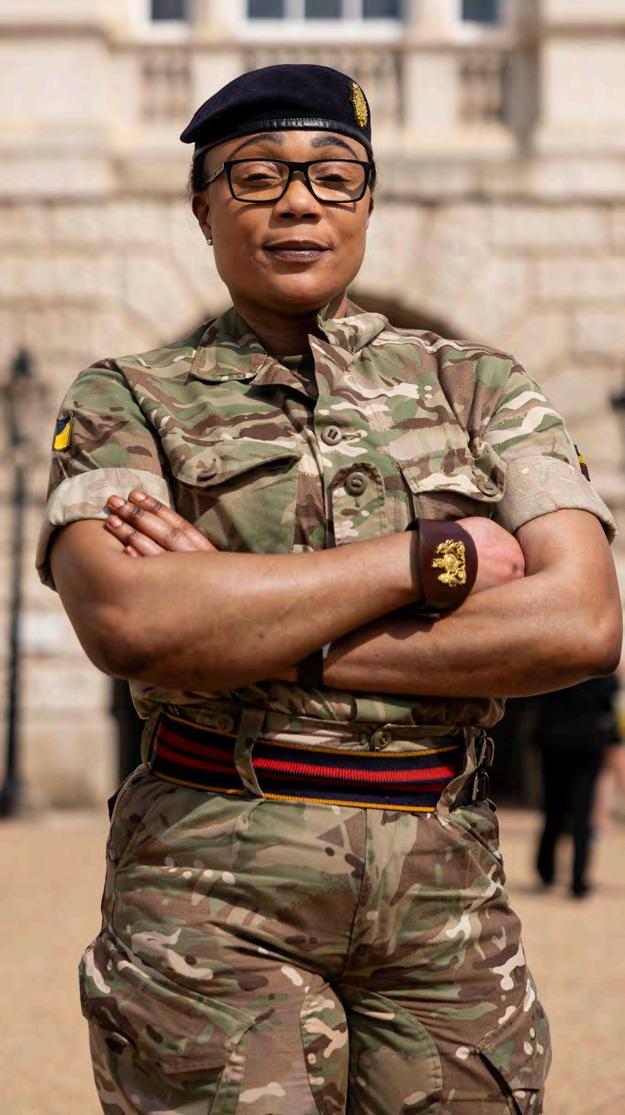
She is a role model for anyone thinking of joining the Regular Army. In this candid interview, Susan describes some of the personal challenges she has faced and significant achievements she has enjoyed in a very successful career, spanning two decades as a Logistics Supply Specialist within The RLC. The recruiting process timescale and activities are interesting from the point of view that pre-selection was complete in a day and Phase 1 commenced four months later, generally significantly faster that routine recruitment. Her candid views on family and post operational considerations offer food for thought.
Firstly, could you explain your motivation for joining the British Army and your family circumstances?
I’m originally from St. Vincent and the Grenadines; a beautiful island in the Caribbean. Employment is very challenging back home and I always leaned towards serving and wearing a uniform of some kind. I decided to join my island’s police service and completed all the preselection process. As an interim, I was working as a hairdresser, and I remember the day I came home from work when my mother told me that she had heard on the radio that the British Army was sending a small recruiting team to the island to select potential recruits for the Regular Army. I think the backdrop to this was the challenging recruiting environment on the UK mainland and as a consequence, a recruitment drive was instigated and rolled out across selected Foreign and Commonwealth countries.
The truth is that I was initially hesitant to apply but after some soul searching, I thought, ‘why not?’ I was 22 when I made this decision. The St. Vincent and Grenadine High Commissioner to the UK was a Mr Dougan, a lawyer by profession, and I had to submit the relevant documents to his office prior to the recruiting team arriving on the island. A month later I received a package from the British Army with the details of the process and my reporting time and date at Ottley Hall at the Docks Station. I remember that it was a pretty intense day, from the BARB test (aptitude test) to the physical assessment and everything in between. We were shown a video which outlined all of the trades currently available to recruits and from our BARB test scores we were able to choose what we were interested in. Looking back, The RLC must have been fairly
8 RLC FOUNDATION INTERVIEW 14 | THE REVIEW 2024 THE ROYAL LOGISTIC CORPS FOUNDATION
Q A
convincing with their recruitment strategy as I was drawn towards the Logistic Specialist trade – a decision I’ve not regretted. At the day’s conclusion, all the successful candidates were given a letter informing us that we had passed the initial recruitment stage and detailed the administration for our travel to the UK to commence Phase 1 recruit training. I remember telling my mother of the outcome and she was in tears. She regarded the acceptance letter as an opportunity for betterment.
Leaving home to join the British Army is a significant life event for anyone. What was it like to leave your family in the Caribbean?
It was a very emotional time for everyone but, by comparison to some of my cohort, I’d already experienced some significant life challenges and so I think I had a mature attitude to what was happening. From receiving my initial letter in November 2000, I was reporting for duty in March 2001. For me, this period was a torrid time as I had two young children. My daughter was five and my son was one – so, leaving was a pretty traumatic event for all my family as I decided to leave my children in the care of my mother and siblings. Despite this heartache, I recognised that joining the British Army was a golden opportunity to make something, not only for myself, but for my family. If you’re lucky, you may only be presented with a few life chances, and I recognised this as one of them. There were about 250 of us destined for various cap badges who arrived at Gatwick on the same flight from St. Vincent. I remember being met by a group of non-commissioned officers and from the outset I thought they were very friendly. I would say now that this period of first contact was all very positive and helped build my confidence and shape my attitude for what was to come.
I commenced training at Pirbright one week earlier than our UK counterparts and we used the time to familiarise ourselves with the environment and complete UK administration, such as opening a bank account. I was in an all-female troop with nine recruits from St. Vincent. At the end of Phase 1 training, eight of us completed the training and there are two of us still serving today. I’m proud that I’m still the highest-ranking female in the British Army from St. Vincent and the Grenadines. I enjoyed Phase 1; I was the fittest female in my troop and that gives you a lot of confidence. As a mother, I was, by comparison with the other recruits, a mature woman, so it was natural that I assumed a mentoring role – something that gave me a sense of greater responsibility.
Phase 2 training at Deepcut was not so welcoming and together with the other recruits I had some negative experiences. he environment and atmosphere have been well documented. The training focused on physical fitness but not the mental resilience which should run parallel with it. I was fit, so for much of the time I focused on this, representing the Army at netball and athletics. It’s also worth mentioning that whilst I indirectly witnessed racism in Phase 1 training, Phase 2 was much worse. There was a lot of frustration at Deepcut, fueled by inactivity as recruits waited for their trade courses to commence. I waited two months for my courses, but some individuals were
waiting up to 12 months. Time was filled with what the Army termed ‘concurrent activity,’ fitness in the main but with a fair amount of menial tasks.
You finish your recruit and trade training and you’re posted to your first unit. What was the process for this and what did you experience in your first years?
We were asked which unit we would like to be posted to. I remember the initial recruiting slogans back home, ‘join the Army and see the world.’ This was a major hook for me, and I wanted to experience Germany, but I was also a very keen sportswoman. 6 Regt seemed to be a good fit for both, and I was lucky enough to be given my first choice – a decision I never regretted. I loved 6 Regt and Germany. We were like a little family with a close knit foreign and commonwealth contingent, working and playing in a very positive and supportive environment. I made the most of the opportunities to travel in Germany – what a beautiful place. Because of this, I transitioned very quickly into unit life. I wasn’t fazed by anything, and I immediately threw myself into unit and Corps sports, athletics, boxing, netball and football. I also attended a football referee’s course. With full participation in sport and a very busy exercise programme, I was fully immersed in every aspect of unit life. In February 2003, I deployed on my first operational tour, Operation TELIC 1 to Kuwait and Iraq. I made the decision not to tell my family that I had deployed, and I kept in touch via satellite phone. I think my mother had a suspicion that something had changed but I didn’t confirm I’d deployed until I returned to Germany in June 2003. Overall, the deployment was a very positive experience for me, and I learned a lot about my trade and people in general. At the end of the tour, I was selected for promotion to Lance Corporal.
With some operational experience under your belt, where did you go from there?
After TELIC 1, I was seconded to the Corps recruiting team for six months at Abingdon and we travelled to various parts of the UK to undertake recruiting activities. I returned to Germany (Bielefeld) and completed my promotion certificate. I suppose at this stage I was ahead of the standard promotion model, at least for the first two rungs of the ladder. I did hit a promotion plateau at Corporal – something I’m still a little confused over. If anything, this shows that even if you hit a bump in the road, it’s not necessarily the end – you just must believe in yourself and keep going. I moved to 12 Logistic Support Regt and deployed back to Iraq on TELIC 11 in 2006. This was a demanding tour and completely different to 2003; I was frequently out on the ground and the situation with regards to threat level came as an unpleasant surprise to all ranks. After this tour, I experienced a British Army Training Unit Suffield winter repair exercise in Canada in 2009 – something that honed my trade knowledge to another level. In 2010 I deployed to Kenya for six months and at the end of 2010 I was posted to 9 Regt. On my return from Christmas leave in 2011 I was deployed on HERRICK 14 to Afghanistan between January and October where I was awarded a Joint Force Commander’s Commendation for my work in the
RLC FOUNDATION INTERVIEW 8 THE ROYAL LOGISTIC CORPS FOUNDATION THE REVIEW 2024 | 15
Q A Q A Q
A
Theatre Logistic Headquarters. I found the tour different to TELIC. I was routinely working with commissioned officers, and I really enjoyed the work environment. After HERRICK I4 was posted to 1 6 Medical Regiment in Colchester as a sergeant. I have always acted as a mentor and in 16 Regt I undertook some significant mentoring activities. I was posted back to 9 Regt as a Staff Sergeant but was promoted to WO2 and assigned to a Sergeant Major post – the first time I had stepped out of trade, which, looking back, was good for me. There had been some challenges with the squadron I was assigned to; some directly relating to foreign and commonwealth soldiers who made up over 90% of the squadron. I also got married in 2018, to a Canadian who lives in Montreal.
Anyway, I enjoyed the experience in 9 Regt and was then posted again in 2019 to Colchester to 8 Field Company REME and eventually ended up as the Regimental Quartermaster Technical. I was also chosen to be the unit Army Multi-Cultural Advisor as the unit had a large ethnically diverse population. I took the role very seriously and won two awards; the 2020 civilian, ‘We are the City Rising Star Award’ and later that year, I won an RLC Foundation Award in the mentoring category. I was promoted in 2021 to WO1 and found myself in London but before coming here I deployed to Macedonia for three months. One of the unusual tasks I have been chosen to complete here is to give a reading for the National Army Museum on Black History month – something I’ll never forget. In truth, I never wanted to be posted to London but after conducting a lot of face-to-face unit visits I’ve found it a very positive experience and I think unit representatives appreciate what we are trying to do for them. As with most jobs, how we perform is based largely on personal contact and developing a trusted working relationship. These jobs can often throw you a curve ball and in my first two weeks in post, I found myself representing the MOD, giving technical evidence in Crown Court for a civil/military case. Never a dull moment!
You clearly created some opportunities for yourself and made the most of what your Corps offered. What about your immediate family? Well, I’m not going to say that living with my original decision to leave my children with my mother and siblings was easy. This was always a long-term plan for betterment, for all of us. My first leave back to St. Vincent was 2004 and I stayed for a month, and I went back again in 2007 and 2010,
leaving after the first two visits wasn’t easy. A lot of water went under the bridge but in 2008 my children joined me in the UK (Abingdon), eight years after I joined the Army. Again, this was another upheaval for my mother and my children who had grown very close. I explained to them why I did it and you know, they get it. They understand the logic. The payback has come in different ways. My daughter is now a nurse, and my son has just completed his undergraduate studies in psychology, and he has aspirations to join the British Army. It was a juggling act when my children were younger, and we were living in the UK. I have five sisters and they all would look after my children if I was away for any significant length of time. My mother came over in 2009 and 2010 and experienced the setup. When she first came in 2009, she saw me in my uniform and was tearful, when I asked her what’s wrong, she said that she was so proud of what I’d achieved. The truth however is that this whole enterprise with the British Army has been a family affair, we are close, and it has been a team effort to make it work. The unit support mechanism has also helped, and I have appreciated the assistance they have offered but my family and our Christian faith have been my fallback when I needed support.
Looking back at your varied experiences and with a wealth of general and technical knowledge, what is your view of the operations that you deployed on?
To be honest, my first deployment to Kuwait/ Iraq was at such a low level that I didn’t give it much thought to the why but more to the how… Such is a soldier’s lot I suppose. We were briefed that we were there because of the threat of Saddam’s WMD arsenal and his non-compliance with UN resolutions. I think we all generally accepted that rationale. With the second tour, I witnessed a broader set of challenges. I don’t think it’s for me to say if we were right or wrong to be there, but the subsequent enquiry (Chilcott Inquiry) seems to question the original rationale. After tumbling a dictatorship, I ask myself was it worth it and what lessons have been learnt? I have similar thoughts when I consider Afghanistan. I initially thought that intervention in Afghanistan after 9/11 was necessary, but my view is now more nuanced. When I consider what governance Afghanistan is now subjected to, and in particular the lack of opportunities for women, I wonder if we have made any lasting difference to the country. I still ask myself, ‘was it worth it’? Q A Q A

8 RLC FOUNDATION INTERVIEW 16 | THE REVIEW 2024 THE ROYAL LOGISTIC CORPS FOUNDATION

The UK’s trusted provider of Military Sports OSVs
Bolster team spirit and connections through challenging fixtures, elite training sessions, and OSV standards-aligned community engagement projects and excursions on an Edwin Doran sports tour.
As the only operator of sports tours that aligns with the British Armed Forces’ OSV tour purpose standards and proud sponsors of the Royal Logistics Corp, we have a complete understanding of the military objectives and requirements for launching an overseas sports tour.
With fifty years of experience delivering worldclass sports tours and dedicated staff who have served in the Armed Forces, your next OSV is going to be special. Get in touch with us at military@edwindoran.com to start planning it.
Cape Town stole our hearts. From arrival through to departure, the tour truly exceeded all of our expectations. Every activity and every interaction was excellent, the team went above and beyond to be flexible and accommodate us.
Army Medical Services – Hockey Tour to South Africa

3D printing can reduce Defence’s logistic footprint and optimise its supply chains
It has been widely reported, that within weeks of Russia’s illegal invasion of Ukraine, 3D printing tech companies in Eastern Europe were supplying Ukraine with hundreds of plastics and polymer 3D printers which have been used on the battlefield ever since to make everything from FPV drone airframes to tourniquets and prosthetic limbs. Today 3D printing (additive manufacturing to give it its correct title) technology is having a profound effect on the success or failure of combat operations in Ukraine. While still in its infancy, the use of 3D printing technology by the UK’s armed forces is now rapidly gaining momentum.
By Mr Peter Shakespeare

Having the ability to manufacture components or complete items, in, or close to, the battlespace, overcomes a multitude of logistical challenges, especially in alleviating the pressure on an army’s supply chain to keep its fighting units supplied with weapons and combat supplies. But within the home base, serious issues have developed over time within the military supply chains responsible for keeping military hardware maintained and operational.
Most of today’s military platforms have been in service for decades. Given the age of the equipment inventory, many of their component parts and ancillaries are obsolete and new ones take months to manufacture and are very expensive. Speaking at the Defence Security and Equipment International event, Lieutenant General Richard Wardlaw, the British Chief of Defence Logistics and Support, summarised the challenges, declaring that: “The biggest single threat to defence supply is obsolescence.”
The use of additive manufacturing (AdM) to make replacement legacy parts has been seen as the solution by the US, Australian, Dutch and French militaries for some time and now the UK’s Ministry of Defence (MOD) is developing and adopting the technology.
Alex Champion has a degree in motorsport engineering and spent his early career manufacturing parts for Formula 1. He is also an Army Reservist, serving as a Second Lieutenant with 165 Port & Maritime Regiment RLC. In 2018, while working
for a 3D printing company, he quickly familiarised himself with the technology. In October 2019, whilst attending an engineering exhibition at the Millbrook proving ground, he was introduced to the Royal Electrical and Mechanical Engineers’ (REME) staff officer responsible for the Army’s project to expand its manufacturing and engineering capabilities –Lieutenant Colonel Dan Anders-Brown. Colonel Anders-Brown subsequently asked Champion to give a talk on AdM to several senior army officers.
After delivering a successful briefing, he was offered 44 days a year working as a Reservist at Army HQ. He was tasked with designing four small deployable factories containing laser scanners and 3D printers, each capable of being transported on an Army Support Vehicle. These would be trialled in remote locations, helping to inform the Army’s future engineering, manufacturing and logistics policy and doctrine. Champion was also invited to present about the planned trials at the Shrivenham Defence Academy, followed by another talk at a Tri-service conference. Champion outlines the opportunities:
“The Army had been looking to adopt technologies such as 3D printing in order to manufacture urgent parts. This will help to reduce the logistic burden and save money in developing or updating equipment. We initially focused on using the technology to produce temporary and non-safety critical 'get me home' repairs. At the other end of the spectrum, the American Department of Defence has invested heavily in this
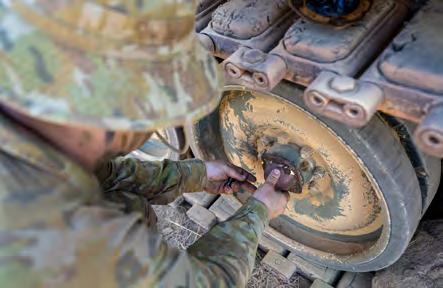
8 RLCF SPECIAL 18 | THE REVIEW 2024 THE ROYAL LOGISTIC CORPS FOUNDATION
8 An Australian soldier-installing a SPEE3D printed road-wheel bearing on a M113 APC
technology and is now benefiting from being able to 3D print metal components, for main battle tanks and this one capability alone has saved months of repair time and millions of dollars. UK Defence is now developing the capability to manufacturer the full range of safety and non-safety critical components for its assets.”
The MOD’s programme to invest in the strategic use of AdM, goes by the name of Project TAMPA. One of the project’s aims is to incentivise the defence manufacturing industrial base to accelerate and drive up the levels of innovation that it applies to strategic supply chain management. Today, Champion is the AdM lead at the MOD’s Defence Equipment Support organisation (DE&S), responsible for the project.
In September 2022, DE&S’s Commercial Future Capabilities Group published a notice to existing defence contractors that supply NATO Stock Number (NSN) parts to the MOD inviting expressions of interest for the £5 million three-year project, which would use AdM technology to supply obsolete components for weapons systems and maritime, air and land assets.

In April 2023 DE&S announced it had set up the first framework under Project TAMPA by awarding industry contracts to - AMFG, Babcock International, NP Aerospace, RBSL and Thales. Project TAMPA is initially looking into what limitations, if any, of adopting AdM will prevent DE&S and its industry partners, from using the technology to best effect.
The first phase of the project is to produce and fit 11 non-safety critical 3D printed metallic NSN parts onto in-service platforms. This will be followed by safety critical metallic NSN parts produced in an industrial base, certified by the producer (OEM or under licence). The next phase is to manufacture non-safety critical metallic (or polymer) NSN parts, produced in a location remote from the industrial base, certified by the producer; then a safety critical metallic (or polymer) NSN part, produced in a location remote from the industrial base. The final phase will be to produce non-safety critical metallic (or polymer) NSN parts, produced in a location remote from the industrial base, certified by the producer and where access to design rights are required.
While several of the MOD industry partners involved in Project TAMPA are OEMs, Babcock International is in a unique position that while it is an OEM, it also provides third party through-life technical and engineering support to the MOD and delivers engineering support to land defence and air base operations, specialist training and asset
management, equipment supply and maintenance.
Jonathan Morley is Babcock’s Manufacturing and MRO Lead (Technology) and outlined the initiative:
“There is no doubt that the defence supply chain needs to be better than it is and before Project TAMPA started Babcock was working on programmes to look at how we could use technologies, such as AdM to augment and complement our defence supply chain management activities across land, sea and air. There are a lot of legacy assets within the defence equipment portfolio and the severe challenges of obsolescence is something we face every day. These legacy platforms are low volume which makes supply chain provision even more difficult. In some cases, platforms, especially submarines, are unique and there have been cases where there are no drawings for a part, so they have to be re-engineered. AdM provides the solution. These new technologies not only have the potential to address these issues, they also help us improve our productivity and ability to support our customer and reduce downtime.”
Separate to Project TAMPA, Alex Champion says frontline commands in the Army, Navy and Royal Air Force have now procured their own AdM machines to support their own programmes to enhance manufacturing capability to support operations. The equipment is deployable and suitable to fabricate and expedient in-situ repairs and explains why the MOD is looking to establish regional hubs with this capability.
In November 2022, Renishaw supplied a RenAM 500Q Flex metal AdM machine to RAF Wittering help improve its component manufacturing capabilities. The Station is using the system, along with other 3D printing and scanning equipment, to produce custombuilt structural aircraft components for rapid repairs. Its arrival marks the RAF’s first steps into advanced component manufacturing. In March 2023, DE&S purchased a SPEE3D Coldspray printer and signed a two-year contract to work with the Australian company. The 3D print technologies being utilised include Powder Bed Fusion (PBF), Wire Arc Additive Manufacturing (WAAM) and SPEE3D Coldspray additive manufacturing.
SPEE3D’s Coldspray printer uses supersonic

RLCF SPECIAL 8 THE ROYAL LOGISTIC CORPS FOUNDATION THE REVIEW 2024 | 19
8 As part of TAMPA, Babcock 3D printed and fitted AFV periscope components to refurbished vehicles
8 Renishaw AdM technology is being used by the RAF
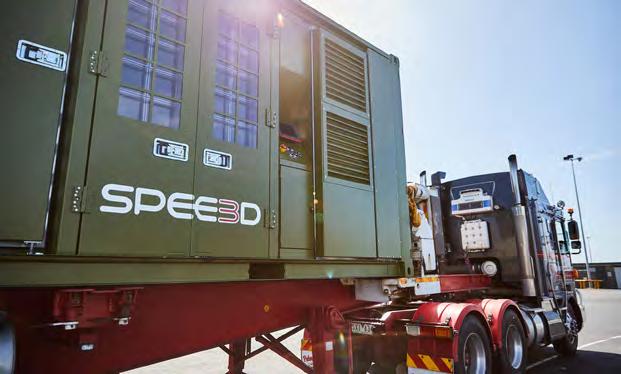
deposition. A rocket nozzle accelerates air up to four times the speed of sound. Injected powders are deposited onto a substrate that is attached to a six-axis robotic arm. In this process, the sheer kinetic energy of the particles causes the powders to bind together to form a high-density part with dimensions up to 1000 x 700mm. Materials currently available are Aluminium, Aluminium Bronze, Stainless Steel, and Copper, with others in development. The printer and associated equipment will fit inside a 20-foot ISO container so can be transported and deployed using a military load carrier.
PBF methods use either a laser or electron beam to melt or sinter material powder together. The process can create highly complicated geometric shapes from a range of metals and polymer powders; although polymers cannot be melted so use the sintering process.
The technology lends itself to small complex components and due to the accuracy of the manufacturing process they only require basic finishing, such as threading fixing holes.
WAAM is the oldest 3D printing technology and is basically a MIG welder mounted on a robotic arm. The workpiece is formed on a rotary table and the machine builds up the part from weld, controlled by CAD/CAM software. WAAM has a resolution of approximately 1mm and a deposition rate of between one and 10kg per hour. This is a technology that Babcock uses, and Jonathon Morley says it has the capability to make a 4-metre diameter ships propeller or other large, high strength, components.
Coldspray and WAAM effectively make castings that require machining and finishing. For decades the REME and Royal Engineers have deployed field
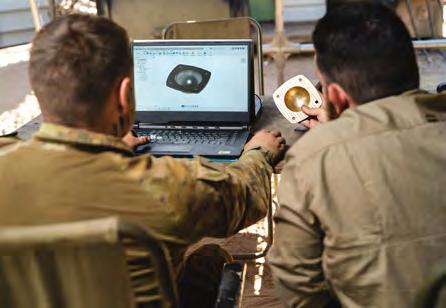
workshops equipped with machine tools, such as lathes and milling machines, which can be used in conjunction with deployable Coldspray and WAAM 3D printers to offer significant reductions in the spares inventory.
These AdM technologies have already been used to make armoured fighting vehicle access hatches and drive sprockets for tracks.
Intellectual property (IP) of parts and questionable quality have been issues raised around 3D printing. Jonathon Morley believes these concerns can be managed:
“With IP, where we are starting from is a large proportion of the bill of materiel is obsolete or obsolescent, so there is a problem sourcing it. This obsolescence can be driven by a coating that is no longer produced to a withdrawal under COSHH. In addition, it can be a raw material is no longer used, or the OEM is no longer trading or has been bought out. Irrespective of the cause, it boils down to [the fact] there is no-one available to make the part. In these cases, we don’t see there is an issue with IP. Those defence prime manufacturers still in business aren’t interested in producing low volume legacy parts, but at Babcock supporting legacy equipment is what we specialise in, so we are already working with a number of the big primes, and they are all very supportive.”
Moving on to quality assurance, Morley explains some of the assurance mitigations:

“Porosity is a risk as it is in many manufacturing processes and during research into AdM, Babcock has identified factors affecting porosity. It is primarily mitigated by robust process controls, and careful selection and governance of print parameters. A good example is we were asked to replace a shoe box sized metallic part on a 4.5-inch naval gun, made in the 1960s, fitted to a Type-22 Frigate. There were no drawings available for the part, so we had to re-engineer it and then made it using powder process AdM. X-rays of the original part revealed several flaws in the steel casting. When x-rayed, the one we produced was flawless and much stronger than the original.”
Babcock says it proudly supports the UK MOD Defence Support Strategy, which is sponsoring the development of AdM to transform the Defence support environment and reverse the trend of obsolescence that is impacting equipment availability.
In conclusion, the options around 3D printing are only limited by the imagination. Many of the Army’s commanders now talk of a prototype army, deploying with off-the-shelf equipment or at most with minor modifications. It is unlikely there are large spares inventories for these items but 3D printers alongside deployed machining and finishing capabilities can make them and adapt them in the battlespace.
Prototype inventories now feature across the battlespace in Ukraine. Deployable 3D printing offers a technological edge in optimising the logistic footprint, minimising supply chains (and building in resilience) whilst potentially delivering higher availability to the fighting echelons. There is also the potential to significantly lower the whole life costs of platforms. Overall, this technology offers the Army and its logisticians a win-win solution and will eliminate dues out forever!
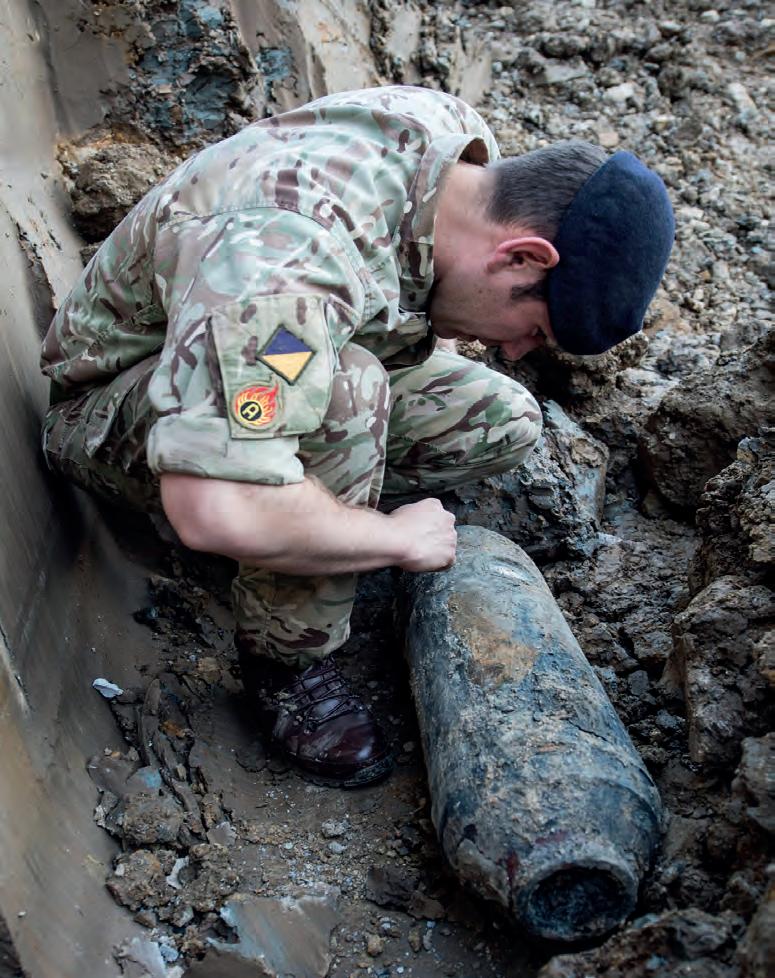
8 RLCF SPECIAL 20 | THE REVIEW 2024 THE ROYAL LOGISTIC CORPS FOUNDATION
8 SPEED3D’s Coldspray printer is fully deployable
8 Components can be printed from existing data files or where these don’t exist, reversed engineered and drawn using CAD/CAM software



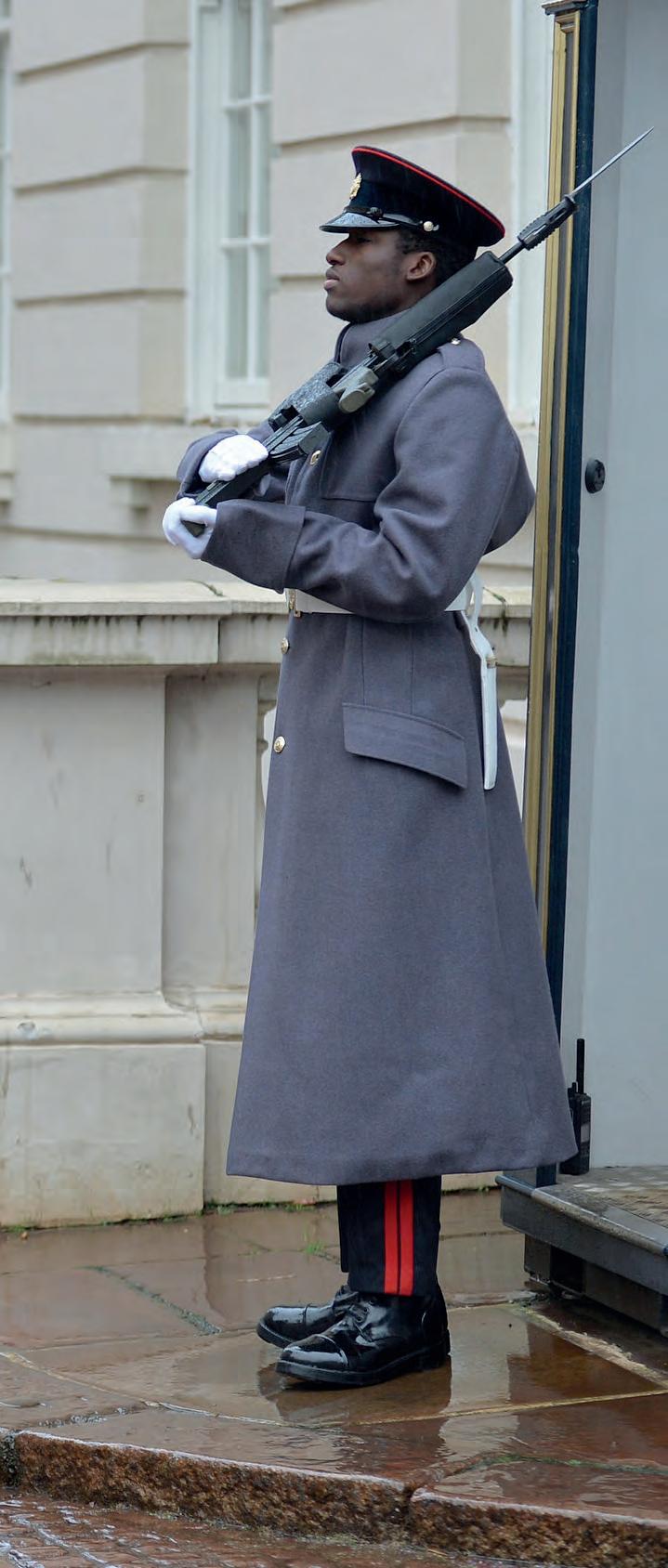

We aim for every serving officer and soldier to have trusted source for uniform items, field equipment and ‘off parade’ items, with timely delivery. Additionally, RLC Direct will stock items to support the needs of RLC Veterans and Cadet Forces. We want RLC Direct to become a staple of Regimental and Corps life and an essential source for quality items. Importantly, the more RLC Direct is used, the more money the RLC Association raises, as every sale generates a percentage donation.
Combat Clothing Off Parade Survival Kit Uniform Clothing & Accessories Webbing & Carriage www.rlcdirect.co.uk shop@rlcdirect.co.uk
Cutting the Centre Line - Operation GARDEN, Hell’s Highway, and ‘Porous’ front lines
In this Operation GARDEN centric case study Major Colin Taylor RLC examines the impact on a force engaged in high-tempo, combined arms manoeuvre, when its restricted ground lines of communication (GLoC/LoC) are frequently, albeit intermittently, interdicted by determined enemy forces

Parachute Brigade, would secure Arnhem. This study will examine selected logistic aspects, primarily concerning GARDEN3, the ground advance over the airborne carpet by 30 Corps commanded by Lieutenant General Brian Horrocks.4 The operational plan was hurriedly conceived and was recognised as high risk during its short conceptual phase. Summarising the challenge, a staff officer quipped that the plan was; ‘… like threading seven needles [seven bridges] with one piece of cotton, and …only to miss one to be in trouble.’5
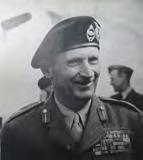
MARKET-GARDEN (17–26 September 1944), Field Marshal Montgomery’s audacious operational air-land plan to enable the neutralisation of German industry in the Ruhr and ‘bring the boys home by Christmas’, was fraught with logistical risk from the outset. Part of a sequential sequence of operations, the intended end-state was the securing, by British 2nd Army, of an area of Holland between Arnhem and the Zuider Zee. Montgomery believed that success would allow the Allies to outflank the Siegfried Line and allow a subsequent, decisive offensive, codenamed Operation GATWICK, to attack the German industrial heartland.1 The strategic intent was to bring the Second World War in Europe to a conclusion, secure parts of western Europe from communism and allow resources to be focussed in the Pacific theatre. Uncharacteristically for Montgomery, MARKET-GARDEN was a high-risk, ambitious plan, designed to exploit a fleeting opportunity of German military weakness. According to the historian Stephen Hart: “… now was the time for the 21st Army Group to gamble that its forces might secure for Britain a prominent profile in an Allied victory … achieved during 1944.”2
MARKET concerned the landing of an airborne carpet, to capture and hold vital bridges along a designated 75-mile route stretching from the Belgian–Dutch border to the River Rhine at Arnhem. The US 82nd and 101st Airborne Divisions were to capture crossings between Nijmegen and Eindhoven, whilst British 1st Airborne Division and the 1st Polish
There are two important and urgent contemporary reasons for studying GARDEN. Firstly, the early Russian operations during the invasion of Ukraine in February 2022 showed Russian armoured and recce units successfully penetrating deep into the Ukrainian rear areas on several narrow axes; only for many of them to fall victim to frequent interdiction from Ukrainian forces. Considering the continued pursuit of British manoeuvrist doctrine, a UK land strike force finding itself on the offensive and dependent on

8 HISTORY 22 | THE REVIEW 2024 THE ROYAL LOGISTIC CORPS FOUNDATION
8 The Waal road bridge at Nijmegen; one of the trickiest of the seven ‘needles’ that XXX Corps needed to ‘thread’ to achieve success on MARKET GARDEN
8 Field Marshal Bernard Montgomery, commanding 21st Army Group was the originator and over-all commander of MARKET GARDEN
8 A British diagram showing the complexity of the British supply lines for MARKET GARDEN and the choke points made by the seven key bridges and lack of diversions along the route
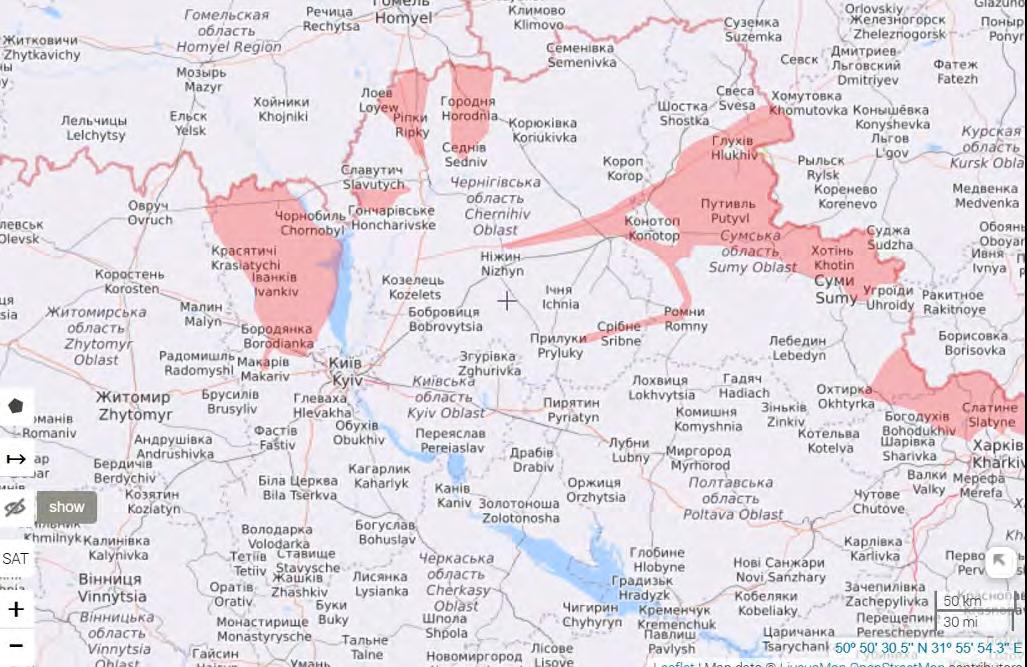
constricted LoCs, is likely to find its logistic activities at 1st, 2nd and even 3rd line threatened (assuming a lines of supply doctrine is being exercised). Such interdiction activity could have severe consequences, not only for the immediate tactical level battles and the logistics supporting them, but for any subsequent reinforcing/consolidation lines of development, stipulated within national/coalition operational and strategic plans. Secondly, the 2023 Land Operating Concept (LOpC), highlights that during future warfighting, ‘front lines’ will be permeable, to an extent where: “…smaller armies are intrinsically more porous operationally and tactically [and] their ability to physically prevent or deny enemy infiltration is reduced…”6 Contemporary operations are demonstrating that it is highly unlikely that all enemy threats will be neutralised by designated fighting echelons. It should therefore be expected that offensive actions will be deliberately targeted against critical rear area activities and resources. As this scenario continues to add complexity for logisticians supporting ‘close’ and ‘deep’ battles, it is an area necessitating further study.
Operation GARDEN was, for all intents and purposes, an echeloned Army advance on three main Corps axes. The designated main effort rested with 30 Corps, spearheaded by the Guards Armoured Division (GAD), commanded by Major General Allan Adair. Corps’ follow-on forces comprised 43rd (Wessex) and 50th (Northumbrian) Divisions.7 This study will concentrate on the operational and tactical levels (rather than the Allied strategic issues concerning ‘broad’ versus ‘narrow’ front) and cover specific aspects of the logistic support provided by the Royal Army Service Corps (RASC) to these formations.8 Each of these divisions had a transport-focussed logistic staff under the Commander RASC (CRASC)9 who controlled its organic RASC companies.10
Analysis of the nature and influence of the German blocks will focus on the 30 Corps main axis of advance (the GLoC), designated at the time as ‘Club Route’.11 So hazardous was this vulnerable supply route that it became known parochially as ‘Hell’s Highway’. Other significant considerations, such as the tactical impact on logistics and logisticians; the procedures adopted by logistic units which counteracted German threats; the innovative methods by which Allied forces ameliorated logistic shortfalls, and their cumulative operational impact, will also be examined. However, to fully appreciate the logistic challenges the Allies faced during MARKET-GARDEN, the context in which both Allied and Axis forces were compelled to operate post OVERLORD needs to be understood.

8 This map of the early days during the February 2022 invasion of Ukraine by Russia shows Russian armounded columns operating deep in Ukrainian rear areas. These will have undoubtedly inhibited Ukraine’s logistic resupply of fighting troops
8 Major General Allan Adair the GOC of the Guards Armoured Division
HISTORY 8 THE ROYAL LOGISTIC CORPS FOUNDATION THE REVIEW 2024 | 23
8 British communications organisation chart showing the locations and communications net for the Traffic Control Points along Hell’s Highway from the Escaut Canal to north of Nijmegen. The traffic control measures and communications methods would be vital for coordinating movements in the constrained space within the Arnhem ‘Corridor’
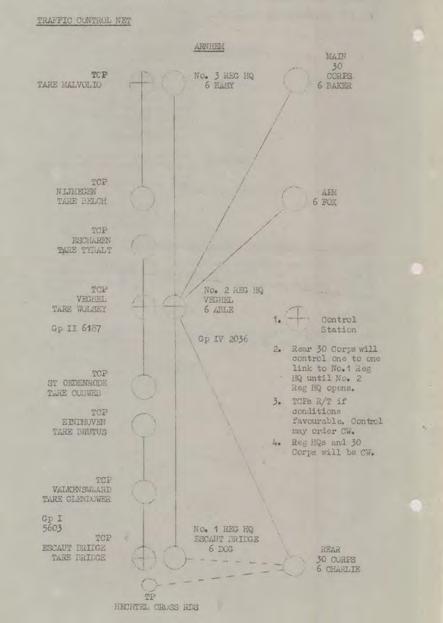
As a consequence, the advance towards the Dutch border was tenuous and could only be sustained by employing ad-hoc logistic measures. Large fleets of trucks were pooled, prioritised and reprioritised to ensure logistic flow. As a result, lower priority fighting formations were stripped of vehicles and subsequently became largely immobilised.15 Despite these ad hoc, expeditious sustainment solutions, the strategic limitations translated into operational level logistic problems near the Belgian–Dutch border –shaping the rushed operational planning for GARDEN. The result was that even formations on the main effort found themselves dangerously low in combat supplies. Transport shortages and a long, slow, replenishment route, prevented adequate stockpiling with reserves close to the area of operation and logistic resilience remained stubbornly fragile. Furthermore, there was no administrative liaison between the Allied airborne logistic staffs, responsible for MARKET, with British 2nd Army (commanded by General Miles Dempsey) planning GARDEN.

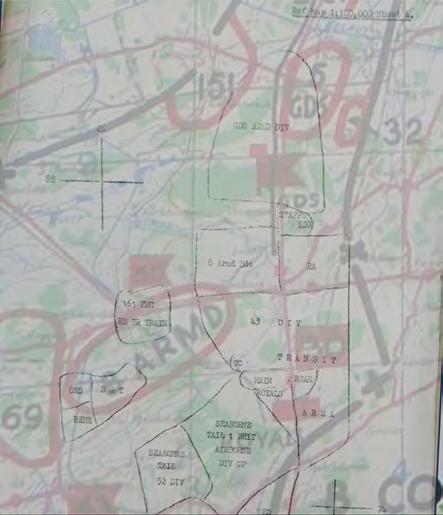
The Allied defeat of the Westheer12 in Normandy had been momentous but created strategic-level logistic problems. Despite the rapid Allied 400-mile advance across France in August–September 1944, the single point of supply distribution was constricted to the Normandy beachhead. For various reasons, outside of Normandy, the Allies lacked viable Channel ports to enhance the through-flow of materiel to their spearhead formations.13 Moreover, fighting power and resources were prioritised away from opening well-founded ports. Logistic innovations such as the MULBERRY harbours and PLUTO fuel pipelines either lacked capacity and resilience or bore fruit too late.14
30 Corps was effectively presented with a logistic ‘fait accompli’ of having to sustain two US airborne divisions on the ground in addition to its own divisions. To supply the American formations, four US truck companies were allocated but only arrived three days into the battle. Lack of a consolidated logistic operating picture resulted in inefficiency with some trucks carrying the wrong artillery ammunition for the units they were supporting, whilst others remained empty. This was symptomatic of poor inter-Allied liaison, co-operation and interoperability. At the tactical level there were insufficient C-Sups available to ‘prime’ the GAD to fulfil the main effort missions and tasks for GARDEN. Preparatory provisioning required the Division to carry eight days of supplies, 200 miles worth of fuel and double supplies of 25-Pounder (artillery) ammunition. The CRASC understated ordnance record declared: “Some difficulty being found … in replenishing 2nd line [stocks] with certain natures of amm[unition].” The petrol demand was also: “… greater than anticipated…”16 Attempts to restock ammunition were abandoned late on 16 September (D-Day-1) and ‘plundering’ ammunition deficiencies from flanking formations (11th Armoured Division, 8 Corps) was sanctioned. This would, unknowingly, have an operational impact. In summary, even before committing to MARKET-GARDEN, the Allies were forced to adopt a distribution program over a long LoC with high demands for CSups. Cannibalisation and pooling of unit transport to help sustain fighting formations hundreds of miles from the Normandy beachhead was a stop-gap measure that had significant limitations. The British strategic LoC was stretched to the limit and created a fragile operational level logistic situation. This unenviable operational position negatively affected the tactical level logistic preparations undertaken by 30 Corps prior to the commencement of this highly complex and risky mission.
Blocking Hell’s Highway
On the 17 September, the three airborne divisions landed around Eindhoven, Nijmegen and Arnhem to capture MARKET’s designated bridges. Almost immediately after crossing their start-line, the
8 HISTORY 24 | THE REVIEW 2024 THE ROYAL LOGISTIC CORPS FOUNDATION
8 A sketch by XXX Corps showing the assembly areas for Corps units prior to their release into the Corridor to Nijmegen and Arnhem
8 General Miles Dempsey, commanding British Second Army. Traditionally, he played a relatively low-key role in MARKET GARDEN but was key in coordinating activity especially between XXX Corps and its flanking Corps

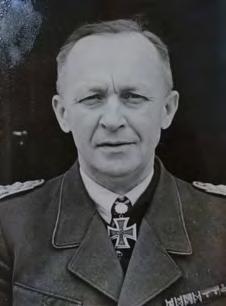
GAD met with stubborn resistance but advanced relatively swiftly to start ‘threading the needle’ through the bridges. The Westheer responded rapidly to the threat, and concentrated forces against the rapidly formed salient that the British advance created. Capable German combat ad hoc formations were rapidly employed from formed units and various battlegroups (kampfgruppen); the majority survivors of depleted divisions or makeshift units.17 Generalfeldmarschall Model found himself in overall command with Generaloberst Kurt Student’s First Parachute Army orchestrating the German counterstrokes from the east. A Guards officer summarised the developing situation where: “… many divisions of well-armed Germans … were now able to be directed to cutting our over-extended supply line, mostly dependant on single roads.”18 These German attacks were launched from east and west; despite poor coordination and synchronisation, they often achieved tactical superiority. Whilst it was quickly realised that Club Route needed to be protected, Hill identified that: “The American paratroops [predominantly 101st Airborne] were insufficient in numbers to guard more than the nodal points and it had been hoped that [the British] 8 and 12 Corps, moving up on the right and left of 30 Corps respectively, would make sufficiently rapid progress to remove the [flanking] risk(s)...”19 Of the numerous local assaults on the route, there were three main German ‘blocks’ which affected specific British offensive activities at key points.
8
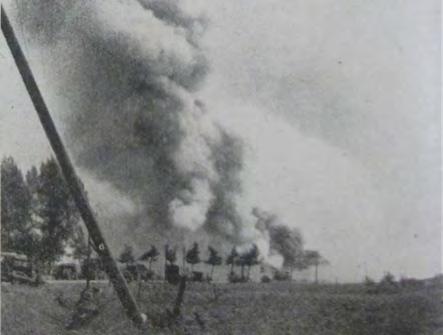
On 19 September, Panzer-Brigade 107 attacked Son (7 miles north of Eindhoven and 24 miles from the 30 Corps start line) from the east, with infantry and highly effective Panther tanks. American paratroops responded quickly to prevent the capture of the bridge, but German tanks engaged traffic on the bridge itself. The threat recurred the next day with further German actions. These attacks stopped traffic and constrained the supply lines, whilst British and American troops further north were engaged in an assault on Nijmegen. German troops held parts of this city and prevented the GAD from capturing the key bridges. A river crossing using canvas assault boats was planned to resolve this situation, but their delivery was severely delayed by German actions and the resultant traffic jams. These bottlenecks and delays ultimately stalled any rapid advance towards Arnhem and the relief of elements of the British 1st Airborne Division on the bridge. Consequently, the composite airborne force was eliminated in the early hours of the 21 September.
The second German blocking action (22–23 September) involved Kampfgruppe Walther (Panzer-Brigade 107 and a Waffen SS Kampfgruppe attacking Veghel (25 miles southwest of Nijmegen) from the east on 22 September. Another staunch defence by American paratroopers held the village but could not prevent German tanks crossing the road further north. A US paratroop subaltern described the desperate scene at Veghel where: “… the Germans began attacking with artillery and Panther tanks. One tank was coming directly at me; it fired on and destroyed a British ammunition truck to my right. The explosion knocked me uninjured to the ground. As the tank swung its gun in my direction it was hit by an anti-tank gun…”20 Casualties amongst German commanders blunted this attack, and the Panzers were forced to retreat. Whilst German attacks from east and west were poorly coordinated, even small unit actions proved effective at blocking the route. Kampfgruppe Huber, an ad hoc infantry formation (from Infanterie-Division 59), reached Hell’s Highway from the west before they were forced to withdraw. At 1500 hours on 22 September news of the ‘cut’ reached GAD HQ CRASC. From 1530 hours on 23 September, traffic was restarted but regulated to 10-vehicle packets every half-hour. During this period, 43rd Division was fighting northwards from Nijmegen to link up with the Polish paratroops south of the Rhine at Driel. Failed attempts were made to resupply 1st British Airborne Division, which found itself encircled and defending a shrinking perimeter north of the Rhine at Oosterbeek.
The last efforts to interdict the LoC (24–26 September) saw a handful of German Jagdpanther tank destroyers reach the road around Eerde where: ‘On the main road, Allied drivers frantically bailed out of trucks as the self-propelled guns began machine gunning and shelling the highway. Ammunition vehicles disintegrated into flaming, spitting pyres as the drivers scurried for cover, throwing themselves into roadside ditches.’21 A foray by FallschirmjagerRegiment 6 saw Major Jungwirth’s extemporised German battalion block the road near Koevering (southwest of Veghel) from about 1900 hours on the 24 September. Jungwirth’s troops shot up fifty vehicles and captured forty men.22 This force,
HISTORY 8 THE ROYAL LOGISTIC CORPS FOUNDATION THE REVIEW 2024 | 25
8 Generalfeldmarschall Otto Mortitz Walter Model commanded Army Group B and was in over-all command of German efforts to delay and halt the Allied offensive in Holland
8 Generaloberst Kurt Student was responsible for the grandly-named First Parachute Army which was responsible for attacks on the ‘Corridor’ from the east
Smoke from exploding vehicles blocks the view on Hell’s Highway during a German incursion onto the Allied GLoC
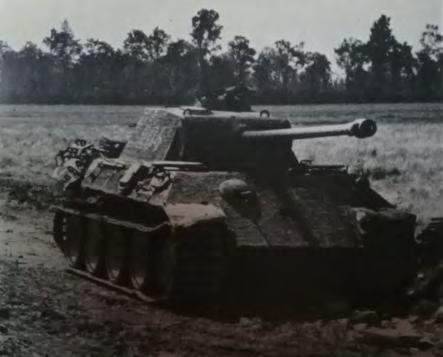
though pressed by Allied troops, halted traffic until they withdrew on the night of 25–26 September. The road was not re-opened until 1400 hours, 26 September. This third ‘block’ coincided with crucial decisions concerning the future of British 1st Airborne Division at Oosterbeek. Although localised in scale, the impact of this German tactical action exposed British operational level logistic vulnerabilities and affected Allied decision-making over the culmination of MARKET-GARDEN.
As well as the various localised kampfgruppe actions, German interdiction efforts were amplified by their multi-domain threats. On the evening of 19 September, Luftwaffe planes bombed Eindhoven which burnt out eight three-ton trucks carrying petrol belonging to 535 Company RASC.23 Ammunition lorries were also identified as high value targets and 310 Company had sixteen of these vital vehicles destroyed, four men killed and sixteen wounded,24 together with 227 Dutch civilian fatalities.25 Rubble also proved to be a major challenge and there were examples where Allied spearhead echelons, working with Dutch civilians, had to clear blocked roads to keep them serviceable.26 German bombers also targeted the GARDEN operational start line on the Escaut Canal bridge, delaying the flow of a range of follow-on logistic support. Even when bridges were captured, they required defending. The innovative German attack on the Nijmegen bridges on 23 September using frogmen, was one such action, but the necessity to defend bridges from localised attacks tied down finite fighting echelons which could have been deployed along the LoC in selected piquet lines.27
Impact on logistic activities
How did this range of impediments affect logisticians and logistic units? Describing the situation, one RASC officer illustrates what it was like to attempt to transit the ‘corridor’, where speed was of the essence: “It was slow going, as usual … We met with groups of American 101st [AB Division], exhausted but glad to be alive… In the little town of Veghel we waited a long time in the dark and the men quite rightly went to sleep. There were rumours of a German counterattack and of The Corridor having been cut, but nothing happened. At length we were told to get moving again…”28
Another observer recorded the confused state of the LoC at Uden (20 miles south of Nijmegen) where: ”… American paratroops had set up their
headquarters in a school; Royal Army Service Corps columns or pieces of columns, were parked around the streets; staff officers and their cars crowded the pavements … commanders separated from their units and units from their commanders. The interruption of all journeys had thrown everything into confusion…”29
Encountering the heavy fighting first hand by supporting troops was unexpected and hair-raising. A press officer, moving southwards towards Son, reported: “… a few miles north of it … streams of tracer bullets were passing across the open road in front. Guns were booming. We halted abruptly and were about to turn when a bullet went through the windscreen just in front of the driver and glass cut his face. We got out quick and retreated to cover…”30
This steady stream of localised, albeit sometimes uncoordinated, interdiction actions against lightly protected logistic units, had a cumulative effect far in excess of their limited scale. One tactical vignette of note concerned twenty-eight vehicles of B Platoon, 76 Company RASC, under command of Lieutenant Arthur Madden. The convoy was returning from Nijmegen and was engaged by German forces at approximately 1710 hours on 24 September between Veghel and St Oedenrode where heavy fire hit at least nine of their Fordson 3-ton lorries. The first four vehicles drove straight through, but the fifth lorry was stopped and blocked the route.31 The crews dismounted, took cover in the ditches and attempted to return fire. The enemy exploited the initial ambush and advanced across the main road surrounding and capturing survivors. In a similar low-level action, at least nineteen burnt-out Allied vehicles were found three miles north of St Oedenrode. These surprise attacks delivered unforgiving tests of battle inoculation for logistic troops; 76 Company, involved in these vicious assaults only arrived in France on 6 September.32 A Royal Artillery (RA) officer witnessed the scale and shock of the destruction where: “The supply columns suffered severely … it was a sad sight to see hundreds of yards of burnt-out 3-tonners on the verges where a column had been caught by a German attack.”33
Courses of Action
What were the courses of action open to logisticians to counter these German incursions and what, if any, relevance do they have in the contemporary operating environment? The actions of various logistic units, including RASC companies and convoys, provide some valid lessons for contemporary operations. To gain an appreciation of the chaotic nature of rear operations for the opposing sides, it is worth building a general picture along Route Club of the conduct of localised assaults and the reactions of selected individuals and sub-units.
A common thread, albeit unpalatable reaction to enemy operations during GARDEN, was the acceptance of losses in rear areas, as demonstrated by 76 Company. This acceptance was a recognition of the febrile operating environment along the LoC. Despite Dutch patriots providing local intelligence, the enemy operating picture proved challenging to verify, consolidate and disseminate in a timely manner. Exacerbating this opaque enemy picture was the limited capability to track convoys and inform them of updated threats. When combined, these challenges
8 HISTORY 26 | THE REVIEW 2024 THE ROYAL LOGISTIC CORPS FOUNDATION
8 A knocked-out Panther medium tank; one of the most effective German tanks in NW Europe. Similar Panthers of Panzer-brigade 107 were able to attack and interdict Hell’s Highway but were unable to form a permanent block to the British LoC
highlight the increased risks of operating without any ‘common operating picture’. One Guards officer commenting on the parlous state of timely intelligence quipped…”We found that the BBC gave us better up-tothe-minute information than … Army sources.”34 Even acknowledging the risks along the LoC, accepting a percentage of casualties and destroyed materiel might initially appear callous, but it should be recognised that this acceptance does not abrogate a commander’s responsibility to minimise the psychological and physical impact on the force. Losses must be expected and even planned for (and trained for) in advance, if credible risk mitigations are to be identified. Although challenging to achieve with finite resources, building increased resilience, through selected duplication of effort and careful temporary earmarking of certain stocks (credible reserves), offers some semblance of enduring sustainment through dispersal and transient stock redundancy. Conscious earmarking of logistic reserves whilst a force is in, or about to commence, combat, requires a change of mindset as automatically categorising such deliberate action as ‘waste’ must be resisted. Just-in-time logistics might be a budget manager’s mantra in the commercial world, but it can undermine a fighting force whose survival might be entirely dependent on accessing dispersed contingency stocks. Eliminating a single point of logistic failure reinforces supply chain resilience.
With hindsight, the contemporary philosophy of ‘fighting logistics through,’ was applied during GARDEN. 552 Company (supporting 8th Armoured Brigade) for example, reported that: “We had made the journey up with fixed Brens [LMGs mounted on vehicles] and had one or two encounters with the enemy. We went up to Nijmegen loaded with six days’ rations, and as these gradually dwindled, the position looked as if it might become rather desperate.”35 Other sub-units, like 505 Company, anticipated operating tactically in its Company Orders, declaring that: “This move will be tactical and strict discipline will be observed… Normal drills with regard to camouflage and dispersion will be put into force and defence arrangements will probably be considerably increased.”36 Stronger force protection of the logistic elements of the GAD was planned for and on the 17 September the ‘A’ Echelons and RASC of the GAD were escorted by two squadrons of the HCR, reinforced by mobile anti-tank guns (73rd AT Regiment).37
Some convoys, who had clearly prepared to contest the route, responded aggressively when ‘bumped,’ resulting in, “… a spirited battle fought by one scoutcar and the crews of several three-ton lorries under the personal command of Brigadier Glyn Hughes … Deputy Director of Medical Services at [30] Corps … provid[ing] a good example of how their [logisticians] fortitude can be every bit as high as that of the fighting troops…”38 In another low-level action, an air despatcher, Corporal Sproston, survived an aircraft crash only for the British convoy he was travelling in to be attacked by enemy tanks. Adopting an aggressive stance: “A small party from the convoy took up their positions in a small house and Cpl Sproston … directed with great effect the fire of a Bofors [anti-aircraft] gun.”39 This widespread adoption of a ‘fighting ethos’ by ad hoc units was proven to strengthen the overall resilience along the supply routes.

In an effort to maintain momentum, one logistic unit took the initiative and deliberately bypassed enemy incursions during GARDEN. As part of the follow-on force within 50th Division, an RASC subunit commander recalled bypassing German blocks where: “It was decided to move on minor routes east of the main road … it was ordered that the company … should move during the night and establish a composite [supply] point south of Nijmegen. Some of the villages on the route were occupied by our own troops otherwise there was no demarcation between ourselves and the enemy.”40
On reaching their destination, the Company spent an uncertain night with enemy forces withdrawing nearby. Although bypassing the block at night was risky, it likely worked due to uncoordinated German interdiction operations. Training to operate in isolation and developing an appreciation that chaos often reigns for all belligerents, can lead to low level commanders accepting risk and seeking to take the initiative. The paucity of suitable supply routes in support of GARDEN limited bypassing opportunities however, and other expediencies had to be adopted. General Horrocks employed a platoon of armoured vehicles to get him past German blocks using back roads to reach his Forward HQ. Other senior officers used light aircraft to avoid blocks but, even compared to road movement, this proved high risk and threequarters of them were shot down or forced back.41
Another tactical response was for logistic and other ad hoc units, to join forces and leaguer-up to defend themselves until the situation resolved itself. When Route Club was cut, rather than withdraw, 1561 Artillery Platoon RASC was ordered to go-firm and stand-to in fighting positions around the farm buildings they occupied south of Veghel. Elsewhere along the same route, transiting personnel joined together for collective protection using any available weapons. A Guards officer attempting to return to the line recalled: “… the Germans had cut the centreline… a mile in front and had brewed up a hundred
8 Two soldiers sit/lean on the front of their White half-track waiting for something to happen. Whilst German troops attacked the British GLoC many men were thus trapped in traffic jams or with their routes blocked. Unit and location unknown
HISTORY 8 THE ROYAL LOGISTIC CORPS FOUNDATION THE REVIEW 2024 | 27
8 A sketch showing the harbour arrangement for 310 Company RASC just off the Hechtel-Eindhoven road near Vlasmeer. The sentry points represented by arrows represent stag positions equipped with Bren light machine guns and Projector Infantry Anti-Tank (PIATs) giving the company protection from both infantry and tank attacks.

310 Company supplied the Guards Armoured Division with Ammunition of our vehicles… the road ahead suddenly appeared deserted … I set about making a defensive position in a small house … and with the few Guardsmen available set about to man each window. They had rifles with little ammo, and I only had my revolver with six rounds. There was a 17-pounder antitank gun in the column … but it too had no ammo … we spent an anxious and uncomfortable, if not frightening, night awaiting the Germans, added to which it was pouring with rain.”42
This particular village (Nijnsel): “… was a chaotic sight, full of vehicles of all kinds who had just escaped the gap.”43 The actions around Nijnsel were not untypical of what was being replicated all along Route Club where, in the ensuing chaos, some men when captured, were able to immediately escape their enemy. A convoy of American vehicles, crewed by US paratroopers, was captured near Koevering and the drivers were rounded up into a roadside ditch – they subsequently escaped, adding further chaos to the situation when their guards were distracted.44 Other vehicle drivers had to lie-low and await safety when fired upon. Driver Gamgee, another air despatcher, was shot down on the 19 September and ‘hitch-hiking’ with a returning convoy carrying German prisoners experienced the vagaries of transiting the LoC, recalling that: “We could not have gone two miles past the village (Son) when we heard … the sound of a shell exploding not far away … we jumped out and got down in a ditch … The prisoners had to remain in the lorries … a truck travelling towards us had been struck and started to burn. More shells came over and hit another truck … They were both supply trucks containing ammunition and we had to wait there for about two hours whilst they burned out…”45
Private Ferguson was a despatch rider at the rear of a 536 Company convoy. His motorcycle was hit by enemy fire and stopped; he had to run for cover. Ferguson spent three days and nights hidden in the loft of a house which was occupied by a German HQ until his eventual rescue by American paratroops.46 Routinely training for chaos in rear areas, encouraging dispersed troops to take the initiative, adopting an aggressive stance and accepting risk, are likely to enhance the overall logistic resilience along supply routes. Overcaution along Route Club often forced logistic units to stop and leaguer unnecessarily. 310 Company reported standing-to in their harbour on 18 September due to a ‘rumour’ of enemy tanks breaking through the advancing columns and similar reports on 19 September of logistic vehicles being attacked by German tanks near Eindhoven added to this overcaution.47 The result was
that the columns of 310, 535 companies, and other British convoys, were stopped in Eindhoven at about 1800 hours, delaying the vital support to Arnhem and the spearhead echelons whilst also making them vulnerable to air attack.48
Employing speed, however, did not necessarily ensure that hazardous areas of Hell’s Highway could be forced, even for small, determined detachments. Sergeant Shoesmith was one of two free-running motorcyclists heading north on 24 September where: “… The traffic had stopped again … and we suddenly found ourselves on an open stretch of the road … shells began to fall in quick succession and the air was filled with S[mall] A[rms] … fire at extremely close quarters … I cleared the area at great speed. I stopped about a mile down the road … SQMS Hilton was no longer with me…”49
On Hell’s Highway the German blocks were generally too strong to be forced aside, or fought through, by convoys. The last resort was to employ combat units to destroy enemy forces but there was an obvious downside where: “…troops who should have been fighting at the front now had to be sent back along the supply-route, creating more chaos and delay…”50 On the 23 September, the blocks on Hell’s Highway were so threatening to 30 Corps’ mission that the Grenadier and Coldstream Guards groups (50% of GAD combat power) were sent south from Nijmegen, attacking along the Centre Line towards Veghel.51 Traffic, including an RASC troop-carrying convoy taking infantryman north, was ‘frozen’ to allow them past. The chaos and frustration caused by these reactionary movements was felt by those attempting to move north at speed where: “…twice D.R.’s (dispatch riders) came back down the road waving us to the side and stop. This was to allow a column of tanks… through… [We later] found out the Germans had cut the road behind us. I, like everyone else. found it very hard to keep up with what was going on.”52 Concurrent with this Guards’ route clearing operation towards the south was another attack pursued by the 101st Airborne and 50th Division pushing northwards to clear a portion of the Centre Line - also taking temporary priority over transiting convoys.
In the ensuing chaos, close battlespace management and strict traffic control measures offered some potential mitigation for sustaining
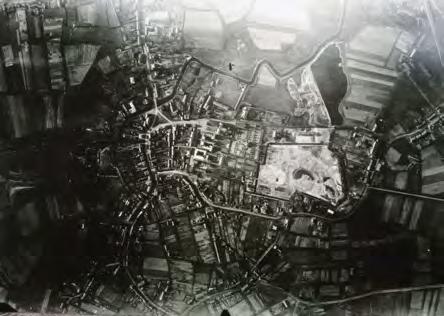
8 HISTORY 28 | THE REVIEW 2024 THE ROYAL LOGISTIC CORPS FOUNDATION
8 The small town of Veghel from above taken from the south. During MARKET GARDEN the streets would have been filled with vehicles awaiting the results of the German attacks to the south and east of the town. German tanks were stopped just to the east of this picture
throughflow on Hell’s Highway, but there were several challenges to incorporating these enabling measures. Orders for GARDEN required twenty-thousand 30 Corps vehicles to navigate key bottlenecks. A traffic organisation to manage movements and prioritisation was only created the day before the operation commenced from available RA officers and signallers. Radios only worked intermittently, and despatch riders were heavily relied upon to maintain communications.53 It was found that whilst the traffic flow might be successfully ‘frozen’ to allow urgent convoys to pass rapidly (one ‘priority’ formation completed 47 miles in 3.25 hours), the price was a delay to other forces, who then might become the next priority move. Exacerbating all movement was that transit was only authorised in daylight hours, only later was permission given for night moves.
Response to cutting of the LoC
To appreciate how the impact on the operation was minimised, it is worth examining the remedial supply measures adopted by 30 Corps’ units when the rearward link was temporarily interdicted. The efforts made to reduce logistic ‘pull’ are worthy of study and provide possible lessons for contemporary sustainment operations. Beyond starting with increased second-line stocks, there had been no formal 30 Corps logistic plan to mitigate the contingency of the LoC being cut. Though F-echelon and 1st Line stockholding had also been increased, it only offered increased sustainment for a finite period and was dependent on the rate of consumption.
Disruption to the MSR quickly led to increased consumption of organic supplies and depletion of immediate replenishment stocks – resulting in unsatisfied demands with no predictions for when they would be met. Units committed to GARDEN had little logistic resilience once contact had been made and any options to alleviate paucities in combat supplies were limited. Although, compared to the Germans, the Allies had extensive theatre resources at their disposal, due to distribution problems, they were not readily available to sustain all of the force during their peak demand periods and a priority system had to be adopted. Although British 2nd Army was temporarily allocated significant air support resources, air despatch was not available to resupply 30 Corps units as all air drop capacity was allocated to British 1st Airborne Division. Whilst an obvious measure was to reduce logistic demand and minimise corresponding stock depletion, the challenge often proved insurmountable. Many critical items could not be sourced locally and, despite many universal vehicle platforms and weapon systems, there was relatively low levels of US–UK ammunition interoperability. Even when supplies were airdropped to the US airborne divisions along Route Club, ammunition natures and other vital materiel was not compatible with 30 Corps unit inventories. One notable exception was .30 calibre ammunition which was collected from drop zones (with US permission) to replenish 30 Corps and helped in defending the LoC.54
Another measure, rarely exercised in the contemporary environment, was the routine adoption of ‘cross-servicing’ of materiel held forward. Logistic risk along the whole length of the LoC was mitigated to a degree by the careful re-prioritisation and

redistribution of supplies between units. As 43rd Division had entered ‘the corridor’ later than the GAD, and therefore had less-depleted stocks; it crossserviced ten lorry-loads of 25-Pdr ammunition on 23 September to the Guards. Other reprioritisation occurred on 25 September when ammunition (No36 Grenades and PIAT projectiles) held at second-line by 43rd Division, was expedited to the Rhine for onward distribution to 1st British Airborne Division units. Distribution of stock, as with all large-scale operations, was not universal and despite some shortages, 505 Company RASC (43rd Division) reported: “Considerable holdings at A[mmunition]P[oint] and situation not yet critical.”55 Despite not having a common operating picture, isolated forces proved adaptive and not only mitigated logistic risk through cross-servicing and ruthless prioritisation but also capitalised on opportunistic sources of sustainment.
‘Issues’ at Oss
Late on the 20 September, Captains Tull (RASC) and Cough (RAMC), were urgently transported by Welsh Guards reconnaissance vehicles to a part-captured German ration depot at Oss (near Nijmegen) to assess the situation. This unique depot epitomised the degree to which friction affects all belligerents on high tempo operations. A bemused Guards officer recorded that: “There were some comic incidents: we discovered that a supply depot run by a Dutch staff from which we drew rations was also used by the Wehrmacht! They drew and signed on different days…”56 The situation around Oss remained tenuous for all the belligerents and, due to finite combat power, no GAD troops were available to permanently secure the isolated depot.57 Unsurprisingly, incidents of ‘predatory logistics,’ resulting in the ‘unofficial’ removal of cherry-picked supplies by British units, was reported.58
Oss was utilised by British troops, including spearhead units of the GAD from the 21 September59 but the situation remained fluid. On the 25 September, ‘B’ platoon of 552 Company RASC, under command of Lieutenant Derrick Wigg, was loading rations at Oss when Dutch resistance personnel and increased shelling, informed them that the Germans were planning to retake the depot. Wigg’s men, with some Dutch locals, quickly deployed into fighting positions,
HISTORY 8 THE ROYAL LOGISTIC CORPS FOUNDATION THE REVIEW 2024 | 29
8 A overhead view of the town of Oss (looking from the south) showing the various ration depots and stores around the town
despite few of them having seen action. A 200-man German force armed with machine guns, mortars and two self-propelled guns assaulted the depot. A further RASC platoon under Lieutenant Wagstaff arrived and joined the defenders in close quarter actions where the RASC-men used their PIATs as improvised mortars to demolish two houses containing German snipers.60 After an hour, and with the assistance from a Guards sub-unit, the Germans withdrew leaving 75 casualties and the depot in Allied hands.61 As an example of the absurdity of war, according to one source: “Before leaving, the [RASC] Company was asked rather pathetically by the German officer in charge to sign for what they had taken…”62 Whilst some happy ‘customers’ in the GAD enjoyed a break from normal rations, opinions were mixed. One officer recalled: “We’ve been living on captured German rations for the last few days. Some of it is very good…”63 , while another soldier; “… rejoiced that such German ‘delicacies’ were not, apparently, on any longer-term basis than a few days.”64 A more measured assessment of the importance of Oss and its effect on the tempo of operations along the LoC, was recorded in an official British account concerning GARDEN where: “Had the enemy supply stores at Oss not fallen into our hands it might have been necessary to call an earlier halt to the operation. The capture of [the] Oss dump was indeed the only stroke of good fortune in the administration of an operation marred … by two unexpected and disastrous severances of the main axis.”65
Impact on operations
How did these LoC blocks affect Allied tactical activities at divisional level? In broad terms, the interdiction of Route Club was summarised where: “The limitation to a single supply route for so vast an operation presented the administrative staffs with a whole set of difficult problems quite apart from the risk of enemy attacks on it.”66 The steady depletion (without imminent replacement) of first and secondline stocks of all commodities was a significant problem. For 25-Pounder ammunition (the staple artillery nature) only 100 rounds per gun was left on 23 September and by 1900 hours on 24 September, all second-line 25-Pdr stocks had been expended. Likewise, by close of play 25 September, there was no 3-inch mortar ammunition available at second-line, presumably resulting in rationing across the Fightingechelons. This situation was exacerbated by further cuts to the Centre Line with demands remaining high.67 Horrocks remarked that: “Artillery ammunition was really becoming dangerously short, [with] one regiment … down to five rounds per gun…”68 There were also second-order effects of these cuts. Isolated transport columns could not conduct rearward loops to allow future resupply tasks, maintenance, or vital reverse supply chain activity. They prevented the evacuation of casualties, which presumably reduced patient survivability and affected moral. Likewise, 1,500 prisoners remained a burden to their captors until they were finally evacuated by RASC vehicles on 24 September.69 The cessation in logistic flow added to the traffic jams which further delayed movement. An example of the scale of the challenge was provided by 504 Company (43rd Division) which took twenty-one hours (20–21 September) to travel
about twenty miles to Eindhoven.70 Urgent priority equipment, such as assault boats for the Waal crossing by US paratroopers on 20 September, could not be rapidly delivered and significantly restricted the Allies’ opportunities and freedom of action.
As previously noted, cutting the LoC helped create a ‘crisis point’ that affected operational decisionmaking. At one level it prevented commanders moving between conferences. According to General Dempsey: “The cutting of the road did have quite an effect on the development of our operations, and was a very good move by the Germans. I had a perfectly peaceful drive to … Horrocks’ HQ at Nijmegen on 21 September but when we met at St Oedenrode on 24 September he had difficulty in getting back to his HQ…”71
Perhaps more importantly, at the latter meeting, Dempsey rubber-stamped Horrocks’ plan to either reinforce or withdraw British 1st Airborne Division north of the Rhine. After the unsuccessful attempt by elements of the Polish 1st Parachute Brigade to cross the lower Rhine and link with the British 1st Airborne Division (night of the 22/23 September), Horrocks had decided that a single infantry battalion from 43rd Division72 would cross the Rhine to reinforce British 1st Airborne that night (24/25 September). The scale of the reinforcement was primarily limited by the boats available to 43rd Division.73 30 Corps’ intent was to either send a brigade across the Rhine or withdraw the remnants of 1st British Airborne Division. This latter, pessimistic course of action, was affected by the knowledge that the Germans had already cut the corridor once; shortly after Dempsey’s and Horrocks’ meeting they cut it again. Middlebrook assessed the gravity of the situation, deducing that when: “The Germans cut the corridor south of Nijmegen … it was this which really signalled the end of ‘Market-Garden’.”74 The failure of the Polish and single-battalion crossing, reinforced the tactical logistic complications of supporting the airborne troops. These setbacks on the lower Rhine, combined with the operational logistic problem of a cut LoC and tenuous strategic supply lines, dramatically altered British decision-making. Horrocks considered his, and British 1st Airborne Division’s increasing isolation and concluded that: “Reserves of everything we wanted [to prolong the operation] – ammunition, assault boats, etc. – were unfortunately on the far side of the ‘cut’…”75 At 1215 hrs on the 25 September, after consultation with Montgomery, Dempsey ordered Horrocks to withdraw the remnants of British 1st Airborne Division that night. Whilst there is little doubt that the cutting of Hell’s Highway contributed significantly to the early culmination of the GARDEN offensive, this tipping-point in the battle perversely highlighted the complexities of multinational, air-land operations, as the decision to withdraw nearly coincided with improved news concerning the operational logistic situation. The advance by 11th Armoured Division had been delayed in starting and was under-resourced.76 Such are the vagaries of war however, that this delay created a new axis for 8 Corps which allowed vital supplies to bypass Veghel.77
The poor logistic situation for 30 Corps in lateSeptember 1944 had wider effects at the Strategic level beyond MARKET-GARDEN. The subsequent GATWICK plan: “… represented an attempted continuation of this risk-embracing mentality …
8 HISTORY 30 | THE REVIEW 2024 THE ROYAL LOGISTIC CORPS FOUNDATION
Montgomery might secure logistical priority for his proposed ‘narrow-thrust’ offensive astride the Ruhr into the north German plain.”78 Montgomery’s direction on 27 September for operations post MARKETGARDEN stated: “… we stand at the door of Germany, and are likely now to have another dogfight battle or killing match.”79 GATWICK would therefore be an attritional, logistic-heavy, set-piece attack.80 In the circumstances facing the British forces after MARKETGARDEN, typified by a vulnerable LoC, executing GATWICK immediately was deemed either unfeasible or a very high-stakes gamble. It was not until early 1945 that any version of GATWICK was launched.
Conclusion
Heinz Harmel, a German commander at Arnhem, remarked about MARKET-GARDEN: “Historians, have narrow-mindedly concerned themselves with [studying] Arnhem and Oosterbeek. The Allies were stopped in the south just north of Nijmegen – that is why Arnhem turned out as it did.”81 Whether 30 Corps had reached Arnhem, or not, GARDEN was already unravelling under the weight of strategic, operational and tactical logistic problems. Restricting the Allied GLoC, limited operational freedoms and options. Commanders misunderstood the logistic risks and realities. General Adair wrote that he: “underestimated the problems of advancing on such a narrow front”82 Another officer considered: “that the rate of progress planned for the ground troops was absurdly optimistic”83 Nonetheless, the Guards paid tribute to their logisticians, recognising that: “The duties of members of the supply services were especially arduous … there existed the constant threat of attack from the flank. Few supply columns can have been driven more miles with so little rest and under such harassing conditions”84
The British Army of today can learn relevant logistic lessons from the impact of German attempts to sever Hell’s Highway:
5 One enduring administrative lesson was: “… the wisdom of ordering formations to carry the maximum possible reserves was amply demonstrated when the L. of C. was cut.”85 Holding stock forward provides some ‘insurance’ (resilience) against isolation, providing some operational flexibility and offering commanders options. However, this additional materiel can reduce mobility unless sufficient ‘lift’ can hold stocks on wheels
5 Providing enhanced levels of stock forward to F and A1 echelons needs to be balanced against the rest of the deployed force and aligned with the main effort. Reinforcing unexpected success could be challenging if stocks of finite commodities are held too far forward in isolated units/formations. Logistic agility can be achieved by carefully balancing force resources and allocating force elements to likely tasks
5 Movement along restricted LoCs underline the importance of traffic control, commodity prioritisation and all-informed rear-area battlespace management. When Emissions Control (EmCon) measures require cessation of voice/ data transmissions reversionary methods such as despatch riders or line communications may become necessary
5 Logistic manoeuvre elements/units must be sufficiently equipped, trained and informed to
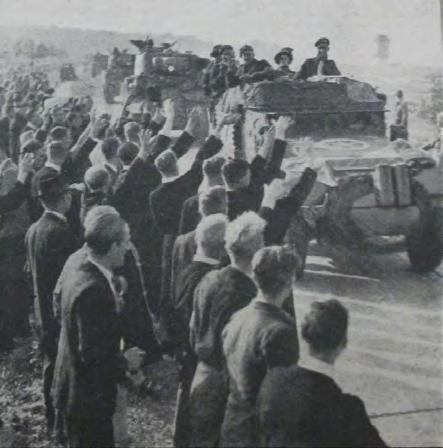
enable them to fight-through, bypass, or defend against enemy incursions (depending on the threat) whilst liaising with friendly FEs or offensive support. Bypassing enemy units might require convoys to routinely operate effectively at night, in poor weather, across country and under EmCon restrictions to evade detection
5 A force facing isolation or constrained supply lines may need to re-prioritise and re-apportion stocks (cross-servicing) between units, examine alternative solutions to logistic shortfalls or face committing combat power to resolve these issues. The stark alternative is accepting limitations to operational freedom and an operation culminating prematurely. The risk of these outcomes must be weighed against the perceived impact from friendly close and deep operations against enemy logistical support. Ready access to a timely common operating picture will allow commanders to rebalance logistic units and stock to meet emerging opportunities or deficiencies.
The needle and thread analogy for GARDEN only acknowledged the ‘tactical’ logistic problem of reaching British 1st Airborne Division and ignored the threat from the German ‘scissors,’ constantly trying to severe the fragile Allied ‘thread’ (the operational level logistic problem). The analogy is also in danger of downplaying the strategic complications resulting from over-extended supply lines (theatre and operational). Whilst Arnhem bridge was ‘a bridge too far’, the greater issue contributing to the mission’s culmination was the physical and mental impact of an unprotected and vulnerable GLoC running 75 miles through contested and congested space. The 30 Corps history considered that MARKET-GARDEN: “might have just been possible had not the Corps’ lines of communication been continuously interfered with. When the Germans cut the axis they prevented the arrival of ammunition and the vital assault boats … It [MARKET-GARDEN] was the first [and only] time that Club Route had been cut.”86 If MARKET-GARDEN is deemed a failure, considering British 2nd Army’s optimistic scheme of manoeuvre and the sporadic, yet debilitating series of enemy actions against the LoC, perhaps the efforts of 30 Corps logisticians
HISTORY 8 THE ROYAL LOGISTIC CORPS FOUNDATION THE REVIEW 2024 | 31
8 Armoured vehicles of the Guards Armoured Division head north towards Nijmegen and Arnhem welcomed by Dutch civilians. This image was likely taken during the early stages of MARKET GARDEN
might be considered in a new light – such was their success along Route Club, they actually masked the scale of the defeat. In the contemporary operating environment, with comprehensive training, the continuous encouragement of an offensive mindset across all logistic functions, underpinned by a willingness to support calculated risks; there is every chance that physical and mental resilience can be built into our strategic, operational and tactical LoCs.
Endnotes
1The outline plan for Op GATWICK, and efforts to implement it, are covered in Hart, Stephen Ashley, Exploiting ‘Market Garden’? Operation Gatwick’ - The Offensive that Never Was in Buckley, John and Preston-Haugh, Peter (eds), Operation Market Garden, Helion, Warwick, 2018.
2Ibid, p.188.
3Those interested in studying the airborne logistics of MARKET should consult Brigadier Frank Steer’s Arnhem, The Fight to Sustain, Pen & Sword, Stroud, 2020.
430 Corps and 2nd Army have been used throughout for simplicity instead of ‘XXX Corps’ or ‘Second Army’.
5Adair, Allan, A Guards General, Hamish Hamilton, London, 1986, p.163.
6Unknown Author, The Land Operating Concept, A New Way of Winning, Army Futures, Andover, 2023, p.41.
730 Corps (on the Main effort) was protected by 8 Corps and 12 Corps on the eastern and western flanks respectively.
8Ordnance, catering and labour will not be covered.
9Lieutenant Colonel Albert Woods was the GAD CRASC.
10Each fighting brigade had an RASC Brigade Support Company with a further company supporting divisional troops. The GAD distributed their companies by commodity/ function (ammunition, petrol, troop carrying etc).
11Gill, Ronald and Groves, John (eds), Club Route, 30 Corps in Europe, Werner Degener, Hannover, 1945.
12The German Army in Western Europe.
13Cherbourg had been severely damaged before its capture. German garrisons in the Scheldt estuary prevented Antwerp being used. Other ports were occupied by German troops (Dunkirk) or had limited logistic capacity (Dieppe).
14Searle, Adrian, Pluto, Shanklin Chine, Shanklin, 1995, pp.58-60. Carter, J and Kann, D, Maintenance in the Field, Volume II: 1943-1945, War Office, London, 1961, p.288.
15The US Army addressed similar logistic problems by creating the ‘Red Ball Express’ an; ‘… innovation in logistics distribution … a non-stop conveyor belt of trucks connecting Normandy depots with the [US] field armies.’ The system used 6,000 trucks but even with massed road transport, the US First and Third Armies could not meet their own logistic requirements. The Red Ball Express consumed approximately 300,000 gallons of fuel a day compared to Third Army which used about 313,000 gallons. Campbell, Corey, Battle of Metz, September 1944, in Beurskens, Keith (ed), The Long Haul, Army University Press, Fort Leavenworth, 2018, pp.68-71.
16GAD CRASC War Diary, The National Archives WO171/384.
17Ad-hoc German battlegroups, named after their commanders, were often formed from any available troops.
18Gorman, John, The Times of My Life, Leo Cooper, Barnsley, 2003, p.55.
19Hill, E and Ross, The Story of the Guards Armoured, Geoffrey Bles, London, 1956, p.152.
20Perdue, Bob, Battle of Veghel Revisited, After the Battle, Number 127, dated 2005, p.34.
21Kershaw, Robert, It Never Snows in September, Ian Allan, Hersham, 2007, p.282.
22Ibid, p.284.
23535 Company WD, TNA WO171/2492.
24The GAD lost six logisticians killed and twenty-three vehicles destroyed from this bombing. GAD CRASC, TNA WO171/384.
25Gardner, Ian, Deliver us from Darkness, Osprey, Oxford, 2012, p.137.
26McKee, Alexander, Race for the Rhine Bridges, Souvenir Press, London, 2001, p.210.
27German Small Battle Unit Operations, TNA CAB146/447.
28Adams, Richard, The Day Gone By, Hutchinson, London, 1990, p.339.
29Ross, Guards Armoured, pp.152–153.
30Wigham, Eric, Fight for a Vital Road, Manchester Evening News, 23 September 1944, p.1.
31RASC Missing, TNA WO361/576.
3276 Company WD, TNA WO171/2374.
33Kiln, Robert, D-Day to Arnhem, Castlemead, Welwyn, 1994, p.178.
34Gorman, Times of My Life, p.55.
35House, R, Any Complaints?, RASC Review, Volume 69, Issue 3, January 1945, p.98.
36505 Company WD, TNA WO171/2473.
37GAD Grouping and Order of March, Unknown Author, Operation Market Garden, Historical Branch, London, Undated, p.96.
38Ross, Guards Armoured, pp.154–155.
39Sproston MM citation, TNA, WO373/53/312.
40Carpenter, V, The Clayton Essay Competition, RASC Review, Volume 1, Issue 9, 1956, p.69.
41Horrocks, Brian, Corps Commander, Sidgwick & Jackson, London, 1977, p.124.
42Boscowan, Robert, Armoured Guardsmen, Leo Cooper, Barnsley, 2001, p.128.
43Ibid, p.129.
44Gardner, Deliver us from Darkness, p.163.
45van Tesseling, P-A, Over and Over, Kontrast Publishing, Oosterbeek, 2000, p.176.
46Gill & Groves, Club Route, p.82. RASC Missing, TNA WO361/576.
47310 Company WD, TNA WO171/2434.
48Gardner, Deliver us from Darkness, pp.137–138.
49Staff Sergeant Hilton was captured. RASC Missing, TNA WO361/576.
50Gorman, Times of My Life, p.55.
515th Battalion Coldstream Guards WD, TNA WO171/1252.
52Pearce, Lance, Ace of Spades, Lance Pearce, Unknown location, 2013, p.70.
53Unknown Author, Operation Market Garden, p.85–88.
54310 Company, TNA WO171/2434.
55505 Company, TNA WO171/2473.
56Lord Carrington, Reflect on Things Past, Collins, London, 1988, p.61.
57Ross, Guards Armoured, pp.146–147.
58McKee, Rhine Bridges, p.268.
59224 Company WD, TNA WO171/2412.
60Boydell and Smith received Military Medals. Boydell and Smith MM citations, TNA WO373/52/792, WO373/52/795.
61Wigg and Wagstaff as ‘an example of coolness and bravery to all,’ were awarded the Military Cross each. Wagstaffe and Wigg MC citations, TNA WO373/52/709, WO373/52/710.
62Unknown Author, The 8th Armoured Brigade 1939–1945, Privately published, 1946, p.22.
63Barer, Robert, One Young Man and Total War, Pentland, Cambridge, 1998, p.138.
64Lawrenson, William, Of Straw and Stripes, Pentland, Bishop Auckland, 1998, p.178.
8 HISTORY 32 | THE REVIEW 2024 THE ROYAL LOGISTIC CORPS FOUNDATION
65Carter and Kann, Maintenance in the Field, p.324.
66Ross, Guards Armoured, p.125.
67505 Company, TNA WO171/2473.
68Horrocks, Corps Commander, p.125.
69310 Company, TNA WO171/2434.
70504 Company WD, TNA WO171/2472.
71Letter from Dempsey to Ellis, 18 June 1962, TNA WO285/29. 724th Dorsetshire Regiment was the lead battalion of 43rd Division. 316 men successfully made the crossing but few linked up with British 1st Airborne and most were subsequently captured.
73Horrocks, Corps Commander, p.122.
74Martin Middlebrook, Arnhem – 1944: The Airborne Battle, Penguin, London, 1995, p.417.
75Horrocks, Corps Commander, p.125.
76According to one officer; ‘There’s a shortage of petrol and supplies and some captured German rations are being issued today!’ Gainsford, Alan, My War Diary, Tim Gainsford, Unknown Location, 2012, p.89.
77Miles Dempsey, The Second Hundred Days, Unpublished, TNA WO205/10.
78Buckley & Preston-Haugh, Market Garden, p.188.
79General Operational Situation and Directive, M527, dated 27 September 1944, TNA, WO285/2.
80Buckley & Preston-Haugh, Market Garden, p.192.
81Kershaw, It Never Snows, pp.313–314.
82Adair, Guards General, p.163.
83Carrington, Reflect on Things Past, p.59.
84Ross, Guards Armoured, pp.154–155.
85Carter and Kann, Maintenance in the Field, p.325.
86Gill & Groves, Club Route, p.86.
Bibliography
Unpublished sources
van Emden, Henry, sound recording, Imperial War Museum, 27494.
Blake, John, sound recording, Imperial War Museum, 26844. German Small Battle Unit Operations, TNA CAB146/447.
Guards Armoured Division CRASC WD, TNA WO171/384. 5th Battalion Coldstream Guards WD, TNA WO171/1252.
76 Company WD, TNA, WO171/2374.
90 Company WD, TNA WO171/2377.
171 Company WD, TNA WO171/2401.
224 Company WD, TNA WO171/2412.
310 Company WD, TNA WO171/2434.
504 Company WD, TNA WO171/2472.
505 Company WD, TNA WO171/2473.
535 Company WD, TNA WO171/2492.
Miles Dempsey, The Second Hundred Days, Unpublished, TNA WO205/10.
Letters from Montgomery to Dempsey, TNA WO285/2.
Letter from Dempsey to L Ellis, dated 18 June 1962, TNA WO285/29.
RASC Missing NW Europe, TNA WO361/576.
L A Wagstaffe MC citation, TNA WO373/52/709.
D E W P Wigg MC citation, TNA WO373/52/710.
T P Boydell MM citation, TNA WO373/52/792.
K T Smith MM citation, TNA WO373/52/795.
C Sproston MM citation, TNA WO373/53/312.
Published sources:
Adair, Allan, A Guards General, Hamish Hamilton, London, 1986.
Adams, Richard, The Day Gone By, Hutchinson, London, 1990.
Barer, Robert, One Young Man and Total War, Pentland Press, Cambridge, 1998.
Beurskens, Keith (ed), The Long Haul, Army University Press, Fort Leavenworth, 2018.
Boscowan, Robert, Armoured Guardsmen, Leo Cooper, Barnsley, 2001.
Buckley, John and Preston-Haugh, Peter (eds), Operation Market Garden, Helion, Warwick, 2018.
Carrington, Lord, Reflect on Things Past, Collins, London, 1988.
Carter, J A H and Kann, D N, Maintenance in the Field, Volume II, 1943–1945, War Office, London, 1961
Carpenter, V H J, The Clayton Essay Competition 1955/56, RASC Review, Volume 1, Issue 9, dated 1956.
Gainsford, Alan, My War Diary, From Normandy into Hitler’s Reich, Tim Gainsford, Unknown Location, 2012.
Gardner, Ian, Deliver us from Darkness, Osprey, Oxford, 2012.
Gill, Ronald and Groves, John (eds), Club Route, 30 Corps in Europe, Werner Degener, Hannover, 1945.
Gorman, John, The Times of My Life, Leo Cooper, Barnsley, 2003.
Harclerode, Peter, Arnhem, A Tragedy of Errors, Caxton, London, 1994.
Hill, E R and Ross, Earl of, The Story of the Guards Armoured Division, Geoffrey Bles, London, 1956.
Horrocks, Brian, Corps Commander, Sidgwick and Jackson, London, 1977.
House, R W E, Any Complaints?, RASC Review, Volume 69, Issue 3, dated January 1945.
Kershaw, Robert, It Never Snows in September, Ian Allan, Hersham, 2007.
Kiln, Robert, D-Day to Arnhem, Castlemead, Welwyn, 1994.
Lawrenson, William, Of Straw and Stripes, Pentland Press, Bishop Auckland, 1998.
McKee, Alexander, The Race for the Rhine Bridges, Souvenir Press, London, 2001.
Middlebrook, Martin, Arnhem – 1944: The Airborne Battle, Penguin, London, 1995.
Murrell, Nick (ed), Dunkirk to the Rhineland, Pen & Sword, Barnsley, 2011.
Pearce, Lance, Ace of Spades, Estate of Lance Pearce, Unknown, 2013.
Perdue, Bob, Battle of Veghel Revisited, After the Battle, Number 127, dated 2005.
Picot, Geoffrey, Accidental Warrior, Penguin, London, 1994.
Ryan, Cornelius, A Bridge too Far, Coronet Books, London, 1977.
Steer, Frank, Arnhem, The Fight to Sustain, Pen & Sword, Stroud, 2020.
Unknown Author, The 8th Armoured Brigade 1939–1945, Privately published, 1946.
Unknown Author, 21 Army Group, Operation Market Garden, Army Historical Branch, London, Undated.
Unknown Author, The Land Operating Concept, A New Way of Winning, Army Futures, Andover, 2023.
van Tesseling, P-A, Over and Over, Kontrast Publishing, Oosterbeek, 2000.
Wigham, Eric, I Run into Fight for a Vital Road, Manchester Evening News, 23 September 1944.
Image credits
Image 1 - (British Official photo published in Unknown
Author, The War Illustrated, We Were There, Volume 10, No 238 (London: Hammerton 1947). Crown copyright expired after 50 years from publication (https://cdn.nationalarchives. gov.uk/documents/information-management/crowncopyright-flowchart.pdf))
Image 2 - (British Official photo published in Unknown
Author, The War Illustrated, We Were There, Volume 10, No 238 (London: Hammerton 1947). Crown copyright expired
HISTORY 8 THE ROYAL LOGISTIC CORPS FOUNDATION THE REVIEW 2024 | 33
after 50 years from publication (https://cdn.nationalarchives. gov.uk/documents/information-management/crowncopyright-flowchart.pdf))
Image 3 - (Unknown Author, 21 Army Group, Operation Market Garden (London: Army Historical Branch, Undated).
Crown copyright expired after 50 years from publication (https://cdn.nationalarchives.gov.uk/documents/informationmanagement/crown-copyright-flowchart.pdf)
Image 4 - Day of news on live map - February, 26 2022 - Ukraine Interactive map - Ukraine Latest news on live mapliveuamap.com (Permission: Liveuamap Company)
Image 5 - (Unknown Author, 21 Army Group, Operation Market Garden (London: Army Historical Branch, Undated).
Crown copyright expired after 50 years from publication (https://cdn.nationalarchives.gov.uk/documents/informationmanagement/crown-copyright-flowchart.pdf) (Guards Armoured Division CRASC WD, TNA WO171/384. Crown copyright - reproduced under the National Archives Open Government Licence:
Crown copyright - reproduced under the National Archives Open Government Licence: https://www.nationalarchives. gov.uk/doc/open-government-licence/version/3/)
Image 6 - (Unknown Author, 21 Army Group, Operation Market Garden (London: Army Historical Branch, Undated).
Crown copyright expired after 50 years from publication (https://cdn.nationalarchives.gov.uk/documents/informationmanagement/crown-copyright-flowchart.pdf))
Image 7 - (Ellis, L F (1962) Victory in the West, Volume II, HM Stationers, London. Crown copyright expired after 50 years from publication (https://cdn.nationalarchives.gov. uk/documents/information-management/crown-copyrightflowchart.pdf)
Image 8 - (Ellis, L F (1962) Victory in the West, Volume I, HM Stationers, London. Crown copyright expired after 50 years from publication (https://cdn.nationalarchives.gov. uk/documents/information-management/crown-copyrightflowchart.pdf)
Image 9 - (British Official photo published in Unknown Author, The War Illustrated, We Were There, Volume 10, No 231 (London: Hammerton 1947). Crown copyright expired after 50 years from publication (https://cdn.nationalarchives. gov.uk/documents/information-management/crowncopyright-flowchart.pdf)
Image 10 - (Ellis, L F (1962) Victory in the West, Volume II, HM Stationers, London. Crown copyright expired after 50 years from publication (https://cdn.nationalarchives.gov. uk/documents/information-management/crown-copyrightflowchart.pdf)
Image 11 - (Senior officer prisoners of war at No 11 Camp, The National Archives, WO208/3504 (https://discovery. nationalarchives.gov.uk/details/r/C4413071) Crown copyright - reproduced under the National Archives Open Government Licence:
https://www.nationalarchives.gov.uk/doc/opengovernment-licence/version/3/)
Image 12 - (Ellis, L F (1962) Victory in the West, Volume I HM Stationers, London. Crown copyright expired after 50 years from publication (https://cdn.nationalarchives.gov. uk/documents/information-management/crown-copyrightflowchart.pdf)
Image 13 - (Author’s collection)
Image 14 - (310 Company WD, TNA WO171/2434.)
Crown copyright - reproduced under the National Archives Open Government Licence:
https://www.nationalarchives.gov.uk/doc/opengovernment-licence/version/3/)
Image 15 - Author’s collection
Image 16 - Author’s collection
Image 17 - Author’s collection
Image 18 - (Ellis, L F (1962) Victory in the West, Volume II HM Stationers, London. Crown copyright expired after 50 years from publication (https://cdn.nationalarchives.gov. uk/documents/information-management/crown-copyrightflowchart.pdf)
8 HISTORY 34 | THE REVIEW 2024 THE ROYAL LOGISTIC CORPS FOUNDATION
Nurturing Success: Pastoral Excellence at the Duke of York’s Royal Military School
“From the all-round education set within outstanding facilities and grounds to the excellent pastoral care; there are many reasons why you should consider the Duke of York’s Royal Military School,” says Principal Alex Foreman.
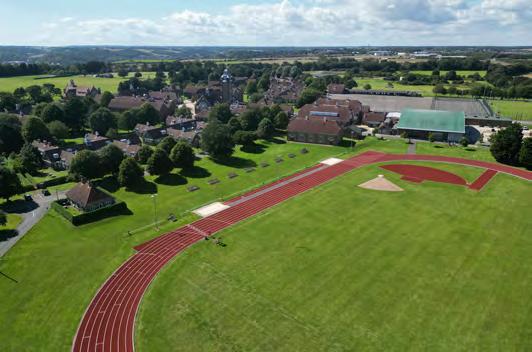
From the moment you enter the 150-acre Kentish parkland estate, you will be amazed by the profound emphasis placed on pastoral care, designed to create a secure and nurturing environment, allowing students to focus on their academic pursuits while feeling supported, valued, and part of a caring community.
Accoladed with two SSAT Educational Outcomes Awards, the school consistently exceeds national GCSE progress figures, a testament to its commitment to academic achievement. The school's exceptional facilities, including an Olympic-standard athletics track, a state-of-the-art sports centre, and a recent £24.9 million refurbishment project, showcase its dedication to providing an outstanding educational environment.
Beyond the classroom, the Duke of York’s Royal Military School distinguishes itself through its unique approach to an all-round education, maintaining small class sizes and fostering an active lifestyle. The school's emphasis on instilling leadership qualities and life skills, sets students (affectionally known as Dukies) up for life. These values reflect its military heritage and ethos – the school was founded by Royalty for military orphans.
The pastoral care at the school is delivered by a dedicated pastoral team, comprising Houseparents, academic tutors, and matrons, ensuring that students receive academic, social and


personal support. With over 200 students from Forces Families, students find a sense of belonging and camaraderie within each House and experienced staff ensure students feel at home.
The school's commitment to student wellbeing extends to its outstanding medical facilities, providing comprehensive healthcare resources and access to nurses and GP services.
The availability of Wi-Fi throughout the school, coupled with regular exeat weekends (although the school remains open for students who wish to stay on-site), facilitates communication, allowing students to stay connected with their families - a crucial element in creating a home-from-home environment.
Fundamentally, the Duke of York’s Royal Military School stands as an educational institution that seamlessly integrates a military ethos with a strong pastoral focus, creating an environment where students thrive academically, develop enduring friendships, and experience the supportive embrace of a close-knit family. Students leave the school with elevated grades onto fantastic destinations including Russell Group universities, professional apprenticeships and employment.
Explore this exceptional educational setting with private tours offered daily and frequent open mornings at: www.doyrms.com



PROMOTIONAL FEATURE THE ROYAL LOGISTIC CORPS FOUNDATION THE REVIEW 2024 | 35
The Arsenal of the Alliance
The Russia-Ukraine war offers a powerful reminder that not only are Lend-Lease style programmes effective, they also remain relevant. Major Andrew Cox RLC discusses how lessons from the Lend-Lease Programme in the Second World War inform strategic decisions today
8 The International Donor Co-ordination Centre HQ is coordinating international military support to Ukraine
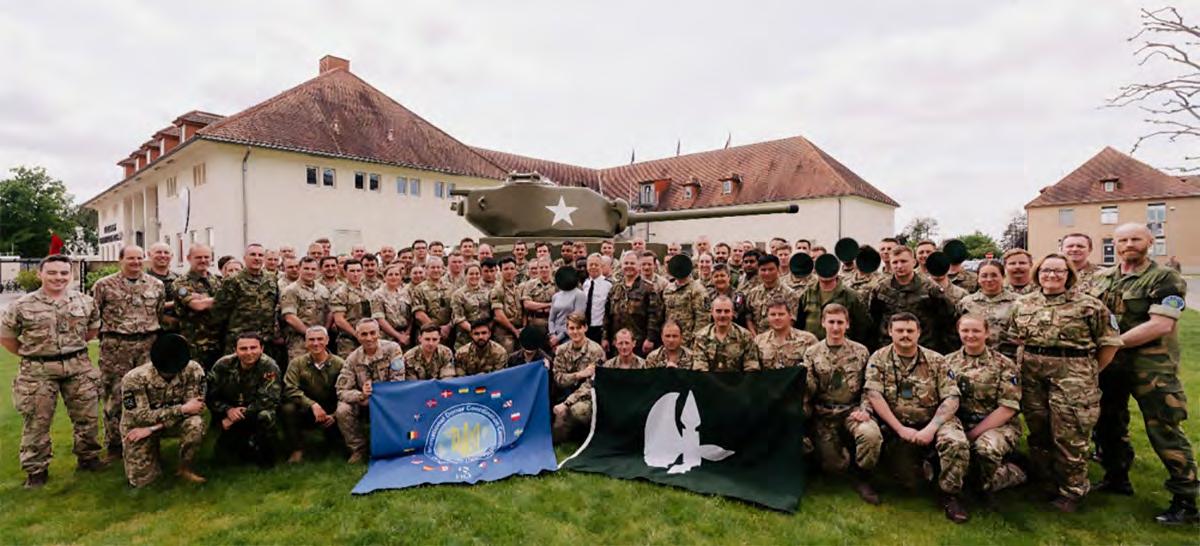
“Lend-Lease is a plane fresh out of San Diego, roaring into battle on the Russian Front; it is a fat, silvery barrage balloon sent to us from Britain and now guarding the San Diego plant turning out the planes that go to Russia; it is dry skimmed milk from the dairy country of Wisconsin, giving health and vigour to British war workers producing weapons for many fronts; it is roast beef –Australian beef – piled on the plate of a Yank from Wisconsin, now stationed in the South Pacific. It is not a dull statistical book-keeping operation, but a giant interchange of war goods and war services –from us to our allies, from our allies to us.”
- All for One; One for All. The Story of Lend-Lease (Office of Lend-Lease Administration, 1943, p.1).
Even before it started, one key factor in Ukraine’s ability to both resist the initial Russian assault and then subsequently take extensive offensive action was the gifts of weaponry from various outside sources, such as the provision of British NLAW and Javelin anti-tank weapons, which played an important role in blunting the initial invasion (Savage, 2022). The provision of funds, aid and weapons to Ukraine has since snowballed. The USA is the primary donor with no less than $76.8Bn worth of aid given between January 2022 and July 2023 under the Ukraine Democracy Lend-Lease Act of 2022 (GovInfo, 2022. Masters and Merrow, 2023). The naming of this legislation deliberately harks back to the similar, but much greater efforts the USA made to supply and
arm its allies in the Second World War; despite the fact that what has been given to Ukraine is gifted as opposed to loaned. The concept of Lend-Lease had its origins at the very beginning of the Second World War, borne of the interests of the USA in supporting the democratic nations (principally the UK) in their fight against Nazi Germany whilst maintaining a semblance of neutrality essential to gaining initial domestic support. However, once the USA entered the war formally, the system expanded beyond democratic nations across the globe to become the keystone of the entire supply chain of the Grand Alliance against the Axis powers.
Lend-Lease in the Second World War is frequently portrayed as the USA simply mass-producing enormous quantities of raw materials and weaponry and giving them away en-masse. It was however far more complex and reciprocal, developing comprehensive supply chains into conflict areas in which US forces were frequently recipients of foreign aid under the very same system. This is why LendLease was accurately described by General Charles Marshall as ‘A huge system of economic strategy’ (Overy, 2021, p.547). In many ways, it was the physical and moral glue which held the Grand Alliance against the Axis together (MacNeil, 1984, p.356). Therefore, an insight into the conduct of the Lend-Lease system and its wide-ranging effect on the conduct of the Second World War is useful to better understand the factors in giving military aid to Ukraine today; and other allies who may need similar measures in the future.
8 HISTORY 36 | THE REVIEW 2024 THE ROYAL LOGISTIC CORPS FOUNDATION
Crown copyright
To understand how Lend-Lease came about, it is important to understand the political, legal and diplomatic context which constrained US foreign policy at the start of the Second World War. In 1939 there was a strong instinct towards isolationism in the USA. Laws such as the Neutrality Act and the Debt Default Act limited aid for UK and France to selling weapons for US Dollars or gold. This resulted in the policy known as ‘cash and carry’, starting the initial financial investment which kickstarted the increase in US arms manufacture and the selling of surplus US government war stocks (Kimball, 1969, pp.2-4). There was an increasing urge to further support the democratic nations in their fight against the Axis forces led by President Roosevelt, but the President was legally prevented from offering loans, credit, or gifts to belligerent nations; especially ones which had outstanding debts from the previous war. He was also constrained by the need to fight an election in late 1940 and his previous promises to the US public to not directly involve the USA in foreign
Further complications came about in the summer of 1940 when France was defeated and the UK forced off the continent, drastically increasing the needs of the UK and compelling them to take on the pre-existing French orders for arms. This depleted the UK’s stocks of dollars and gold faster than anticipated and by September 1940 it became clear that the UK would run out of means to buy arms from the USA by April 1941 (Kimball, 1969, p.73). Contrary to common belief, the UK was not at risk of bankruptcy. Rather it was rapidly approaching the limit of its ability to financially operate within the US economy given the highly constrained policies in place (Edgerton, 2011, p.5). This resulted in some increasingly innovative deals to put arms into the hands of the UK, such as the use of Canada as a third-party and the exchange of the use of several British Empire naval bases for 50 aged destroyers which was struck in September 1940 (Stettinius, 1944, pp.32-34). The UK was also not the only customer: The USA itself was also starting to rearm extensively at this time and requests for arms were also coming in from a myriad of other concerned nations (Stettinius, pp.43-44).
This sums up the context which resulted in Roosevelt (who was coming under increasing moral pressure from Churchill) formulating the idea of LendLease as a solution in October 1940. The concept of lending the resources and arms allowed the USA to circumvent its own policy constraints and arm its allies whilst concurrently building its militaryindustrial complex, rearming itself and maintaining a fig leaf of neutrality to both domestic isolationists and the Axis powers. Whilst convincing others of the idea, Roosevelt famously compared the idea to lending a neighbour a hose to extinguish a fire before it spreads to your own property (MacGregorBurns, 1970, p.26). The adoption of the Lend-Lease programme represented a perilous transition from an isolated but active neutrality to an obvious pursuit of global objectives as it was clear to Roosevelt that keeping the UK in the war was in the national interest. From the Axis perspective it was tantamount to a declaration of war. Although it did not spark any immediate Axis retaliation, even the suggestion was a point of no return (Burleigh, 2010, p.186 and Kimball, 1969, p.9).
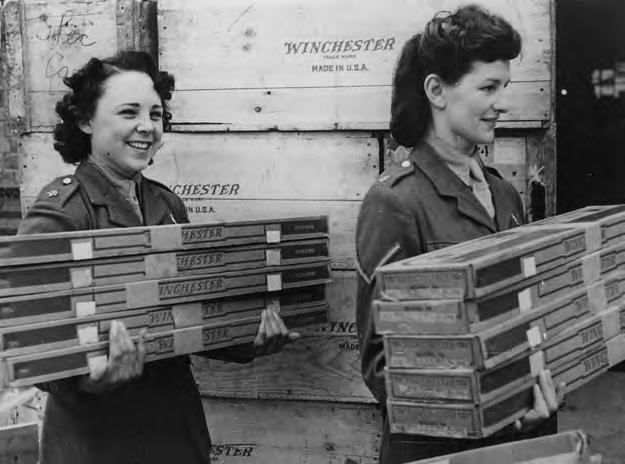
8 Winchester
Domestically it sparked intense debate between interventionalists and isolationists, but Roosevelt was able to achieve sufficient political alignment and his authority was cemented further by him winning a second term as President in December 1940 (Kimball, 1969, 78). After further political wrangling the LendLease Act was ultimately passed on 11 March 1941 (Jacobsen and Smith, 1978, p.138), but even before it was endorsed, Roosevelt set about gearing up his nation to the endeavour which lay ahead. Starting with the now famous ‘fireside chat’ address of 29 December 1940, the President effectively laid down a challenge to his nation to become what he called ‘the Arsenal of Democracy’ and urged immediate action, stating: “The great task of this day, the deep duty which rests upon us is to move products from the assembly lines of our factories to the battle lines of Democracy. Now!” (Jacobsen and Smith, 1979, 146).
The key lessons for the modern Lend-Lease initiatives from Roosevelt’s Lend-Lease programme are firstly the need for political alignment, both internationally and domestically. This must be sufficient to commit to what is a very resourceintensive activity on behalf of another who, most-
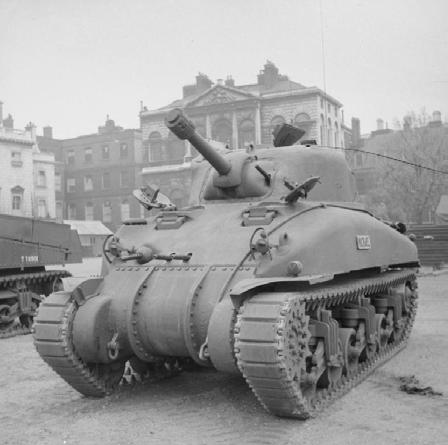
8 The first M4 Sherman prototype as it arrived in the UK. The M4 Sherman was a collaborative design that combined US industry with UK battle experience
HISTORY 8 THE ROYAL LOGISTIC CORPS FOUNDATION THE REVIEW 2024 | 37
made rifles arriving into the United Kingdom
Source: Wikimedia Commons public domain
Source: Wikimedia Commons

likely, will not be able to ever reciprocate fully. Although the USA committed itself to Lend-Lease in both 1941 and 2022, the Bills had their domestic opponents that required deft management. Indeed, after an election result those opposed to the initiative may find themselves in power which may leave the policy vulnerable (Bowman, 2023). Secondly, is the need for timely intervention, and Roosevelt was right at the end of 1940 to urge immediate action from his nation. As France discovered in 1940, contracts and orders for arms are meaningless if they arrive too late. Alternatively, as Ukraine discovered in February 2022, the right equipment supplied by allies at the right time can make all the difference (Savage, 2022). Thirdly, the position of neutrality in a conflict where there is a clear desire to support one belligerent is a difficult policy to sustain and will invariably result in constraints on what form that support takes. Currently no-one knows this dynamic better than Ukraine: It has witnessed the nature of the assistance given develop from defensive to offensive as its ostensibly neutral benefactors gained confidence that they could do so without getting directly involved (Mills, 2023, pp.10-20). All these lessons point inturn to the need for such military aid to be properly aligned to national strategy.
Could the USA of 1940 rise to its leader’s challenge? The USA had developed over the preceding decades into a modern industrial power which had pioneered mass-production techniques. Assuming the right investment and realignment of manufacturing output, the nation had enough theoretical capacity to cater for the equipping of not only itself, but all of its allies and with fewer priority constraints (Overy, 2021, p.527 and p.530). The USA was also in a stronger geographical position, with an abundance of natural resources, fewer warinduced supply problems and no direct proximity to the fighting (Overy, 536). To manage this endeavour, the US Government set up a matrix of coordinating committees which started small with the President’s Liaison Committee in the ‘cash and carry’ days; and developed throughout the programme to encompass government, treasury, industry, the military and all required foreign counterparts. These committees sourced, managed, prioritised and allocated all the resources and finished products of Lend-Lease (Kimball, 1969, p.25 and Stettinius, 1944, pp.159160). As McNeil astutely observed: “The kind of
scheduling required to keep a complicated assembly line running smoothly in a great factory was, in effect, applied to the entire national economy of the United States” (McNeil, 1984, p.355).
Perhaps the main practical concern was that in 1940 the USA had a very limited military-industrial complex: the nation was geared to the massproduction of civilian items such as automobiles and refrigerators, but only had one plant which made tanks (Overy, 2021b, p.539). There was however considerable talent, skills and potential within US industry which, spurred on by lucrative investments and orders by both the US and UK Governments, rapidly turned its hand en-masse to the challenge of mass producing the material means of fighting an international conflict. The US and UK Governments invested considerable sums of money into modifying, expanding and in some cases building entire factories and their supply chains. To support this new industrial expansion, over 500,000 new businesses were started up over the course of the Lend-Lease programme (Overy, p.539). McNeil summarised this remarkable US transition where: “War became industrialised. Industry became militarised.” (McNeil, 1984, p.359).
A considerable amount of the US manufacturing industry realigned itself to the making of war materiel ranging from bombers to barbed wire. During the Lend-Lease programme the whole aircraft and automobile industries were co-opted for military output to the virtual exclusion of civilian products (Overy, 1995a, pp.190-192). There were considerable issues to be overcome in converting manufacturing facilities from making civilian items to military equipment. There were the obvious problems of re-skilling, re-tooling, reorganising the factory floors and their supply chains. Additionally, military items tended to be complex with openended production runs that were prone to having their specifications modified with little warning; a necessity to meeting prevailing battlefield conditions and avoiding obsolescence. These factors conspired to challenge the mass-production and economy of scale philosophies of US industry, but the urgency, as well as the scale of both demand and financial incentive, typically overcame such concerns (Overy, 2021b, pp.528-529). These issues were ameliorated in-part as the programme progressed by the maximum possible use of standardised components and concentrating production on as few designs as possible (Overy, pp.531-532). By December of 1941, when the US itself entered the war, the US farming, mining, and manufacturing sectors had geared themselves for the endeavour that would eventually help supply the whole Grand Alliance against the Axis (Stettinius, 1944, p.158).
To illustrate a single example of this enormous enterprise and the innovation it spurred, in June 1941 the Ford Motor Company (which previously only had experience in manufacturing automobiles) built a new aircraft facility in Willow Run, Michigan. This was built for manufacturing components for the B24 Liberator; a relatively advanced fourengine long-range heavy bomber. By October 1941, the facility had gained permission to assemble complete aircraft on the grounds of efficiency. It overcame numerous difficulties and by 1944,
8 HISTORY 38 | THE REVIEW 2024 THE ROYAL LOGISTIC CORPS FOUNDATION
8 The shop floor of the Detroit Tank Arsenal with M4 Sherman tanks being assembled
Source: Wikimedia Commons public domain
Willow Run had manufactured over 5,000 B24s. At the height of its production, a completed B24 left the Willow Run production line every 63 minutes (Overy, 1995a, p.196). Feats of industry such as this were impressive, but not uncommon. However, they could not have been achieved without massinvestment, coordination and development across the manufacturing and logistics sectors of the US economy; and beyond into the institutions of the US and Allied nations. For instance, many of Lend-Lease’s most famous products, such as the M4 Sherman tank and the Liberty Ship were design collaborations between UK and US agencies (Edgerton, 2011, pp.79-81).
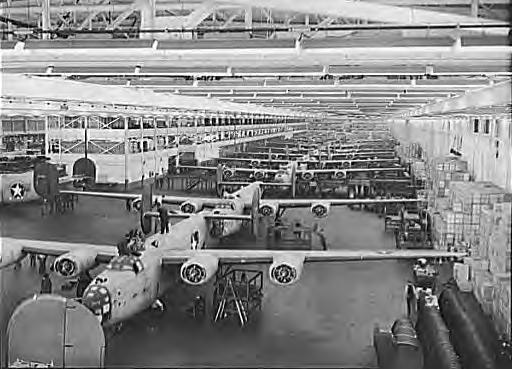
Source: Wikimedia Commons public domain
Although Lend-Lease is best known for the supply of weapons, vehicles and munitions, the same programme was used for infrastructure support and the distribution of food, fuel, and raw materials between the Allies. (Overy, 2021b, p.556). For the UK, the loss of access to Continental Europe meant that it relied increasingly on food and raw materials from the USA to make up the shortfall. Likewise, the Soviet Union lost a substantial proportion of its coal, iron, aluminium, and grain resources in the German invasion; and these were made up from Lend-Lease sources (Lesser, 1989, pp.63-68). The supply of dehydrated and preserved food to the UK and later the Soviet Union was instrumental in allowing these nations to concentrate their own industries and workforce on the war. For example, the US gave the Soviet Union 800,000 tonnes of tinned meat over the course of the war; enough to feed the whole Red Army a ration of it every day (Overy, 2021b, p.556). Lend-Lease was also not a one-way street: Aid from Allies to the USA, referred to as ‘Reverse Lend-Lease’ was accounted for on the Lend-Lease books. This most typically took the form of British and Dominion countries giving US forces access to infrastructure and local supplies but went as far as the UK lendleasing the US Army Air Force Supermarine Spitfire fighters (Stettinius, 1944, pp.275-285).
Therefore, there are three enduring productionorientated factors that resonate for LendLease programmes: firstly, there is a need for extensive coordination and collaboration between governments, industry, and the end-user to establish what can be supplied and what the end-user needs. This coordination and collaboration needs to be adaptive, enduring and a two-way affair to ensure
mutual understanding. This crucial factor is why the International Donor Coordination Centre was set up to manage aid into Ukraine in April 2022 (Mills, 2023, p.8). As a negative example, in the Second World War the Soviets refused to collaborate fully with the Western Allies over the aid given, which caused numerous frictions (Overy, 2021b, p.563). Secondly, manufacturing industries need time and freedom of action to adapt to an increase or change in demand, especially if the products required are complex. This rings equally true if referring to the supply of P-40 Kittyhawk fighters to the UK in 1941, or the supply of NLAW anti-tank missiles to Ukraine in 2022.
Thirdly, the means and resources to enable manufacture; namely investment, regular orders and raw materials need to be available to produce what is needed. As all nations discovered in the Second World War, not to mention Ukraine in 2022, peacetime brings limited investment and orders. This in turn brings a reduction in latent capacity to rapidly increase supply if required. However once war starts, resources which were assumed to be available may be denied by the enemy. Fundamentally the industrial potential to meet the needs of the conflict at hand needs to either be present or be rapidly invested into existence and sustained for the duration. In 1940 the USA had the advantages of a lot of latent manufacturing potential coupled with sufficient resources and the incentive to use it. In comparison the donors to Ukraine today cannot boast the same potential to ramp-up supply, especially in the more complex weapons and munitions seen on the modern battlefield.
Building up stocks of Lend-Lease war materiel alone was not enough. It also needed to be delivered to the battle fronts and developing the supply chains in the face of Axis efforts to interdict them became a distinct and important aspect to the programme. Throughout the war, the Allies were challenged to maintaining their long and often complex global supply chains to sustain their national forces. The burden of distributing Lend-Lease materiel through these chains added a further level of complexity to realising their desired strategic and operational endstates. For example, a ship convoy travelling east out of New York loaded with Lend-Lease products bound for the Soviet Union in 1942 was unable to go through the Mediterranean Sea due to enemy action. It would either have to endure a highly dangerous and interdicted 28-day voyage over the Atlantic and Arctic Oceans to Murmansk, or a safer but far longer 70-day voyage around Africa to Basra where vehicles and aircraft would be assembled from their crates in
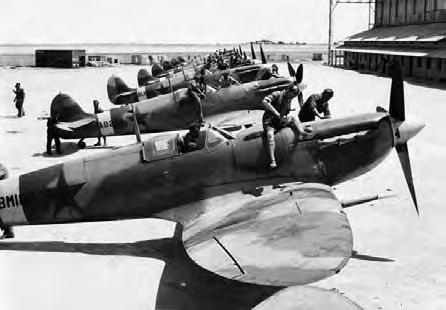
Source: Wikimedia Commons copyright expired
8 British Supermarine Spitfire fighters being assembled and prepared for shipment to the Soviet Union, complete with Red Air Force markings
HISTORY 8 THE ROYAL LOGISTIC CORPS FOUNDATION THE REVIEW 2024 | 39
8 The Ford run aircraft factory at Willow Run, Michigan. Purpose built from the ground-up to mass-produce the B24 Liberator bomber

six dedicated facilities. The cargo, now assembled and painted in Red Army markings would travel 2,000 kilometres overland via Iran to the southern Soviet Union (Stettinius, 1943, pp.152-153).
The logistic challenges did not stop at shipping, and although the British Empire’s many territories and the sheer land mass of the Soviet Union provided the key hubs, many of the ports and overland routes required an increase in capacity, or even construction from scratch. As a result, the Lend-Lease programme was responsible for the development of port, rail and airport infrastructure across the globe, from Belfast to Brisbane and Basra. For instance, Lend-Lease cargo bound for China was initially able to go through Burma until the Japanese overran the route in May 1942. This forced the programme to develop the port and airfield capacity in Western India; thus, opening the vital but dangerous air supply route over the Himalayas known as ‘The Hump’ to China (Stettinius, 1944, pp.184-197).
Therefore, there are three key logistic orientated lessons for Lend-Lease: Firstly, the routes to get supplies to the recipients must be identified and secured, and this may be complicated by the enemy, other hostile actors, or neutral parties. This aspect is identical both in the example of the Western Allies being denied free use of the Mediterranean Sea by the Axis, or Ukraine and its supporters being denied use of the Black Sea by Russia today (Pedrozo, 2022). Secondly, the supply lines to get military aid to allied recipients must have the logistic capacity to enable the required flow of materiel. This must encompass both the infrastructure required, such as port capacity, and the means of transportation, such as the Liberty Ship. Thirdly, the donor must be prepared to conduct ‘final mile’ customisations and assembly on products to best supply the supported ally. This could mean assembling war stock from crates, or simply repainting it with the colours and symbology used by the recipient.
By the end of the war, the Lend-Lease programme encompassed 40 nations and involved over $50 Billion worth of war materiel: the equivalent of nearly $834 Billion today (Overy, 2021b, p.554). Table 1 shows only a sample of key equipment types that were supplied by the US over the course of the programme, but the figures tell firstly of the sheer scale and diversity of the programme. Secondly, they tell of the differing needs between recipients, such as the British need for small arms spurred on in part
by the loss of so much of their equipment after their evacuation from France in June 1940, and the Soviet Union’s road and rail transportation requirements to run their lengthy land supply lines.
The positive impact this huge, coordinated stream of resource would have had on the war-effort of the Grand Alliance is challenging to measure accurately, but instinctively seem obvious. In the Second Battle of El Alamein, the turning point in the North African campaign and arguably one of the turning points of the war, the British were supported in their victory by the first massed concentration of Lend-Lease stock; no less than 1,700 tanks, 1,000 aircraft and 25,000 wheeled vehicles. These contributions only increased in the battles and victories that followed (Overy, p.566). The effect of Lend-Lease stock on the ground implicitly shows one of the greatest benefits of Lend-Lease: That it fundamentally bound the Grand Alliance together in a system of mutual support that encompassed all of its members; even the undemocratic and intractable Soviet Union. The generosity the system represented lent a moral authority to the Grand Alliance that the Axis powers lacked, making an additional contribution to the Allied victory beyond the mass allocation of weapons and materiel (MacNeil, 1984, p.356). Despite it not underpinning a full fighting alliance, arguably the provision of Lend-Lease style measures to Ukraine lends a certain moral authority to their war against Russia. This is evidenced by the fact that as of October 2023, no less than 41 nations materially support Ukraine in some capacity (Kiel Institute, 2023).
To conclude, Lend-Lease programmes could be argued to be aid lent or given to allies in immediate need in accordance with the donor’s strategy, policy and means to assist. The enduring example given by Second World War Lend-Lease shows that these programmes not only help in offsetting immediate strategic failure for the recipient, but also over the course of a conflict allow them to manage their war effort more efficiently by prioritising their own efforts on what they do best or need the most. In the case of the Second World War there was also considerable reciprocal aid which helped develop coordination and strengthened the bonds between Allies that otherwise had little in common other than their enemies.
However, it also shows that these programmes

8 HISTORY 40 | THE REVIEW 2024 THE ROYAL LOGISTIC CORPS FOUNDATION
8 Sturdy and popular US built Studebaker trucks in a Red Army convoy. Some of over 432,000 trucks Lend-Leased to the Soviets during the programme
Source: Wikimedia Commons public domain
need a great deal of up-front investment in political, economic, and financial terms which require considerable effort and risk to initiate. They also need the highest level of coordination and trust between governments, industry with a degree of latent capacity and armed forces that had to leap national, language, cultural and ideological barriers. Consideration, investment, and effort is also required to deliver the aid in a manner that the recipient could fully utilise it; with the full knowledge that the enemy always influences the outcome. Finally, the Second World War programme showed that the opportunity for Lend-Lease to be effective is temporal and the time between demand and credible supply is shorttime that a recipient may or may not have.
The Russia-Ukraine War offers a powerful reminder that not only are Lend-Lease style programmes effective, but they also remain relevant. However, it also offers an equally powerful reminder of what such a programme requires over the longterm to achieve the effect intended. Conducting a Lend-Lease style programme is a strong display of strategic commitment to an ally, but it is a costly and open-ended commitment that demands an enduring alliance of interests with an unwavering strategic resolve to achieve its objective.
Bibliography
Bowman, K. (2023) Biden’s Ukraine Aid Package: How Much Opposition is There? Washington DC: Forbes. Available from: https://www.forbes.com/sites/ bowmanmarsico/2023/09/11/bidens-ukraine-aid-packagehow-much-opposition-is-there/ [Accessed 12 Sep 23].
Burleigh, M. (2010) Moral Combat. London: Harper Collins.
Edgerton, D. (2011) Britain’s War Machine. London: Allen Lane.
Ellis, J. (1990) Brute Force. London: Andre Deutsch. GovInfo (2022) Ukraine Democracy Lend-Lease Act of 2022. Washington DC: GovInfo. Available from https:// www.govinfo.gov/content/pkg/COMPS-16886/pdf/ COMPS-16886.pdf [Accessed 01 Sep 23].
Harrison, M. (Ed) (2000) The Economics of World War II Cambridge: Cambridge University Press.
Hastings, M. (2011) All Hell Let Loose. London: Harper Press.
Jacobsen, H.A., Smith, A.L. (1979) World War II Policy and Strategy. Oxford: Clio Press.
Kaistiren, P.A.C. (2004) Arsenal of World War II. Lawrence: The University Press of Kansas.
Kiel Institute (2023) Ukraine Support Tracker. Kiel: The Kiel Institute for the World Economy. Available from https:// www.ifw-kiel.de/topics/war-against-ukraine/ukrainesupport-tracker/ [Accessed 01 Sep 23].
Kimball, W.F. (1969) The Most Unsordid Act. Baltimore: John Hopkins.
Larribee, E. (1987) Commander in Chief. London: Andre Deutsch.
Lesser, I.O. (1989) Resources and Strategy. London: Macmillan.
MacGregor-Burns, J. (1970) Roosevelt: The Soldier of Freedom. London: Wiedenfield and Nicholson.
Masters, J.’ Merrow, W. (2023) How much Aid Has the US Sent Ukraine? n.l.: Council on Foreign Relations. Available from https://www.cfr.org/article/how-much-aid-has-ussent-ukraine-here-are-six-charts [Accessed 01 Sep 23].
McNeil. W.H. (1984) The Pursuit of Power. Chicago: University of Chicago Press.
Mills, C. (2023) Military Assistance to Ukraine Since the Russian Invasion. London: House of Commons Library. Available from https://researchbriefings.files.parliament. uk/documents/CBP-9477/CBP-9477.pdf [Accessed 01 Sep 23].
Office of Lend-Lease Administration (1943) All for One, One for All The Story of Lend-Lease. Washington DC: US Government Printing Office.
Office of the Chief of Military History (1952) The United States Army in World War II: Statistics – Lend-Lease. Washington DC: Department of the Army. Available from https://cgsc.contentdm.oclc.org/digital/api/collection/ p4013coll8/id/2421/download [Accessed 09 Jan 24].
Overy, R. (1995a) Why the Allies Won. London: W.W.Norton & Co.
Overy, R. (2021b) Blood and Ruins. London: Allen Lane.
Pedrozo, R. (2022) Ukraine Symposium: Maritime Exclusion Zones in Armed Conflicts. West Point: The Lieber Institute. Available from https://lieber.westpoint.edu/maritimeexclusion-zones-armed-conflicts/ [Accessed 01 Sep 23].
Savage, M. (2022) How British Tank Busters are Helping Ukraine Halt Russian Attack. London: The Guardian. Available from https://www.theguardian.com/world/2022/ mar/20/how-british-tank-busters-are-helping-ukrainehalt-russian-attack [Accessed 01 Sep 23].
Stettinus, E.R. (1944) Lend-Lease. New York: Macmillan.
HISTORY 8 THE ROYAL LOGISTIC CORPS FOUNDATION THE REVIEW 2024 | 41

The Army Higher Education Pathway
The Army Higher Education Pathway (AHEP) provides an excellent opportunity for Army Officers to complete a fully funded degree or post graduate degree in conjunction with Henley Business School, a globally renowned, triple-accredited institution and part of the University of Reading, one of the world’s top 200 universities. The AHEP is an innovative and flexible mechanism that optimises the professional development of officers by offering degree pathways linked to career courses. Starting points are the full Commissioning Course (CC), the Intermediate Command and Staff Course (Land) (ICSC(L)) and Late Entry Officers Course (LEOC).
Recent research has identified positive changes in students on AHEP:
‘I spent a lot of last year and the first part of this year deployed in Eastern Europe. I felt that I’d turned up there with a very good knowledge of what was going on. Part of that was because of all the extra reading that I’d done because of [AHEP].’ Current MSc Exec student.
‘For me, it’s an absolute game changer. It’s a life enhancer. I’m a better officer for it. I’m more rounded as a person, I appreciate alternative views, I’m more educated, better educated.’ Current BSc student.
‘The quality of analysis and perception…is really important, and I can see that in the quality of their work, that it shows greater rigour and analysis.’’ Line manager.
BSc/MSc Leadership and Strategic Studies
The AHEP offers selected non-graduates on the CC at the Royal Military Academy, Sandhurst (RMAS) the opportunity to attain a BSc in Leadership and Strategic Studies, and for selected graduates a MSc in Leadership and Strategic Studies, building as they progress through their careers. Both pathways enable officers to ‘Lead and Learn’, supporting their service requirements and maximising prospects for individuals to operate as effective officers in the British Army: “’Lead and Learn’ is a pathway that will strengthen and enhance the British Army’s existing excellent through-life career leadership and professional development opportunities. It supports our people to confidently develop their intellectual capability, ready to meet the challenges of the future with absolute commitment.”
Major General Zac Stenning OBE - Commandant RMAS
How to apply: You can register your interest for the AHEP whilst at RMAS with the Learning
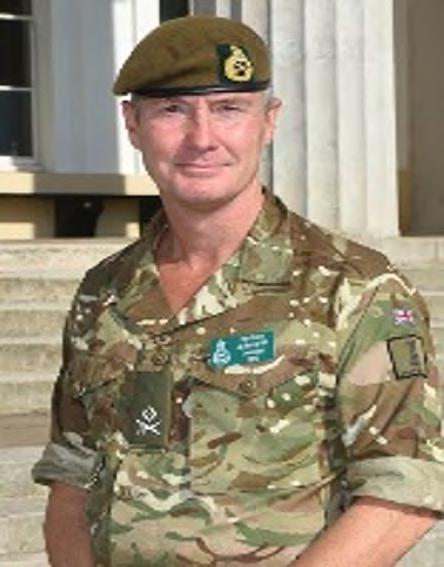
Development Advisor (LDA): RMAS-Gp-HQ-LD-SO2
Those who have commissioned but are still within the 18-month enrolment window should contact apsgedbr-accreditation-so3@mod.uk
MSc (Exec) Leadership and Strategic Studies
The AHEP also offers selected Majors on ICSC(L) and selected Senior Soldier Entry (SSE) officers attending LEOC the opportunity to pursue a fully funded MSc (Exec) in Leadership and Strategic Studies. These pathways provide more experienced Army Officers with learning tailored to support more senior job appointments and leadership roles. How to apply: Briefings will be given on LEOC and at ICSC(L).
Colonel Caroline Emmett, Assistant Head Learning & Development, British Army, says: ‘Delivering higher education pathways across our Officer-leader cohort is about investing in our people to build their careers and equip them with the skills required to win in the era of global systemic competition. AHEP improves awareness of the context and environment in which a professional officer-leader must operate and upskills our work-force.’
8 PROFESSIONAL DEVELOPMENT 42 | THE REVIEW 2024 THE ROYAL LOGISTIC CORPS FOUNDATION
Welcoming Forces families since 1803


















The Duke of York’s Royal Military School is committed to supporting the British Forces and is sponsored by the Ministry of Defence. In recognition of this, parental contribution for those eligible for the Continuity of Education Allowance is only £506 per term (£1,517 per annum). Students make outstanding progress academically, with students from Forces families achieve over ¾ of a grade high than the national average. Our full-boarding community, offering continuity of education, is home to over 200 students from Forces families. We pride ourselves on offering outstanding pastoral care, ensuring students feel relaxed and happy in their home away from home.
Royal Logistic Corps Apprenticeships
Pearson TQ works in close partnership with the Royal Logistic Corps (RLC), creating a unique, blended learning experience where all direct entry RLC soldiers can complete a trade-relevant apprenticeship.
At any one time, there are around 1,400 RLC soldiers engaged on an apprenticeship, embedding knowledge, skills and behaviours in the workplace wherever in the world they may be deployed.
Soldiers gain essential functional skills required for promotion to JNCO and are challenged to reach the requirements for SNCO.
I enjoyed gaining new knowledge and skills and my Pearson TQ coaches were very supportive.
RLC apprentice “ “
In collaboration with the Royal Logistic Corps, Pearson TQ has designed the programmes to ensure that the majority of soldiers are able to gain an apprenticeship that is aligned to their trade. Commonly offered at the start of their career, the programmes open the door to many qualifications to further their professional opportunities.
Programmes include:
• LGV Driver (C+E) Level 2
• Supply Chain Warehouse Operative Level 2
• Express Delivery Operative Level 2
• Aviation Customer Services Operative Level 2
• Port Operative Level 2
• Unified Communications Technician Level 3
• Ordnance, Munitions and Explosives Technician Level 4.
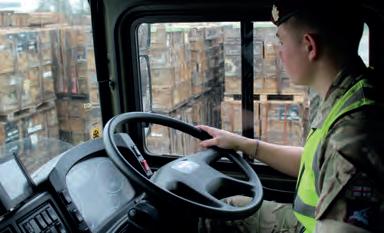
Measuring success
Pearson TQ consistently delivers excellent learning outcomes and exceeds national benchmarks in apprenticeship achievement.
85%
current overall success rate for RLC Apprenticeships
Recognising achievement
Learn more about how we can help transform your workforce and grow your future talent x pearsontq.com
Every year since 2015, the RLC apprenticeship programme has won awards at the Army Apprenticeships Awards and was recognised at the Multicultural Apprenticeship Awards 2022 as Employer of the Year.
WFS_A0484 | Mar 2024
www.doyrms.com | admissions@doyrms.com | +44(0)1304 245073
Understanding Effective Reflective Practice
In this article, Major Leon Berry AGC posits that while reflection is a key aspect of effective coaching, it is not yet a fully understood concept. However this article identifies that to inculcate a more effective coaching culture in the British Army, the concept and practical use of reflection needs to be firstly identified and simplified and then taught effectively to the instructors that will use it to develop soldiers

One of the key concepts used within coaching is the ability to reflect effectively. Reflection has been described as a way to explore and engage with experiences by considering a new appreciation of an action following thought from a distance (Louden, 1991). Reflection is not a new concept; it has been a core aspect of coaching for many years and has been employed as a method to examine and further understand an individual’s performance in order to continuously develop their practice (Hays & Gay, 2011).
Every individual will reflect upon their experiences to varying degrees with the potential to learn from them (Moon, 2004), consequently reflection could be a powerful tool to facilitate learning for all soldiers in the British Army. However, reflection has also been criticised for becoming both oversaturated in the coaching lexicon but simultaneously underdeveloped in terms of understanding and training for coaches. As such, this essay will critically evaluate reflection as a coaching tool and will provide recommendations from the analysis, notably that instructor training requires development within the British Army.
Reflection in Coaching
The literature surrounding reflection in coaching demonstrates how, as a concept, it has risen to prominence within the coaching sphere. Reflective practice is extolled for its positive impact on individuals in promoting critical thought (Taylor et al, 2015) that leads to self-awareness and enhancement
of professional development (Gilbert & Côté, 2013). Furthermore, reflection helps in linking theory to practical application (Douglas & Carless, 2008) whilst also facilitating enhanced practice (Cropley, Miles, & Peel, 2012). This implies that evidence is required by reflective learners in order to generate, inform and continually adjust their practice so as to prevent stagnation which can result in continued poor performance. Reflecting can subsequently shift an individual away from superficial-level learning that is generally linked with memory recall such as concept identification, and towards a much deeper level of learning that is required to adapt and apply those concepts, thereby creating problem-solving solutions through the development of a new concept (Biggs & Tang, 2007). These new personal theories result in the development of expertise and judgement, enhancing professional development (Paterson & Chapman, 2013).
These personal theories can be largely applied to a variety of models that focus on reflection which can then be used by individuals within various different contexts (e.g. Johns, 1995; Boud, Keogh & Walker 1985; Boyd & Fayles, 1983; Gibbs, 1988). In particular, Schank (2005) suggested that reflection is a key element within a cycle of “learning by doing” as individuals reflect on feedback from a specific practice. This is highlighted in Kolb’s theory of experiential learning (Fig 1) which is a widely used model that has been adopted in coaching as it supports individual reflection. It defines reflection as a part of the learning process which transforms knowledge through experience (Kolb, 1984), although this is viewed by Moon (2004) as an outcome of learning rather than the process itself. This is beneficial for the Army due to the repetitive and practical nature of training; however this assumes that there is also the time available to reflect effectively on the various training tasks.
All of these theories provide a visual accompaniment of reflection to demonstrate the process of learning and what can be gained through reflection. What these models tend to highlight is the importance for individuals to engage with the affective elements of the process i.e. what the individual was feeling during the experience that they are reflecting on. This attendance to the emotional aspects of the reflective process is needed so that perceptions of the experience are not distorted which can limit understanding and consequently learning along with any further reflection (Boud,
8 PROFESSIONAL DEVELOPMENT 44 | THE REVIEW 2024 THE ROYAL LOGISTIC CORPS FOUNDATION
Credit: Pixabay
2001). This, however, is a potential barrier in fully employing reflective practice within the British Army as, whilst there has been a paradigm shift towards a coaching culture, training is generally task-orientated rather than focussing on the individual’s input and experiences.
Further to this, Merriam (2004) posits that, although reflection is integral to the transfer of learning, a number of adult learners may be unable to effectively participate in reflection as it requires a higher level of cognitive ability that some adults may be able to attain. This is particularly pertinent to the educational background of numerous soldiers as many join the Army by achieving the minimum entry standards only. However, Cushion (2018) states that reflection can be utilised by anyone, but the onus is on the individual to use it as a conscious activity, and it should not be assumed that it is being used to effectively improve performance. As such this suggests that reflection in an active activity that requires skills such as critical analysis, description and self-awareness needs to be developed in order to access and effectively use the process for learning. These are skills that soldiers will need guidance from coaches to develop, but equally the instructors need to receive sufficient training in order to effectively coach other individuals. This highlights that reflection is perhaps more complex than simply thinking back on a task an individual has completed.
Lack of Understanding
The various definitions of reflection used in this essay, along with dozens more, demonstrate the broad range of interpretation reflection has. For example, Fook (1999) suggests that how individual interpretations of actions along with cultural and social backgrounds create an emotional element to the experience that conflict with previously held values and assumptions which can impact a given situation. This depicts how uniquely individual reflection can be. Whilst reflection is noted in the literature as a key activity for personal growth and professional development, views such as Fook’s (1999) contribute to reflection as a process gaining a reputation for being passive and self-indulgent. This is concurred by Hays & Gay (2011) who also note that reflection is integral to individual learning, however their observations of postgraduate medical education suggest that reflective practice and its related assessment conducted during training often did not closely integrate with the work-based clinical practice it was designed to improve. This suggests that how reflective practice is taught to individuals does not necessarily transfer to the workplace as effectively as it potentially could. This indicates that, despite a plethora of academic contributions, reflection can be poorly taught and assessed as it is still not fully understood. This can be problematic when attempting to design and develop courses for army instructors and coaches who would need to sufficiently understand the conceptual component and practical applications of effective reflective practice. This would require an investment into research and course development by the British Army.
IDue to limited understanding, there is a danger that ‘reflection’ is being overused and has become an overarching concept for describing a variety of

practices instead, each with their own interpretations and approaches. This implies that reflection will likely be practiced in a multitude of ways as there is a lack of a single, convincing vision of the concept (Knowles, 2006). This makes reflection a challenged concept as its meaning tends to fluctuate in order to better fit with the interests and interpretation of those who are using the term (Zeichner & Tabachnick, 1991). The result is a common rhetoric of differing definitions and interpretations that are employed within coaching without extensive examination; the lack of critical analysis of the theoretical side to reflection would likely cause confusion during the subsequent practical application. This is summarised by Bleakley (1999) who suggests that reflection lacks the same rigor as those in higher education who would usually apply the same criticality to the theoretical frameworks within their own domains.
Within this there are multiple examples of reflection being used as an overarching concept that covers differing models and interpretations. One such example is rationalised technical model that focusses on consciously searching for solutions to issues (Hébert, 2015), which is more akin to military training. Further to this, Schön (1983) interpreted this model as key to solving problems as it is supported by a scientific grounding where all proponents can be tangibly measured and assessed through empirical observation. This model provides an opposing view to the reflection models largely based on emotion, intuition and non-empirical actions (Akbari, 2007). Schön emphasises that reflection is an action and as such is a skill that can be used in order interpret and
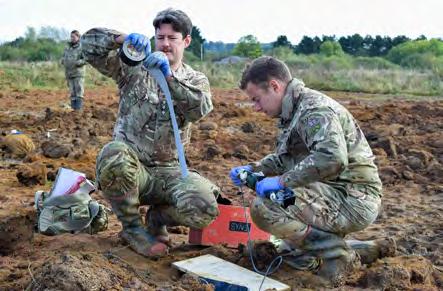
8 Fig 1 – Kolb’s Learning Cycle (1984)
8 British Army training is generally task-orientated rather than focussing on the individual’s input and experiences
PROFESSIONAL DEVELOPMENT 8 THE ROYAL LOGISTIC CORPS FOUNDATION THE REVIEW 2024 | 45
Crown copyright
solve complex, ambiguous problems. This reflects perhaps the most appropriate model that could be employed by the Army to develop soldiers as it is based on experience, similar to what Kolb’s model highlights.
Conclusion
Reflection is a key aspect of effective coaching. It can be used to help an individual to learn from their experiences in order to improve and develop personally and professionally. However, the concept of reflection has potentially lost some of its potency from being overused to describe a variety of differing practices, some of which may assist with learning but that cannot be guaranteed. As such, reflection is not yet a fully understood concept, however this essay has identified that to inculcate a more effective coaching culture in the British Army, the concept and practical use of reflection needs to be firstly identified and simplified and then taught effectively to the instructors that will use it to develop soldiers. This should include developing a training package that can potentially synthesise a practical, problem-solving approach such as Kolb’s experiential learning cycle that is also able to attach emotion to experiences in order to complete tasks along with developing soldiers’ affective domain.
References
Akbari, R. (2007). Reflections on reflection: A critical appraisal of reflective practices in L2 teacher education. System, 35, pp.192–207.
Biggs, J., and Tang, C. (2007). Teaching for quality learning at university: what the student does. (3rd ed. /.). Maidenhead; New York NY: McGraw-Hill/Society for Research into Higher Education; Open University Press.
Bleakley, A. (1999). From reflective practice to holistic reflexivity. Studies in Higher Education, 24, pp.315–330.
Boud, D. (2001) Using journal writing to enhance reflective practice. New Directions for Adult and Continuing Education, 2001(90), pp.9–18.
Boud, D., Keogh, R. & Walker, D. (1985) Reflection: Turning Experience into Learning. London: Kogan.
Boyd, E. & Fales, A. (1983) Reflective Learning: the key to learning from experience. Journal of Humanistic Psychology 23 (2) pp.99-117.
Cropley, B., Miles, A., & Peel, J. (2012). Reflective practice: Value of, issues and developments within sports coaching. Sports Coach UK research project. Leeds: Sports Coach UK.
Cushion, C. (2018). Reflection and reflective practice discourses in coaching: a critical analysis. Sport, Education and Society, 23 (1), pp.82-94.
Douglas, K., & Carless, D. (2008). Using stories in coach education. International Journal of Sports Science and Coaching, 3 (1), pp.33–49.
Fook, J. (1999) Postmodern critical theory and emancipatory social work practice. In Pease, B. and Fook, J. (Eds.), Transforming Social Work Practice, St Leonards, Allen and Unwin, pp.195-208.
Gibbs, G. (1988) Learning by doing: a guide to teaching and learning methods. London: FEU.
Gilbert, W., & Côté, J. (2013). Defining coaching effectiveness: A focus on coaches’ knowledge. In P. Potrac, W. Gilbert, & J Denison (Eds.), Routledge handbook of sports coaching, London, (pp.147–159).
Hays, R., and Gay, S. (2011). Reflection or ‘pre-reflection’: what are we actually measuring in reflective practice, Medical Education, 45(2).
Hébert, C. (2015). Knowing and/or experiencing: A critical examination of the reflective models of John Dewey and Donald Schön. Reflective Practice, 16(3), 361–371.
Johns, C. (1995) Framing learning through reflection within Carper’s fundamental ways of knowing in nursing. Journal of Advanced Nursing 22, 226-234.
Knowles, Z. (2006). Reflecting on reflection: Exploring the practice of sports coaching graduates. Reflective Practice, 7(2), 163–179.
Kolb, D. A. (1984) Experiential Learning: Experience as the source of learning and development. Englewood Cliffs, NJ: Prentice-Hall.
Louden, W. (1991). Understanding teaching: continuity and change in teachers’ knowledge. London: Cassell.
Merriam, S. B. (2004) The role of cognitive development in Mezirow’s transformational learning theory, Adult Education Quarterly, 55(1), pp.60–68.
Moon, J. (2004). A Handbook of Reflective and Experiential Learning: Theory and Practice. London: Taylor and Francis Ltd.
Paterson, C., and Chapman, J. (2013). Enhancing skills of critical reflection to evidence learning in professional practice, Physical Therapy in Sport, 14(3), pp.133–138.
Schank, R. C. (2005) Lessons in learning, e-learning, and training: perspectives and guidance for the enlightened trainer, San Francisco: Pfeiffer.
Schön, D. A. (1983). The reflective practitioner: How professionals think in action. New York, NY: Basic Books.
Taylor, S., Werthner, P., Culver, D., & Callary, B. (2015). The importance of reflection for coaches in parasport. Reflective Practice, 16(2), pp.269–284.
Zeichner, K. & Tabachnick, B. (1991). Reflections on reflective teaching. In Tabachnick, B. & Zeichner, K. (Eds.), Issues and practices in inquiry-oriented teacher education, London: Falmer, pp.1-36.
8 PROFESSIONAL DEVELOPMENT 46 | THE REVIEW 2024 THE ROYAL LOGISTIC CORPS FOUNDATION
Leading Through Workforce Challenges in a Training Regiment
For three weeks in May 2023, due to numerous workforce constraints, Captain Louis Trup RE unexpectedly became the most senior officer in and leader of a regiment of almost 600 soldiers with responsibilities for around 1,200 civilian and military staff. At the time of this issue coming to the fore, he had completed the Learning for Leadership in the 21st Century module of the Army Higher Education Pathway, and understood that it was in situations like this, where significant stress comes on an organisation and limited resources minimise opportunities, that leadership really matters (Wasserman, et al., 2010)
As part of my reflective practice, I have identified four factors linked to the workforce issue described above, which I will discuss: the shock to team dynamics, my personal leadership position, the almost instant change in energy, and the loss of diversity. For each of these factors, and the dilemmas they presented me, I will set out the actions I took based on the module learning and look to provide some early indications of how successful the approaches were. As a caveat, at the times they were experienced, the numerous dilemmas often meshed, so whilst I have tried to delineate them, there may be elements of overlap. I conclude by arguing that the learning, which was fresh in my mind, was deeply beneficial to my leadership. Although a recent event, meaning more evaluation will still be required, I believe that that actions I took were generally appropriate, and that given a wider military context of more output being demanded with less resource, some of the lessons I have identified may be valuable to others in the Army.
The issue and context
Since May 2022, I have been employed as the Adjutant of a British Army Training Regiment which seeks to provide trade-qualified soldiers to the Field Army. In my role, I serve as the senior Captain and the principal staff officer to the Commanding Officer (CO), a Lieutenant Colonel. The CO is also the commander of the base where the regiment is based. Within the regiment, there are two sub-units, each commanded by a Major, as well as there being a regimental Second-in-Command (2iC); a Major who is responsible for deputising for the CO if he is away. Save for the three Majors and the CO, I am the most senior officer in the regiment. In early April 2023, the 2iC and one of the sub-unit commanders moved onto new roles and were not to be replaced until mid- to late July. Simultaneously, the other sub-unit commander was required to deploy abroad. Towards the end of April, the CO was selected to support British operations abroad, and with 24 hours’ notice, he was removed (‘trawled’) from the regiment. At the same time, civil servant leaders within the regimental headquarters resigned and left. This left me as the most senior officer in the regiment with most of the senior leadership absent for a period of three weeks.

More broadly, the Army’s operational demand has increased since the Russian invasion of Ukraine, with additional troops being required for NATO operations and exercises (Ministry of Defence, 2023). At the same time, the Army is set to reduce its numbers from 79,139 to 73,000 by the middle of the decade, this on top of the 14% decline over the past 10 years (Mahmood, 2023). This context means there is an increased demand for training providers to supply the Field Army with fully trained soldiers, but simultaneously the expertise of UK-based senior leaders is needed to support operational planning. Specifically, trade-trained soldiers have been required to deliver as part of operations globally, and increasingly in the Eastern European theatre (Ministry of Defence, 2021), placing a high level of pressure on my unit, the sole provider of our specific trade training within the Army. With fewer soldiers available, the Army’s chief training officer and the General commanding the Army’s training pipeline (including my unit), asked everyone to do more with less resource and time. As such, there were already significant strains on the unit, and failure of the Regiment to deliver would severely impact the British Army’s ability to deliver enduring strategic effect globally.
Factor 1: The shock to the team
With the four senior leaders of the Regiment being absent, the initial response by those left behind was
PROFESSIONAL DEVELOPMENT 8 THE ROYAL LOGISTIC CORPS FOUNDATION THE REVIEW 2024 | 47
Credit: Pixabay
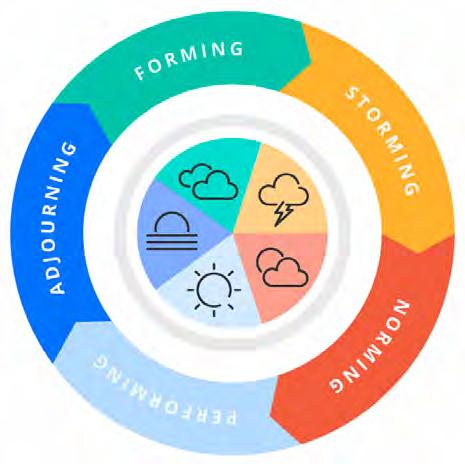
shock at the scale of the impact and the complete upheaval of team dynamics. Notably, the senior leaders, in particular the CO and the two sub-unit commanders, took on most of the strategic domain, which sits as one of the three main elements of the primary colours of the leadership model (Pendleton & Furnham, 2016). The 2iC’s role was generally the interpersonal domain, meaning there was a deficit in this area too. The complimentary differences which allowed the team to function (Pendleton & Furnham, 2016) had been undermined. In a traditional view of group dynamics, using Tuckman’s (1965) linear taxonomy, over the previous year, the senior leadership had already traversed through the stages of orientation to the task (forming) and intragroup conflict (storming), before developing group cohesion (norming) and working at the functional role-relatedness stage (performing) for at least six months. It was clear to me and the rest of the team, that with output required at a high level almost instantly, there was not time to race the team through those stages. Instead, I considered a nonlinear approach to team dynamics, seeing the team being forced into a revolutionary period of quantum change, and needing to find a punctuated equilibrium (Gersick, 1988). Despite the popularity of Tuckman’s model within the military, I found that most people I worked with came to adopt the contemporary view of teams as ever shifting in composition and dynamics, as this was something they were familiar with over years of regular military postings (even as civil servants). For many, this reframing reduced the stress associated with the shock of the change; an immediate success which gave me confidence in practically applying the concepts I had learnt.
To find the punctuated equilibrium once the CO left, I first assembled the regimental and sub-unit middle managers in a group meeting, bringing in ranks lower than would normally be included. In this meeting, I acknowledged the fact that the strategic domain was lacking, but tried to highlight that this was not an issue in the short term. Adopting Hackman’s (2012) metaphor of landing an aeroplane, I stated that the regiment’s strategic direction was already set (established on approach) by the CO
prior to his departure, so rather than having to manage everything (fly the plane down), all that was required was to maintain the course and make small adjustments (Hackman, 2012). Having used the primary colours of the leadership model (Pendleton & Furnham, 2016) as part of the introduction, I asked for leaders at all levels to focus their efforts on the interpersonal and operational domains, just regularly checking the extant strategic direction to ensure they were still on the correct flightpath. This was well received and on reflection, I believe this approach also succeeded in legitimising my leadership as the team saw me not acting above my station or using the position to make big changes, rather trying to implement the strategy already set by the CO. This self-reflection which demonstrated a need to remain humble is particularly pertinent as military teams are typically low in skill differentiation, high in authority differentiation, and moderate to high in stability over time (Goodwin, et al., 2018). As I had come to be acting two ranks up, the authority differentiation had been eroded, meaning that an approach which didn’t rely on rank stratification, rather on a more horizontal structure, seemed more appropriate for the team dynamics during my leadership. The evaluation of the numerous approaches I took to team dynamics could be seen primarily in the positivity and the motivation of the team over that period, demonstrated through results in the areas on which I asked them to focus. I found that in pursuing the CO’s strategic direction, there were only very rare deviations, and often these deviations were identified and stopped by individuals at a peer level, with them not being escalated up the chain. I believe this showed a success in the strategy as members of the team understood and bought into the direction enough to be able to ensure colleagues were following it.
Factor 2: My personal leadership position
Early on, the shock to the team’s dynamics presented dilemmas for me as a leader. Through the primary colours of leadership model (Pendleton & Furnham, 2016), I had identified that previously, my focus had been primarily operational. With additional responsibilities, I now needed to be working in the interpersonal domain too as key leaders with those skills were absent and day-to-day management relied on these abilities. To tackle this challenge, I used the multi-directional lens on leadership posited by Bernd Vogel. Only a few months earlier, I had transcribed my network of leadership relationships as part of the module learning, so I revisited and amended the document, going through my new adapted relationships considering the loss of my line manager and most peers. As “leadership [is] a process that is co-created in social and relational interactions between people” (Uhl-Bien et al., 2014), I understood these relations to be central to the success of my short-term leadership. Linked to the more horizontal team dynamic, I adopted the role-based followership approach. This meant that I pursued an attitude in which I as leader was the recipient or moderator of follower influence in producing outcomes, fitting with the constructionist approach whereby “leaders and followers interact[…] together in context to co-construct leadership and
8 PROFESSIONAL DEVELOPMENT 48 | THE REVIEW 2024 THE ROYAL LOGISTIC CORPS FOUNDATION
4.0
DovileMi, CC
BY-SA
<https://creativecommons.org/licenses/by-sa/4.0>, via Wikimedia Commons
followership as well as their outcomes” (Uhl-Bien et al., 2014). This was due to the aforementioned desire to build legitimacy, and not deviate from extant process and strategy, enabling consistency through and beyond the period. In practice, this meant approaching all issues with humility and openly seeking advice from junior leaders who had more experience or situational awareness. I believe this was only possible because of my own junior position. Had I been taking on the challenge as a Major or Lieutenant Colonel, I would not have pursued this approach, as it could have reduced the trust in the competency and experience associated with more senior ranks. On evaluation, the success of this approach was seen in the confidence I saw develop in junior leaders who were willing to provide useful advice, who previously may not have been forthcoming. However, I am grateful that the duration of my leadership was short, as over a longer period, were more significant issues to arise, I would be concerned that some of the open discussion could venture into open disagreement or insubordination. I would need longer time in the leadership position to fully evaluate the success of the approach I took and provide feedback on whether it is useful to pursue. I was acting in a higher rank, but to fill the numerous workforce gaps, so too were many of those around me. In this context, having read about the experience at Google (Mohdin, 2016), I understood that the team, as well as me, needed psychological safety – the “shared belief held by members of a team that the team is safe for interpersonal risk taking” (Edmondson, 1999, p. 350). To build this, I approached the higher headquarters for permission to further delegate decision making, and for responsibility for mistakes to be taken on by those up the chain. I then expressed to the team that given the situation, those with decision making powers should feel empowered to act and take risks, and that I had explained the situation up the now supportive chain of command. I know that my higher headquarters at times had to explain to its higher headquarters why certain tasks were late or were being completed to a lower standard. However, I know that as I had engaged with them early, they defended my team based on our circumstances. This defence up the chain of command exemplifies the success of my approach, and I believe that the early engagement and explicit acknowledgement to the team enabled a sense of psychological safety which was critical to our success.
After the first day without the CO, noting the increased pressure I was under, I sought to embody the characteristics of resilient people set out by Coutu (2002): First, I instantly accepted the reality of the situation; I was quick to counter my own initial internal mentality which looked to argue with our superiors that we were being unfairly treated by having our leadership removed. Next, I constantly reminded myself of the organisation’s values and purpose; I asked others to do the same by reading the strategic direction that had been disseminated by the CO before he left. I also came to see that, in keeping with Coutu’s article, it was important to focus on life being meaningful and that my specific role was valued by the organisation and by myself. Finally, I used the challenge as an opportunity to practice my

ability to improvise. This final characteristic was the hardest to implement and evaluate as I was often reluctant to make changes that were so significant that they would undermine my own leadership position which was already fighting for legitimacy. On his return, the CO’s evaluation of my performance was positive, but he noted that I was sometimes too beholden to policy; going forward this is an area of development for me.
Whilst it is difficult to evaluate success in this factor, particularly without 360 degree reporting, in asking for constructive feedback as part of the process of writing this reflection and to inform my own self development, colleagues have generally been content with my approach. Most expressed that they saw me as a more collaborative leader and thus more welcoming than traditional top-down military approaches they have experienced. Ultimately, even without this feedback, I believe that my approach managed to encourage positivity and prevented panic during a difficult time, leading to high output. In and of itself, this outcome met the aims I set, so I evaluate it to have been successful.
Factor 3: Sustaining energy
Energy is “the fuel that makes great organisations run” (Dutton, 2003). Dutton states how “the energy and vitality of individuals and organisations alike depends on the quality of the connections among people in the organisation” (2003, p. 1) meaning a shock to connections involving the most senior leaders would significantly impact the energy of the Regiment. With reduced resource, but demand for a similar output level, there was an almost instant transition from productive energy to corrosive energy; which for some individuals looked towards resigned inertia as people lost motivation for a seemingly insurmountable amount of work (Vogel & Bruch, 2011). I believe that many in the unit approached a level of hyper-stress (Yerkes & Dodson, 1908). In looking for specific actions to improve energy, I adopted the conceptual approach of assessing energy as a multidimensional construct (Vogel & Bruch, 2011). In this, I saw how affective energy (Cole, et al., 2012) dropped as workload increased and a sense of being ‘left behind’ by staff who were temporarily assigned elsewhere for more exciting
PROFESSIONAL DEVELOPMENT 8 THE ROYAL LOGISTIC CORPS FOUNDATION THE REVIEW 2024 | 49
Credit: Pixabay

work translated into a negative perception of the Army. As such, I sought to mobilise behavioural energy which “reflects group members’ behaviour as they collectively bring to bear extraordinary efforts to pursue shared goals” (Cole, et al., 2012). In effect, this was an attempt to employ the ‘slay the dragon’ strategy for activating organisational energy whereby the identification of a threat (in this case unit-level failure), can increase levels of productive energy for an intense, short-term spurt (Bruch & Vogel, 2011).
To build a short-term spurt of energy, I looked specifically at the recommendation from Bruch & Vogel that “leaders must […] involve people across the company in solving the problem […] and make the challenge a key aspect of people’s work. And they need to foster a shared belief that they and their team will master the challenge together.” (2011, p. 53). I did this in the open meetings I held regularly for all middle managers including those within sub-units, to go through all the regiment’s critical workstreams, identify problems and work out how we were going to tackle them in the short term. In assessing which tasks were critical, I followed Marks, Mathieu & Zaccaro (2001) and prioritised action and interpersonal processes, being outside of a strategyinformed transition phase (Marks, et al., 2001). Work on strategy formulation and planning was pushed back temporarily as a result.
Alongside the new allocation of temporary responsibilities, a tally was kept of how many additional roles were being taken on by each member of the team to ensure that all attendees felt like the whole team was taking on the challenges together. I also used the meetings to identify additional support that would be required if the issue endured. The resulting reallocation of temporary roles and longerterm support requirements was sent up to the higher headquarters to demonstrate the team’s individual and collective efforts, and to articulate that the efforts would be short term; enduring support would be required if the situation remained the same. The best feedback I received for this period was for these meetings and their output. Those within the team felt that the challenge was no longer insurmountable, and nobody felt that they were taking on a disproportionate burden. Meanwhile, the higher headquarters were grateful that they had information about the short-term solutions and what would be required from them were the issue to go on for a long time (ultimately it didn’t).
To evaluate the success of my approach to sustaining the unit’s energy, a climate assessment –the Army’s mechanism for assessing the satisfaction of troops in a regiment – has been arranged for November 2023, once workforce pressures have fully abated. Alongside this, month to month comparisons of the main output metrics of the Regiment, the number of soldiers trained, should not have dipped during the period. Success will see satisfaction levels on the climate assessment at a normal level as well as no drop in output.
Factor 4: Loss of diversity
Due to a unique public private partnership at the unit, I was leading a team made up of civil servants, contractors and military personnel. Gender-related issues have, for some time, been notable at the
unit, with high levels of Sexual Assault and Sexual Harassment (SASH). This led to the initiation of the SASH Guardians campaign two years ago – a 24/7 signposting service as well as a publicity campaign. One of the key staff to leave was the woman who set up and managed the SASH Guardians campaign. Most of the volunteers were women but with the staff changes, there were now even fewer women in management roles within the organisation - only one female member of military staff - local proof of the fact that the military is not diverse in gender, with only 10.1% identifying as women (Ministry of Defence, 2023). Training on dealing with SASH had been provided for all members of staff, but this was an area where the knowing-doing gap seemed most pronounced for male leaders. From reading work by Ahmadi (2016), I identified that fear seemed to play a large role in this. Men who were sympathetic to the issue were fearful of being volunteers to support female survivors, often due to a misplaced fear that they would be blamed by women who had been assaulted or harassed. Often, more simply, men were just concerned they would make a mistake and be vilified for it. This proved a need to a dispel myths and ensure that there were both women and men involved in the campaign to explain their experiences and reassure men of the importance of the campaign to everyone. Despite this, in many instances, women would be best placed to support and amplify the voices of other women survivors of SASH, as most cases the campaign dealt with were women, and many survivors preferred to speak with women. Despite the workforce pressures, I brought in new members to the SASH Guardians scheme and opened it up to contractors working on site, enabling more women to take on leadership roles alongside men who had taken it over in lieu of an alternative military woman. Another full round of training was provided to encourage more people to volunteer and specifically counter misconceptions about men’s involvement in campaigns against sexual assault and harassment. This training has proven to be successful in recruiting more women from across the organisation, including contractors, and has also reduced the reluctance of men to volunteer. The true success in this area will be seen over the coming years if instances of SASH reduce.
This local example demonstrated to me the need for diversity and diverse thinking and the inclusion of people who experience the world differently due to their identity, particularly in the Army’s training establishments such as the one I work at. Within the Army, 14.4% of soldiers are from ethnic minorities, with far more being soldiers rather than officers. This often means that staff do not understand the specific requirements of those from different backgrounds. In training, this is even more pronounced, as individuals may feel unable to express their requirements as they do not want to stand out in a process which values conformity. This issue applies to many individuals with protected characteristics including those who do not identify as men, members of different faiths and ethnic groups, and those with different sexualities; there are far more junior soldiers with these protected characteristics than there are people leading them. The Army should make a concerted effort to allocate roles within training establishments to a diverse
8 PROFESSIONAL DEVELOPMENT 50 | THE REVIEW 2024 THE ROYAL LOGISTIC CORPS FOUNDATION
Credit: Pixabay
spread of people to highlight to those who have just joined the Army that there is a place in it for them.
Conclusion: Impact of learning on me as a leader
Following the three weeks I led the regiment for, I reflected on the approaches I took. Whilst I have at times inadvertently subscribed to the view that leadership is something that comes naturally to people, my experience highlighted to me how applying the academic concepts which have been developed through the experiences of others saves leaders repeating old mistakes and learning from them. I reflect that I was fortunate that one of the largest leadership challenges of my career coincided with having just learnt numerous methods for approaching the dilemmas that emerged, so they were fresh in my mind, making my learning a significant influence on my leadership, and the opportunity to test it bridged any knowing-doing gap. Going forward, synthesising what I have learnt through the academic and practical exposure I have had, I believe I will be reticent to lead in the horizontal way I did for longer periods of time, noting the potential to veer into insubordination. I also will look to develop my capacity to improvise. However, overall, the key thing I have learnt is that engagement with leadership literature can provide tangible approaches I can use, even when under significant stress, to bring about positive outcomes.
Bibliography
Ahmadi, A., Vogel, B. & Collins, C., 2016. An initial framework for the role of fear in the knowing-doing gap of leadership. In: N. M. Ashkanasy, C. E. J. Hartel & Z. W. J, eds. Emotions and Organizational Governance. Bingley: Emerald Group Publishing Limited.
British Army, 2023. The Army's Civil Service Workforce. [Online] Available at: https://www.army.mod.uk/who-weare/army-civil-servants/ [Accessed 20 June 2023].
Bruch, H. & Vogel, B., 2011. Strategies for Creating and Sustaining Organizational Energy. Employment Relations Today, 38(2), pp.51-61.
Cole, M. S., Bruch, H. & Vogel, B., 2012. Energy at work: A measurement validation and linkage to unit effectiveness. Journal of Organizational Behavior, Volume 33, pp.445467.
Coutu, D. L., 2002. How resilience works. Harvard Business Review, Volume 80, pp.46-55.
Dutton, J. E., 2003. Energize Your Workplace: How to Create and Sustain High-Quality Connections at Work. 1 ed. San Francisco: Jossey-Bass.
Edmondson, A., 1999. Psychological Safety and Learning Behavior in Work Teams. Administrative Science Quarterly, 44(2), pp.350-383.
Gersick, C. J. G., 1988. Time and transition in work teams: Toward a new model of group development. Academy of Management Journal, Volume 31, pp.9-41.
Goodwin, G. F., Blacksmith, N. & Coats, M. R., 2018. The Science of Teams in the Military: Contributions From Over 60 Years of Research. American Psychologist, 73(4), pp.322-333.
Hackman, J. R., 2012. From causes to conditions in group research. Journal of Organizational Behavior, 33(3), pp.428-444.
Mahmood, S., 2023. What is the current state of the British armed forces?. [Online] Available at: https://news.sky.com/ story/what-is-the-current-state-of-the-british-armedforces-12799386 [Accessed 20 June 2023].
Marks, M. A., Mathieu, J. E. & Zaccaro, S. J., 2001. A temporally based framework and taxonomy of team processes. Academy of Management Review, 26(3), pp.356-376.
Ministry of Defence, 2021. UK to provide engineering support to Poland amid border pressures. [Online] Available at: https://www.gov.uk/government/news/uk-to-provideengineering-support-to-poland-amid-border-pressures [Accessed 21 June 2023].
Ministry of Defence, 2023. 1,500 UK troops join major NATO exercise amid expanded UK deployment to Estonia. [Online] Available at: https://www.gov.uk/government/ news/1500-uk-troops-join-major-nato-exercise-amidexpanded-uk-deployment-to-estonia [Accessed 20 June 2023].
Ministry of Defence, 2023. UK armed forces biannual diversity statistics: 1 October 2022. [Online] Available at: https://www.gov.uk/government/statistics/uk-armedforces-biannual-diversity-statistics-october-2022/ uk-armed-forces-biannual-diversity-statistics-1october-2022 [Accessed 20 June 2023].
Mohdin, A., 2016. After years of intensive analysis, Google found the key to good teamwork is being nice. [Online] Available at: https://qz.com/work/625870/after-years-ofintensive-analysis-google-discovers-the-key-to-goodteamwork-is-being-nice [Accessed 20 June 2023].
Pendleton, D. & Furnham, A. F., 2016. The Primary Colours of Leadership. In: Leadership: All You Need to Know. London: Palgrave Macmillan, pp.57-75.
Tuckman, B. W., 1965. Developmental Sequence in Small Groups. Psycological Bulletin, 63(6), pp.384-399.
Uhl-Bien et al., M., 2014. Followership theory: A review and research agenda. The Leadership Quarterly, 25(1), pp. 83-104.
Vogel, B. & Bruch, H., 2011. Organizational Energy. In: G. M. Spreitzer & K. S. Cameron, eds. The Oxford Handbook of Positive Organizational Scholarship. Oxford: Oxford University Press, pp. 692-702.
Wasserman, N., Anand, B. & Nohria, N., 2010. When does Leadership Matter? A Contingent Opportunities View of CEO Leadership. In: N. Nohria & R. Khurana, eds. Handbook of Leadership Theory and Practice. Boston: Harvard Business Press, pp.27-64.
Yerkes, R. M. & Dodson, J., 1908. The relation of strength of stimulus to rapidity of habit-formation. Journal of Comparative Neurology and Psychology, 18(5), pp.459–482.
PROFESSIONAL DEVELOPMENT 8 THE ROYAL LOGISTIC CORPS FOUNDATION THE REVIEW 2024 | 51
The challenges of leading soldiers from a different generation to yours
“Millennials are too lazy and entitled to get the job done”. “GenX only ever want to make money; they don’t care about the company”. “Baby Boomers shouldn’t even have a job here they can’t even use a computer”. Captain Aidan Welch R IRISH reflects on leading others from a different generation in the British Army
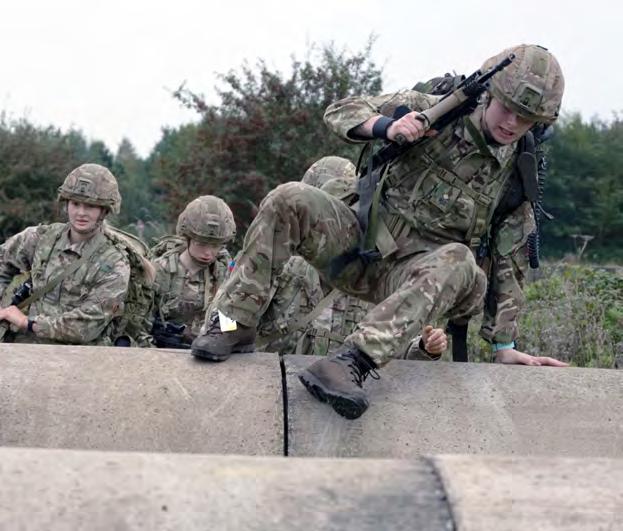
Regardless of what organisation or sector you work in there are clear stereotypes surrounding age and the associated generation individuals come from. These can cause barriers and divisions in a workforce, specifically between leaders and their followers if either party believes too strongly in them. The way the Army recruits its officers generally means that when they arrive at their unit, they are often much younger than their senior noncommissioned officers (SNCO) and therefore there is an instant leadership challenge to overcome. This reflective article will explore the differences between generations1, how their values compare and how I personally tackled the issue associated with leading across generations. Experiences from developing leadership in others from different generations will also be analysed, finally concluding that while the traditional generational gap is present in the Army, Social Learning Theory plays a large role in a leader’s ability to reach across the generational gap.
1There are varying definitions of when generations begin and end. For the purposes of this paper, I will use the following delineations by birth year: Baby Boomers (1946-1964), GenX (1965-1980), Millennials (1981-1996) and GenZ (1997-2010).
Age vs Experience vs Role
The factor of age and experience is often debated when discussing the suitability of British Army officers to make decisions for SNCOs when junior officers have comparatively very little experience. Most of these discussions conclude in the same way as Brigadier Rob Hedderwick explains in his Centre for Army Leadership podcast, where he reflects on his formative experiences and the requirement for trust in his team. He says: “I would seek wisdom from those who had some… Their loyalty back to me was having listened to their advice… eventually the decision would fall down to me to make”. (Hedderwick, 2022). This understanding allows the chain of command (CoC) to work in high pressure and dangerous environments; however, most military leadership is routine, in barracks, where this concept doesn’t apply so easily.
Aside from operations and major exercises, there is generally less time pressure, allowing for a more collegiate style to decision making. Leaders have time to understand the opinion and advice of their more experienced subordinates giving opportunity for them to buy into a plan which, in part, is their own. For this to work, the leader must be selfaware and understand that they do not yet have the experience to decide alone, as noted in Maxwell’s Law of Empowerment (Maxwell, 2007), where only secure leaders give power to others. Maxwell uses the example of a young Henry Ford II leaving the Navy and taking over a failing company, which was losing around $1,000,000 a day. Ford empowered an experienced team which turned the business around and saved one of today’s largest motor companies. This type of self-awareness allows the leader to embody an authentic leadership style; making them more attractive to subordinates of all generations as the feeling of being valued by leaders is recognised as a motivational factor.
Incorporating the experience of others generally strengthens a plan and its potential to succeed, reinforcing the credibility of the team and its leader. As such they become more dependable and appealing, the first step in Social Learning Theory; observing a credible and attractive leader (Brown, et al., 2005). This is important for junior officers arriving at their unit where they will likely be overmatched when it comes to experienceempowering their team and being sure of their abilities as a leader will soon see the team identify with their leadership style and begin to model their
8 PROFESSIONAL DEVELOPMENT 52 | THE REVIEW 2024 THE ROYAL LOGISTIC CORPS FOUNDATION
Crown Copyright
behaviours accordingly. The Social Learning Theory model shows how a leader does not have to identify to the follower through their generation but through showing themselves as a credible individual they can encourage others into followership.
Values and ethics
Generations come with their own ‘values’. What matters to Baby Boomers, typically isn’t the same as GenZ. Naturally this can cause conflict between employees, for example some of the GenX workforce will expect employees to stay in work until they have achieved a task, however, GenZ workers are more likely to expect to finish within their contracted hours, regardless of the task being completed or not. The Army similarly comes with specific values, encapsulated in the form of CDRILS2 (The British Army, 2018). These ‘taught’ values are often much more strongly felt by soldiers than those of their generational stereotype. This is an example of the Army’s Ethical Leadership as a cultural organisation – making it clear what the expected standards of behaviour are in the workplace. Once again Social Learning Theory applies. At the very start of their training, all soldiers are taught what the CDRILS mean and how they contribute to encouraging a member of the Military to recognise and project acceptable moral and ethical values. When they observe leaders embodying these traits, it reinforces their personal and group values and ultimately encourages soldiers to model their behaviour – a form of imprinting. In doing so, this reinforcement removes some of the power of stereotypical differences in generational values and creates a desired ethical standard that every soldier recognises, understands and abides by. This aids in building a strong team without the systemic division than you could expect from a team without shared values and ethics.
How to overcome differences in the team Inevitably, there will be generational differences in any workplace and the Army is no different. In my team I have soldiers who span across three generations. As a millennial, I sit in the middle of this generational spectrum. My second in command is a GenX who joined the Army before I was even born, and I have soldiers under my command as young as 18 years old who sit in the GenZ category. My experience has taught me that people will revert to generational groupings where there is no other stronger affiliation that brings people together. Groups of people naturally want to feel a part of something and if generational associations are the only available affiliation, you will normally witness groups dividing along these lines.
In the early stages of bonding and values recognition, this tendency to migrate to generational affiliations can be easily overcome. If people want to be a valued member of a team, then leaders have to build a credible team for them to be part of. This bonding becomes much harder when these lines have been allowed to solidify, as you are resigned to attempting to change a culture. However, the way you build a team falls into the same transformational

leadership space. Clearly articulating a vision, confidently projecting positivity, and celebrating success through recognition and some rewards will quickly begin to form a team around a joint vision. (Hardy, et al., 2010). My personal experience is that soldiers will only resort to generational differences if the leader and other team members are not strong enough to offer them shared values and a joint sense of purpose.
How to develop their leadership
Developing individual leadership is where generational differences do matter and where the real leadership challenge is. In my experience, what works for GenZ does not necessarily have the same impact for GenX. Furthermore, each generation has a different development requirement. Whilst I have typically found GenX soldiers more dedicated to personal development and requiring less oversight, they do need more help with academic education and computer literacy. In all cases however, I have found it important to set clear goals and an achievable end state. It is important to set these critical deliverables upfront so that everyone understands what you are trying to develop, be it promotion, professional development or even preparation for life outside of military service.
I have approached nearly all these development plans in a mentoring capacity using some of the traits you would expect to see from a coaching relationship. The reason for adopting this mentoring approach is because of the nature of leadership roles in the Army where you are generally in an appointment for 24 months or less, making it challenging to see through a comprehensive 3–5-year coaching plan. Therefore, I have found that plans generally work better when focusing on the next 12 months in detail and working toward more general goals in the medium or longer term. In addition, I have also found 2

PROFESSIONAL DEVELOPMENT 8 THE ROYAL LOGISTIC CORPS FOUNDATION THE REVIEW 2024 | 53
CDRILS: Courage, Discipline, Respect for Others, Integrity, Loyalty, and Selfless Commitment
Pixabay
Pixabay
it very useful to add the individual development of subordinates into the plans of others who I am trying to develop. This is specifically useful for those GenZ soldiers who are generally less interested in personal development. Putting the focus on improving others makes them understand the importance of their own development, encouraging them to engage in the process. I believe part of this is due to maturity, some GenZ soldiers are still very young and as such have a narrower perspective of personal development. The added leadership responsibility begins to broaden this perspective. Developing through mentoring must be voluntary and therefore you must focus effort on making it a joint exercise otherwise the learner will take nothing away.
Conclusion
Generational differences do change the way in which a leader must exercise their leadership style and develop their subordinates. However, Social Learning Theory plays a large role in a leaders’ ability to reach across the generational gap. All divisions, including generational, only survive in weak teams. A strong team which is highly motivated, driven toward common goals and has shared values does not have time or space for these kinds of frictions to play a role and subsequently work to each other’s strengths.
Generational differences are just another small nuance that a leader must recognise, understand and tailor their leadership approach as they would for differing personalities within their team. My personal experiences of working with soldiers from different generations has taught me to remain confident in my own ability, analyse my decisions through an ethical prism, and, in doing so, I have given myself a fighting chance to demonstrate that with the team’s support, I can be a credible leader.
Bibliography
Brown, M., Treviño, L. & Harrison, D., 2005. Ethical leadership: A social learning perspective for construct development and testing. Organizational Behavior and Human Decision Processes, 97(2), pp.117-134.
Hardy, L. et al., 2010. The relationship between transformational leadership behaviors, psychological, and training outcomes in elite military recruits. The Leadership Quarterly, 21(1), pp.20-32.
Hedderwick, B. R., 2022. Centre for Army Leadership Podcast: Episode 34 - Brigadier Rob Hedderwick - Leading the Army Special Operations Brigade [Interview] (7 12 2022).
Maxwell, J. C., 2007. 21 Irrefutable Laws of Leadership. 10th Anniversary Edition ed. Nashville: Thomas Nelson.
The British Army, 2018. Values and Standard of the British Army. Andover: Army Headquarters. Managing
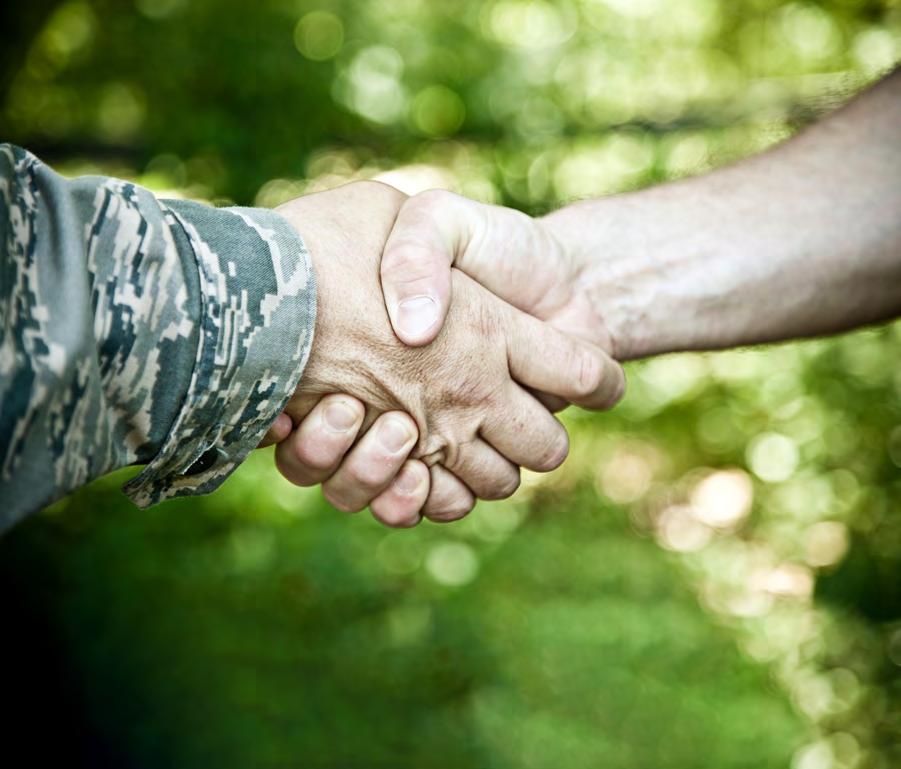

We are looking for:
8 PROFESSIONAL DEVELOPMENT 54 | THE REVIEW 2024 THE ROYAL LOGISTIC CORPS FOUNDATION
the Military to Civilian Career Transition
Operations Managers Make your next career move today.... Service Delivery Managers Logistics Specialists Supply Chain Coordinators Inventory Specialists Supply Chain Managers Project Managers Technical Through Life Support Engineers Contact: Stuart Minshull Framework Manager - Stuart.minshull@tvsscs.com
Hesketh Senior Resource Manager - Kevin.hesketh@tvsscs.com
Brooks Deployment Manager - Chloe.brooks@tvsscs.com
(0)1257 265531 www.tvsscs.com
Kevin
Chloe
+44
Planning Enablement and Reinforcement of NATO forces at scale
Major Nicole Evans RLC discusses the key role of the Joint Support and Enabling Command (JSEC) in NATOs deterrence and defence of the Euro Atlantic Area and implications for the United Kingdom
As NATO develops to adapt to emerging challenges, new organisations are put in place as vital cornerstones of the Alliance’s efforts to strengthen its operational effectiveness. The ability to provide agile, adaptable, and responsive planning, sustainment and reinforcement support across national borders will ensure that NATO can effectively address a wide spectrum of security threats, ranging from conventional military challenges through to hybrid warfare and cyber-attacks.
Cold War History
During the Cold War, credible defence against the Soviet threat demanded that a robust logistics network was established and maintained across member states to support a range of defence and security measures. This network enabled members the freedom of action to efficiently deploy and sustain their combat forces across a range of assumed threat scenarios. Today, conflicts such as that seen between Russia and Ukraine once again highlight the validity of this approach. Few nations can now doubt the importance and the necessity to be prepared ahead of escalation from peacetime to conflict.
From its inception, NATO developed and maintained a comprehensive set of logistical plans, informed and assured by a prescribed series of large-scale movement plans.1 One of these key movement plans was the Rapid Reinforcement Plan (RRP), specifically aimed at rapidly deploying troops and materiel across Europe in the event of any escalation in tensions. Alliance members knew their area of responsibility, both in combat and rear area operations, extending from Eastern Europe to the Atlantic. Exercise REFORGER was held annually to test this and other large-scale plans, showcasing the extensive and effective logistics network the Alliance had developed. This logistical preparedness extended into technical programmes, designed to improve infrastructure across Central Europe and to standardise sustainment practices in an effort to increase levels of interoperability. These plans and programmes, regularly tested and updated, coupled with infrastructure changes that were monitored in line with military requirements, resulted in persistently high levels of logistical readiness.2
After the fall of the Berlin Wall in 1989, the security environment started to change; large-scale standing forces and multinational exercises were reduced and the contingency focus shifted. The new emphasis
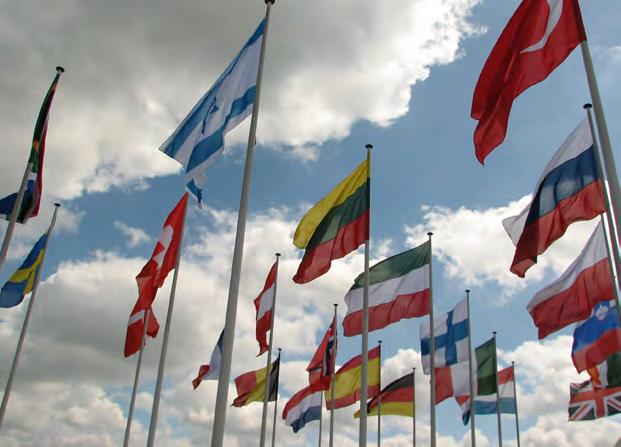
on international security was influenced by the assumed triumph of liberal democracy, driven by capitalism. Fukuyama championed this new thinking3 where national economic developments could be resourced partly by cuts in defence. The result for NATO was the adopted assumption that planning for operations would take place only after the Atlantic Council had committed to a specific task/operation.4 This consigned Cold War logistic plans to a status of suspended animation, and as a consequence they were rarely exercised or war gamed.
In line with Fukuyama’s philosophy and its proposed dividends, major combat operations were something many thought had been confined largely to the history books and a growing lobby of ‘internationalists’ advocated war had been consigned to being outlawed5.
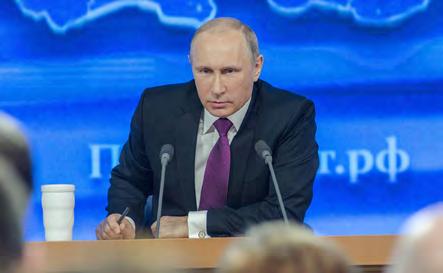
OPERATIONS AND TRAINING 8 THE ROYAL LOGISTIC CORPS FOUNDATION THE REVIEW 2024 | 55
Pixabay
Pixabay
Since the fall of the Berlin Wall however, significant changes to the international security environment have been observed and NATO members now find themselves once more considering multifaceted aspects of potential operations within Europe. The Russian illegal annexation of Crimea in 2014 and its 2022 invasion of Ukraine bought the threat of major combat operations directly to the forefront of the minds of many, not just on the European mainland.
At the same time, global trends began to affect the military sphere, in particular a perceived reduction in conventional threats alongside reducing force numbers transcribed into an opportunity to realise value for money by adopting commercial practices, resulting in increased privatisation of government contracts and services.6 By 2017 it was estimated that 90% of NATO logistics had been contracted out to commercial companies.7
The impact of such a change was, and still is, significant. Outsourcing creates a dilemma across a number of government departments but especially national and Alliance defence strategies. Logistics in defence is a complex entity. A system of systems built on warehousing, multi-modal distribution of raw materials and finished products, many with date dependent and/or special handling requirements. It is this spectrum of specialist component parts that need to fuse together in order to achieve a desired outcome8. Cognisant of the prevailing logistic requirements, it could no longer be assumed that military movements would be planned and executed by a predominantly military staffed chain of command. Neither could the availability of allied forces with compatible resources be guaranteed or that those working within the logistical chain would be enabled or legally allowed to work in line with the demands that would come with military operations.
Globally, as threat pictures began to change with widely available technologies enabling the rapid spread of terrorism, inter-state conflict correspondingly increased in frequency. In parallel with this escalation in range and frequency of threat, the workforce from which military forces were drawing their talent was declining in both key skills and numbers of those choosing to sign-up. Nations began to rethink how they would defend their national borders and those of their Alliance partners.
As a result of such changes and the ever-growing role played by international organisations in widespread logistical and procurement chains; nations were required to re-consider their enablement and sustainment capabilities. These factors do not stand alone. Changes in this area require changes to strategy and a need to consider the whole of warfare. It became ever clearer that as part of the national rethink, a multi-domain approach through multi-domain integration would play a key role when looking at the enablement and sustainment of not only individual nations but also allied forces such as NATO. It is now almost in-conceivable that a country will operate alone when faced with high level conflicts. Well established liaison between nations military, political and civilian organisations has become increasingly vital as a significant component of military planning.
Multi-domain integration
Whilst the nature of and variety of threats became
ever more complex, 9 all Alliance members adapted to meet new global threats with smaller, more agile, integrated forces.
In the UK, this has been characterised by the development of Multi Domain Integration doctrine10 Defence Forces must now consider the Air, Land, Maritime, Space, Cyber and electromagnetic domains both during combat but also in the planning of combat support. In the 21st Century no single Defence Force has the capabilities to effectively develop deep expertise in every one of these areas; therefore, the requirement for linkages to businesses and non-governmental organisations must develop well beyond that seen in recent history for all NATO members. Broader integration in turn increases the co-dependencies between nations to help ensure compatibility or alignment of materiel, communications and in some cases policy. These will often have a knock-on effect on how logistical planning can be conducted, how movement can be controlled and where forces can operate. Where alignment does not exist, a co-ordinating body able to develop credible plans that take into account the national variances and conduct management across the Area of Responsibility (AOR) is required.
The demands of multiple AORs
An increase in threat complexity is matched by an increase in the spread of potential areas where NATO may find itself operating. An increase in global threats has occurred and the UN’s Deputy Secretary General, Amina J Mohammed, believes that we are witnessing “the highest number of violent conflicts seen since the Second World War”11. In this escalating threat environment, economics plays a crucial part in addressing defence and security priorities. Although 26 of 30 member states spend 2% of GDP or more on defence, this is lower than the 3% routinely committed by NATO members during the Cold War. As a consequence, the ensuing tension between sufficient defence funding and operational delivery remains a frequent point of discussion.12
Against this new global security environment, there is a clear requirement for all aspects of NATO to be operating as efficiently and effectively as possible in a cohered and well planned out manner. There is also a need for AOR focused ‘hubs’ to act as the subject matter experts for their assigned region of the world, enabling the execution of pre-planned force movement if needed.
The emergence of a newly distributed NATO Force
The shift in perspective concerning the security of Europe, alongside the changing face of the forces within it, altered the way that NATO would have to think about operating across the security spectrum from peace to crisis and/or conflict. This in turn would change the way it had to conduct day-to-day business, and where it should position (or pre-position) its forces. A NATO Readiness Initiative adopted in 2018 at the Brussels Summit, sought to drive forward the ability to bolster NATO forces in times of conflict or crisis from earmarked national forces capable of deploying combat ready units if required. This saw member nations agree to providing forces from across the land, air and maritime domains at 30 days’ notice to the Alliance
8 OPERATIONS AND TRAINING 56 | THE REVIEW 2024 THE ROYAL LOGISTIC CORPS FOUNDATION

to either be deployed in support of members own forces or to undertake direct standalone military action if the situation necessitated it.
Historically NATO members worked to the General Defence Plan. Initiated by the NATO’s supreme commander in Europe (SACEUR Supreme Allied Commander Europe) it was the method by which NATO planned Collective Defence13. Clearly defined military tasks within a specific framework were drawn up, regularly reviewed and regularly exercised by large forces from nations within the Alliance. The geographical defence zones were clearly defined as were the military scenarios to be trained against. By 1989 this method of planning and exercising troops had reduced considerably. Times were changing and the standing forces held by nations, the complexity of conflict and NATO members had begun to adjust to these changes. Defence doctrines began to shape themselves around more adaptive, flexible and technologically enhanced force elements to deter and/or contest potential aggressors. There was an increased need to consider how to integrate joint actions to overcome layered defences associated with anti-access/area denial, anti-submarine warfare. Alongside this, forces had to be able to operate in contested airspace, with convoluted and extended logistics, to have a rapid speed of assembly and be able to integrate deception and electronic warfare. For many forces all of these elements are now an integral part of how they train and exercise their troops.14 With this increase in integration, the sum of NATO’s military capability is potentially far greater than the relatively small parts provided, in varying degrees, by its members.
The Deterrence and Defence of the Euro-Atlantic Area
In 2021 doctrine was introduced into NATO to enable enhanced integration between those forces that had been individually developing those capabilities; the Deterrence and Defence of the Euro-Atlantic Area (DDA). The DDA forms a central part to the adaptation of NATO in response to the evolving threat picture where the: “DDA is not a return to the past, but the Alliance making a decisive turn to modern strategy to deter 21st Century military threats after decades of crisis response and management operations15.”
As part of the DDA’s development, a series of defensive plans are being put in place, forming a collective defence ‘family of plans’. These include a strategic plan which considers the entire AOR, supplemented with defined regional defensive plans within the AOR and strategic level plans for
each of the multi-domain operating areas16. Each of these plans will include logistical planning relevant to the scale and scope of its operating remit, the geographical challenges of its considered area and the elements of the fighting domains involved. It is recognised that co-ordination and coherence will be central to effective execution at all operational levels. Each of these plans will require organisations capable enough to enable and sustain high tempo activity across the areas they defend.
How NATO is ensuring preparedness
The 2018 NATO Readiness Initiative sought to drive forward the ability to bolster NATO forces in times of conflict or crisis from members able to provide combat ready forces at 30 days’ notice. This initiative was enhanced by the agreement at the 2022 NATO Summit in Madrid, for a new NATO Force Model. The model aimed to have more high-readiness forces available to NATO across all operational domains. This saw nations agree to earmark more high-readiness forces to NATO, to either be deployed in support of NATO members forces or to undertake direct military action if the situation necessitated it.17
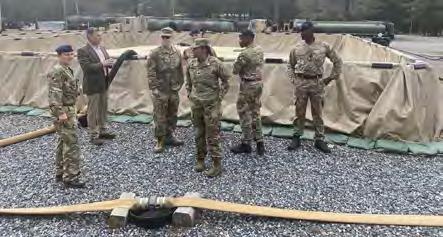
Working to co-ordinate an Alliance brings strength but also a corresponding higher level of complexity. With 31 nations to cohere, discussions will always prove challenging but the scale and breadth of the threats faced dictates that coherence be pursued.18
The development of the DDA and the accompanying ‘family of plans’ supports the raison d’être of JSEC where, “Heads of State and Government have directed the Alliance to strengthen readiness, deployability, integration, and interoperability for the full range of forces, capabilities, assets, and infrastructure”19. Through its functions in liaison, co-ordination, and enablement, JSEC plays a pivotal role in aiding NATO nations with meeting this direction.
The forming of the NATO Joint Support and Enabling Command (JSEC) and its responsibilities
The significantly changed global security environment, influenced the requirement for the formation of JSEC. It was born out of the need to respond to the significant Enablement and Sustainment demands that any movement of Forces across SACEURS AOR would necessitate.20
Despite great progress, there remains significant challenges and opportunities in the co-ordination required when enabling and sustaining forces from channel ports and secure rear areas, through to forces in the front echelons21. The communications that accompany this enabling activity; the
OPERATIONS AND TRAINING 8 THE ROYAL LOGISTIC CORPS FOUNDATION THE REVIEW 2024 | 57
Crown Copyright
Crown Copyright
deconfliction, the movement and pre-positioning of supplies and the co-ordination across national borders, are all aspects which JSEC will adopt as part of its role to ensure effective enablement and sustainment across SACEUR’s AOR.
Initially formed in 2018, JSEC reached its Full Operational Capability in September 2021. It now acts as a functional headquarters under the operational command of SACEUR and is a crucial component of NATO which significantly enhances and enables the functionality of the Alliance’s operational capabilities and efficiency. Established to address the evolving security challenges of the 21st Century, JSEC is tasked with providing essential support and enabling functions to NATO’s military operations and activities. Through its multifaceted approach, it contributes to the Alliance’s overarching goal of promoting security, stability, and cooperation among its members.
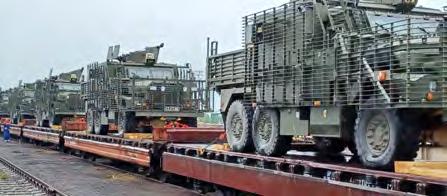
One of the primary responsibilities of JSEC is to provide comprehensive enablement advice to NATO’s military operations. This entails managing the movement of personnel, equipment, and supplies to and from operational theatres, thereby facilitating the rapid deployment and sustainment of forces. JSEC’s enablement expertise ensures that NATO forces have the necessary resources at their disposal. High tempo reinforcement of forces at scale, relevant to the threat, and a capability to move forces for largescale defence operations or reinforce posture across the AOR, can undermine any aggressor/enemy force advantage and reduce their perceived certainty of offensive operation calculations22
Whilst JSEC is not an operational military headquarters, its roles necessitate that routine outputs and exercises must be conducted regularly to inculcate both the civilian and the military elements involved in large scale moves of personnel and/or materiel. Governmental and non-governmental organisations, police forces, and authorities from across member nations all play an important role in JSEC planning for activity in the Euro Atlantic Area. Close co-operation between military and civil actors in the planning processes are a vital part of JSEC’s liaison role.
The activities of JSEC in support of Enablement, Reinforcement or Sustainment
Enablement of forces has a broad remit. It works in mutual support of others operating within the battlespace and is, in turn, supported. The spectrum of activities enabled, reinforced or sustained by JSEC include the forward planning of movement corridors, enabling border crossing activities through engagement with the relevant governments and ensuring routes are suitable for the effective passage of military materiel. Under enablement, JSEC also considers broad human security related aspects of
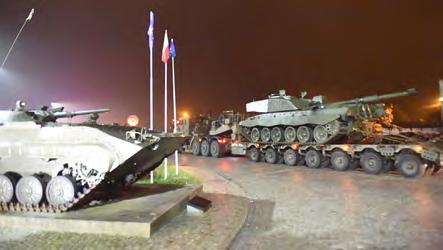
conflict, such as enhancing operational effectiveness through mitigating against impacts of refugee movements within any possible advancement corridors.
The very nature of the environment being analysed and across which planning is being conducted necessitates significant and considered discussion and negotiation with nations. Whilst adding an additional level of complexity, the inclusion of nonmilitary entities in the planning process adds a level of complexity but is essential. Close interaction with the European Union is also required as they are integral in the task of ensuring border movements can take place and that the planned transit corridors are capable of physically enabling the movement of military equipment. The complexities of managing and controlling multiple cross-border transit corridors in a reactionary manner has, to a degree, been eased by a significant change in NATO’s approval protocols. Historically, exercising and planning for large scale force deployment was only undertaken once the Atlantic Council had authorised a specific task/ operation. Today, NATO’s planning and exercising of national crisis or conflict response forces is a regular drumbeat of activity across the AOR and aligns the Alliance’s preparedness to the demands of the contemporary threat picture.
Implications for the UK
In 2015 the Chief of the Defence Staff and the Permanent under Secretary sought to place NATO at the heart of UK Defence23. This directive led to a revision of the way that the UK considered its principles of logistics. They were updated to align with the logistical principles of NATO.
As a Troop Contributing Nation (TCN) to NATO, the UK must be in a position to enable movement of troops across and within its borders and to be intrinsically capable of supporting NATO in the movement of troops across its AOR.
Each nation that forms part of NATO has a collective responsibility for logistical support to missions or operations undertaken by the Alliance24. The geographical scale of the AOR, the number of nations involved and the complexity this brings requires each nation to therefore consider not only the needs, requirements and constraints of its own nation but also those of others. If the force cannot protect the logistics, maintenance, medical, ISR, fires, engineering, and command and control infrastructure at the divisional level then it will struggle to sustain brigades in contact25. This involves significant levels of planning and co-ordination to meet the following NATO directives for a Troop Contributing Nation26:
5 Establishing a NATO Movement Co-ordination Centre (NMCC) or equivalent for the planning,
8 OPERATIONS AND TRAINING 58 | THE REVIEW 2024 THE ROYAL LOGISTIC CORPS FOUNDATION
Crown Copyright
Crown Copyright
coordinating and executing of movement for its own forces from national locations to their area of operations (AOO) and vice versa
5 Obtaining resources for the movement during all phases of an operation
5 Providing national liaison augmentation to JSEC and, as necessary, to the host nation (HN) National Military Command Centre
5 Obtaining diplomatic clearances to support the strategic movement of its forces to/from the Joint Operation Area
5 Supporting medical staffs in developing and implementing national strategic medical evacuation plans; and coordinating with JSEC
5 TCN acting as a framework nation or logistic lead nation for a multinational HQ is further responsible for planning, coordination, and execution of movement for all TCN’s personnel within the multinational HQ.

In order to comply with governmental intent and to meet the agreed stipulations signed up to through being part of NATO, UK forces have to regularly and consistently use NATO exercises as key part of their training cycle to test and develop their forces. These exercises offer the opportunity to operate alongside other Alliance forces with the opportunity to practice interoperability and identify where current or future capability gaps may exist for our own national defence planning purposes. JSEC offers the chance for British forces to gain permanent footholds within one of the geographically central headquarters, working across the span of NATO nations. Embedded personnel, and/or formed units, allows the UK to share, learn and collectively influence both national and Alliance forces in their collective responses to the current threat picture. Interoperability, the ability to effectively cohere a response in times of crisis or conflict and the ability to effectively enable movement of troops at high tempo into and across the AOR, requires every entity to be integrated into the threat response plans and conversant with the DDA.
Conclusion
“We are in a race for logistics.”27 The geographical landmass of Europe and the span of the EuroAtlantic Region places it central to the world when considering many of the contemporary, large scale violent conflicts. Consequently, nations located in this region find themselves needing to ensure they are suitably prepared for any potential future threats. The breadth of increased threats, through predominantly Eastern European aggressive actions, and a significant change in both the size of modern defence
forces, but also the span of civilian organisations now embedded in logistical activities, necessitates effective coherence.
The change in NATO’s stance looking across a far larger geographical area results in greater levels of involvement from nations in decision making, policy and planning. The task of co-ordinating activity across the areas of responsibility necessitates intermediary organisations. JSEC was borne from this requirement and it has the vital role of effectively and efficiently enabling the planning and sustainment of SACEUR’s Euro-Atlantic AOR so as to enhance European security. Where JSEC has the role for this AOR we can surely expect to see further developing ‘JSEC’ style organisations becoming more prevalent both within NATO and beyond, as all nations and organisations continue to adapt to the ever-changing threat picture. The strength of the Alliance is realised through the sum of its collective and closely aligned membership. JSEC reinforces this strength by providing members with the potential to harness NATO’s significant logistical and sustainment capabilities.
Endnotes
1Timo. S. Koster, Reinforcement of NATO forces and military mobility, Atlantische Commisie, accessed 21 Aug 23. https:// www.atlcom.nl/artikel-atlantisch-perspectief/reinforcementof-nato-forces-and-military-mobility/.
2Sergei Boeke, Creating a secure and functional rear area : NATO’s new JSEC Headquarters, NATO Review, accessed 19 Aug 23. https://www.nato.int/docu/review/ articles/2020/01/13/creating-a-secure-and-functional-reararea-natos-new-jsec-headquarters/index.html
3Francis Fukuyama, The End of History and the Last Man, Simon and Schuster, 1992
4Koster, Reinforcement of NATO forces and military mobility.
5See Oona Hathaway and Scott Shapiro, The Internationalists: And Their Plan to Outlaw War, London, Penguin Publishing, 2017.
6Christopher Kinsey and Ronald Ti, Combat Logistics in the Twenty-first Century: Enabling the Mobility, Endurance, and Sustainment of NATO Land Forces in a Future Major Conflict, in Mikael Weissmann, and Niklas Nilsson (eds), Advanced Land Warfare: Tactics and Operations (Oxford, 2023; online edn, Oxford Academic, 20 Apr. 2023) https://doi.org/10.1093/ oso/9780192857422.003.0004,
7Jennifer Cole, NATO: Towards a New Resilience Alliance. RUSI, 1 June 2017. https://rusi.org/explore-our-research/publications/ commentary/nato-towards-new-resilience-alliance
8NATO, Figure 2.1 Movement architecture, 2.1 Allied Joint Publication 4.4 – Allied Doctrine for Movement, 2022, 2.1. https://www.gov.uk/government/publications/allied-jointdoctrine-for-movement-ajp-44.
9Magnus Nordenman, The Incredible, Shrinking Modern Military, The Atlantic, 12 Nov 2012, https://www.theatlantic. com/international/archive/2012/11/the-incredible-shrinkingmodern-military/264989/
10UK MOD, Guidance – Multi Domain Integration, Jun 26 2023, https://www.gov.uk/guidance/multi-domain-integration.
11United Nations. Meetings, coverage and press releases. Meetings coverage Security Council. Accessed Aug 17 23. https://press.un.org/en/2023/sc15184.doc.html
12Defence spending: sustaining the effort in the longterm 03 Jul 2023 https://www.nato.int/docu/review/ articles/2023/07/03/defence-spending-sustaining-the-effortin-the-long-term/index.html Crown Copyright
OPERATIONS AND TRAINING 8 THE ROYAL LOGISTIC CORPS FOUNDATION THE REVIEW 2024 | 59
13SACEUR. Speech to Joint Support Enabling Command. Reinforcement and Sustainment Conference 19 Nov 2023
14NATO. Joint Warfare Centre. Celebrating 15 years 2003-2018. Learning from our past, looking to the future: Exercises, training and Innovation. Date accessed Aug 17 2023 https://www.jwc.nato.int/newsroom/warfaredevelopment-focus/learning-our-past-looking-futureexercises-training-and-innovation
15Harvard Kennedy School, Belfer Centre for Science and International Affairs. NATO’s Concept for Deterrence and Defence of the Euro-Atlantic Area (DDA). Accessed Aug 12 2023.
16NATO SACEUR Speeches and Transcripts. Saceur Cavoli –CEPA Remarks. Accessed Aug 17 2023. https://shape.nato. int/saceur/saceur-cavoli-cepa-remarks
17NATO. What We Do. Troop Contributions. Accessed Aug 19 2023. https://www.nato.int/cps/en/natohq/topics_50316.htm
18The Wavell Room. Maintaining and Improving NATOs Technological Edge. Accessed Aug 17 2023 https:// wavellroom.com/2021/09/30/maintaining-improving-natostechnological-edge-technology/
19NATO’s Concept for Deterrence and Defence of the EuroAtlantic Area (DDA).
20Sergei Boeke. Creating a secure and functional rear area : NATO’s new JSEC Headquarters. NATO Review. 13 Jan 20. https://www.nato.int/docu/review/articles/2020/01/13/ creating-a-secure-and-functional-rear-area-natos-newjsec-headquarters/index.html
21Klaus Nebel and Pavel Kwato Strategic Force Hubs: Thoughts to Develop a New Concept to Support Reinforcement and Sustainment Atlantisch Perspectief, Vol. 45, No. 4, Special Edition: NATO Enablement: Moving forward (2021), pp. 38-42
https://www.jstor.org/stable/48638257
22NATO’s Concept for Deterrence and Defence of the EuroAtlantic Area (DDA)
23Joint Doctrine Publication 4-00. Logistics for Joint Operations. (4th Edition July 2015).
24Allied Joint Publication 4. Allied Joint Doctrine for Logistics (AJP-4) December 2018.
25RUSI Western Way of War Podcasts, Episode 74. Rethinking Logistics.
26RUSI Western Way of War Podcasts, Episode 74. Rethinking Logistics.
27Jens Stoltenberg. NATO Defence Ministers to address Ukraine, stockpiles and critical infrastructure. 13 FEB 23.
https://www.nato.int/cps/en/natohq/news_211691.htm
References
Timo. S. Koster, Reinforcement of NATO forces and military mobility, Atlantische Commisie, accessed 21 Aug 23. https://www.atlcom.nl/artikel-atlantisch-perspectief/ reinforcement-of-nato-forces-and-military-mobility/ Sergei Boeke, Creating a secure and functional rear area: NATO’s new JSEC Headquarters, NATO Review, accessed 19 Aug 23.
Francis Fukuyama, The End of History and the Last Man, Simon and Schuster, 1992.
Koster, Reinforcement of NATO forces and military mobility. See Oona Hathaway and Scott Shapiro, The Internationalists: And Their Plan to Outlaw War, London, Penguin Publishing, 2017.
Christopher Kinsey and Ronald Ti, Combat Logistics in the Twenty-first Century: Enabling the Mobility, Endurance, and Sustainment of NATO Land Forces in a Future Major Conflict, in Mikael Weissmann, and Niklas Nilsson (eds), Advanced Land Warfare: Tactics and Operations (Oxford, 2023; online edn, Oxford
Academic, 20 Apr. 2023) https://doi.org/10.1093/ oso/9780192857422.003.0004,
Jennifer Cole, NATO: Towards a New Resilience Alliance. RUSI, 1 June 2017. https://rusi.org/explore-our-research/ publications/commentary/nato-towards-new-resiliencealliance
NATO, Figure 2.1 Movement architecture, 2.1 Allied Joint Publication 4.4 – Allied Doctrine for Movement, 2022, 2.1. https://www.gov.uk/government/publications/allied-jointdoctrine-for-movement-ajp-44
Magnus Nordenman, The Incredible, Shrinking Modern Military, The Atlantic, 12 Nov 2012, https://www. theatlantic.com/international/archive/2012/11/theincredible-shrinking-modern-military/264989/ UK MOD, Guidance – Multi Domain Integration, Jun 26 2023, https://www.gov.uk/guidance/multi-domain-integration United Nations. Meetings, coverage and press releases. Meetings coverage Security Council. Accessed Aug 17 23. https://press.un.org/en/2023/sc15184.doc.html
https://www.nato.int/docu/review/articles/2023/07/03/ defence-spending-sustaining-the-effort-in-the-long-term/ index.html
SACEUR. Speech to Joint Support Enabling Command. Reinforcement and Sustainment Conference 19 Nov 2023. In person attendance.
NATO. Joint Warfare Centre. Celebrating 15 years 20032018. Learning from our past, looking to the future: Exercises, training and Innovation. Date accessed Aug 17 2023 https://www.jwc.nato.int/newsroom/warfaredevelopment-focus/learning-our-past-looking-futureexercises-training-and-innovation
Harvard Kennedy School, Belfer Centre for Science and International Affairs. NATO’s Concept for Deterrence and Defence of the Euro-Atlantic Area (DDA). Accessed Aug 12 2023.
NATO SACEUR Speeches and Transcripts. Saceur Cavoli – CEPA Remarks. Accessed Aug 17 2023. https://shape. nato.int/saceur/saceur-cavoli-cepa-remarks
NATO. What We Do. Troop Contributions. Accessed Aug 19 2023. https://www.nato.int/cps/en/natohq/topics_50316.htm
The Wavell Room. Maintaining and Improving NATOs Technological Edge. Accessed Aug 17 2023 https:// wavellroom.com/2021/09/30/maintaining-improvingnatos-technological-edge-technology/
NATO’s Concept for Deterrence and Defence of the EuroAtlantic Area (DDA)
Sergei Boeke. Creating a secure and functional rear area : NATO’s new JSEC Headquarters. NATO Review. 13 Jan 20. https://www.nato.int/docu/review/articles/2020/01/13/ creating-a-secure-and-functional-rear-area-natos-newjsec-headquarters/index.html
NATO’s Concept for Deterrence and Defence of the EuroAtlantic Area (DDA)
Klaus Nebel and Pavel Kwato Strategic Force Hubs: Thoughts to Develop a New Concept to Support Reinforcement and Sustainment. Atlantisch Perspectief, Vol. 45, No. 4, Special Edition: NATO Enablement: Moving forward (2021), pp. 3842 https://www.jstor.org/stable/48638257
Joint Doctrine Publication 4-00. Logistics for Joint Operations. (4th Edition July 2015).
Allied Joint Publication 4. Allied Joint Doctrine for Logistics (AJP-4) December 2018.
RUSI Western Way of War Podcasts, Episode 74. Rethinking Logistics.
Jens Stoltenberg. NATO Defence Ministers to address Ukraine, stockpiles and critical infrastructure. 13 FEB 23. https://www.nato.int/cps/en/natohq/news_211691.htm
8 OPERATIONS AND TRAINING 60 | THE REVIEW 2024 THE ROYAL LOGISTIC CORPS FOUNDATION
17 Port and Maritime Regiment Royal Logistic Corps: Remarkable Achievements and Vision
This article by Major David Levens RLC explores the achievements of 17 Port and Maritime Regiment RLC, its pivotal role in contemporary Defence operations and how it looks to optimise to sustain the tempo in the future
17 Port and Maritime Regiment RLC has been making waves in the world of military logistics since the formation of The RLC in 1993. Over the last five years, there has been a remarkable surge in its day-to-day shipping operations, predominantly due to the outload of equipment for the self-defence of Ukraine, but also in support of the ongoing crisis in Kosovo and the Israel/Gaza war. Despite this, business continues, and the Regiment adapts to fulfil all tasks asked of it.
A brief history
Marchwood Military Port or Sea Mounting Centre was built in 1943 to aid in the D-Day assault on Normandy in 19441. It has since supported the outload of equipment by sea for all of the UKs major operations.
17 Port and Maritime Regiment (17 P&M Regt) was originally formed as 17 Port Training Regiment Royal Engineers in 1949 and comprised of 51 and 52 Port Squadrons. It was later joined by 53 Port Maintenance Squadron. In 1965 the Regiment transferred to the Royal Corps of Transport. Headquarters Maritime Group RCT commanded all major army port and maritime units in the UK, including 17 Port Regiment at Marchwood and 20 Maritime Regiment based in Portsmouth2. On the formation of the Royal Logistic Corps in 1993, the Army’s port and maritime capability was focussed on 17 P&M Regt RLC in Marchwood with 165 Port and Maritime Regiment (Plymouth) providing the reserve capability. 17 P&M Regt’s mission is ‘to provide the UK military deployable port, maritime and logistic enabling capability at readiness, in order to enable operational success’. This is conducted in both the UK and overseas, to ensure equipment that is loaded at the port is safely offloaded at the sea point of disembarkation. A famous example of this is the Falklands War where 75% of all stores were landed by Mexeflote raft, which through its versatility and reliability, is still operated today. Like all of Defence, the port has undergone changes. Most recently, the operation of the Sea Mounting Centre has been leased to Solent Gateway Limited, to maximise the prime commercial location in Southampton Water. This agreement allows the military to continue to use the space, while enabling gain share activity to take place during, making the site more efficient and financially beneficial for Defence.
Global reach
17 P&M Regt has played a pivotal role in various Defence operations and exercises, committing

thirty-seven Port Task Groups (PTG) since January 2023 across thirteen different countries and three continents. The Regiment’s strength is its people and their unique skill sets. Their resilience has been tested over the last few years with the frequency of deployments to a broad spectrum of high tempo operations and the associated increase in materiel flow. Between July and December 2023, the Regiment shipped a staggering 144,000,000 tonnes of cargo from the Sea Mounting Centre. The Regiment’s commitments are undertaken from one or more of the following specialisations:
• PTGs. The most routinely deployed PTG size is a team of 8 to 20 soldiers, responsible for the safe loading/unloading of a vessel within a designated timeframe. Task dependent, a PTG could be up to 200 personnel if required. The team is called a ‘gang’ and led by a ‘ganger,’ a Class 1 Port Operator Sergeant or above. Teams are selected and deployed with the relevant training and experience to match the vessels’ load list and are allocated to work a deck at a time. On the UK’s strategic roll-on, roll-off vessels, up to three gangs can work concurrently.
• Vehicle Support Specialists (VSS) have found themselves extremely busy supporting the UK’s commitment to providing Ukraine with the ability for self-defence - Operation INTERLINK. They are employed as specialist drivers who are trained to operate all vehicles across the UK’s fleet and are now being familiarised to load foreign equipment being
OPERATIONS AND TRAINING 8 THE ROYAL LOGISTIC CORPS FOUNDATION THE REVIEW 2024 | 61
8 Marchwood Port Wikapedia public domain
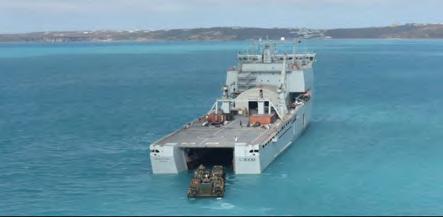
donated to Ukraine, including tracked and wheeled platforms. VSS are critical in the home base and overseas to enable all vehicles and major equipment to be driven on and off the vessels safely and reducing the need for units to send their own drivers. Once the vehicle has been received at the port and signed over, 17 P&M Regt’s VSS will move, load, offload and handover the vehicles at the other end. They are required on all Port Task Groups to conduct this activity and due to their pivotal role, many of the VSS are held at 24 hours’ notice to move.
• Support to Navy Command and the Commando Force. 17 P&M Regt has been committed to the Littoral Response Groups (LRG) North and South. The LRG is defined as a ‘bespoke force assigned to a geographic area, that contains dedicated shipping, helicopters and boats3’. For the ongoing LRG(S) aboard Royal Fleet Auxiliary’s ship LYME BAY, 17 P&M Regt’s standing commitment is a Port Operator gang and crewed Combat Support Boat and Mexeflote. The teams are rotated, but the capability will be persistently deployed for at least two years to enable Navy and Commando Force activity East of Suez. Since January 2023 the Regiment’s commitment to LRG(N) has been support to Exercise JOINT VIKING4 in Norway, Exercise BALTOPS5 in Poland and Operation RONDACHE across the Baltic6. The Regiment’s role is to enable the safe onload/offload of equipment wherever the task group is required. This ranges from a bare beach location with no fixed infrastructure, to a well-founded port with deep water mooring and dockside cranage.
• Operation SOREHAWK. Notably, the Regiment supported Operation SOREHAWK, the return of equipment from Operation NEWCOMBE - the UK’s commitment to the United Nations mission in Mali. All vehicles and major equipments were transported south of the land locked country via road convoy, to the port of Benin, where soldiers from 17 P&M Regt loaded the equipment for its homeward return and subsequent offload at Marchwood.
Standing commitments
• British Forces South Atlantic Islands (BFSAI). The Regiment continues to provide essential support to BFSAI, enabling all island replenishment by sea. Due to the large demand on Defence shipping, the BFSAI resupply vessels are deployed less frequently and therefore require skill to optimise loading within the finite shipping space. The routine resupply requirement for a BFSAI vessel is 2,600 Linear Metres (LIMS), however the last vessel to depart was filled to 3,800 LIMS. To maximise the available shipping space on a Ro-Ro, is testament to the skill of the Regiment’s
Port Operators and Senior Non-Commissioned Officers, who plan and coordinate the loading tasks under significant time pressure. To put this into context, the point class of ships are designed to carry 2,650 LIMS but using the experience of the gangs and careful configuration, load space can optimised to meet the demands of consignees.
• Cyprus. The Regiment also maintains a detachment of vessels in Cyprus. This includes one of each of its vessel capabilities: A Combat Support Boat (CSB), an Army Work Boat and a Mexeflote. These are used throughout the year for routine exercises and in support of British Forces Cyprus taskings.
o Combat Support Boat (CSB). The Regiment is established for five CSBs. They are powerful, versatile craft whose major role is to support both bridging and amphibious operations. These versatile, general-purpose working boats support diving operations, ship-to-shore re-supply, personnel transfers and Mexeflote operations.

8 Combat Support Boat
o Army Work Boat (AWB). The Regiment is scaled for four AWBs. Tugboat designed, they enable the provision of fuel to a deployed force via the towing of fuel dracones, positioning of singlepoint mooring buoys for fuel pipelines, firefighting and assistance to Mexeflote operations.
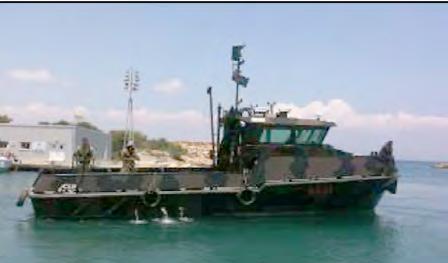
8 Army Work Boat
o Mexeflote (Mexe). The Regiment holds eight Mexeflotes. Extremely versatile modular pontoon craft, they can be configured as powered or dumb rafts, tugs, causeways and floating platforms for use in harbours and inland waterways. One of their significant advantages is their ability to provide heavy logistic lift with shallow draft. Useful in humanitarian assistance and disaster response operations, they offer broad options for transporting heavy and/or out-of-gauge loads, between ships anchored in deep water onto a beach.
8 OPERATIONS AND TRAINING 62 | THE REVIEW 2024 THE ROYAL LOGISTIC CORPS FOUNDATION
8 Mexeflote docking into Bay Class Ship
Crown Copyright Crown Copyright
Crown Copyright
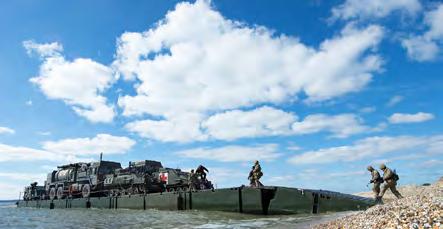
• Support to Training.
o British Army Training Unit Kenya (BATUK).
17 P&M Regt provides an ongoing commitment to the British Army Training Unit in Kenya to enable the light battlegroup training in arduous hot climate conditions.
o Exercise FUELS ENDEAVOUR. The Regiment has deployed specialist personnel on Ex FUELS ENDEAVOUR to enable 516 Special Teams Royal Engineers (Bulk Petroleum) to deliver their ship-to-shore fuel capability. For this activity, the Regiment deployed two CSBs, a Mexeflote and the Unit Dive Team.
Highlights and innovation
Exercise AUSTERE WOLF. The Regiment was the Theatre Enabling Group lead for Ex AUSTERE WOLF conducted in Cyprus from September to November 2022. A simple, but deliberately ambiguous mission, it challenged the Theatre Enabling Group’s flexibility with no specified location, no assigned units and ambiguous timings.
The AUSTERE series of exercises is a simple but brilliant concept. What started as an opportunity to test a subunit, morphed into a multi-domain Defence exercise involving over 1,300 people, the largest Land contribution to Op ACHILLEAN. This was the first joint test of UK amphibious capability in over a decade with the opportunity to test Strategic Base resilience in the UK and Cyprus for Non-combatant Evacuation Operations (NEO).
To add a further challenge, and despite being committed to operational demands, the Regiment was nominated as the lead unit. Meeting this series of demands has meant that there has been little opportunity to deploy as a formed unit since 2016. Seeking to challenge what had become a norm, the Regimental planning team set to carve out an opportunity. The aim was ambitious; to use the Regiment in its doctrinal role by projecting elements of the Field Army over a beach within a major campaign enabling framework. Although there was little time or resource available, the rapidly changing European security context posed critical questions that needed to be answered.
Leveraging networks and relationships and empowered by 104 Theatre Sustainment Brigade (themselves fixed with Op INTERLINK), the Regiment reached out to FLEET to explore joint amphibious opportunities. FLEET has reinvented the Commando Forces and seeking to invigorate old connections, as well as understand the future role of joint maritime enabling of a beachhead for the Army, the teams willingly engaged. Some team members tackled the
longer-term challenges looking at niche capabilitiesspecifically the utility of ship and landing craft. Some studied doctrinal concerns, trying to piece together guidance and practices that have not been critically assessed since the Falklands War. The adopted joint framework was focussed on a specific scenario of a Commando Force seizing a beachhead and how the Theatre Enabling Group might deliver elements of the Field Army to the fight.
With almost no corporate memory of deploying a Regiment, the team had to work from first principles. The complex challenge was exacerbated by the necessity to concurrently organise, instruct and sustain a force at reach, supporting 24 individual units, with differing demands, to mount and recover. Designing a medical plan, environmental assessment and air deconfliction took months of liaison and study with elements from the Ministry of Defence, Permanent Joint Headquarters, FLEET, LAND, AIR and British Forces Cyprus. Relationship and expectation management was critical. There were no executive orders, just a framework mandate, and ultimately asking for a firm commitment from busy people required huge levels of persuasion and trust. Paradoxically, forced to deal with their ‘catastrophic success’, the team had to contend with a huge wave of interest from across Defence with numerous requests for visits to the exercise. These visits amounted to over 20 critical engagements across two months, including VVIPs, diplomatic, media and international partners - all seeking lessons identified.
The result culminated in a Naval Task Group supporting elements of Field Army landing from a Ro-Ro at anchor via ten landing craft, supported by six helicopters and two fixed-winged fighter assets. The Theatre Enabling Group built a 500-person camp and sustained it from the sea. No member of the exercise had experienced anything on the scale of deployment or sustainment. The lessons learned about the scalability and capacity of Cyprus were invaluable and were incorporated into the planning for Op POLAR BEAR, the Sudan NEO.
Movement Controllers and rail optimisation

As part of a wider Defence initiative, members of the Port Movement Control Centre (PMCC) at Marchwood Port conducted a 12-month trial to explore the pros and cons of rail transport. Rail capability has been consciously minimised as a means of movement of LAND assets. Some may remember the ‘golden age of military rail’ and up until 10 years ago rail was utilised daily, with trains running the length and breadth of the UK and Germany in support of routine Defence activity. In recent years, this mode of transport has been largely forgotten and slowly replaced with what is believed to be more flexible road movements. A perfect storm of rolling stock unserviceability and skill fade
OPERATIONS AND TRAINING 8 THE ROYAL LOGISTIC CORPS FOUNDATION THE REVIEW 2024 | 63
8 Mexeflote
8 ISO containers being unloaded from rail at the SMC
Crown Copyright
Crown Copyright
exacerbated with road being regarded as a far more user-friendly option, partially explains the reasons for rail utilisation becoming a rarity.
The utility of rail use is balanced between financial benefit and a marked reduction in carbon emissions, versus a more deliberate, less flexible service which requires bulk movement to generate benefits. 17 P&M Regt is ideally placed to exploit this trial as the port is the hub for equipment and freight for the military. Industry leaders now declare that on average a rail move costs 20% of an equivalent road move. It is also worth noting that rail transport is far more environmentally friendly, producing, on average, 76% fewer carbon emissions when compared to equivalent road movement7. This supports the new MOD environmental strategies8 to reduce Defence’s carbon footprint.
The Marchwood Rail Optimisation Trial was proposed by Sergeant Sellen, the head of the Port Movement Control Centre Rail Section, to reduce the pressure on the Sea Mounting Centre due to the increased volume of cargo being processed through the port. The local proof of concept aimed to identify the following areas: efficiency with high cargo volumes, financial savings to Defence, a reduced carbon footprint and increased security benefits. Sgt Sellen engaged with commercial partners, hosted numerous port demonstrations and visited commercial sites such as MOD Donnington in order to build positive relations between the MOD, Kuehne & Nagel, Team Leidos and GB Rail-freight. These partners were fixed by extant MOD contracts.
The trial ran between 9 Jun 22 – 9 Jun 23 and utilised 49 trains in total. These transported 767 ISO containers between the Sea Mounting Centre, Defence Munitions Kineton and hubs in Bicester and Donnington. The estimated cost saved by this trial to Defence is £826,999.95 equating to an average of £16,877.55 per train or £1,078.23 per ISO. There are financial benefits to be exploited, but the trial also highlighted that from a management perspective, rail was much simpler to organise and the security during transit was also improved due to CCTV which operates 24/7 from a central monitoring room. Future potential of rail. At present the rolling stock is limited to transporting ISO containers or small palletised loads. Should Defence endorse the results of this trial, there is potential to expand the use to vehicles and major equipment. Kuehne & Nagel is currently working on procurement options for specialised rolling stock to allow multi-use transport which can be adapted for each cargo load list. Furthermore, with increased Movement Controller and commercial engagement, there are demand dependant options to use other national railheads to expand the network. This is an exciting time for Army rail so watch this space!
REME Workshop innovation
Like all personnel at 17 P&M Regt, the Workshop personnel are frequently deployed or held at high readiness. Their mission is to provide bespoke maritime equipment support and deliver theatre enabling capabilities at readiness to support UK deployable military port, maritime and logistic operations. Their trades are niche and varied and include electricians, fabricators, recovery mechanics,
riggers, a sail loft machinist, metalsmiths, shipwrights, vehicle inspectors and vehicle mechanics. As part of this broad mission, the Workshop has adapted its equipment to become more efficient and aligned to support Defence operations worldwide.

Swift-Cut Computer Numerical Control Plasma Cutter. The Workshop identified an opportunity to reduce the burden on the support chain for operations by fabricating more spare parts and consumables instead of ordering from the shelf. One of these capabilities is the Swift-Cut plasma cutter. Swift-Cut uses a computer guided high-definition plasma torch to cut through a variety of different metals. It offers the user a highly accurate and extremely efficient fabrication tool. Production tests are ongoing with some suggestions including a Land Rover bumper, a template is created using Computer-aided Design (CAD) software, cut from a single piece of metal then crafted into the correct shape ready to be fitted to the vehicle platform. This will reduce dependency on parts that are becoming harder to procure, but also the ability to experiment and exploit ideas at the user level; improving our equipment through innovation.
XSPEE3D
XSPEE3D is a deployable all-in-one metal additive manufacturing capability, constructed to hold all equipment and auxiliary equipment within one ISO 668 container. It utilises supersonic deposition (SPD), commonly known as cold spray technology to construct metal components from a variety of composites (12 different metals can be used) at pace. It achieves this through a rocket nozzle accelerating air to speeds of up to four times the speed of sound and the composite powders are injected and deposited onto a flat surface attached to a 6-axis robotic am. The sheer force at which it is
8 OPERATIONS AND TRAINING 64 | THE REVIEW 2024 THE ROYAL LOGISTIC CORPS FOUNDATION
8 Swift-Cut Computer Numerical Control Plasma Cutter in action
Crown Copyright

8 XSPEE3D Concept
projected cause the powders to bind and print the overall product. This technology has been stated by SPEE3D to be 1000 times faster in production when compared to traditional laser-based methods. It is capable of printing components measuring 1m x 0.7m in size and up to 40Kg in weight. This unique defence capability will be arriving at 17 P&M Regt in December 2023. The Workshop is currently in the process of identifying the correct personnel to train –training will be delivered by SPEE3D - and delivering in house CAD familiarisation; providing a base understanding to support XSPEE3D integration and to maximise use of the Plasma Cutter. Once installed, requests can be made by any unit for support; this includes on the home bank or when deployed and will optimise 17 P&M Regt’s Workshop to support Defence worldwide.
Conclusion
Due to the unique capabilities embedded in 17 P&M Regt, the unit is a heavily tasked, supporting vital
Crown Copyright
UK Defence activity across the globe. To continue to provide the best service, its personnel are required to identify opportunities for optimising and enhancing the Regiment’s operational outputs and act upon them. Through the innovative and dedicated work of the personnel, the Regiment continues to modernise to meet the contingency needs of an evolving Army and wider Defence, whilst also continuing to deliver the critical day-to-day activity required to achieve the nation’s key demands for national security.
Endnotes
1https://en.wikipedia.org/wiki/Marchwood_Military_Port [Accessed 28 December 2023].
220 Maritime Regt RCT operated the Army’s Landing Craft Tank. D.J. Sutton, The Story of the RASC and RCT 19451982, London, Leo Cooper, 1983, p.677.
3Integrated Review: The Defence Tilt to the IndoPacific. 4Exercise JOINT VIKING is one of the largest winter Joint Expeditionary Force (JEF) deployments to Norway’s High North working alongside the Norwegian Army and US Marine Corps.
5BALTOPS is a large-scale annual exercise involving 6,000 troops from 19 allied nations which supports peace and security in the region.
6A series of multinational exercises across the Baltic region in Estonia, Germany, Latvia, Poland and Sweden and was three months long.
7https://www.networkrail.co.uk/stories/railway-day-freightcuts-emissions-across-britain/.
8https://www.gov.uk/government/publications/ministryof-defence-climate-change-and-sustainability-strategicapproach and https://assets.publishing.service.gov.uk/ media/5a803debed915d74e622d4d5/Sustainable_MOD_ Strategy_2015-2025.pdf.
OPERATIONS AND TRAINING 8 THE ROYAL LOGISTIC CORPS FOUNDATION THE REVIEW 2024 | 65
“The Ukraine Crisis is the West’s Fault”: An Evaluation of Structural Realism
Lieutenant Bethan Lambe RAMC explores the extent to which the war in Ukraine can be attributed to the West’s actions and policies. Ultimately, this analysis aims to provide a balanced assessment of the complex dynamics surrounding the conflict and its implications for contemporary international relations
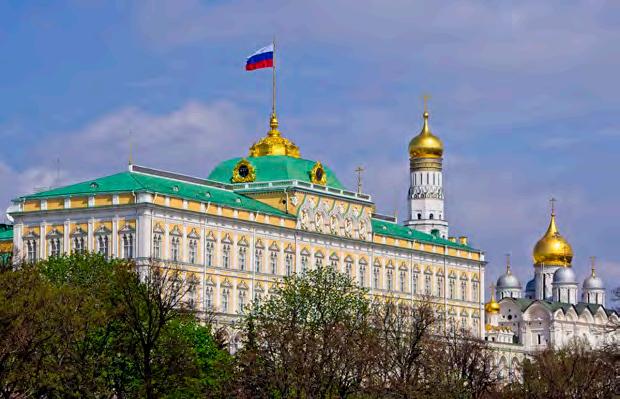
The Ukraine crisis is an ongoing international conflict between the states of Russia and Ukraine, which first began in 2014 with the annexation of Crimea (the Revolution of Dignity). The recent Russian invasion of Ukraine in 2022 marked a significant escalation in the conflict, reverberating across the global geopolitical landscape. The Ukraine crisis could be described as a defining moment in contemporary international relations because it has led to one of Europe’s most devastating modern-day conflicts since the Second World War (Imperial War Museum, 2023). Additionally, it has had far-reaching implications for international security, sparking debates about the causes and roles of various world actors in its escalation.
In examining the root cause of the Ukraine crisis, and the subsequent war, a prominent stance is John Mearsheimer’s structural realist claim, which asserts that the West bears significant responsibility for the conflict (Mearsheimer, 2014, 2022). Structural Realism supposes that in an anarchic system where no higher authority exists, great powers are forced to compete for power to secure their sovereignty (McGlinchey et al. 2017, p.17). Mearsheimer contends that the expansion of the North Atlantic Treaty Organisation (NATO) and the European Union, along with the West's involvement in promoting democracy, were provocative moves that threatened Russia. He argues that these actions, driven by the liberal ideals of the West, have led to the current state of conflict in Ukraine. When assessing the root of a conflict, Waltz (2018) hypothesised that it was indispensable
to analyse the cause through three images: the international image, the domestic image, and the individual image.
The international image
One of the key arguments highlighted by Mearsheimer (2014) is that NATO’s expansion eastwards and its pursuit of including Ukraine in the Alliance has directly threatened Russia’s national security and core strategic interests. By seeking to admit Ukraine into its Alliance, the West has not only encroached upon Russia's perceived sphere of influence but has also heightened its sense of vulnerability. According to Mearsheimer’s Offensive Realist school of thought, Russia as a great power is consistently looking for opportunities to increase its power for survival, with the ultimate goal of hegemony (Mearsheimer, 2016). He presents a compelling and well-supported argument which has consequently gained significant attention in the international relations arena. His assertions are well supported by other realists such as Walt (2022) who ascertains that had NATO not been expanded, Russia would probably never have seized Crimea, and Ukraine would be safer today. However, simply examining one theory-driven approach to foreign policy analysis runs the risk of oversimplification. Edinger (2022) presents an alternative angle to Mearsheimer’s assessment of the Ukraine crisis, stating it does not adhere to his own offensive realist logic as it fails to consider the power perspective of NATO. This viewpoint would suggest that NATO should have expanded sooner. In doing so, Ukraine would have been protected under Article five, deterring Russia from annexing Crimea and invading Ukraine in 2022.
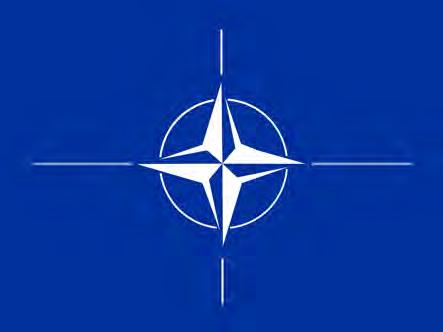
8 GENERAL INTEREST 66 | THE REVIEW 2024 THE ROYAL LOGISTIC CORPS FOUNDATION
Pixabay
Pixabay
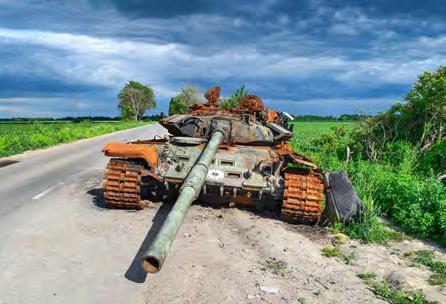
Russia has repeatedly resisted NATO’s expansion due to security concerns and Mearsheimer’s position contentiously legitimises Russia’s perspective that its security is threatened. However, its neighbouring countries were not coerced into joining NATO, they requested to join for fear of potential Russian hostility. Whilst Russia has repeatedly asserted that its aggression towards its neighbours is defensive, its invasion of Ukraine, involved attacking with unjust and disproportionate lethal force (Stemplowska, 2022 & Gutbrod, 2022). This raises a key question as to whether Russia felt genuinely threatened or if it has used the situation to its advantage to politically justify its own offensive realist agenda.

The issue with the realist account of the Ukraine crisis is that it approaches the situation with indifferent logic which promotes immorality. From a liberal perspective, the expansion of NATO can be seen not only as a strategic move but as morally imperative, based on the principles of protecting democracy, human rights, and collective human security within Russia’s sphere of influence. Realists generally reject all appeals to justice, fairness, liberation and insist that Russia should have its own way in a struggle that affects its immediate and national interests more than it does of those in the West (Motyl, 2015). However, simply accepting Russia’s behaviour as an inevitable status quo, overlooks the social, human, and cultural aspects of the conflict. This approach disregards the values upheld under the Liberal International Order by Ukraine and the Western nations, leaving the fate of Ukraine without support from the West in a precarious state of vulnerability and uncertainty.
Finally, by asserting that the Ukraine war is the fault of the West, Mearsheimer is suggesting that it was avoidable and that a diplomatic solution was/ is feasible (Rösch, 2022). However, McFaul et al.
(2014) asserts that this perspective misunderstands the events leading up to the crisis and downplays Russia’s revisionist aspirations. He feels that Russian expansionist strategy and Putin’s “unconstrained, erratic adventurism” are the root of the issue, rather than the West’s triple package of policies. It could be argued that both Russia and the West share responsibility for the breakdown in relations and assigning blame unilaterally is counterproductive in finding a resolution.
The Domestic Image
Domestically, the complex internal dynamics of both Ukraine and Russia have also played a crucial role in shaping the conflict. Mearsheimer’s emphasis on structural factors may downplay the role of domestic politics in Ukraine, where internal divisions and corruption have exacerbated the crisis. Ukraine’s position within Russia's sphere of influence is of great significance due to shared historical, cultural, and strategic ties, particularly concerning its location as a “buffer zone” between Russia and the West. The way that Ukraine emerged from the breakup of the multi-ethnic, multi-lingual, multi-cultural and multireligious Soviet Union has led to ongoing territorial disputes between it and Russia, which have shaped the region's security dynamics (Dunford, 2023).
Ukraine's aspirations for closer ties with the West, as exemplified by the Euromaidan protests in 2014, ignited a fervent sense of nationalism and a desire for greater independence from Russia. The protests were a response to then-President Yanukovych's decision to abandon the signing of an association agreement with the European Union in favour of closer ties with Russia. This decision sparked outrage among a significant portion of the Ukrainian population that sought to align themselves with the West. The protests were not simply a result of external manipulation or Western interference but were driven by genuine popular sentiment. Domestic grievances, corruption, and the desire for a better future were instrumental in fostering the protests (Motyl, 2015). These factors challenge the notion that the West solely engineered Ukraine's push for closer integration with Europe.
Furthermore, the situation within Russia itself cannot be ignored. While Mearsheimer's focus is on the West's actions, it's important to acknowledge that the Kremlin's reaction to the Euromaidan protests was driven by its own domestic political concerns. Putin's regime saw the protests as a potential contagion that could inspire similar movements within Russia, challenging his grip on power. This domestic dimension has influenced Russia's foreign policy decisions, and framing the entire conflict as a consequence of the West's actions overlooks these internal dynamics.
The Individual Image
Although the expansion of NATO and the West's promotion of democracy within Russia’s sphere of influence may have hastened the current Ukraine crisis, it could be argued that under Putin’s regime, it was inevitable. Mearsheimer’s structural realism emphasises state over individual behaviour and interests, but the agency of state leaders cannot be discounted. Mearsheimer dismisses the view that
GENERAL INTEREST 8 THE ROYAL LOGISTIC CORPS FOUNDATION THE REVIEW 2024 | 67
Pixabay Crown Copyright
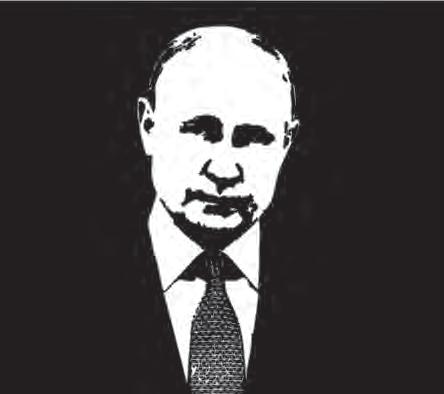
Putin as an individual has played a significant role in the Ukraine Crisis and that Russia’s response to the threat from the West is unsurprising and maybe even reasonable (Mearsheimer, 2014). However, Putin’s actions perpetuated by his personal self-image cannot be disregarded. Immediately after coming into power, Putin focused on establishing an autocratic kleptocracy, amassing wealth and power and creating a personal icon of machismo (Motyl, 2015). His assertive stance on restoring a single state has been personally documented and is a defining feature of his presidency (Putin, 2021). This aspect is not adequately addressed by Mearsheimer’s paradigm which solely attributes the driving factor of the Ukraine crisis to the human drive of fear created by Russia’s current security dilemma. It could be argued that this theory fails to adequately consider Putin’s human drives of anger or appetite for power and makes a significant assumption that Putin is a rational actor (Lebow, 2022). One could argue that the situation contains elements of social construct, implying that should Putin be replaced with a more liberally aligned president, relationships with the West could improve.
Conclusion
In conclusion, Mearsheimer's structural realist claim that the West bears responsibility for the Ukraine crisis offers a compelling perspective, emphasising the implications of NATO’s expansion and the West's involvement in Ukrainian affairs. However, while structural realism provides valuable insights into international relations, it must be balanced with an analysis of domestic factors and the individual decisions of key actors. The international, domestic, and individual lenses collectively
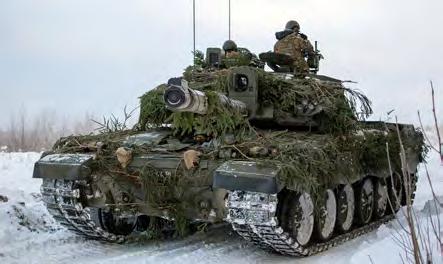
contribute to understanding the complex tapestry of this conflict. Acknowledging this complexity is essential for a comprehensive understanding of the Ukraine crisis, as well as its broader implications for contemporary international relations. By considering multiple international relations lenses, it prevents oversimplified explanations and enables a more nuanced examination of the causes and consequences of this focal global conflict.
Reflective observation
Reading through the material on realism, I began to understand that this aspect relied on the “realpolitik” nature of international relations to explain current global situations. This entails prioritising practical objectives over moral or ideological considerations within the international system. Through this lens, the British Army’s presence in Estonia was facilitated by its alliance with NATO in order to protect its own national security interests. Bolstering the Estonian Army on the Russian border can be seen as an international demonstration of unity and commitment to NATO’s interests. Additionally, it serves as a strategic manoeuvre, upholding NATO’s credibility as a security force. Realism helped to drive home the importance of this deployment as not only a gesture but a statecalculated move to secure Estonia’s sovereignty.
Liberalism's emphasis on international cooperation, democracy, and shared values provided me with an alternative lens from which to look at the deployment. From this aspect, the British Army’s presence can be seen as a manifestation of collective security measures where the members of NATO are working together to safeguard peace and human security. Liberal ideals portray NATO, and by extension the British Army, as a unifying force against potential aggressors.
Abstract conceptualisation
It appears to me that the British Army’s presence in Estonia stands as both a practical demonstration of the realist pursuit of power and security in an anarchic system and simultaneously aligns with the liberal values of cooperation and shared security. International relations is not governed by a single theory but is a complex tapestry of various factors. The British Army's presence in Estonia cannot be refined into a singular explanation, but rather the convergence of multiple theoretical perspectives. Although realism and liberalism are often portrayed as opposing paradigms, both perspectives offer layers of understanding that together provide a more holistic overview of the situation.
Bibliography
Applebaum, A. (2022) Russia’s attack on Ukraine: Anne Applebaum: ‘We need to remove Russian money and influence from all of our political systems’ | International | EL PAÍS English, El PAIS English. Available at: https:// english.elpais.com/international/2022-03-01/anneapplebaum-we-need-to-remove-russian-moneyand-influence-from-all-of-our-political-systems.html (Accessed: 5 August 2023).
Bliddal, H., Sylvest, C. and Wilson, P. (2013) Classics of International Relations: essays in criticism and appreciation. Taylor and Francis Group. Available at: https://ebookcentral.proquest.com/lib/reading/reader. action?docID=1323338 (Accessed: 6 August 2023).
8 GENERAL INTEREST 68 | THE REVIEW 2024 THE ROYAL LOGISTIC CORPS FOUNDATION
Crown Copyright
Pixabay
Charap, S. and Priebe, M. (2023) ‘Avoiding a Long War: U.S. Policy and the Trajectory of the Russia-Ukraine Conflict’.
Dunford, M. (2023) ‘Causes of the Crisis in Ukraine’, International Critical Thought, 13(1), pp. 89–125. Available at: https://doi.org/10.1080/21598282.2022.2163417.
Edinger, H. (2022) ‘Offensive ideas: structural realism, classical realism and Putin’s war on Ukraine’, International Affairs, 98(6), pp. 1873–1893. Available at: https://doi. org/10.1093/IA/IIAC217.
Flockhart, T. and Korosteleva, E.A. (2022) ‘War in Ukraine: Putin and the multi-order world’, Contemporary Security Policy, 43, pp. 466–481. Available at: https://doi.org/10.108 0/13523260.2022.2091591.
Gutbrod, H. (2022) Russia’s Recent Invasion of Ukraine: the Just War Perspective | Global Policy Journal, Global Policy. Available at: https://www.globalpolicyjournal.com/ blog/21/03/2022/russias-recent-invasion-ukraine-justwar-perspective (Accessed: 11 August 2023).
Hughes, J. (2022) The Ukraine crisis: A problem of trust, LSE European Politics and Policy (EUROPP) Blog. Available at: https://blogs.lse.ac.uk/europpblog/ (Accessed: 5 August 2023).
Humphreys, A.R.C. (2013) ‘Waltz and the world: Neorealism as international political theory’, International Politics, 50(6), pp.863–879. Available at: https://doi.org/10.1057/ IP.2013.34.
Imperial War Museum (2023) War in Ukraine. Available at: https://www.iwm.org.uk/Ukraine (Accessed: 18 August 2023).
Kroenig, M. (2015) ‘Facing Reality: Getting NATO Ready for a New Cold War’, http://dx.doi.org/10.1080/00396338.2015. 1008295, 57(1), pp.49–70. Available at: https://doi.org/10. 1080/00396338.2015.1008295.
Lanoszka, A. (2016) ‘Russian hybrid warfare and extended deterrence in eastern Europe’, International Affairs, 92(1), pp.175–195. Available at: https://doi.org/10.1111/14682346.12509.
Lebow, R.N. (2022) ‘International Relations Theory and the Ukrainian War’, Analyse und Kritik, 44(1), pp.111–135. Available at: https://doi.org/10.1515/AUK-2022-2021/ MACHINEREADABLECITATION/RIS.
Lobell, S.E. (2002) ‘War is politics: Offensive realism, domestic politics, and security strategies’, Security Studies, 12(2), pp.165–195. Available at: https://doi. org/10.1080/09636410212120012.
May, R. (2022) ‘Analysing EU Foreign Policy on Russia before the 2022 Invasion of Ukraine’, E-International Relations [Preprint]. Available at: https://www.e-ir.info/2023/06/28/ analysing-eu-foreign-policy-on-russia-before-the-2022invasion-of-ukraine/ (Accessed: 5 August 2023).
Mcfaul, M., Sestanovich, S. and Mearsheimer, J.J. (2014) ‘Faulty Powers: Who Started the Ukraine Crisis?’, Source: Foreign Affairs, 93(6), pp.167–178.
McGlinchey, S., Walters, R. and Scheinpflug, C. (2017) International Relations Theory. Bristol: E-International Relations Publishing. Available at: http://www.e-ir.info/ about/donate/ (Accessed: 6 August 2023).
Mearsheimer, J. (2016) ‘Structural Realism’, in Dunne T, Kurki M, and Smith S (eds) International Relations Theories: Discipline and Diversity.
Mearsheimer, J. (2022) ‘John Mearsheimer on why the West is principally responsible for the Ukrainian crisis’, The Economist. Available at: https://www.economist.com/ by-invitation/2022/03/11/john-mearsheimer-on-why-thewest-is-principally-responsible-for-the-ukrainian-crisis (Accessed: 6 August 2023).
Mearsheimer, J.J. (2014) Why the Ukraine Crisis Is the West’s Fault: The Liberal Delusions That Provoked Putin, Source: Foreign Affairs.
Michailova, S. (2022) ‘An Attempt to Understand the War in Ukraine – An Escalation of Commitment Perspective’, British Journal of Management, 33(4), pp. 1673–1677. Available at: https://doi.org/10.1111/1467-8551.12633.
Motyl, A.J. (2015) ‘THE SURREALISM OF REALISM: Misreading the War in Ukraine’, Source: World Affairs, 177(5), pp. 75–84.
Payne, R.A. (2007) ‘Neorealists as Critical Theorists: The Purpose of Foreign Policy Debate’, Source: Perspectives on Politics, 5(3), pp. 503–514. Available at: https://doi. org/10.1017/S1537592707071514.
Putin, V. (2021) Article by Vladimir Putin ”On the Historical Unity of Russians and Ukrainians“, President of Russia. Available at: http://en.kremlin.ru/events/president/ news/66181 (Accessed: 11 August 2023).
Rösch, F. (2022) ‘Realism, the War in the Ukraine, and the Limits of Diplomacy’, Analyse und Kritik, 44(2), pp. 201–218. Available at: https://doi.org/10.1515/AUK-20222030/MACHINEREADABLECITATION/RIS.
Rose, G. and Brown, M.E. (1998) ‘Neoclassical realism and theories of foreign policy’, World Politics [Preprint]. Available at: https://about.jstor.org/terms (Accessed: 25 August 2023).
Rosenberg, J. (1990) What’s the Matter with Realism?, Source: Review of International Studies. Available at: https://about.jstor.org/terms.
Sears, N. (2016) China, Russia, and the Long ‘Unipolar Moment’, The Diplomat. Available at: https://thediplomat. com/2016/04/china-russia-and-the-unipolar-moment/ (Accessed: 25 August 2023).
Smith, N.R. and Dawson, G. (2022) ‘Mearsheimer, Realism, and the Ukraine War’, Analyse & Kritik, 44(2), pp. 175–200. Available at: https://doi.org/10.1515/auk-2022-2023.
Snyder, G.H. (2002) ‘Mearsheimer’s World-Offensive Realism and the Struggle for Security: A Review Essay’, International Security, 27(1), pp. 149–173. Available at: https://www.jstor.org/stable/3092155 (Accessed: 18 August 2023).
Stemplowska, Z. (2022) NATO enlargement is not to blame for Russia’s war in Ukraine, LSE European Politics and Policy (EUROPP) Blog. Available at: https://blogs.lse.ac.uk/ europpblog/ (Accessed: 11 August 2023).
Tooze, A. (2022) John-Mearsheimer-and-the-dark-originsof-realism, The New Statesman. Available at: http://www. francodebenedetti.it/http://www.francodebenedetti.it/ wp-content/uploads/John-Mearsheimer-and-the-darkorigins-of-realism-New-Statesman.pdf (Accessed: 5 August 2023).
Walt, S. (2022) Liberal Illusions Caused the Ukraine Crisis, Foreign Policy. Available at: https://foreignpolicy. com/2022/01/19/ukraine-russia-nato-crisis-liberalillusions/ (Accessed: 14 August 2023).
Walt, S.M. (2022) ‘An International Relations Theory Guide to the War in Ukraine’, World, 2, p. 39.
Waltz, K. (2018) Man, the State, and War A Theoretical Analysis. Columbia University Press.
Wohlforth, W.C. and Zubok, V.M. (2017) ‘An abiding antagonism: Realism, idealism and the mirage of westernRussian partnership after the Cold War’, International Politics. Available at: https://doi.org/10.1057/s41311-0170046-8.
GENERAL INTEREST 8 THE ROYAL LOGISTIC CORPS FOUNDATION THE REVIEW 2024 | 69
Securing the Nation: Recognising Health as a Vital Component of Security
In this essay, Lieutenant Gethyn Chadwick RLC explores the critical need to securitise health, focusing on the devastating impacts of diseases like HIV/AIDS and the lessons learned from the COVID-19 pandemic

In recent years, the concept of security has expanded significantly, known as securitisation. Security now encompasses a wide range of issues beyond traditional military threats. Yet, the issue of health has not always been regarded as a security concern, despite clear evidence suggesting otherwise. Health security (HS) is not merely a matter of protecting against physical threats but a fundamental aspect of overall security. Within the example of HIV/AIDS, this essay takes a closer look at the case study of how AIDS/HIV has impacted women and children in India; and aims to highlight how education will be vital in the protection of the state from health issues.
Redefining security
Traditionally, security has been defined in terms of military strength and the ability to withstand external aggression. However, modern security must encompass more than this narrow perspective. More traditional academics in the field of security, such as Walter Lippman, define being secure as the ability to uphold the state’s values by being able to achieve ‘victory in such a war’.1 Similar definitions like that of Luciani define security as ‘the ability to withstand aggression from abroad.’2 These can be described as traditional definitions of security. On the other hand, the following definition from Ken Booth is considerably more comprehensive, proposing that security is the ‘freeing of people (as individuals and groups) from those physical and human constraints which stop them carrying out what they would freely choose to do. War and the threat of war is one of those constraints, together with poverty, poor
education, political oppression and so on’3. This is one of the best examples of a definition of modern security. Booth recognises that the freedom from the threat of war is only part of being truly secure. Once we are able to accept this, health as an issue of security seems obvious.
The challenge of AIDS/HIV
There are many dangers of ignoring health as a security issue, some highlighted in the following quote from Altman who believes that ‘HIV/AIDS is arguably an even greater threat to security, with the effect of destabilizing the social and economic order to the extent that the very survival of entire nations is at stake’4. This quote references more than one reason as to why AIDS, and other health issues, can be so devastating. Most importantly is certainly the survival of a nation’s citizens. His claim that HIV/AIDS is a greater threat than traditional issues of security and refers to how difficult it is for a country to recover from a health crisis. According to the World Health Organization, HIV/AIDS causes the fourth most deaths in low-income countries5 This means that more people die because of AIDS than malaria, cancer, and considerably more than conventional conflict. If we are to refer to Ken Booth’s definition which defines security as ‘freeing people from those physical and human constraints which stop them carrying out what they would freely choose to do6’, then there is a glaring peculiarity about the overlooking of health as a security issue. The intention is not to disregard external threats as security issues, these threats will always remain a concern. Instead, to highlight the need for a more diverse attitude toward issues of security. Altmann also acknowledges the social and economic impact of AIDS. The social and economic impact of AIDS is staggering. Danziger writes extensively on these impacts, he states that AIDS/HIV is most detrimental

8 GENERAL INTEREST 70 | THE REVIEW 2024 THE ROYAL LOGISTIC CORPS FOUNDATION
Pixabay
Pixabay
to labour productivity, causes pressure on the health sector, generates discrimination especially amongst women, and severely reduces agricultural production7. The unique impacts of AIDS/HIV on women will be explored in more detail later in this essay. These examples of social and economic problems caused by AIDS/HIV were written focusing on developing countries. This does not mean however, that developed countries are excluded from the societal and economic impacts of AIDS, even if they can be somewhat mitigated by stronger systems. The reduction of agricultural production can be a nuisance to a developed country, as it may reduce exports or access to ‘homegrown’ goods. In a developing country however, such reduction can lead to hunger and starvation. Additionally, developing countries usually have less robust medical systems, more prone to collapse.
Education and new forms of security measures
Using a modern understanding of security, we can think of security measures as improved education or the establishing of more accessible sexual health clinics. Establishing these security measures prior to a AIDS/HIV crisis is paramount, as the crisis becomes increasingly more difficult to resolve once prevalence is high. Altmann criticises the South African government in mid 1999 for placing orders for ‘three new submarines for approximately US$680 million dollars. At the time, something like 1,500 people a day were becoming infected by HIV.’8 I would argue that this kind of spending by South Africa represents a common delusion of security. Hard power has enormous value, but a state should be realistic about its goals and make the most pertinent threat to security the priority. $680 million can have an enormous impact on combating AIDS/ HIV, which Altmann argues would be better spent on health systems, or education and awareness than submarines. The idea that the biggest security threats against a state are always militaristic is outdated. There are certainly cases where this is true, but that level of military spending in South Africa during an AIDS crisis is irresponsible. A state should assess its security threats in an unbiased manner and avoid being drawn into the traditional way of thinking, overprioritizing military security. Of course, you would be hard pressed to argue that the largest threat facing some countries in 2023 is not militaristic, Ukraine being the most obvious example. AIDS/HIV, and other health issues can also pose a security threat, and states must give them a serious amount of consideration. Efforts to reduce the spread of AIDS/ HIV that have been successful previously include the education of militaries and UN Peacekeepers who operate in areas with a high AIDS/HIV prevalence. Russia took serious measures against the spread of AIDS/HIV. Putin declared the significance of the AIDS endemic to the nation and according to Sjöstedt, implemented ‘major policy changes’9 to tackle the problem, such as stricter penalties for injected drug possession. Most notably though, Russia allocated a twenty-fold increase to spending on AIDS. If AIDS and other transferable health issues are recognised as a security threat, mitigation can be successful. A state must assess security threats accurately, without the tendency to ignore serious health and societal
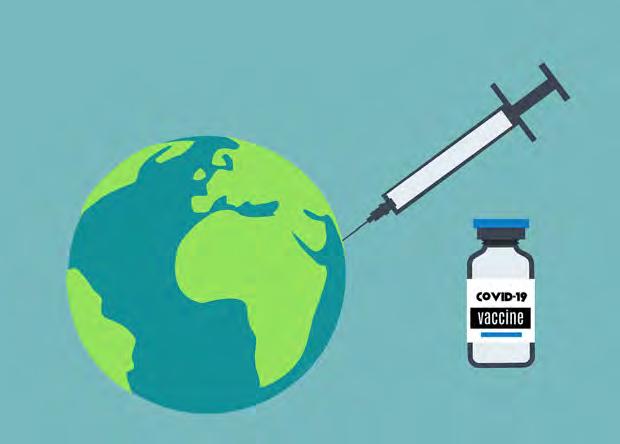
threats for more politically attractive militaristic or conventional threats. As stated by Roosevelt, ‘The defence this nation seeks involves a great deal more than building airplanes, ships, guns and bombs. We cannot be a strong nation unless we are a healthy nation’10. This statement was made by the most significant world leader in 1940, yet we can still notice a tendency to overlook HS. The devastation of COVID-19 throughout 2021-2022, highlights that there is still significant work to be done in the securitization of health.
Addressing concerns
The most common criticism of the securitization of health commonly acknowledges the problem caused by health issues, but states that is not an issue of security. This argument is usually made by academics attached to a more traditional realist understanding of security. The proponents of this type of criticism seem are committed to the most traditional concepts of security, under the belief that the broadening of security will make a state more vulnerable to the ‘primary threat’ of conventional conflict. These concepts were far more valid when the threat of foreign violence was significantly higher for a larger proportion of countries, and globalisation had not changed the way in which states interact. Colin McInnes and Simon Rushton use this type of argument. The authors show concern for AIDS, but they were not willing to consider it a security threat. They write that ‘It is difficult to deny that HIV/AIDS is a global tragedy that has caused many millions of deaths and has ruined countless more lives. But it is not obviously a security issue’11. The response to this by most academics in favour of broadened security would be a simple one, that if it is a global tragedy causing millions of deaths then it should be a security issue. After all, even if we are to consider security as a threat to the state, AIDS still meets these criteria. As declared by Al Gore, ‘AIDS is not just a humanitarian crisis. It is a security crisis — because it threatens not just individual citizens, but the very institutions that define and defend the character of a society.’12 Though I disagree with McInnes and Rushton, their argument is valid. The idea that simply
GENERAL INTEREST 8 THE ROYAL LOGISTIC CORPS FOUNDATION THE REVIEW 2024 | 71
Pixabay
because something is a problem, even a very large problem, does not mean it has to be an issue of security. The debate is really on the definition and conceptualization of security rather than focusing on AIDS/HIV or other health issues. By describing AIDS/HIV as a security threat and acknowledging it as such, it suggests that it is something that can be mitigated with caution and attention, it implies that the individual should be defensive and proactive in the avoidance of such a threat. These are very useful implications to have associated with such dangerous health issues. A more specific and appropriate criticism of HS is that led by Elbe. Elbe discusses the potential problems of biopolitics regarding security. He states that the securitisation of AIDS in particular ‘brings into play a set of potentially racist and normalizing social practices’13. This is certainly a consideration that must be treated with extreme caution when attempting to securitize AIDS/ HIV. These issues presented by Elbe can be avoided however, as the securitization of health issues need not be thought of in terms of stricter borders or racial profiling. Referring back to examples provided earlier in the essay, security against AIDS/HIV can be as simple as education or the improving of sexual health awareness. Elbe himself does acknowledge that there are methods to manage AIDS without the potential for discrimination. Additionally, while overall critical of strong measures against AIDS, Elbe continuously emphasises the danger of the disease, pointing out that every day the pandemic kills ‘three times as many people as died in the terrorist attacks of 9/11.’14 This is a terrifying statistic that puts into perspective the magnitude of health in the security conversation. The idea of racist undertones within HS was witnessed to some degree throughout COVID-19. Policy makers must be very cautious and remain sensitive to biopolitics when implementing measures to improve HS. Despite the risks, Elbe recognises they must be accepted in serious matters of health security, ‘- albeit a gamble that has perhaps become necessary’15
The COVID-19 Pandemic
The COVID-19 pandemic underscores the importance of health security. It has demonstrated that health issues can swiftly become national security threats, affecting economies and societies. The pandemic’s rapid spread and societal consequences emphasise the need to securitise health proactively. It is possible that pandemics of this nature will be more effective at changing attitudes towards HS than diseases like AIDS/HIV. The speed at which COVID-19 developed, along with the lifestyle changes and media attention it demanded, gained the attention of the world. AIDS/HIV is very different to COVID-19 and despite the high death rates (est. 770,000 in 2018)16, it lacks the same level of attention, mostly because it is older and better understood. COVID-19 was rightfully treated as an issue of security, but this treatment must also be given to diseases such as AIDS/HIV. This is not to argue that lockdowns or similar policies should be introduced, only that the diseases should be recognised as credible threats to security. The reaction of the public to COVID-19 has also demonstrated Elbe’s concerns to be realistic. Elbe proposed the dangerous possibilities of racism

when addressing HS, along with the problems of pitting the healthy against the unhealthy. We also witnessed the stigmatization of those who did not abide by official advice and guidelines provided by the state. This staunch support of state policy may not be a dreadful thing, but it does raise new questions and potential problems regarding HS. The cases of racism because of the COVID-19 pandemic were slightly different to what was proposed by Elbe. We have not necessarily witnessed racism against a race of people perceived to be carriers of the disease, instead cases of racism against Chinese individuals due to the origin of the virus in Wuhan. Although this racism was by no means mainstream, it has still demonstrated the potential for racism in HS. This indicates that the concern about racism in HS is not unwarranted. States and organizations should be very conscious of these dangers when implementing solutions of HS, but they cannot afford to be overly risk averse. Overall, the rapid spread of COVID-19 was able to force most state into recognising the virus as a security issue. Even if other diseases such as AIDS/HIV are spread less rapidly, the state would still benefit tremendously from recognising them as a credible threat to security. This recognition will allow the state to get ahead of a potential crisis in the future.
Economic impact of health issues
If HS is not to be recognised as an issue of security in its own right, the potential for health issues to impact more conventional forms of security must be acknowledged. Often, health issues are hugely detrimental to economic security, especially in developing countries. There is almost no dispute that AIDS/HIV is one of the biggest factors preventing
8 GENERAL INTEREST 72 | THE REVIEW 2024 THE ROYAL LOGISTIC CORPS FOUNDATION
Pixabay
strong and consistent economic growth in many parts of Africa. Dixon, McDonald and Roberts summarise that ‘HIV/AIDS reduces labour supply and productivity, reduces exports, and increases imports’17. Most simply, AIDS/HIV reduces human capital. The scholars predict that the AIDS/HIV pandemic has already ‘reduced average national growth rates by 2-4% a year across Africa’18 This estimation by Dixon et al is a relatively low estimation among economic scholars, yet still incredibly substantial. Rasaki Dauda estimates the impact to national growth rates to be closer to 6%.19 Dauda also clarifies that AIDS is so detrimental to the African economy; in particular because it is so prevalent in the most productive age groups. It is important to note that developed countries are not exempt from the economic impacts of AIDS. In developed countries, solid healthcare structures and a more robust economy overall are able to mitigate the damage. Despite all of this, AIDS/HIV still proves to be burdensome. Anne A. Scitovsky, the leading American economist on the impact of AIDS, states that AIDS/HIV has become a ‘major influence on the consumption of medical care resources in the United States’20. Scitovsky estimates the cost of care to be approximately $147,000 per AIDS patient. The COVID-19 pandemic is additional evidence of the potential for health issues to damage a developed economy. It is difficult so shortly after the pandemic for economists to predict the scale of economic struggle that will follow COVID-19, though it has undoubtedly created long term problems. Developing economies are massively hindered by AIDS/HIV, and some of the world’s leading economies are struggling years after COVID-19. These two health issues are only two of a substantial list of significant health issues that could become a crisis at any moment. There are reasonable concerns about the securitization of health, but these must be overcome in order to best guarantee the security of a state and its people. The economic hardship impact of health issues alone is significant evidence for the need for a change of attitude towards health issues and how they are managed.
Securing women’s health in India
The impact of AIDS/HIV, particularly on women in India, highlights ways in which the disease can cause societal disaster. Many of the problems faced by large numbers of Indian women are overlooked complications caused by AIDS. The rate of infection amongst women is rising globally, with Indian women being at extremely elevated risk. According to Stones and Pallikadavath, the current family planning services are not close to providing, or even encouraging widespread condom use, which would dramatically assist in preventing the spread of infection21. Additionally, there is an absence of ‘accessible voluntary counselling and testing (VCT)’ which would also help to contain and manage the damage caused by AIDS/HIV. These poor conditions led to 16.4 million cases of AIDS/HIV in the year 2000 amongst women in India22. Unsurprisingly, this high number of infections would prove to be extremely problematic for Indian society. HIV/AIDS can be transmitted mother to child, most commonly through breastfeeding. In a population where breastfeeding

is exceedingly popular, and most women are not able to be diagnosed with AIDS, the disease will very commonly be spread to children. Although there are still more men infected with AIDS/HIV than women, infection amongst women seems to have unique implications regarding the family and society. Additionally, a higher percentage of women with AIDS/HIV are dying than men. Pallikadavath and Stones provide very sound reasoning for developments to HS with intent to protect women from AIDS/HIV. They call attention to the risk of infant lives, explaining infants are more likely to die if the mother passes away. They also explain that women are already discriminated against in India, and further discrimination could lead to an inability to care for their family. In their words, ‘This dimension of discrimination could further increase if they have HIV/AIDS, resulting in poor health, becoming destitute, and possibly an early demise. Fourthly, Indian women traditionally are carers of children and family, hence their survival is essential for the welfare of the traditional Indian family’23. The impact of AIDS/HIV on women adds another dimension to the problem, one that may require unique attention. The literature suggests education is the best hope of reducing AIDS/HIV in women in India. Sanneh et al carried out a study on Women’s knowledge about AIDS/HIV in different Indian states. The scholars found that ‘47% of all rural women in Maharashtra were aware of AIDS; only about 28% knew that one can avoid it, and only about 16% possessed correct knowledge about its transmission.24’ These numbers are concerning. The statistics are somewhat deceptive however, as represent only a rural community with relatively low AIDS/HIV prevalence. Regardless of prevalence however, all communities should still treat AIDS/HIV as a security issue. If the community possessed the capabilities to recognise the disease as a security issue and educated the population pre-emptively, the spread of AIDS/HIV in
GENERAL INTEREST 8 THE ROYAL LOGISTIC CORPS FOUNDATION THE REVIEW 2024 | 73
Pixabay

that community will be considerably less damaging. Sanneh et al explain that ‘The spread of the epidemic to rural areas presents a need actively to disseminate AIDS related knowledge for health protection rather than waiting for knowledge to follow the appearance of the disease in communities’25. Sanneh references cases such as in Tamil Nadu, where knowledge of AIDS/HIV is high due to extremely high prevalence. It is necessary that authorities of these communities’ (or the state) act preemptively against the threat to the security to the community. Education is one of many factors that must be utilised in achieving security from AIDS/HIV. Access to condoms is also an incredibly effective means of prevention. Improving on any of these methods of managing AIDS/HIV will, to some degree, reduce the impact of AIDS/HIV. A country or state or community with low AIDS/ HIV prevalence should always assume AIDS/HIV as a security threat, especially if nearby states or countries have higher prevalence. The lessons from this case study are widely applicable. The case study evidences that for a population to be best protected from health issues, education of a health issue should always aim to precede high prevalence. It is too common for a nation to only truly understand a health problem once it has already started to devastate the population. Additionally, states should recognise the impact that health issues on adults can have on their children.
Conclusion
In conclusion, health security should be a top priority for states. Neglecting health issues, like AIDS/HIV or pandemics, can have devastating consequences on societies, economies, and individual freedom. Modern security requires a broader understanding that includes health as a fundamental component. Recognising health as a security issue enables better planning, research, and ensures policies are adopted which help protect citizens from disease and underpin national well-being. The impacts of HS are truly massive and extend well beyond health into other aspects of security. AIDS/HIV is arguably the most dangerous health issue of the 21st Century, including the COVID-19 pandemic. The impact of AIDS/HIV on the developing world is staggering, killing hundreds of thousands each year, and almost single-handedly preventing entire regions from serious economic growth. The high prevalence of AIDS/HIV in women in India highlights several societal problems caused by the disease, including marital problems, lack of care for children, and the passing of AIDS/HIV to children. The data compiled by Sanneh et al suggested that there is a lack of knowledge about AIDS/HIV, particularly regarding how it is transmitted. There are many concerns about health securitization, in practice and theoretically. A difficulty unique to HS however is the potential for racism in preventing the spread of contagious or diseases. This is a real possibility but can be avoided with proper caution and sensitivity in policymaking. The COVID-19 pandemic is continuing to prove many concerns about HS to be accurate. The negative impact of the virus is still unfolding, and it is likely that it will continue to do so for decades. If health was treated as a matter of security, even in
conceptionally, it is likely that the current situation would have been less challenging to manage. An acknowledgment of health as an issue of national security leads to enhanced research, planning, and consideration of how citizens of a state can be better protected from disease.
Endnotes
1Mohammed Ayoob, ‘Security In The Third World: The Worm About To Turn?’, International Affairs, 60.1 (1983), pp.41-51.
2Giacomo Luciani, ‘The Economic Content Of Security’, Journal Of Public Policy, 8.2 (1988), pp.151-173.
3Ken Booth, ‘Security And Emancipation’, Review Of International Studies, 17.4 (1991), 313-326.
4Dennis Altman, ‘AIDS And Security’, International Relations, 17.4 (2003), pp.417-427.
5‘Data And Statistics’, World Health Organization, 2020 <https://www.who.int/hiv/data/en/>
6Ken Booth, ‘Security And Emancipation’, Review Of International Studies, 17.4 (1991), pp.313-326.
7Renee Danziger, ‘The Social Impact Of HIV/AIDS In Developing Countries’, Social Science & Medicine, 39.7 (1994), pp.905-917.
8Dennis Altman, ‘AIDS And Security’, International Relations, 17.4 (2003), pp.417-427.
9Roxanna Sjöstedt, ‘Exploring The Construction Of Threats: The Securitization Of HIV/AIDS In Russia’, Security Dialogue, 39.1 (2008), pp.7-29.
10Thomas Stephen Szasz, ‘The Medicalization Of Everyday Life’, 1st Edn (Syracuse, N.Y.: Syracuse University Press, 2007), p.166.
11Colin McInnes and Simon Rushton, ‘HIV/AIDS And Securitization Theory’, European Journal Of International Relations, 19.1 (2012), pp.115-138.
12Julia H Smith and Alan Whiteside, ‘The History Of AIDS Exceptionalism’, Journal Of The International AIDS Society, 13.1 (2010), pp.47-47.
13Stefan Elbe, ‘AIDS, Security, Biopolitics’, International Relations, 19.4 (2005), pp.403-419.
14Ibid., p.403.
15Ibid., p.419.
16‘Global HIV & AIDS Statistics — 2019 Fact Sheet’, Unaids. Org, 2020 <https://www.unaids.org/en/resources/fact-sheet> [Accessed 30 Dec 2023].
17Simon Dixon, Scott McDonald and Jennifer Roberts, ‘The Impact Of HIV And AIDS On Africa's Economic Development’, BMJ, 324.7331 (2002), pp.232-234.
18Ibid., 232.
19Rasaki Stephen Dauda, ‘HIV/AIDS And Economic Growth: Evidence From West Africa’, The International Journal Of Health Planning And Management, 34.1 (2018), pp.324-337.
20Anne A. Scitovsky, ‘The Economic Impact Of AIDS In The United States’, Health Affairs, 7.4 (1988), pp.32-45.
21Saseendran Pallikadavath and others, ‘Rural Women's Knowledge Of AIDS In The Higher Prevalence States Of India: Reproductive Health And Sociocultural Correlates’, Health Promotion International, 20.3 (2005), pp.249-259.
22Ibid., p.250.
23Ibid., p.249.
24Stella Babalola, Claudia Vondrasek and Natasha Sakolsky, ‘The Impact Of A Community Mobilization Project On HealthRelated Knowledge And Practices In Cameroon’, Journal Of Community Health, 6.26 (2001), pp.459-477.
25Saseendran Pallikadavath and others, ‘Rural Women's Knowledge Of AIDS In The Higher Prevalence States Of India: Reproductive Health And Sociocultural Correlates’, Health Promotion International, 20.3 (2005), pp.249-259.
8 GENERAL INTEREST 74 | THE REVIEW 2024 THE ROYAL LOGISTIC CORPS FOUNDATION
Pixabay
Bibliography
Altman, Dennis, ‘AIDS And Security’, International Relations, 17 (2003), pp.417-427.
Ayoob, Mohammed, ‘Security In The Third World: The Worm About To Turn?’, International Affairs, 60 (1983), pp.41-51.
Babalola, Stella, Claudia Vondrasek, and Natasha Sakolsky, ‘The Impact Of A Community Mobilization Project On Health-Related Knowledge And Practices In Cameroon’, Journal Of Community Health, 6 (2001), pp.459-477.
Booth, Ken, ‘Security And Emancipation’, Review Of International Studies, 17 (1991), pp.313-326.
Danziger, Renee, ‘The Social Impact Of HIV/AIDS In Developing Countries’, Social Science & Medicine, 39 (1994), pp.905-917.
‘Data And Statistics’, World Health Organization, 2020 <https://www.who.int/hiv/data/en/>
Dauda, Rasaki Stephen, ‘HIV/AIDS And Economic Growth: Evidence From West Africa’, The International Journal Of Health Planning And Management, 34 (2018), pp.324-337.
Dixon, Simon, Scott McDonald, and Jennifer Roberts, ‘The Impact Of HIV And AIDS On Africa's Economic Development’, BMJ, 324 (2002), pp.232-234.
Elbe, Stefan, ‘AIDS, Security, Biopolitics’, International Relations, 19 (2005), pp.403-419.
Elbe, Stefan, ‘Risking Lives: AIDS, Security And Three Concepts Of Risk’, Security Dialogue, 39 (2008), pp.177-198.
‘Global HIV & AIDS Statistics — 2019 Fact Sheet’, Unaids.Org, 2020 <https://www.unaids.org/en/resources/fact-sheet>
Luciani, Giacomo, ‘The Economic Content Of Security’, Journal Of Public Policy, 8 (1988), pp.151-173.
McInnes, Colin, and Simon Rushton, ‘HIV/AIDS And Securitization Theory’, European Journal Of International Relations, 19 (2012), pp.115-138.
Mothi, SN, MM Lala, and AR Tappuni, ‘HIV/AIDS In Women And Children In India’, Oral Diseases, 22 (2016), pp.19-24.
Nattrass, Nicoli, ‘AIDS And Human Security In Southern Africa’, Social Dynamics, 28 (2002), pp.1-19.
Pallikadavath, Saseendran, Abdoulie Sanneh, Jenny M. Mcwhirter, and R. William Stones, ‘Rural Women's Knowledge Of AIDS In The Higher Prevalence States Of India: Reproductive Health And Sociocultural Correlates’, Health Promotion International, 20 (2005), pp.249-259.
Silverman, Jay G., ‘Intimate Partner Violence And HIV Infection Among Married Indian Women, JAMA, 300 (2008), p.703.
Scitovsky, Anne A., ‘The Economic Impact Of AIDS In The United States’, Health Affairs, 7 (1988), pp.32-45.
Sjöstedt, Roxanna, ‘Exploring The Construction Of Threats: The Securitization Of HIV/AIDS In Russia’, Security Dialogue, 39 (2008), pp.7-29.
Smith, Julia H, and Alan Whiteside, ‘The History Of AIDS Exceptionalism’, Journal Of The International AIDS Society, 13 (2010).
Szasz, Thomas Stephen, ‘The Medicalization Of Everyday Life’, 1st edn (Syracuse, N.Y.: Syracuse University Press, 2007), p.166.
You are invited to submit an article for publication in the 2025 Review
Since its formation in April 2015, the focus of the RLC Foundation has been to promote professional engagement with industry and academia and share best practice; maintain awareness of innovation and to encourage and facilitate thought leadership.
As part of this process The RLC Foundation is inviting officers, soldiers, veterans and civilians working for the military, or in the logistics industry and academia, to contribute thought provoking articles to the 2025 Review. The Review is the professional journal of the RLC and is distributed to members of the Corps serving at home and abroad. This includes all NATO headquarters and the exchange officers based in the USA and Australia. It is also sent to all RLC Foundation corporate partners, supporters and friends.
Articles may be written under the following overarching categories:
• Professional Development
• General Interest
Cash prizes
There are cash prizes for the best contribution in each category. Prizes are also awarded to:
• Best contribution overall
• Best contribution by an officer
• Best contribution by a warrant officer or senior non-commissioned officer










• Best contribution by a junior non-commissioned officer
• Best contribution by a junior officer
• Best contribution by a private soldier
• Best contribution by a civilian Rules
Articles must not exceed 5,000 words and must be properly referenced and supported with good quality copyright permissioned illustrations and images. Reuse licence details must be stated.
All articles submitted for publication will be read and marked by the senior officers that make up the RLC Foundation Review board. The prize winners will then be selected from the articles they judge as good enough for publication.
8 The closing date for submissions for the 2025 Review is 30th September 2024.
Entries are open now and submissions should be sent to Marti Jerrard at: therlcfoundation@gmail.com

GENERAL INTEREST 8 THE ROYAL LOGISTIC CORPS FOUNDATION THE REVIEW 2024 | 75
RLCF SPECIAL 8 THE ROYAL LOGISTIC CORPS FOUNDATION THE REVIEW 2023 17 even managed to get them further trade training while working on the two-year project, so it didn’t hinder their career progression. “The Op WINDFIRM team manged to complete the vehicle decontamination in early 2022, five weeks ahead of schedule. As the vehicles were rolling off the decontamination line, they had to be moved onto transporters and then taken to other sites or parked up in clean locations Ashchurch. This meant during the course of the operation there were in excess of 30,000 individual vehicle moves executed by the team “The REME Recovery Mechanics faced challenges could not started and under power, the vehicle depot’s elderly Liebherr tracked tug was used to move them. Having moved around 100 AFVs its rubber track pads wore out meaning didn’t have the traction to pull heavy vehicles. transpired that Liebherr had discontinued production of the tug converted bulldozer) so the MOD had to commission it to make one-off pair tracks taking four months before it could be used again. This meant had to request assistance from Army HQ to get Challenger Armoured Repair & Recovery Vehicles (CRARRV) and crews rotate through Op WINDFIRM from REME Battalion and source heavy aircraft tug from the RAF, so movement of the Major Spiers said the main lesson in terms of project management he took away from Op WINDFIRM was you can plan a project at desk level; but without a This means using the experience of the subject matter dealing with arising situations, one step a time. This was what ensured the success of Op WINDFIRM. As was to have good managers and an excellent team on Maj Spiers added there were few safety related incidents, during Op WINDFIRM, but given numbers individual vehicle movements (30,000+) and the fact the majority had to be pushed or dragged around and pushed onto low loaders as they couldn’t be driven on some issues were to expected. But he said they happened in a tiny proportion of vehicle moves there were serious injuries as a result. Thanks the impact historic construction materials and the weathering effect flora, fauna and elements had them, the situation DE&S found itself in, in mid-2019, was ideal. Given the scale the decontamination operation and the amount of materiel placed in controlled environment, rendering it temporarily non-deployable, begs the question whether the UK’s contingency heavy drag armour started depot Liebherr tug pushing Working in the hot summer exhausting 8 RLCF SPECIAL REVIEW THE ROYAL LOGISTIC FOUNDATION decontaminate all these vehicles equipment was huge. In terms of the vehicles, there are two fleets stored Ashchurch. SEF consists around 2,000 vehicles of all types, which forms Field Army’s immediate reserve. kept in a climatecontrolled environment and is normally serviced and maintained by team of technicians and mechanics defence contractor Babcock International The fleet is readiness and can be deployed at relatively short notice. The other fleet is the Stored Operational Fleet (SOF). This accounts the majority of the vehicles and basically it is spare fleet that cannot used as the Army does not have enough resources to operate, maintain or store anywhere else. maintained is not in controlled environment. Some has been storage for well over 10 years. “The first thing we had do was get safe working and storage spaces established, we could decontaminate vehicles and get the Babcock team back work on SEF vehicles once they been decontaminated and tested free of There some sheds the site without asbestos roofs, so were cleared out, decontaminated and used for purpose. “The project required a multi-agency approach. We civilian environmental services contractor MSS Group who did the cleaning and contamination removal, contractor who undertook monitoring and sampling and provided assurance that the decontamination was complete and an Army ‘Force Generated’ a team of Royal Logistic Corps (RLC) Vehicle Support Specialist (VSS) do all the vehicle movements on site off site, vehicles were relocated following decontamination. “It quickly became apparent that the stored vehicles needed mechanical work, just to move them of their to the decontamination area, due to dead batteries, rotten oil and fuel seals, or missing components and assemblies, where parts had been taken them to repair other vehicles. This meant bringing a team of REME Vehicle Mechanics and other associated trades. They included REME Recovery Mechanics and recovery vehicle to drag vehicles out of the sheds, because they couldn’t be started. All the military component had to work in full asbestos PPE with respirators, which was very challenging during warm summer months. “When we started, had limited equipment and resources and my command team, which included a major from The RLC and two RLC warrant officers, had to manage the project the ground we went along from challenge to challenge. This included managing the civilian contractors, the site staff that been allowed remain other sub-units that based site. “The tempo for the project was to clean around 20 to 30 vehicles day. This was fine for trucks and 4x4 vehicles, but found the armoured fighting vehicles (AFV) took much longer. In addition water was not allowed to be used in the decontamination process, and vehicles not be brushed; so the vehicles were cleaned using wet wipes and specialist vacuum cleaners. Our deadline completion was April 2022 as a million site was start in September clean was in excess of 7,500 in addition there were around 270,000 items of other equipment, down to individual electrical cables, that had to be out of the sheds and decontaminated. July 2021 around 5,900 vehicles had been declared free from asbestos and 5,000 moved off site. Our attention then turned towards the mammoth task decontaminating circa 108,000 items of Royal Engineer Bridging (REB) equipment. At this point we were joined by team of 12 Royal Engineers, who moved REB into newly set up decontamination zones. “As you can imagine we continually worked under pressure. team consisted of around 110 cleaners from MSS Group price contract, our joint team 3+38 REME, RLC VSS and Royal Engineer (RE) personnel had to keep the cleaning lines continually supplied. The soldiers their normal units don’t get anything near the level of exposure to their trades as they did Op WINDFIRM and they learnt a huge amount from the work. We Over 30,000 moves the the Personnel working the asbestos REVIEW Bringing together logistics professionals from Defence, Industry and Academia 2024 THE RLC THE ROYAL LOGISTIC CORPS FOUNDATION #BritishArmyLogistics • Operations and Training • Historical
How will robotics, autonomous systems, and artificial intelligence shape conflict?
Warfare is in a state of significant technological change. Robotics, autonomous systems and artificial intelligence are already beginning to shape the future character of war. Captain Simon Smith RLC highlights the importance of humans remaining part of the decision-making loop
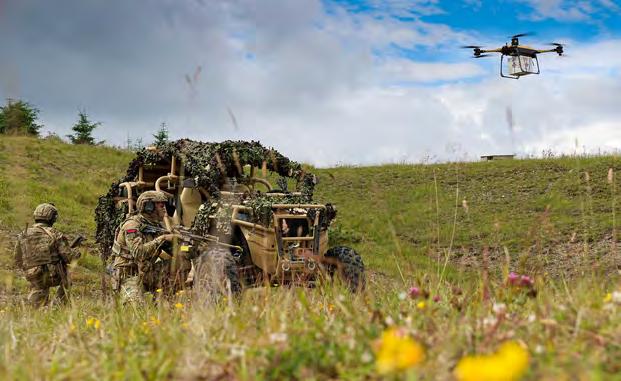
Crown Copyright
The Nagorno Karabakh conflict in 2020 demonstrated the potential of the emergent technologies now in use within the battlespace. Utilising unmanned arial systems (UAS), loiter munitions and precision guided weapons, the Azeris used sensor-cued fires to defeat better trained Armenian forces. More recently, conflict in Ukraine has rendered it a ‘battle lab for war technology’ (Wallace, 2023) as opponents seek to gain military advantage over each other.
A technological perspective alone is insufficient to understand how robotics, autonomous systems, and artificial intelligence (RAS and AI) will shape conflict. It fails to account for the interplay between technologies, people and the data connecting them. A sociotechnical perspective, emphasising reciprocity and joint optimisation between humans and technology (Ropohl, 1999), is instead considered, with discussion framed from tactical, operational, and strategic perspectives akin to Geels’ (2004) multi-level perspective on socio-technical transitions, which focusses on niches, regimes, and wider landscapes. Four motifs (mass, efficiency, tempo, and decision making) are drawn out to form conclusions on how RAS and AI could shape the future character of conflict.
Definitions
Derived from an old Slavonic word describing a life of servitude, a robot is a machine that provides mechanical assistance to a user. They do not inherently hold intelligence but are tools designed to complete specific tasks, but an autonomous system can understand higher-level intent and
direction. From this understanding and its perception of its environment, autonomous systems can take appropriate action to bring about a desired output. They can decide a course of action from a number of alternatives without human oversight or control; although these may be conveyed upon either hardware or software at varying levels. AI refers to technology that allows robots or autonomous systems to think or act in a human way. AI is usually linked to a field of data science called machine learning, which refers to a system’s ability to learn relationships between input data and defined outputs without being explicitly programmed to do so (British Army, 2018).
These definitions should not be seen in isolation but instead in relation to each other as part of a wider socio-technical system. The British Army’s senior staff officer for RAS, Lieutenant Colonel Lamont (2022), suggests that the optimum mix of human-machine interaction is best understood through a mesh of technology, data, algorithms, system architectures, and the people who design and control them. How this mesh manifests itself can be articulated within the context of the recce-strike complex at tactical (niche), operational (regime) and strategic (landscape) levels.
UAS as a tactical socio-technical niche
Sensors lie at the heart of the recce-strike complex. At the tactical level, RAS have potential to drastically increase the number of sensors available: more sensors render more data; more data creates potential for more effective targeting and strike. The use of UAS in Ukraine provides just one niche example. The Ukrainian Army is fielding thousands of first-person view (FPV) drones with improvised munitions to find and strike Russian targets. The sensors (the drones’ cameras) are controlled via live video feeds by operators, often empowered as ‘deciders’ to strike. The ‘effector’ may also be the same drone, retrofitted with precision munitions. In this case, ‘kill chains’ are not only short, but also organic. Whilst enhanced tempo is the resultant benefit, the fact that such UAS are both cheap and plentiful, means that these benefits are also compounded through mass.
UAS are, however, particularly vulnerable to jamming, which blocks the electromagnetic and GPS signals used to control them. Advances in drone autonomy and AI could mitigate against this vulnerability. For example, autonomous drones could
8 GENERAL INTEREST 76 | THE REVIEW 2024 THE ROYAL LOGISTIC CORPS FOUNDATION
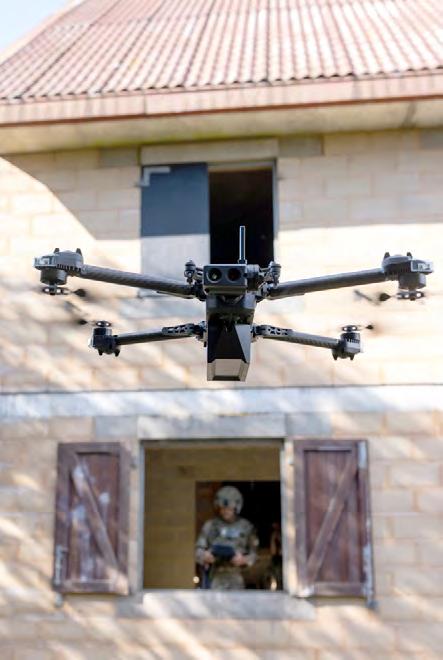
fly pre-set routes with data downloaded upon return (the disadvantage of this, however, is the reduction in targeting tempo). AI-powered drones that have been GPS-jammed could resort to terrain matching (a technology dating back to the advent of cruise missiles but now capable of being housed in ever smaller platforms and at lower costs). The cofounder of the Ukrainian drone manufacturing firm, Twist Robotics, recently described AI-powered FPV kamikaze drones as “a poor man’s Javelin”, referring to their ability to stay locked onto their targets even if they lose contact with their operators due to jamming or physical obstacles (Olenchyn, 2023). Cost comparison is important here. The simplicity of the electronics and their commercial availability means that FPV drones are cheap and fast to produce. Typically under $500 per drone, they are drastically cheaper than Javelin missiles, which typically cost around $200,000 each. As evidenced in Ukraine and at the tactical level, RAS and AI are already shaping conflict through mass and economic efficiency.
The recce-strike ‘kill-web’ as the emerging operational socio-technical regime
Developments in RAS and AI at the tactical level may indeed result in niche successes on the battlefield, however, as commented on by Major General Colin Weir (2023) in a British Army Review article titled, ‘How we will fight in 2026’, warfighting will require the establishment of a deep effects systems architecture to achieve the desired high tempo reccestrike concept. Sweden’s ARCHER artillery system enables hasty autonomous ‘shoot and scoot’ deep fires and, in the wake of gifting AS90s to Ukraine, the British Army has already placed orders for the ARCHER artillery system. Ready to fire in as little as
14 seconds after halting, and able to move within 20 seconds after firing its last round, ARCHER platforms reduce the risk of being targeting by counter-battery fires, and their integrated targeting systems mean that smarter munitions (e.g. US-made Excalibur precision munitions and Swedish-made BONUS cluster munitions) can be automatically programmed from the safety of the armoured cabin.
Crown Copyright
Whilst new hardware can assist in achieving such tempo, it is via software that the real gains in tempo may be achieved. Joshi (2023) suggests that operational successes could hinge upon the networked regimes through which sensors and effectors, such as the ARCHER artillery platform, are connected. ‘Kill-chains’ are arguably an outdated buzzword. Technological advances now render the term ‘kill-web’ as more appropriate. When it comes to networking an attacking force to expedite sensor-to-shooter time and quicken the ‘kill-web’, information is increasingly viewed as a defining weapon of war (Osborn, 2020). DELTA is a battlefield management application, developed by the Ukrainian Ministry of Defence, which integrates information from a broad network of sensors. The output is geolocated information, mapped in real time, and readily accessible to military commanders to assist in decision making. It is integrated with the USA’s Geospatial Intelligence Agency, so users can layer information onto satellite imagery. This allows data to be combined in clever ways. A battalion might use American radio-frequency satellites to detect emissions from a Russian radar in a general area, then send a cheap drone on a one-way mission to confirm its location (Joshi, 2023). The DELTA application is also integrated with eVorog, a chatbot that enables users to log human intelligence via the encrypted application, Telegram. In April 2022, Ukraine’s Minister for Digital Transformation tweeted that in less than a month since its roll out, over 250,000 reports had been submitted via eVorog, citing its uptake as crucial to countering the Russian invasion in its early phases (Fedorov, 2022).
At the operational level, applications such as DELTA provide a system through which information may be gathered, however, the sheer volume of data creates its own problem. All this data must be analysed and presented to decision makers in

GENERAL INTEREST 8 THE ROYAL LOGISTIC CORPS FOUNDATION THE REVIEW 2024 | 77
Crown Copyright

meaningful ways; the more data that is collected, the more complex and time consuming it is to analyse. AI has the potential to alleviate this problem through its ability to sift through and analyse data much faster than humans. The US firm, Palantir, is arguably leading in this regard, with its CEO boasting that its Artificial Intelligence Platform (AIP) was responsible for most recce-strike targeting by Ukrainian forces (Karp, 2023a). Palantir’s AIP is similar to DELTA but builds upon it by integrating advanced AI. Take for example, a military commander’s desire to understand what is happening at a specific location and time. Simply asking the AIP to explore this desire may trigger rapid analysis of existing data, or schedule new sensors (e.g. Palantir’s constellation of low earth orbit satellites) to survey data blind spot areas autonomously. What further sets AIP apart is its ability to make hasty recommendations to commanders on courses of action based on knowledge of available resources. Again, increased tempo is the primary benefit.
Human-machine teaming defines the strategic socio-technical landscape
Technological advancements have redefined the strategic socio-technical landscape. Great power competition and realist perspectives on international affairs are back in vogue. Joshi (2023) concludes that technology has transformed the battlefield, and that armies that do not learn the lessons of the new kind of high-tech war on display in Ukraine risk losing to those that do. Tempo, mass, and efficiency are all beneficial themes at the tactical and operational levels, but RAS and AI have potential to shape conflict significantly at the strategic level through their influence on who decision makers could be.
Much of the discussion about ‘teaming’ with RAS revolves around a humans’ place in the ‘observe, orient, decide, act’ (OODA) decision-making loop. A drone operator is in-the-loop because they decide where it goes and what it does. An on-theloop system, by contrast, will carry out most of its mission without a human operator, but a human can intercede at any time. If a human operator merely presses the start button to enable an autonomous system to conduct every part of its mission, then this would be an out-of-loop system. The US Department of Defence (2023) issued fresh direction that autonomous weapon systems will be designed to allow commanders and operators to exercise
appropriate levels of human judgment over the use of force. More broadly, the USA is adopting its ‘Third Offset’ strategy, leveraging technological strengths to overmatch potential future enemies within a multi-domain contested battlespace (Hillner, 2019). British strategy is similar in that it places focus on developing the right blend of human-machine teams to outperform future adversaries (Ministry of Defence, 2018). For most Western states, emphasis remains in ‘teaming’ and not delegating decision making that could render death or destruction to increasingly intelligent machines.
Conclusions
RAS and AI are already changing the character of warfare through increased mass, efficiency and tempo within tactical niches and operational regimes. At the strategic level, the socio-technical landscape is steered by an ethical appreciation of where decisions both for and in conflict could lie; either maintained with humans or delegated to increasingly intelligent RAS and AI. Drawing similarity with the advent of nuclear weapons in the mid-20th Century, the CEO of Palantir, Alexander Karp, refers to this conundrum as ‘our Oppenheimer moment’ (Karp, 2023b); a realisation that inventors have created an invention that has capacity to destroy mankind itself. For now, Western states seem determined to keep humans either in or on-the-loop. In a world increasingly dictated by great power competition however, the concern is that other countries may not make the same decision to retain the assurances of human interface decision-making currently preserved by liberal democracies.
References
British Army, 2018. British Army approach to robotics and autonomous systems – Generating human-machine teams. Andover: Army HQ. Available at: www.army.mod. uk/media/15790/20220126_army-approach-to-ras_final. pdf [Accessed 27 August 2023].
Fedorov, M., 2022. Twitter / X post. Available at: https://twitter.com/FedorovMykhailo/ status/1515323042771128332 [Accessed 27 August 2023].
Geels, F. W., 2004. From sectoral systems of innovation to socio-technical systems: insights about dynamics and change from sociology and institutional theory. Research policy, 33 (6), pp. 897-920.
Hillner, E., 2019. The Third Offset Strategy and the Army modernization priorities. Fort Leavenworth: Centre for Army Lessons Learned. Available at: https://call2.army.mil/ toc.aspx?document=17855 [Accessed 27 August 2023].
Joshi, S., 2023. The future of war: a special report. The Economist. 8th July 2023. Available at: https://www. economist.com/weeklyedition/2023-07-08 [Accessed 27 August 2023].
Karp, A., 2023a. A conversation with Alex Karp, CEO of Palantir. Davos. World Economic Forum, 18 January 2023. Available at: https://www.weforum.org/videos/davosam23-a-conversation-with-alex-karp-ceo-of-palantirenglish [Accessed on 27 August 2023].
Karp, A., 2023b. Our Oppenheimer Moment: The Creation of AI Weapons. The New York Times, Gust Essay, Tuesday 25 July 2023. Available at: https://www. nytimes.com/2023/07/25/opinion/karp-palantir-artificialintelligence.html [Accessed 27 August 2023].
8 GENERAL INTEREST 78 | THE REVIEW 2024 THE ROYAL LOGISTIC CORPS FOUNDATION
www.palantir.com
Lamont, 2022. What next for Army Robotics and Autonomous Systems? Available at: https://youtu.be/ nqqv9pOMAus [Accessed 27 August 2023].
Ministry of Defence, 2018. Joint Concept Note 1/18 – Humanmachine teaming. SHRIVENHAM: Ministry of Defence. Available at: https://assets.publishing.service.gov.uk/ government/uploads/system/uploads/attachment_data/ file/709359/20180517-concepts_uk_human_machine_ teaming_jcn_1_18.pdf [Accessed 27 August 2023].
Olenchyn, R., 2023. In Hudson, J. and Khudov, K., 2023. The war in Ukraine is spurring a revolution in drone warfare using AI. The Washington Post. Available at: https:// www.washingtonpost.com/world/2023/07/26/drones-aiukraine-war-innovation/ [Accessed 27 August 2023].
Osborn, K., 2020. Kill Web: Why the U.S. Military Sees Speed as the Ultimate Weapon. The National Interest. Available at: https://nationalinterest.org/print/blog/buzz/kill-webwhy-us-military-sees-speed-ultimate-weapon-174769 [Accessed 27 August 2023].
Ropohl, G., 1999. Philosophy of socio-technical systems. Society for Philosophy and Technology Quarterly Electronic Journal, 4(3), pp.186-194.
US Department of Defence, 2023. Directive 3000.09 –Autonomy in weapon systems. Available at: https://media. defense.gov/2023/Jan/25/2003149928/-1/-1/0/DODDIRECTIVE-3000.09-AUTONOMY-IN-WEAPON-SYSTEMS.
PDF [Accessed 27 August 2023].
Wallace, B., 2023. Ukraine has 'tragically become a battle lab' for war technology. BBC News. Available at: https:// www.bbc.co.uk/news/uk-66229336 [Accessed 27 August 2023].
Weir, C., 2023. How we will fight in 2026. British Army Review – Summer 2023, Issue 183. Camberly: Royal Military Academy Sandhurst. Available at: https://chacr. org.uk/wp-content/uploads/2023/05/BAR-183.pdf [Accessed 27 August 2023].

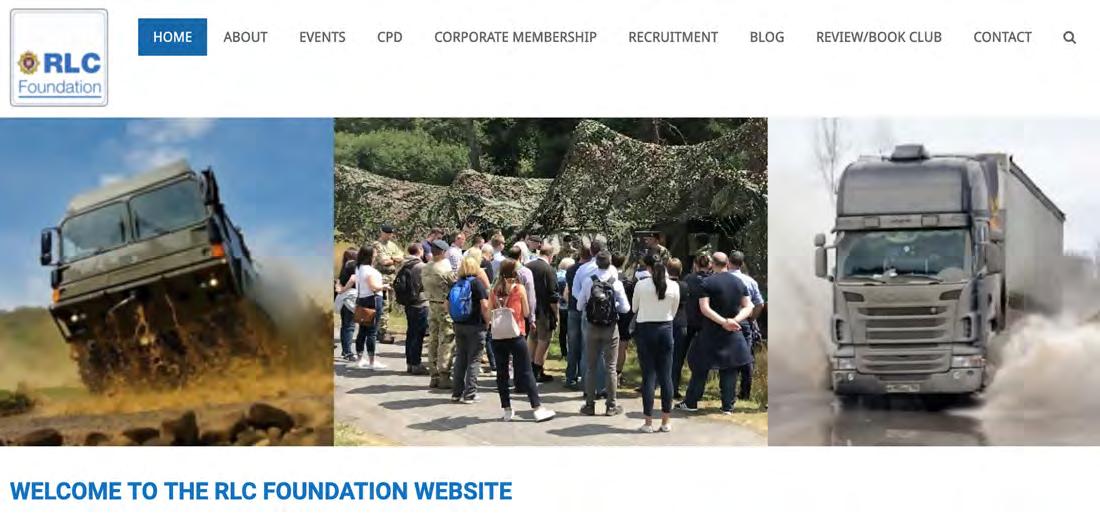


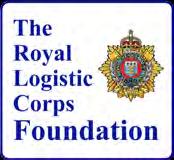
GENERAL INTEREST 8 THE ROYAL LOGISTIC CORPS FOUNDATION THE REVIEW 2024 | 79
http://rlcfoundation.com/ Follow The RLC Foundation on social media https://www.linkedin.com/company/royal-logistic-corps-foundation/ @RoyalLogisticCorpsFoundation
Should Royal Logistic Corps Units adopt a four-day working week?
In this article, Lieutenant Barney Lowe RLC argues that physical and mental wellbeing, productivity and output, would be improved within RLC Units by adopting a four-day working week. Simultaneously he considers some of the potential drawbacks and what mitigations could be put in place to address them. He also discusses a potential structure of a four-day week and what it might look like for an RLC Unit in camp; aiming to provide commanders with a variety of options they could implement to maximise the benefit to their workforce

A four-day working week is self-explanatory. For clarity however, and to provide a definition that will remain constant throughout this article, it involves people in an organisation working MondayThursday with Friday-Sunday being taken as a three-day weekend. Civilian organisations have begun to adopt the four-day working week at an increasing pace, after conducting trials (Financial Times, 2023, online), with academia producing studies analysing the potential benefits and limitations of its implementation. It is beginning to draw attention in the British Army too; with the King’s Royal Hussars adopting Work From Home Friday – a variation of the four-day week, whereby soldiers can complete basic administrative tasks from home without having to come into work.
These tasks include ensuring their MyDrive is up to date and providing evidence of them doing PT on a Friday. 14 Signal Regiment have also implemented a four-day working week with positive feedback from across the Unit. Debate over the length of the working week has been going on for decades, with Henry Ford pioneering the five-day - 40-hour - working week in 1926 to reduce worker turnover and skill loss, which was costly to replace. Now, discussion around the four-day working week shows a natural progression taking place over time; whereby the length of the standard working week is being shortened.
Firstly, there are tangible mental and physical health benefits involved with moving towards a fourday week, that have been observed by numerous studies. Pencavel (2016, page 21) finds that long working hours create fatigue within workers and that with insufficient time off, workers cannot recover before the start of their next working week. He also finds a lag effect of a long working week; a week of
long hours and days worked may not have an effect until a week or two into the future, when ill-health and a reduction in productivity are noticed. So we may be damaging our future ability to work to a high standard by not creating conditions for recovery from work. Furthermore, Pencavel (2016) argues that the way to recover from work is by time not spent at work and that there is no substitute for this. When combined with time with family and physical exercise, this provides the ideal conditions for work recovery. If we apply this to a RLC context, many trades require physical exertion – think of a Driver servicing a vehicle or a Supplier moving items around a storehouse. The potential for physical and mental fatigue is high and therefore Service Personnel require sufficient time to recover from work, returning refreshed and ready for the next week. Furthermore, Bannai and Tamakoshi (2014, p.5) examined the health effects of working long hours and concluded that they are associated with depression, anxiety, and coronary heart disease. Müller, Tisch and Wöhrmann (2018) also found negative health consequences for German employees who worked long hours. These examples support the growing body of evidence that helps explain the negative health effects of long hours on employees. This suggests that we can better ensure the physical and mental health of our soldiers by reducing their working hours where possible, allowing us to become a more sustainable fighting force and operate more effectively in camp. If they are in better physical and mental health, it seems logical that there should be fewer Service Personnel taking sick days throughout the year. If The RLC is seen to be offering a shorter, but more productive working week, we can ensure the reputation of the Corps by signalling that we are looking after the physical and mental longevity of our soldiers. We could potentially improve our recruitment and retention if a shorter working week is implemented, allowing us to be at the forefront of Army employment policy and to better mirror civilian practices. One of the main benefits of the four-day week would be to those Service Personnel who have families. They could have Thursday evening at home with their children and take them to school on Friday. This would have the double effect of allowing Service Personnel to engage more with their family life to improve their mental wellbeing, while also allowing them to save on Friday childcare costs, helping to ease the burden of the increased cost of living.
8 GENERAL INTEREST 80 | THE REVIEW 2024 THE ROYAL LOGISTIC CORPS FOUNDATION
Secondly, there has been a lot of research done into how a shorter working week could affect productivity and output of workers, with a substantial amount of evidence pointing towards productivity and output receiving a boost from shortening the working week. However, not every study finds a positive relationship between reducing working hours and output. Macut (1974) surveyed a wide range of businesses in different industries, finding variation in the outcomes after a four-day week implementation. Some businesses increased output, some stayed the same and some decreased. This indicates that the type of industry may be a factor in how it might be affected by the four-day week, but we cannot ignore the way organisational change is implemented as vitally important to the outcomes achieved. Later in this article, different implementation strategies will be discussed to address this reality. One of the ways an increase in output is achieved is by cutting unnecessary activity that occurs during a typical working day such as personal activity. This can include, scrolling on mobile phones, social media use, internet browsing, long meetings, non-work conversations, and other unproductive office activity (Barnes, 2019-20, page 36). The incentive of a longer weekend would motivate Service Personnel to work efficiently to achieve the required output for the week. This carrot can be paired with a stick… If the necessary work is not achieved, then people will be in work on a Friday. This technique is used in the KRH and is in line with the Army Leadership Code – Apply Reward and Discipline. Furthermore, LaJeunesse (1999) argues that there are two main determinants of higher productivity and output amongst workers – higher wages and a shorter workweek. The Government approved a pay rise for Service Personnel as of August 2023. The RLC, could tap into the assumed resulting higher morale to increase efficiency and productivity even further by decreasing the number of days worked per week. This would signal to our people that we are thinking about their wellbeing, and I argue that it would bring an increase in motivation at work and therefore productivity. It is no secret that the UK struggles with its productivity measures compared to other European countries (Trading Economics, 10 Oct 2023, online) and scores below the European Union average. Encouraging a healthier relationship between Service Personnel and work will allow The RLC to take the lead on initiatives to try to increase productivity, ensuring we are at the forefront of employment practices of not only the British Army, but also wider British employers. It is also worth asking the question of how we could measure productivity and output in The RLC? It is sometimes difficult to quantify what we do; however, we could look at some ways of measuring output –vehicle availability, L1 (Level 1) servicing for Close Support/Transport Sqns, Issues and Receipts for General Support/Supply Sqns.
Taking a wider look at the evidence surrounding the four-day week and productivity, Ballard (2022, online) argues that there would be several benefits that directly impact productivity and output, the first being reduced absenteeism from employees. Within the context of the British Army, it could be assumed that a shorter working week will result in Service Personnel being better-rested and therefore less

likely to require sick days or time off due to mental health concerns. The other side of the coin is those who are not unwell but still take ‘sick’ days. In theory, a four-day working week should reduce the people doing this, as they may think that there is no point going sick because the benefit of them doing so is reduced. The simple mental shift on a Wednesday of only having one more day to push for the weekend instead of two could reduce the level of non-genuine absenteeism. If this is the case, it reduces the impact on those who are in work and leads to a more balanced workload, allowing Service Personnel to complete tasks to a higher standard and be more productive in their fewer tasks. Of course, there is always likely to be those who do not pull their weight, but there is evidence that a four-day working week with its positive behavioural influences, will reduce this occurrence. Christian (2022, online) of BBC Worklife also finds that the four-day working week reduces employee burnout. Reducing burnout will allow Service Personnel to be more productive for longer periods and represents a long-term strategy to maintain employee engagement with work. The pace of life at Regimental Duty is high, due to the range and tempo of tasks being given to RLC Units. Anything we can do to reduce burnout and aid productivity will aid RLC Units in maintaining and even increasing outputs whilst allowing us to support our dependencies more effectively over the long term.
Thirdly, the article will now address the potential limitations, pitfalls, and caveats of implementing a four-day working week and how they could be mitigated. One of the biggest risks when adopting a shorter working week is that an organisation must have sufficient technology and infrastructure to enable employees to achieve the same output in less time (Ballard, 2022). This could potentially impact RLC Units which do not have the required
GENERAL INTEREST 8 THE ROYAL LOGISTIC CORPS FOUNDATION THE REVIEW 2024 | 81
8 Evidence from a 4-day week trial showing the effect on productivity
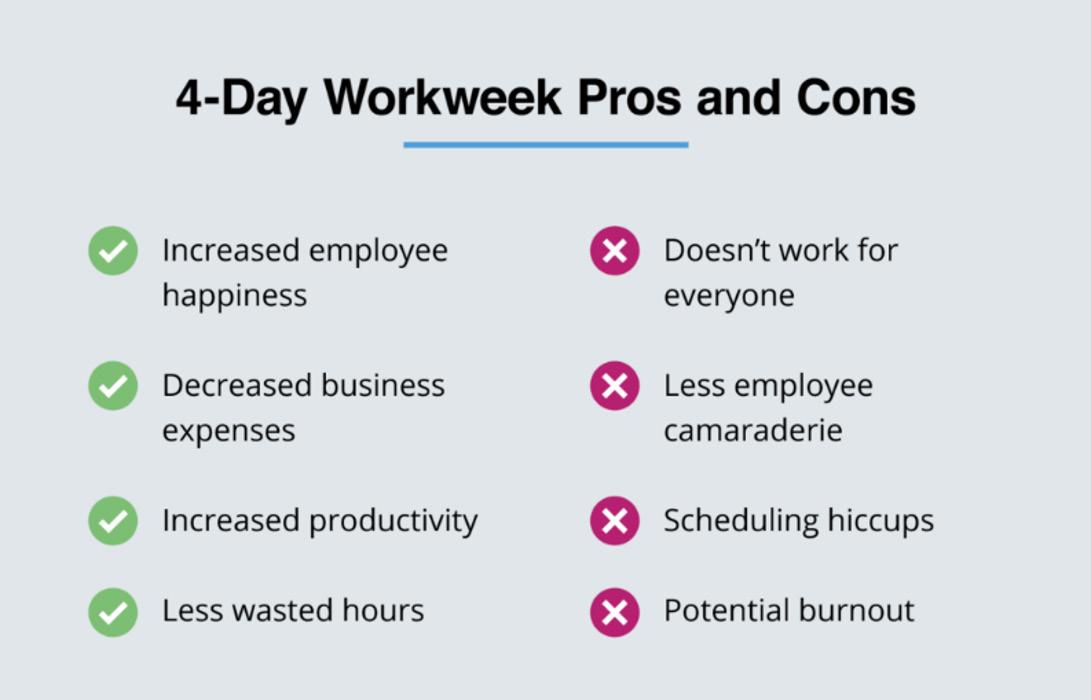
8 Potential positives and limitations of the 4-day week
infrastructure. Is the servicing bay big enough to enable more vehicle maintenance to be done simultaneously? Is the WIFI or Ethernet connection reliable enough that we do not have prolonged periods of lost connection? JAMES (Joint Asset Management Engineering Solutions) is taken down every Wednesday morning for maintenance, severely cutting into the work that can be done to vehicle fleets in that time. These are just a few of the issues that RLC Units may struggle with and may have to overcome to successfully implement a four-day week. Whilst there may be no easy or quick solutions to these problems, it will be possible to make do with the technology and infrastructure we have while simultaneously highlighting the requirement for better equipment and infrastructure. Additionally, there must be the correct workplace culture instilled at the same time as the shift to the shorter week. The working hours and days must be adhered to, otherwise other tasks could get in the way of Service Personnel’s rest and recovery time over the weekend and there would not be any material change in the work-life balance - defeating the point of implementing a shorter working week and cancelling any potential benefits. It would be the responsibility of commanders at every level to ensure employment pattern discipline over a modified work regime where the correct working hours and days are not deviated from. Unit culture may be slow to change and adapt to a four-day working week and it is unrealistic to expect it to happen rapidly. It is important however that it is consciously addressed by commanders and enforced at all levels. There can occasionally be a clear difference between official policy directives and the culture around working hours, with social norms potentially taking a long time to change and requiring consistent intervention and support from an organisation’s leadership at all levels. “Statutory norms must be enforced and the actors at different levels agree to transfer norms to normality” (Lehndorff, 2014, page 839). This evidence shows that a concerted, constant effort must be made to effectively adapt workplace culture to a fourday working week if the potential benefits are to be realised.
Some caveats to the four-day working week include operations and exercises where clearly Service Personnel will have to work until the necessary tasks
are complete, usually with much longer working hours than normal. However, this is a good thing; it prepares us mentally and physically for any transition to a future operational footing and should be encouraged, especially on exercise when Service Personnel must be challenged in a unique way. In a similar vein, other training and PT must remain challenging to build mental and physical resilience and ensure we are ready to operate in high stress situations. The four days in work should be hard graft as Service Personnel will have ample time to rest Friday-Sunday. This will also give people a feeling that they have ‘earned’ the longer weekend, contributing to higher levels of job satisfaction. Furthermore, some shift work will still have to be done, for example Guard Duty or Duty Supplier. This is unavoidable but Service Personnel should rotate back to the four-day week once their shift work is completed.
So how can RLC Units implement strategies that move it towards a four-day working week? There are several ways of shortening the working week, leaving Units with a choice as to how they go about it. The first strategy would be to slightly lengthen the normal working day to maintain the number of hours worked, justifying the scrapping of a working Friday. Units could work 0800 to 1700 Monday-Thursday with one hour for lunch. This would designate a working week of 32 hours but in a more compressed schedule, which would be more hours worked than under the current timetable at 1 Regiment RLC, which is 28.5 hours. The main risk involved in this strategy is that Service Personnel could experience some fatigue due to the longer working days, albeit they will have the ability to recover over the three-day weekend. There could be variations to this strategy and whether a 10hour day is always necessary can be left up to each Regiment. An eight-hour workday would still achieve 32 hours of work per week which is more than most Service Personnel currently work. Units could also maintain the same working timetable – maintaining the late start on Monday and early finish on the Friday, meaning that the number of hours worked per week would be 25, which allows for a sports afternoon on a Wednesday. This would cut 3.5 hours on Friday mornings. This is quite a small number of work hours, potentially affecting the quantity and quality of work that can be done, however with increased productivity as a side effect of a change to the length of the working week, it may be possible to achieve this work pattern.
To conclude, this article has discussed the potential benefits and limitations of RLC Units moving towards a four-day working week, as well as thinking about some implementation strategies. The four-day working week is by no means a silver bullet that will magically improve our lives, however, with the correct commitment and support from the Chain of Command and based on selected evidence; it could be argued that it represents an opportunity to improve the mental and physical wellbeing of our soldiers, improve output at work and improve retention and recruitment into The RLC. This strategy can also be tailored to each unit to suit their specific requirements and can even be changed over time to find the method that works best for them. Some patience and adaptation will no doubt be necessary;
8 GENERAL INTEREST 82 | THE REVIEW 2024 THE ROYAL LOGISTIC CORPS FOUNDATION
however, it is well worth trying to shorten the working week to reap the benefits discussed, while simultaneously working to mitigate the potential risks that come with it.
References
Bannai, A. and Tamakoshi, A., 2014. The association between long working hours and health: a systematic review of epidemiological evidence. Scandinavian journal of work, environment & health, pp.5-18.
Barnes, A., 2019. LABOUR WANES. RSA Journal, 165(4 (5580), pp.36-37.
https://www.statista.com/chart/28388/four-day-work-weektrial/
https://www.reed.com/articles/a-four-day-work-week-thepros-and-cons
https://www.ft.com/content/c8fba26c-326d-4053-9b3c59e06f0b31fb
https://tradingeconomics.com/country-list/ productivity?continent=europe
https://www.businessleader.co.uk/the-four-day-workingweek-a-worthwhile-experiment-for-employers/
https://www.bbc.com/worklife/article/20220322-therealities-of-the-four-day-workweek
number of work hours, potentially affecting the quantity and quality of work that can be done, however with increased productivity as a side effect of a change to the length of the working week, it may be possible to achieve this work pattern.
Current Workweek 4/40 Workweek Cut Friday (no adjustment)
Mon – 6.5 hrs
Mon – 8 hrs
Mon – 6.5
https://velocityglobal.com/resources/blog/4-day-workweekpros-cons/
LaJeunesse, R., 1999. Toward an efficiency week. Challenge, 42(1), pp.92-109.
Lehndorff, S., 2014. It's a long way from norms to normality: The 35-hour week in France. ILR Review, 67(3), pp.838863.
Macut, J.J., 1974. Measuring productivity under a 4-day week. Monthly Labor Review, pp.55-56.
Müller, G., Tisch, A. and Wöhrmann, A.M., 2018. The impact of long working hours on the health of German employees. German Journal of Human Resource Management, 32(34), pp.217-235.
8 Breakdown of current vs possible workweeks
To conclude, this article has discussed the potential benefits and limitations of RLC Units moving towards a four-day working week, as well as thinking about some implementation strategies. The four-day working week is by no means a silver bullet that will magically improve our lives, however, with the correct commitment and support from the Chain of Command and based on selected evidence; it could be argued that it represents an opportunity to improve the mental and physical wellbeing of our soldiers, improve output at work and improve retention and recruitment into The RLC. This strategy can also be tailored to each unit to suit their specific requirements and can even be changed over time to find the method that works best for them. Some patience and adaptation will no doubt be necessary; however, it is well worth trying to shorten the working week to reap the benefits discussed, while simultaneously working to mitigate the potential risks that come with it.
Pencavel, J., 2016. Recovery from work and the productivity of working hours. Economica, 83(332), pp.545-563.
References
• Bannai, A. and Tamakoshi, A., 2014. The association between long working hours and health: a systematic review of epidemiological evidence. Scandinavian journal of work, environment & health, pp.5-18.
• Barnes, A., 2019. LABOUR WANES. RSA Journal, 165(4 (5580), pp.36-37.
• https://www.statista.com/chart/28388/four-day-work-week-trial/
• https://www.reed.com/articles/a-four-day-work-week-the-pros-and-cons
• https://www.ft.com/content/c8fba26c-326d-4053-9b3c-59e06f0b31fb
• https://tradingeconomics.com/country-list/productivity?continent=europe
• https://www.businessleader.co.uk/the-four-day-working-week-a-worthwhileexperiment-for-employers/
• https://www.bbc.com/worklife/article/20220322-the-realities-of-the-four-dayworkweek
• https://velocityglobal.com/resources/blog/4-day-workweek-pros-cons/
• LaJeunesse, R., 1999. Toward an efficiency week. Challenge, 42(1), pp.92-109.
• Lehndorff, S., 2014. It's a long way from norms to normality: The 35-hour week in France. ILR Review, 67(3), pp.838-863.
• Macut, J.J., 1974. Measuring productivity under a 4-day week. Monthly Labor Review, pp.55-56.






GENERAL INTEREST 8 THE ROYAL LOGISTIC CORPS FOUNDATION THE REVIEW 2024 | 83
5
hrs Tue
7.5 hrs Tue – 8 hrs Tue – 7.5 hrs Wed – 3.5 hrs Wed – 8 hrs Wed – 3.5 hrs Thu – 7.5 hrs Thu – 8 hrs Thu – 7.5 hrs Fri – 3.5 hrs Fri - Off Fri – Off Total – 28.5 Total – 32 hrs Total – 25 hrs
–
Figure 3 – Breakdown of current vs possible workweeks
Follow #BRITISHARMYLOGISTICS on Social Media @TheRoyalLogisticCorps royallogisticcorps @UKArmyLogistics The Royal Logistic Corps The Royal Logistic Corps - World-class Innovative Adapatable
The Prince Consort’s Library
Tucked away in its own grounds in Aldershot, is the Prince Consort’s Library. Opened in October 1860, it has now been serving the information needs of the Army for over 160 years

As part of a series of Army reforms following the Crimean War, and a desire to improve the education of Army officers, the establishment of the library was initiated and funded by HRH Prince Albert, the Prince Consort.
The building was designed by Captain Francis Fowke of the Royal Engineers, whose portfolio of architectural work includes art galleries in Dublin and Edinburgh, the Victoria and Albert Museum and the original plans for the Royal Albert Hall. The original collection of 2,000 handsomely bound books was provided by Prince Albert and the library proudly bears his name to this day.
Initially established for the use of army officers, the library extended its customer base to include all ranks and, as part of the Army Library and Information Service (ALIS), now supports the information needs of all the British Armed Forces and MOD civil servants at home and overseas. Its collection of c.70,000 books and journals are available to assist with professional development assignments, be they part of sponsored courses such as AHEP, JOLP, MA (A) & (B), JCSC, ICSC, LEOC, ALDP, DLSC or any other research requirements. Books can be borrowed and sent direct to home or work locations, including MOD overseas locations. Articles from a broad range of publications and journals can also be sent out by email on request. The ALIS Online facility on the Defence Gateway offers serving members of the Army access to online
databases such as Janes and Stratfor, a collection of over 4,000 e-books, and a myriad of full-text articles provided by Ebsco and ProQuest, plus the ability to request items directly from the ALIS catalogue.
Dedicated to the professional interests of the UK’s Armed Forces, subjects covered by the Prince Consort’s Library include: military history (ancient to contemporary conflicts), strategy, operations, tactics, foreign armed forces, technology (including a range of weapon systems, drones and cyber) and specialist studies in urban warfare, terrorism, asymmetric warfare, international relations and a broad range of military biographies. The library also has an extensive collection of regimental histories, a full set of Army Lists dating back to 1759 and numerous sets of government published official histories.
If specific country information is required, then staff at the Prince Consort’s Library specialise in producing bespoke study/information packs on request. Compiled from a range of electronic sources, these packs cover military, political, social, geographical and economic information and can be emailed directly to customers. Allied to these are the weekly ALIS Country News Updates, providing current global news stories on 25 countries.
As well as providing an information service to customers in-person or remotely, the Prince Consort’s Library also offers a place for quiet study or as a venue for meetings, course debates, unit away days or regimental photographs.
The Prince Consort’s Library can be contacted by email at ALIS-PCL-GroupMailbox@mod.gov.uk or by phone on 01252 340094

8 THE PRINCE CONSORT’S LIBRARY 84 | THE REVIEW 2024 THE ROYAL LOGISTIC CORPS FOUNDATION


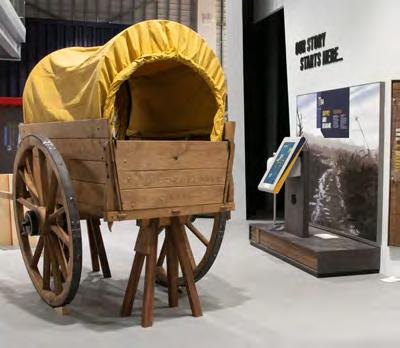
THE RLC MUSEUM NEEDS YOU New Exhibition
‘Maternity in the Military’
The RLC Museum is seeking stories and objects from former and serving members of The RLC to bring to life the changing face of British Army maternity policy in a new exhibition.
Prior to 1990 pregnant servicewomen wishing to have their child had to leave the forces, and many women made difficult choices between career and children. Following the introduction of maternity leave for servicewomen, the Army has developed its maternity, shared parental and adoption leave polices, and redesigned its maternity wear several times
The new exhibition, opening later this year, will tell the stories of the servicewomen who had to choose between parenthood and their profession, the development of army maternity packages and the experiences of army parents to the present day
The Museum wants to hear from you! Can you share your experience as a servicewoman making decisions involving family and work? Your experience as a pregnant servicewoman? Your experience as a new mother from a military background? Or your experience as a military parent (of any gender) and early parenthood?
Loans or donation of objects for the exhibition, including (but not limited to) maternity uniform, documents, photographs and letters are also gratefully received; and any cap badge is welcome.
If you have anything that may be of interest please email us at: information@rlcmuseum.com or scan the QR code to complete an online form before 9th June 2024

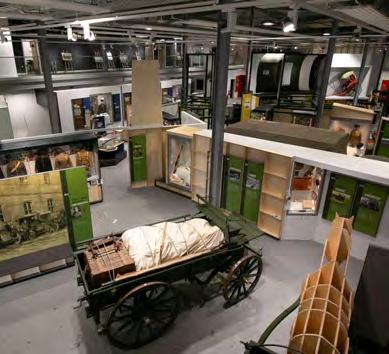

royallogisticcorps.co.uk /museum
Down, Winchester, SO21 2RG
793
Tuesday – Saturday 09:30 – 16:00 Worthy
01962 887

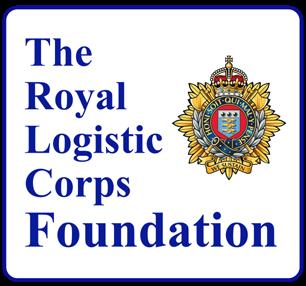
To ensure that the British Army is not out-fought in any future conflict, HMG directs resources to help deliver the means for conducting successful operations. To ensure that the Army is not outthought however requires a different strategy. Whilst every effort is provided to deliver comprehensive functional, operational and tactical training, it is incumbent that all ranks develop a personal interest in their chosen profession. For those wishing to improve their professional knowledge and communication skills, this reading list, sponsored by the RLC Foundation, has been carefully selected to help guide an informal, yet comprehensive self-study programme. These thought-provoking publications and multi-media products have been chosen to develop critical analytical skills by offering entry points to a broad range of topics categorised into pertinent themes. The list is not, and cannot be exhaustive, but to remain relevant, it will be reviewed annually. To ensure this, selected members of The RLC from across the ranks, academia and industry will be invited to publish regular book reviews throughout the year on the RLC Foundation website and in the annual RLC Foundation Review. Publications which attract positive, critical acclaim, will be considered for inclusion on the List. To this end, the Foundation welcomes suggestions for new submissions. The vast majority of the listed publications can be obtained on loan to serving and retired personnel from The Prince Consort’s Army Library in Aldershot. I commend this learning opportunity to every member of the RLC.
Strategy
5 Another Bloody Century: Future Warfare. C.S. Gray. (2005). An examination of potential future conflicts and defence policies that could address them.
5 Makers of Modern Strategy from Machiavelli to the Nuclear Age. P. Paget, G.A. Craig & F. Gilbert. (1986). A series of essays that analyse war and its strategic characteristics over the past five centuries.
5 Strategy: A History. L. Freedman. (2013). Describes what strategy is through historical analysis and a broad examination of all the facets related to strategies and its implications on the balance of power.
5 The Dragons and the Snakes. D. Kilcullen. (2020). Examines what, opponents of the West have learned during the last quarter-century of conflict.
5 Some Principles of Maritime Strategy. J. Corbett. (1911). Establishes the theory of war, and then
Master General of Logistics: Professional Reading List
the theory of naval war: from grand strategy to strategy utilising Britain as a case study.
5 The Future of Power. J.S. Nye. (2011). Examines what it means to be forceful and effective in a world in which the traditional ideas of state power are being challenged by technology, and rogue actors.
5 The Tragedy of Great Power Politics. J.J. Mearsheimer. (2011). Argues that due to the anarchic nature of the international system, states are consigned to focus on self-interest using a competitive philosophy of offensive realism.
5 Politics Among Nations: The Struggle for Power and Peace. H.J. Morgenthau. (2006). Introduces the concept of political realism, presenting a realist view of power politics focusing on US foreign policy.
5 The World America Made. R. Kagan. (2012). Advocates that the US should maintain its superpower status by continuing to lead the world order for the good of global democracy.
5 The Evolution of Strategy. B. Hauser. (2010). A history of strategic thinking from the Romans to the twenty-first century, it provides vital detail for strategic studies and debates on international security.
5 The Utility of Force. R. Smith, (2005). Offers a blueprint for how best to apply military force by describing how politicians have failed to apply its application in the past.
5 The Internationalists: And their Plan to Outlaw War. O. A. Hathaway and S. J. Shapiro. (2017). Examines the origins of the current international legal order and why war remains a rational option in the anarchic international system.
Leadership/Management
5 South. E. Shackleton, (1919). Describes the challenges of leadership in one of the most demanding, non-combative environments during the Imperial Trans-Antarctic Expedition of 1914 to 1917.
5 Defeat into Victory. W. Slim. (1956). Leadership and management lessons, primarily from command experience, gained from one of the most challenging campaigns of WW2.
5 British Generals in Blair’s War. J. Bailey. (2013). A series of first-hand testimonies about Britain’s involvement in recent campaigns by senior participants.
5 The Mask of Command. J. Keegan. (1987). From defining leadership to identifying what makes a great military leader, four commanders are chosen as case studies.
5 Command: The Politics of Military Operations from Korea to Ukraine. L Freedman. (2022).
8 MGL's READING LIST 86 | THE REVIEW 2024 THE ROYAL LOGISTIC CORPS FOUNDATION
An examination of the political and operational considerations that determine the effectiveness of command against the ever-changing character of conflict.
History/Military History
5 Sapiens: A brief history of Humankind. Y. Harari. (2011). A brief history of humankind from the evolution of archaic human species in the Stone Age up to the twenty-first century, focusing on homo sapiens.
5 Battle Cry of Freedom. J.M. MacPherson. (1988). Possibly the best one volume account of the American Civil War.
5 The Face of Battle: A Study of Agincourt, Waterloo and the Somme. J. Keegan. (1976). Conveys the brutal reality for the participants of three major battles.
5 All Hell Let Loose: The World at War 1939-1945. M. Hastings. (2011). A general history of the war examining the main strategic challenges using the experiences of the personalities from premiers to privates. Published in the US under the title, Inferno.
5 The Storm of War: A New History of the Second World War. A. Roberts. (2009). A narrative on the evolution of Allied strategy through an examination of all fronts.
5 The Liberation Trilogy: R. Atkinson. A series of authoritative accounts of the US forces in Europe.
# An Army at Dawn: The War in North Africa, 1942-1943 (2002).
# The Day of Battle: The War in Sicily and Italy, 1943-1944 (2007).
# The Guns at Last Light: The War in Western Europe, 1944-1945 (2013).
5 The Pacific War Trilogy. I.W. Toll. A comprehensive history of the Pacific War from across all three environments.
# Pacific Crucible: War at sea in the Pacific, 19411942 (2011).
# The Conquering Tide: War in the Pacific Islands, 1942-44 (2015).
# Twilight of the Gods: War in the Western Pacific 1944-1945 (2020).
Regional Studies/International Relations
5 The Rise and Fall of the Great Powers, P. Kennedy. (1987). Explores the politics and economics of the Great Powers from 1500 to 1980 and the reason for their decline.
5 Dark Continent: Europe’s Twentieth Century. M. Mazower. (1998). Questions the validity of liberal democracy in Europe since 1900 by comparing it with communism and fascism.
5 A Line in the Sand: The Anglo-French Struggle for the Middle East, 1914-1948. J. Barr. (2011). Traces the clandestine diplomatic agreement between Britain and France over the division of the Middle East and their subsequent three decades of competition.
5 Lords of the Desert: Britain’s Struggle with America to Dominate the Middle East. J. Barr. (2018). Describes the twenty-five years of UK/US competition in the Middle East.
5 Prisoners of Geography: Ten maps that tell you everything you need to know about global politics.
T. Marshall. (2015). An explanation why all leaders are constrained by geography.
5 The New Silk Roads. P. Frankopan. (2019). Describes how ties along the Silk Roads have tightened between Russia, the Middle East and China while the West increasingly looks to isolationism for security and power.
5 World Order. H. Kissinger. (2014). Maps the evolution of the great states and empires and describes how they shape present day global relations.
5 Flashpoints: The Emerging Crisis in Europe. G. Friedman. (2016). Focusing on geopolitical fault lines in Europe, a thesis is presented about the likeliest locations for future eruptions.
5 Sleepwalkers: How Europe went to war in 1914. C. Clark. (2012). Presents a case on how Europe entered into the war to end all wars.
5 The Retreat of Western Liberalism. E. Luce. (2017). Offers an opinion on the dangers that the West faces in the modern world.
Profession of Arms
5 Quartered Safe Out Here. G. MacDonald Fraser. (1993). Perhaps the British equivalent of Sledge’s, With the Old Breed. A depiction of the Burma Campaign from the front-line in all its life and death struggles.
5 With the Old Breed. E. Sledge. (1981). The hard-bitten personal experiences of a US marine fighting on the islands of Peleliu and Okinawa.
5 Learning to eat soup with a knife. J. A. Nagi. (2002). An examination of how armies adapt to changing circumstances during the course of conflicts for which they are initially unprepared.
5 Blitzkrieg to Desert Storm: The Evolution of Operational Warfare. R. M. Citino. (2004). From its baptism in Europe during WW2, the application of operational warfare from the second half of the 20th Century to Desert Storm is critically examined.
5 Nemesis: The Battle for Japan, 1944-45. M. Hastings. (2016). Provides a sound overview of the operations and killing grounds from South East Asia to the Pacific. It reveals the fracture lines between the Services on both sides, and the duplicity between British/Commonwealth and US strategies.
5 Brute Force: Allied Strategy and Tactics in the Second World War. J. Ellis. (1990). Focuses on the economic dimension of WW2 and posits that the Allied victory was influenced more by their ability to overmatch the Axis Powers economically than any other factor.
5 Defence Procurement Vols 1 and 2. D. Moore. (2011 and 2014). A series of case studies examining Defence procurement.
5 The Right of the Line. J. Terraine. (1988). An examination of the RAF’s contribution during WW2 from its structures to strategies and the key personalities.
5 The Rise and Fall of British Naval Mastery. P. Kennedy. (1976). Sets British naval history within the context of international relations, offering an insight into the future of the Royal Navy within HMG strategic policies.
5 Engineers of Victory: The Problem Solvers who turned the tide in the Second World War. P. Kennedy. (2013). Describes the science,
MGL's READING LIST 8 THE ROYAL LOGISTIC CORPS FOUNDATION THE REVIEW 2024 | 87
management and luck that delivered the means for the Allies to fight WW2 from the Battle of the Atlantic to the assault on Northwest Europe.
5 Amphibious Operations: The Projection of Sea Power Ashore. M.H.H. Evans. (1990). An analysis of amphibious operations and planning factors, utilising historical case studies.
Military/Commercial Logistics
5 Alexander the Great and the Logistics of the Macedonian Army. D.W. Engels. (1980). Proof that logistic considerations are timeless, the effects of terrain, climate and supply on an expeditionary land army are explained from first principles. From these considerations the needs of an army and the relationship of supply to strategy are exposed.
5 The Lifeblood of War J. Thompson. (1991). A study of how selected campaigns are influenced by logistics.
5 A War of Logistics: Parachutes and Porters in Indochina, 1945-1954 C. R. Shrader. (2015). An in-depth study into the demise of the French in Indo China and the influence of logistics.
5 The First Helicopter War: Logistics and Mobility in Algeria, 1954-1962. C.R. Shrader. (1999). Describes in detail how the French defeated the Algerian rebels on the battlefield through superior logistics, but eventually lost the diplomatic war.
5 The Withered Vine: Logistics and the Communist Insurgency in Greece, 1945-1949. C. R. Shrader, (1999). A detailed explanation of how the Greek National Army defeated the Greek Communist Party and the vital influence of logistics in the campaign.
5 Supplying War. M. van Crefeld. (1977). An examination of logistics using a wide range of case studies.
5 Feeding Mars, Logistics in Western Warfare from The Middle Ages to the Present. J.A. Lynn. (1993). A series of essays which explains the importance and challenges of delivering logistics to western armies by examining all the major logistic functions.
5 For Want of a Nail: The Impact on War of Logistics and Communications. K.J. Macksey. (1989). A broad overview of logistics from the Crimea to the first Gulf War.
5 The Box: How the Shipping Container Made the
World Smaller and the World Economy Bigger. M. Levinson. (2006). Charts the rise of the ubiquitous intermodal container and how it changed international economics.
5 Operations Management (7th Edition). N. Slack. (2013). An introduction to modern Operations Management.
5 Logistics: The Key to Victory. J. Black. (2021). Published as ‘a world history of logistics,’ readers will no doubt rightly assume that no single volume can fulfill such an assertive declaration. Recognising this oversight, the volume is still a useful addition to any logistician’s bookshelf with an overview of selected key conflicts and their associated logistic challenges.
5 Material World: A Substantial Story of Our Past and Future. E. Conway. (2023). An entertaining and thought-provoking examination of six of the most crucial substances in human history and how their supply chains work – and why they sometimes don’t!
Fiction
5 HMS Ulysses. A. MacLean. (1955). A story of human endurance and courage on a Murmansk convoy.
5 The Naked and the Dead. N. Mailer. (1948). Arguably the greatest novel depicting ground combat in the Pacific during WW2. Its graphic descriptions resulted in the book almost being banned in the UK.
5 For Whom the Bell Tolls. E. Hemingway. (1940). The story of a US volunteer attached to a Republican guerrilla unit during the Spanish Civil War.
5 Catch-22. J. Heller. (1961). Describes the insanity of war through the experiences of a US bombardier torn between the catch of duty or personal survival.
5 From Here to Eternity. J. Jones. (1951). The story of a US infantry company stationed in Hawaii prior to the attack on Pearle Harbor.
5 The Thin Red Line. J. Jones. (1962). A novel based on the author’s experiences of combat during the Guadalcanal campaign.
5 All Quiet on the Western Front. E. Remarque. (1929). A story told from the German perspective of the physical deprivations and mental stress caused by combat in WW1 and the challenges of returning home.
8 MGL's READING LIST 88 | THE REVIEW 2024 THE ROYAL LOGISTIC CORPS FOUNDATION
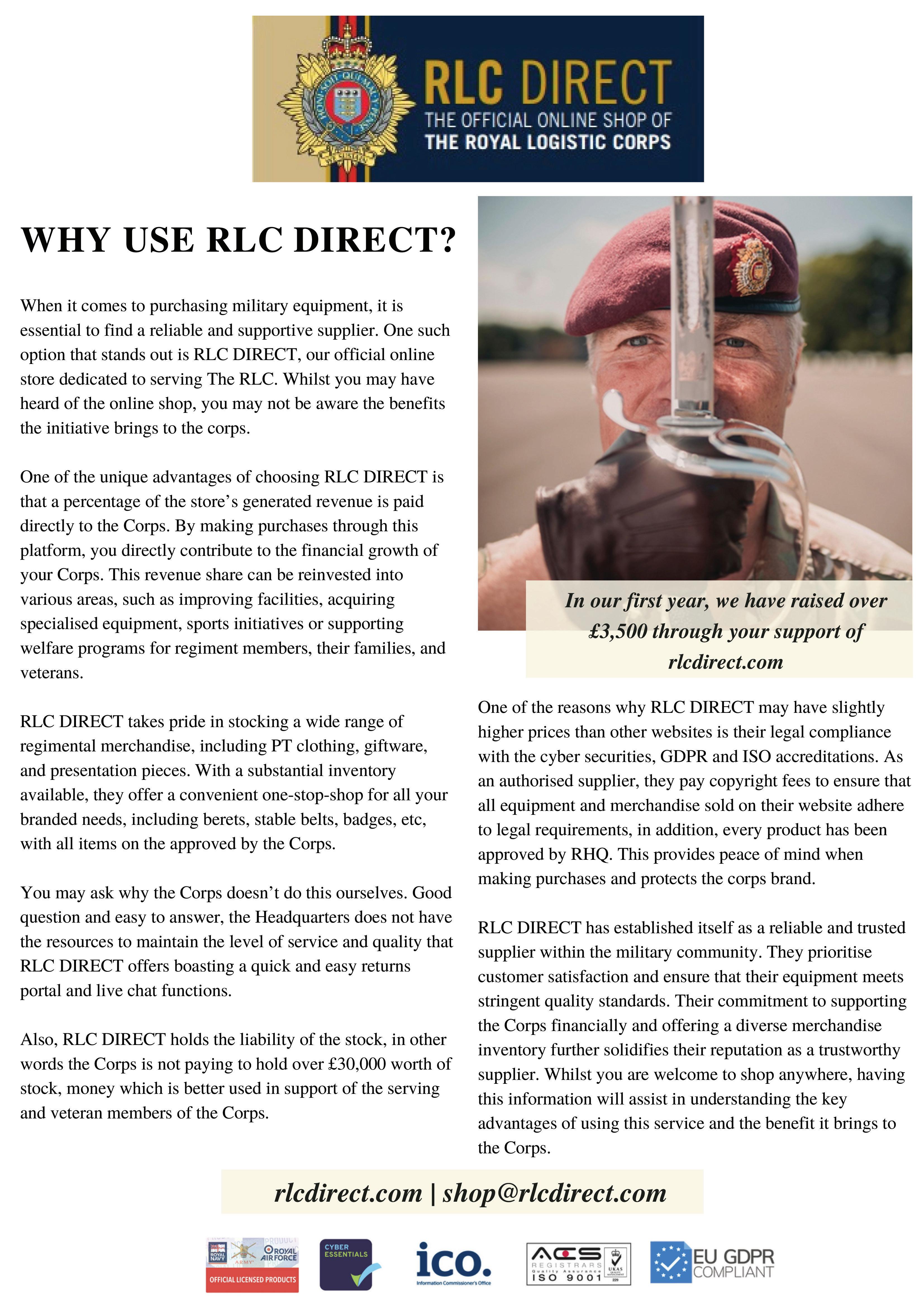

RLC Foundation Book Club
This Review’s Book Club comes in three distinct parts; the first is an overview by Dr Thomas-Llewellyn on Artificial Intelligence (AI), its potential uses, abuses and some of the cornerstone literature that continues to stir the contemporary debate. The second part is made up with reviews of three very different books. Examined in chronological order, the first two are assessed by this year’s best article prize winner; Major Colin Taylor RLC. The books span the geo-political arena, examining the fickle world of grand strategy and decision making which led to the first total war, followed by an individual’s experience of war from the ground, offering insights into the character of the second total war. The last book review, is of a recent publication by General David Petraeus and Andrew Roberts, tracing the evolution of warfare using selected conflicts from 1945 to the current war in Ukraine. Finally, the Foundation Book Club offers some interesting titles of future publications planned for release in 2024.
Artificial Intelligence (AI): Don’t Worry About Tomorrow – It’s Already Here!
By Dr Jacob Thomas-Llewellyn, University of Reading
to dissect the sophisticated elements of AI systems and their influence on politics, economics, medicine, social structures and culture across the globe. His predications that AI will discover revolutionary drugs, improve the efficiency of industry and design new means of generating sustainable sources of energy, are tempered with some stark warnings. With computer systems and their data collection programs becoming ever more sophisticated, Suleyman asks, ‘how intelligent will AI become?’

In an interview with the journal Strategy & Leadership in 1999, the futurist, Alvin Toffler was asked, “What will society and the economy be like in the twentyfirst century?” Toffler believed that humanity would enter a new era, “fundamentally different from just about everything we’ve known…What we’re living through is the rapid emergence and spread of a whole new way of life and a totally new way of creating wealth.”1 Whilst many of Toffler’s original forecasts (some dating back to the early 1980s) regarding the progress of human activity have been the subject of debate, critiques and re-evaluations, it is uncanny that in the shadow of the Covid pandemic, and the emergence of sophisticated AI platforms, many of his seemingly science fiction based predictions featured in his The Third Wave; A Classic Study of Tomorrow (William Morrow, 1984), are becoming reality. It is perhaps natural for humans to fear what they do not understand, even more so when they believe they lack the agency to control change. The subject of AI is now dominating discussions in governments, universities, schools and across global social media. Whilst many may hail these artificial innovations as a move towards a more enlightened and efficient world, with promises of untold benefits for humankind, they inevitably have their fair share of critics and detractors. In The Coming Wave: AI, Power and the 21st Century’s Greatest Dilemma (Broadley Head, 2023), Mustafa Suleyman provides a candid assessment of the current state of AI and its potential future development. In unison with an in-depth study of AI systems, Suleyman explores the role of synthetic biology (SB) and warns readers of the potential dangers humanity may face in the present and near future.
As the co-founder of the artificial research laboratory; DeepMind, Suleyman is well positioned
What is perhaps most troubling when reading Suleyman’s work is the fundamental absence of credible proposals for safeguarding against the potential over-reliance, exploitation or misuse of AI systems. As Professor Scott Shapiro acknowledged, The Coming Wave provides an array of doomsday predictions, but is lacking in viable mechanisms to limit its intrusion. Suleyman’s limited stock of solutions are confined to the end of his work and are, as Shapiro noted, “unfortunately not reassuring.”2 With Toffler’s prophecy in mind, it should be recognised that whilst Suleyman has come to dominate discussions on this subject, the debate around AI’s potential is not a new topic. In 2013, James Barratt delivered his seminar work, Our Final Invention: Artificial Intelligence and the End of the Human Era (Thomas Dunne Books, 2013), leading Matt Miller of The Washington Post, to declare that, “If you read just one book that makes you confront scary hightech realities that we’ll soon have no choice but to address, make it this one.”3 Barratt has previously drawn upon the work of Ray Kurzweil who, in 2006, released, The Singularity is Near: When Humans Transcend Biology (Viking, 2005), identifying a clear demarcation from previous ages which, according to Miller, is bringing us ever closer to, “meshing with computers and transcending human biology.”4

It is now generally accepted that it is inevitable that AI systems will gradually dominate many aspects of our everyday lives - in many respects, they already do. Internet search suggestions, personalised product promotions based on captured keystrokes, automated reminders aligned to known annual activities and the algorithms which control the room temperatures and lights in our homes are now embedded into our routines. The very products we purchase online are controlled in transit by an army of data banks, determining when, where and how they will be distributed, whilst providing customers with highly precise tracking information 24/7.
Never has a species possessed the knowledge and means to supplement so many of its own activities with that of an artificial other. The shocking warning of Dr Geoffrey Hinton, the heralded ‘Godfather of AI’, may have convinced many that a system which has the ability to learn, and even develop, the capability to be self-aware, bodes ill for humanity.5 The inconvenient truth is that Hinton may be right. With
8 RLCF BOOK CLUB 90 | THE REVIEW 2024 THE ROYAL LOGISTIC CORPS FOUNDATION
all the potential dangers and pessimistic predictions now circulating however, it is perhaps prudent to acknowledge the potential benefits of AI, especially at a time when humanity is struggling to address the self-inflicted degradation of our environment.
Rather than imagining a dystopian brave new world, dominated by unassured machine learning, there is evidence that AI systems are having a positive impact. The breadth and scale of these benefits seem limited only by our imagination and willingness to safely implement the necessary changes. Indeed, it is challenging to envisage any credible approach to dealing with some of the immediate global issues we are compelled to address, such as climate change and global health, without the aid of AI. In some of the most remote regions of Nigeria for example, new mothers are benefitting from complex systems analysis - aiding the fight against malaria and smallpox. At present, approximately 2,500 children in Nigeria die each day due to the restrictions in accessing vaccination centres.6 Vaccination records have traditionally been paper based and for isolated rural communities it has been almost impossible for government agencies to maintain and monitor a credible vaccination policy. With the advent of the new Vaccination Tracking System (VTS), both expectant and new mothers can now access a specially tailored virtual health adviser. AI systems not only ensure records can be conveniently accessed by Nigeria’s health authorities, but the software being deployed also predicts potential barriers to uptake in immunization. Those mothers unable to access medical centres, are automatically prioritised by VTS and are granted access to the Online Education-Health Application, home visit bookings and travel vouchers. As a result of VTS’s rollout, annual vaccination rates in Nigeria have been boosted from 40% to 75%7, underpinning the nation’s health security. Such a project demonstrates that AI can effectively reduce the burdens of record keeping, whilst at the same time identifying those communities and individuals at most risk through the rapid analysis of selected variables.
Whilst the immediate benefits of AI may seem to outweigh potential negatives, there are clearly questions that need to be addressed in the realm of security and data protection. As AI programs become embedded in government departments, universities and defence organisations, there will inevitably be a requirement to develop assurance regimes. In 2023, it was calculated that global cyber-attacks were responsible for causing $10.5 billion in damages. As a countermeasure, organisations spent over $150 billion. To combat an explosion in the sharing of AI based cyber-attack packages, only one UK based firm; Darktrace, is harnessing the power of AI to create an “unsupervised” security system which automatically assimilates clients’ needs, identifying anomalies, potential threats and security solutions.8 The paradox is that whilst AI has the potential to deliver great benefits, and the tempo of its adoption is increasing, we desperately need AI based security software, which is still in its infancy, carries a substantial price tag and will lag further without significant investment.
A changed society
An important consideration when examining the future trends in AI are the profound, yet, seemingly
unconnected, changes taking place across society. In a post-covid world, greater portions of the global population are now working from home or through hybrid routines. Parallel with this, is the expansion of the gaming industry and its impact on the interactions between humans. In the aftermath of WW2, 98% of men in the US aged between 25-54 were in fulltime employment. In 2016 this figure had fallen to 88%. On the eve of the COVID pandemic, low skilled male workers across the US were spending between 12-30 hours a week immersing themselves in the world of gaming. Platforms such as Steam, experienced significant uptake in their online community membership and games including Elder Scrolls, Fallout, Rage and Total War, to name but a few, have helped create complex global gaming communities which allow players to retreat from physical societal interactions to a virtual world. These seemingly unrelated, albeit nuanced, phenomena, are actually important in understanding the debates surrounding AI.
Through the growing adoption of home working regimes and widespread global interaction through gaming, humans, especially those under the age of thirty, have demonstrated a growing trend to retreat from traditional forms of societal interaction, with a corresponding increase in their dependence on virtual societies. It is this virtual dependency that is open to exploitation through AI programs. Perhaps the remarks of Martin Ford are prescient when he envisaged only two roads which lay ahead for humans when dealing with AI. One route may lead to a utopian world where certain, mundane jobs, may be replaced by computer-based robots. Given that upward of 50% of the US population have been employed in positions which are, according to Ford, “fundamentally routine and predictive in nature” – AI may hold the potential to provide fully automated solutions. With greater liberty (through more available time), society might then be able to focus its efforts upon improving education, enhancing renewable energy systems and addressing inequality. If AI is allowed to flourish, PwC has predicted that by 2030, such advances could contribute $15.7 trillion to the global economy.9 On the flip side, Ford also presents a rather different vision of this virtual society – a dystopian one, where machines and algorithms govern our every decision and even make humans subservient to AI systems. Acknowledging these two potential scenarios, the immediate question for humankind is, how much risk are we prepared to take with AI’s adoption? In a competitive, increasingly polarised and virtual society, it seems that gradual adoption is out of the question. Yet, identifying assured step-changes of AI assimilation remains challenging.
In an effort to mitigate the potential risks of AI, the international community are now considering restrictions, safeguards and key tests; which may provide some measure of control over AI’s expansion.10 However, as the development of AI gains tempo, there is always the potential that states will be drawn into an ‘AI Arms Race” and will seek to undermine potential competitors. Kenneth Payne has acknowledged that whilst humans have delivered several technological revolutions in the past, including gunpowder, nuclear weapons and the internet, in comparison, AI promises to be far more challenging when trying to control its application.
RLCF BOOK CLUB 8 THE ROYAL LOGISTIC CORPS FOUNDATION THE REVIEW 2024 | 91
Payne concluded that, “AI is more than just another information processing tool… It will be making strategic decisions on our behalf and enacting them autonomously on the basis of calculations that are not human… Machines do not employ the cognitive heuristics that inform our decisions [and] while machines will certainly be acting to fulfil our goals, something will inevitably be lost in translation.”11 Perhaps we need to adopt a default risk setting where we should only be worried when a digital application asks, ‘are you a robot?’, quickly followed with an automated supplementary question of, ‘if not, why not?’ – then you know, we are all in trouble!
A bright or blight future?
When considering AI, humans bring their own prejudices. There is however, as Professor Eleni Vasilaki observed, “no ghost in the machine.”12 Just as humans learn by a process of socialisation, retaining information and reflecting on experiences, so too do AI systems hold the potential to acquire knowledge and, perhaps in the not-too-distant future, think for themselves. Perhaps what we should be asking is which actor in this relationship will pose the greatest danger. As AI develops, humans will inevitably imprint on the systems they create. Is our greatest fear therefore that AI software will simply reflect our true selves (the good, together with our imperfections), or worse; that it will learn from our mistakes and perhaps, using unprejudiced AI logic, modify solutions to deliver what it considers better outcomes? Naysayers might doubt the possibility of AI meeting the criteria of the Turing Test13, but as history demonstrates, humans repeatedly underestimate the potential of technology, only to be proven wrong - sometimes in the most startling fashion. Even the eminent physicist, Professor Stephen Hawking, believed that AI could, “spell the end of the human race.”14 The paradox is that the very systems which enabled this once-in-a-generation scientist to share his ideas with the world, were the product of the AI revolution.15
Arguably, AI may have come too late to make a difference to some of our most challenging global issues. If, for example, AI applications had been available when the evidence for climate change was first circulated, humankind might now be in a position where only the finishing touches were being applied to widespread renewable energy solutions, post-fossil fuel transition. Instead, climate and ecology reports indicate that, as a species, we might now be approaching the sixth extinction. Considering the weight of evidence and the potential catastrophic outcome, continued scepticism over the widespread adoption of AI seems to be a luxury that we cannot afford.
For military practitioners, academics, civil servants or those with a general interest in emerging technologies and the future of AI, Suleyman’s book is useful for gaining an informed overview of previous advances and the status of contemporary development. To truly understand what AI might deliver in the future however, whether that be benefits or risks, complimenting Suleyman’s work with other selected literature will help to contextualise the ‘intelligence revolution’ and its likely impact on humans and the planet.
As well as considering the potential benefits and negatives of AI, it is also worth considering the often

fragile relationship between emerging technologies and resources, which AI’s development relies on. What Chris Miller has highlighted in his Financial Times Business Book of the Year, Chip War: The Fight for the World’s Most Critical Technology (Scriber, 2022), is a sobering reappraisal of the dawn of a new form of international manufacturing and supply chain competition – through an examination of access to the production of semiconductors. When considered with the expansion with AI, Miller has struck upon an important and complex issue. Whether it be the production of electric vehicles (EV), semiconductors or super-computers; how will nations in the future secure access to the raw materials and the means to fabricate the latest innovations whilst avoiding direct conflict with potential competitors? China has already demonstrated its determination to dominate global access of lithium (amongst other precious minerals), to safeguard its growing position in the EV industry. Recent restrictions by the US on the export of ‘high-end’ chips has also highlighted that mining, manufacturing and supply chains are increasingly seen as a new ‘front line’ in global competition – great power politics through strategic logistics. Book Club readers may remember the autumn 2023 review of Ed Conway’s, Material World (WH Allen, 2023), which examined selected critical resources (including sand and microchips) and the vagaries of the supply chains that determine their global availability. In a further study, the growing competition over microchips has also been analysed in a discussion article on the RLC Foundation website. Miller takes this contemporary challenge to a new level and there is little doubt that as the widespread adoption of AI applications increases, so will the competition for the finite resources and critical components that industry and consumers' demand.
Endnotes
1Strategy & Leadership, “Riding the Third Wave,” July/August/ September 1999, p.4.
2Shapiro, Scott, “The Coming Wave by Mustafa Suleyman Review – A Tech Tsunami”,
3Miller, Matt, “Opinion: Artificial Intelligence: Our Final Invention?”, The Washington Post, 18th December 2013.
4Miller, Matt, “Our Final Invention?”, KCRW, 18th December 2013.
5Taylor, Josh and Hern, Alex, “Godfather of AI Geoffrey Hinton quits Google and warns over dangers of misinformation, The Guardian, 2nd May 2023, https://www.theguardian.com/ technology/2023/may/02/geoffrey-hinton-godfather-of-aiquits-google-warns-dangers-of-machine-learning
6BBC World Service, “AI For Good”, Monday 16th October 2023. 7Ibid.
8Burgess, Kate, “Darktrace: A Leading Light in Cyber Security”, Financial Times Money, 21 October 2023, p.5.
9Ford, Martin, Rule of the Robots: How Artificial Intelligence will Transform Everything, London: Basic Books, 2022, p.265.
10Criddle, Cristina and Gross, Anna, “Ministers to Publish Tests on Whether to pass new AI Laws”, Financial Times, 13/14 January 2024, p.2.
11Payne, Kenneth, Strategy, Evolution and War: From Apes to Artificial Intelligence, Washington: Georgetown University Press, 2018, pp.217-218.
12Vasilaki, Eleni, “Worried About AI Taking Over the World?”,
8 RLCF BOOK CLUB 92 | THE REVIEW 2024 THE ROYAL LOGISTIC CORPS FOUNDATION
The Conversation, 24th September 2018.
13The basic principle of the Turing test was to establish whether a computer could be considered intelligent and think with the same capacity as a human brain, see; Strathearn, Carl, “Our Turing Test for Androids will Judge How Lifelike Humanoid Robots can be”, The Conversation, 30th July 2019.
14Rutschman, Ana Santos, “Stephen Hawking Warned About the Perils of Artificial Intelligence – Yet AI Gave him a Voice”, The Conversation, 15th March 2018.
15Prescott, Tony, “No Need to Panic - artificial intelligence has yet to create a doomsday machine”, The Conversation, 6th January 2015.
Bibliography and Further Reading
Adib-Moghaddam, Arshin, “Artificial Intelligence must not be allowed to replace the imperfection of human empathy”, 1st February 2021.
Aitken, Mhairi, “The Real Threat from AI: Claims about the Existential Risk of Artificial Intelligence are Frightening –But not because they are true”, New Scientist, 1st July 2023. Alam, Nafis and Kendall, Graham, “Five Ways Artificial Intelligence will Shape the Future of Universities”, The Conversation, 18th April 2018.
Ameen, Nisreen, Babayomi, Oluleke, Zhang, Zhenbin, Dragicevic, Tomislav, Hu, Jiefeng and Rodriguez, Jose, “Smart Grid Evolution: Predictive Control of Distributed Energy Resources – A Review”, International Journal of Electrical Power and Energy Systems, No.147, 2023, pp.1-12.
Barratt, James, “Our Final Invention: Artificial Intelligence and the End of the Human Era”, Thomas Dunne Books, 2013.
Beans, Carolyn, “Crop Researchers Harness Artificial Intelligence to Breed Crops for the Changing Climate”, Proceedings of the National Academy of Sciences of t he United States of America, Vol.117, No.44, 2020, pp.27066-27069.
Burgess, Kate, “Darktrace: A Leading Light in Cyber Security”, Financial Times Money, 21 October 2023, p.5.
Bremmer, Ian and Suleyman, Mustafa, “The AI Power Paradox: Can States Learn to Govern Artificial Intelligence – Before It’s Too Late?”, Foreign Affairs, Vol.102, No.5, 2023, pp.26-43.
Cellan-Jones, Rory, “Stephen Hawkins warns artificial intelligence could end mankind”, BBC, 2nd December 2014.
Criddle, Cristina, “AI-created influencers secure business at expense of human counterparts”, Financial Times Companies and Markets, 30th December 2023, p.13.
Din, Allan (Ed), Arms and Artificial Intelligence: Weapons and Arms Control Applications of Advanced Computing, Oxford University Press, 1987.
Feldstein, Steven, “The Consequences of Generative AI for Democracy, Governance and War”, Survival, Vol.65, No.5, 2023, pp.117-142.
Ford, Martin, Rule of the Robots: How Artificial Intelligence Will Transform Everything, London: Basic Books, 2022.
Gent, Edd, Stokes-Walker, Chris, Lewton, Thomas and Sparkes, Matthew, “How to Think About AI…And How to Live With It”, New Scientist, 29th July 2023.
Hager, Gregory, Drobnis, Ann, Fang, Fei, Ghani, Rayid, Greenwald, Amy, Lyons, Terah, Parkes, David, Schultz, Jason, Saria, Suchi, Smith, Stephen and Tambe, Milind, Artificial Intelligence for Social Good, Computing Community Consortium, March 2017.
Han, The Anh, Pereira, Luis and Lenaerts, Tom, “AI Developers Often Ignore Safety in the Pursuit of a Breakthrough – So how do we regulate them without blocking progress”, The Conversation, 18th March 2021.
Hern, Alex, “Bitcoin Mining Consumes More Electricity a Year than Ireland”, New Scientist, 27th November 2017.
Herweijer, Celine and Joppa, Lucas, How AI Can Enable a Sustainable Future, PWC.
Ings, Simon, “AI’s Hold on the World”, New Scientist, 13th September 2023.
Kuper, Simon, “How to Make Democracy Faster and Smarter”, Financial Times Magazine, 30 September 2023, p.14.
Krueger, David, “Facing AI Extinction: Why do so many of today’s artificial intelligence researchers dismiss the potential risks to humanity asks David Krueger”, New Scientist, 22nd April 2023.
Li, Joey, Herden, Munur, Nathwani, Jatin and Wen, John, “Methods and Applications for Artificial Intelligence, Big Data, Internet of Things and Blockchain in Smart Energy Management”, Energy and AI, Vol.11, 2023, pp.1-18.
Lucey, Brian and Dowling, Michael, “ChatGPT: Our study shows AI can produce academic papers good enough for journals – just as some ban it”, The Conversation, 26th January 2023.
Malewar, Amit, “Artificial Intelligence Programs Consume a Large Amount of Water”, Tech Explorist, 1st May 2023.
McOwan, Peter, “AI is different because it lets machines weld the emotional with the physical”, 10th December 2014.
Miller, Chris, “Chip War: The Fight for the World’s most Critical Technology”, Scriber, 2022.
New Scientist, “AI’s Power Grab”, 11th October 2023.
Payne, Kenneth, Strategy, Evolution and War: From Apes to Artificial Intelligence, Washington: Georgetown University Press,
Prescott, Tony, “No Need to Panic - artificial intelligence has yet to create a doomsday machine”, The Conversation, 6th January 2015.
Rutschman, Ana, “Stephen Hawking warned about the perils of artificial intelligence – yet AI gave him a voice”, The Conversation, 15th March 2018.
Sparkes, Matthew, “Analogue Chips Can Slash the Energy Used to Run AI Models”, New Scientist, 23rd August 2023.
Sparkes, Matthew, “AI Developers Feel Chip Squeeze”, New Scientist, 23rd August 2023.
Sparkes, Matthew, “AI Shows No Sign of Consciousness Yet, But We Know What to Look For”, New Scientist, 30th August 2023.
Sparkes, Matthew, “Should we be Worried About AI’s Growing Energy Use?”, New Scientist, 10th October 2023.
Sparkes, Matthew, “Should we worry about AI’s Energy Use?”, New Scientist, 11th October 2023.
Stokel-Walker, Chris, “ChatGPT Gets Better Marks than Students”, New Scientist, 30th August 2023.
Strathearn, Carl, “Our Turing Test for Androids will Judge How Lifelike Humanoid Robots can be”, The Conversation, 30th July 2019.
Suleyman, Mustafa, “The Coming Wave: AI, Power and the 21st Century’s Greatest Dilemma”, Bodley Head, 2023.
Thornhill, John, “Waiting for the Machines”, Financial Times Books, 16th September 2023, p.9.
Toffler, Alvin, “The Third Wave; The Classic Study of Tomorrow”, William Morrow, 1980.
Vasilaki, Eleni, “Worried About AI Taking Over the World?”, The Conversation, 24th September 2018.
Waters, Richard, “DeepMind Co-Founder Urges US to Enforce Global AI Rules”, Financial Times, 2nd November 2023, p.12.
Waters, Richard, “The AI revolutions slow first year”, Financial Times, 30th December 2023, p.9.
Wright, Tim, “Robot Wars: Homing in on Human-Machine Teaming Tech”, The British Army Review, Issue.185, 2023, pp.15-19.
RLCF BOOK CLUB 8 THE ROYAL LOGISTIC CORPS FOUNDATION THE REVIEW 2024 | 93

Book Club reviews
The Sleepwalkers, How Europe Went to War in 1914, by Christopher Clark – Reviewed by Major Colin Taylor RLC
The subject of how and why The Great War (1914-1918) started has been the subject of many books; however, this book leaves few questions left to answer. Christopher Clark’s work comprehensively covers this complex topic through detailed analysis whilst providing both a readable and insightful narrative.
Although this book is not a recent release, and recounts century-old political events, it resonates all the more with war having recently returned to the borders of Eastern Europe last year. This book remains relevant to the modern day when pre-existing regional and domestic conditions and international alliances in Eastern Europe, have contributed to a state to consciously choose to wage war. This book dissects some very different circumstances from a long-ago scenario, but the reader can readily apply this to gain insight in the modern world.
This book helps a modern observer of conflict to appreciate the nuances of how inter-state relationships, personalities and alliances shape and affect political decision-making. It lifts the veil on the finer details behind these century old events; where power lays, how it is wielded and what key protagonists were likely thinking and why. Clark covers a level of detail that we wish we knew now when considering current international challenges.
It should be noted that this is a weighty tome which sparks academic impact debate, page-count and factual detail. Whilst this may initially put some readers off; the author enlivens what might be a seemingly dry subject, with sparkling penmanship with details of bloody coups, intrigue, secret societies and violent assassinations… It is a page turner.
Despite what seems a heavy subject, Clark portrays a story that is totally absorbing, and readers may be surprised how quickly they consume the pages. Sleepwalkers has rightly become a best seller and a standard text for many academic institutions. Aside from this vaulted audience, the book is a must for die-hard Great War historians and those interested in understanding international relations, with all of its human flaws and the depressingly reoccurring causes of conflict.

My War Diary, From Normandy into Hitler’s Reich, by Captain Alan Peter Gainsford (edited by Tim Gainsford) – Reviewed by Major Colin Taylor RLC
The British Army is currently trying to recover from an atrophy in combined arms manoeuvre. From an RLC perspective this will largely be remedied through active involvement on formation-level exercises, but historical and conceptual study will help that process which is where this book may provide perspective.
During the latter stages of the Second World War Captain Alan Gainsford was a Royal Army Service Corps officer who commanded the Forward Ammunition Point (FAP) for 29th Armoured Brigade,
11th Armoured Division. His diary provides an insight into how probably the most effective British armoured division in Northwest Europe (1944-1945) delivered close support logistics for sustained periods of combined arms operations. He covers supporting the hard attritional battles in Normandy and more ‘manoeuvrist’ pursuit operations across France and Germany. A capable young officer, Gainsford finished the war in Germany having been decorated and in command of an independent artillery ammunition supply platoon.
Such was the speed of advance during the highly fluid pursuit across France that his supply convoy often followed just behind Brigade Tac HQ along the divisional ‘centre line’. Gainsford recounts several brushes with enemy troops, and he describes losing one of his sections in a German ambush (luckily without fatal casualties). He recorded long-range shelling of his logistic sites, the threat from bypassed pockets of enemy resistance and damage inflicted by random air attacks. Nothing better highlights the hazards facing logisticians during conventional warfighting and the importance of concealment, dispersion, digging-in and deception.
His entries record some of the larger-scale logistic decisions that shaped combat operations. During Operation MARKET GARDEN his company conducted maintenance whilst his division sat idling. The supplies they needed had been channelled to resource 30 Corps attacking along ‘Hells Highway’ towards Arnhem. This book also highlights the close relationships between the close-support logisticians, Brigade HQ staff and fighting units based on mutual trust. He also recounts other smaller-scale activities such as ‘acquiring’ a British tank to guard his FAP and looting a German staff car as a personal vehicle.
Sydney Jary’s 18 Platoon is standard reading at RMAS for platoon-level operations. Gainsford’s book is of similar utility when considering second-line logistics at the troop and squadron level. Unfortunately, being based on a personal diary, it lacks the information on the detail and characterisation that Jary’s book incorporates. The only other minor gripe is that the published format does not do justice to Gainsford’s excellent sketches and personal photographs of events. Nonetheless, this is a very useful book for conceptual studies and battlefield studies alike, which I would heartily recommend.
Conflict; The Evolution of Warfare from 1945 to Ukraine by General David Petraeus and Andrew Roberts, London, William Collins, 2023 – Reviewed by Col (Retd) Neil Llewellyn
From the outset, the authors make it clear that this book is an evolutionary study of warfare from a carefully selected range of post-WW2 conflicts. The authors also state what the book is not; an analysis of why wars break out – the politics - and this is where readers may feel a little confused. Many authors have successfully argued that to understand any conflict, some semblance of the contributing
8 RLCF BOOK CLUB 94 | THE REVIEW 2024 THE ROYAL LOGISTIC CORPS FOUNDATION
geo-politics must be studied. This vital context allows a more informed appreciation of the adopted tactical actions and the associated employment of emerging technologies. In a cojoined world, where we are reminded on a daily basis that decisions made in Washington, Moscow and Beijing have an effect on world economies, cultures and global security; it seems strange to attempt to stove-pipe the study of conflict.
To give an example of the challenge of quarantining conflict from politics and economics, in the book introduction, the authors recognise that leaders must grasp the strategic situation if they are to successfully communicate their ‘big ideas’ to those executing the plans on the ground. The section on the Iraq War 2003-2011 however, where Petraeus served for a significant period of time, sets the scene by stating that the Bush administration decided to remove the Saddam regime ‘for a number of reasons’, specifically the neutralisation of WMD (a known flawed intelligence assessment) and the fact that post 9/11 there was a new found desire to ‘introduce democracy into the Arab-Islamic world.’ This abridged strategic explanation may not adequately set the scene for some readers, who may not be aware of how pre and post-war strategy developed. As Emile Simpson identified when analysing politics and strategy and their relationship to actions on the ground, ‘In contemporary conflicts… the tendency is for there not to be a neat overlap, but an expansion of the strategic domain. Relatively junior commanders find themselves making decisions which… have a directly political quality’. (War from the Ground Up, Hurst and Co, 2012, p.93). It is difficult to understand what these political qualities might be without an adequate understanding of the strategic authority’s overall intent. For this particular conflict, readers may wish to consult Brigadier Ben Barry’s book, Blood, Metal and Dust and/or Rory Stewart’s, Occupational Hazards (both reviewed by the RLCF Book Club in Summer 2023 and available on the website) which links strategic decision making to the development of actions on the ground. One book to look out for in 2024 which focuses on Iraq is Stephen Coll’s The Achilles Trap: Saddam Hussein, the CIA, and the Origins of America’s Invasion of Iraq (Allen Lane/ Penguin Press) which promises to offer a more definitive account of the political miscalculations and the reasons for the resultant military quagmire. Politics and grand strategy aside, what Conflict does expose is why politicians and their policies can become detached from the situations on the ground and the consequences (the section on Vietnam provides some excellent examples of this phenomenon). These high-level decisions are also shown to frequently have effects outside the theatre of operations they are focused on. The Coalition’s decision to withdraw from Afghanistan may have been uppermost in the minds of the strategic authority in Moscow, at a time when future courses of action in Ukraine were possibly being contemplated. Likewise, the West’s resolve may be being tested in the Red Sea because of recent decisions in contemporary conflicts. Conflict emphasises the fact that operations are almost never conducted in isolation and in an increasingly interconnected, yet polarised, world the unwitting ripples from one
theatre can often be felt in another.
As for technology and the evolving nature of conflict, the war in Ukraine has demonstrated that whilst the arrival of extensive armies of remote platforms might be only a matter of time, the contested theatre is actually a complex mosaic of tactics, techniques and technologies – some old, some new, and much of it modified, borrowed or gifted and rapidly mashed together. What we are witnessing is a blend of old school soldiering and degrees of innovation on-the-hoof. Rather than a specific technology however, if a sepia photograph was taken of the Ukrainian-Russian front lines today, and then compared to the Western Front in the Great War, it is attrition rather than manoeuvre or technology that dominates much of the battlespace. Inconveniently for liberal democracies, attrition and mass remain credible metrics for measuring resilience and success. Whilst there is still plenty of manoeuvre and increased jointery, combined with prototype/adapted technologies to increase lethality and scale of effort, it seems that evolution in contemporary conflict overall is gradual rather than in step-changes. As you would expect from two heavyweight authors, Conflict is highly readable, covers a lot of history, and does offer a semblance of what the future might look like. What readers may garner is that despite technological innovation, the nature of war remains constant, while its character is likely to vary. When considering the evolution of conflict, perhaps Professor Richard Holmes described it best where, ‘we are [still] prisoners of our development and culture, and, with all the mixed feelings of our fathers or grandfathers, we stand on the start line, waiting only for the whistle,’ (Acts of War, Weidenfeld and Nicholson, 2003, p.405).
Finally, some publications worth keeping an eye on in 2024:
Modern Warfare: Lessons from Ukraine by Lawrence Freedman, Penguin, 2024. A dissection of Putin’s ‘special operation’ in Ukraine. Totalling 168 pages, Freedman chronicles the war and discusses the importance of logistics in what has become a test of endurance through, in no small part, the mobilisation of personnel and war economies.
The Language of War by Oleksandr Mykhed, Allen Lane, 2024. What its like to wake up to war (in Ukraine) and how you have to adapt (quickly) to survive.
And Then What? Despatches from the Heart of 21st Century Diplomacy, from Kosovo to Kyiv by Catherine Ashton, Elliott and Thompson, 2023. Insights from a former EU foreign policy representative into what it’s like to witness international negotiations in some of the most challenging international relations scenarios.
Capitalism and Crises: How To Fix Them by Colin Mayer, OUP, 2024. Evaluates how capitalism works or is supposed to work. What happens when it fails and how profit remains king above all other considerations.
To Run the World: The Kremlin’s Cold War Bid for Global Power by Sergey Redchenko, CUP, 2024. A history of the decision-makers in the Kremlin and an insight into how contemporary Russian political thinking has debunked ‘the end of history theory.’
World Without End by Jean-Marc Jancovici and
RLCF BOOK CLUB 8 THE ROYAL LOGISTIC CORPS FOUNDATION THE REVIEW 2024 | 95
Christopher Blain, Particular Books, 2024. Already a best seller in France, a new way of understanding climate change.
On the Edge: The Art of Risking Everything by Nate Silver, Allen Lane, 2024. War and business are about risk taking, so how can we learn about it? Using the experiences and approaches of hedge-fund managers, poker-players and commodity managers, the veil is lifted.
The Trade Weapon: How Weaponizing Trade Threatens Growth, Public Health and the Climate Transition by Ken Heydon, Polity, 2023. Conflict in
the grey zone – it is argued that trade is being used as a weapon in national security policies. Should nations ban certain imports that undermine climate transition?
How Big Things Get Done: The Surprising Factors Behind Every Successful Project by Bent Flyvbjerg and Dan Gardner, Macmillan, 2023. Using some high-profile case studies (including HS2 or is it HS1.5?), the authors describe why megaprojects are often flawed and offer some lessons for more modest projects. Shortlisted for the FT and Schroders Business Book of the Year Award.
You are invited to submit an article for publication in the 2025 Review
Since its formation in April 2015, the focus of the RLC Foundation has been to promote professional engagement with industry and academia and share best practice; maintain awareness of innovation and to encourage and facilitate thought leadership.
As part of this process The RLC Foundation is inviting officers, soldiers, veterans and civilians working for the military, or in the logistics industry and academia, to contribute thought provoking articles to the 2025 Review. The Review is the professional journal of the RLC and is distributed to members of the Corps serving at home and abroad. This includes all NATO headquarters and the exchange officers based in the USA and Australia. It is also sent to all RLC Foundation corporate partners, supporters and friends.
Articles may be written under the following overarching categories:
• Professional Development
• General Interest
Cash prizes
There are cash prizes for the best contribution in each category. Prizes are also awarded to:
• Best contribution overall
• Best contribution by an officer
• Best contribution by a warrant officer or senior non-commissioned officer










• Best contribution by a junior non-commissioned officer
• Best contribution by a junior officer
• Best contribution by a private soldier
• Best contribution by a civilian Rules
Articles must not exceed 5,000 words and must be properly referenced and supported with good quality copyright permissioned illustrations and images. Reuse licence details must be stated.
All articles submitted for publication will be read and marked by the senior officers that make up the RLC Foundation Review board. The prize winners will then be selected from the articles they judge as good enough for publication.
8 The closing date for submissions for the 2025 Review is 30th September 2024.
Entries are open now and submissions should be sent to Marti Jerrard at: therlcfoundation@gmail.com

8 RLCF BOOK CLUB 96 | THE REVIEW 2024 THE ROYAL LOGISTIC CORPS FOUNDATION
RLCF SPECIAL 8 THE LOGISTIC FOUNDATION THE 2023 even managed to get them further trade training while working on two-year project, so didn’t hinder their career progression. “The Op WINDFIRM team manged to complete the vehicle decontamination in early 2022, five weeks ahead of schedule. As the vehicles were rolling off the decontamination line, they had to moved onto transporters and then taken to other sites or parked up clean locations at Ashchurch. This meant during course of the operation there were in excess 30,000 individual vehicle moves executed by team “The REME Recovery Mechanics faced challenges could started moved under own power, the vehicle depot’s elderly Liebherr tracked was used to move them. Having moved around 100 AFVs its rubber track pads wore out meaning it didn’t have traction to pull the heavy vehicles. It transpired that Liebherr had discontinued production of the tug (a converted bulldozer) so the MOD had to commission it to make a one-off pair of tracks taking four months before could used again. This meant had request assistance from Army HQ to get Challenger Armoured Repair & Recovery Vehicles (CRARRV) and crews to rotate through Op WINDFIRM REME and heavy aircraft tug from RAF, so movement of the Major Spiers said main lesson terms of project management he away from WINDFIRM you can plan project at desk level; but without This means using the experience of the subject matter dealing with arising situations, one at time. This was what ensured the success of WINDFIRM. was to have good managers and an excellent team on Maj Spiers added there were few safety related incidents, during Op WINDFIRM, but given the numbers of individual vehicle movements (30,000+) and the fact the majority had to be pushed or dragged around pushed onto low loaders they couldn’t be driven on some issues were be expected. he said they happened in tiny proportion vehicle moves and there were no serious injuries as a result. Thanks to the impact historic construction materials and the weathering effect flora, fauna and elements on them, the situation DE&S itself in, mid-2019, was from ideal. Given the scale of the decontamination operation and the amount of materiel placed in a controlled environment, rendering temporarily non-deployable, it begs the question whether the UK’s contingency A heavy was used to drag started The depot tracked tug pushing Working during the hot was exhausting 8 RLCF SPECIAL 16 REVIEW ROYAL LOGISTIC CORPS FOUNDATION decontaminate all these vehicles and equipment was huge. In terms of the vehicles, there are two fleets stored Ashchurch. consists around 2,000 vehicles all types, which forms the Field Army’s immediate reserve. kept in climatecontrolled environment and is normally serviced and maintained by a team of technicians and mechanics from defence contractor Babcock International fleet is at readiness and can be deployed at relatively short notice. The other fleet is the Stored Operational Fleet (SOF). This accounts the majority the vehicles and basically it is the spare fleet that cannot be used as the Army does not have enough resources to operate, maintain store it anywhere else. It is maintained not stored controlled environment. Some of has been in storage for well over 10 years. “The first thing we had to do was get safe working and storage spaces established, so we could decontaminate the vehicles and the Babcock back work on vehicles once they had been decontaminated and tested of asbestos. There some sheds the site without asbestos roofs, so these were cleared out, decontaminated and used for this purpose. “The project required multi-agency approach. We civilian environmental contractor MSS Group who did the cleaning and contamination removal, a contractor who undertook monitoring sampling provided assurance that decontamination was complete and an Army ‘Force Generated’ a team Royal Logistic Corps (RLC) Vehicle Support Specialist (VSS) to all the vehicle movements on site off site, as vehicles were relocated following decontamination. “It quickly became apparent that the stored vehicles needed mechanical work, just to move them their sheds the decontamination due to dead batteries, rotten oil and seals, or missing components and assemblies, where parts had been taken off them to repair other vehicles. This meant bringing in team of REME Vehicle Mechanics and other associated trades. They included REME Recovery Mechanics and a recovery vehicle drag vehicles out of the sheds, because they couldn’t be started. All the military component had to work full asbestos PPE with respirators, which was very challenging during the warm summer months. “When started, we had limited equipment and resources and my command team, which included a major from The RLC and two RLC warrant officers, had to manage project on ground as went along from challenge to challenge. This included managing the civilian contractors, the site staff had allowed remain and other sub-units that based on “The tempo for the project was to clean around 20 30 vehicles day. This was fine for trucks and 4x4 vehicles, but we found the armoured fighting vehicles (AFV) took much longer. In addition water was not allowed to be used the decontamination process, and vehicles could not be brushed; so the vehicles were cleaned using wet wipes and specialist vacuum cleaners. Our deadline for completion was April 2022 £270 million site was due in the September was in excess of 7,500 addition were around 270,000 items of other equipment, down to individual electrical cables, that to be moved out of the sheds and decontaminated. By 2021 around 5,900 vehicles had been declared free asbestos and 5,000 moved off site. attention turned towards the mammoth task of decontaminating circa 108,000 items of Royal Engineer Bridging (REB) equipment. At this point we were joined by a team of 12 Royal Engineers, moved the REB into newly set up decontamination zones. “As you imagine we continually worked under pressure. The team consisted of around cleaners from MSS Group price contract, our joint team of 3+38 REME, RLC VSS and Royal Engineer (RE) personnel had to keep the cleaning lines continually supplied. The soldiers in their normal units don’t get anything near the level exposure their trades they did on WINDFIRM and they learnt a huge amount from the work. We 30,000 vehicle were RLC Personnel working vehicles asbestos REVIEW Bringing together logistics professionals from Defence, Industry and Academia 2024 THE RLC THE ROYAL LOGISTIC CORPS FOUNDATION #BritishArmyLogistics • Operations and Training • Historical
AASR Air Assault Support Regiment
AATF Air Assault Task Force
AFM Army Field Manual
AFORGEN Army Force Generation
APCs Armoured Personnel Carriers
APOD Airport of Departure
AT Ammunition Technician
BEF British Expeditionary Force
C-IED Counter-Improvised Explosive Device
CEG Career Employment Group [colloquially - Trade]
CES Complete Equipment Schedule
CFA Commander Field Army
CGS Chief of the General Staff
CPD Continuous Professional Development
CRP Crisis Response Planning
CSS Combat Service Support
CSUPs Combat Supplies
DCDC Developments Concepts and Doctrine Centre
DEMS Defence Explosive Munitions School
DHL Handlung Logistik
DSCOM Defence Supply Chain Operations and Movements
EBO Effects Based Operations
ESG Environmental Social and Corporate Governance
EUFOR European Force
FOBs Forward Operating Bases
FOE Future Operating Environment
FRT Forward Repair Team
GDP Gross Domestic Product
GLOC Ground Line of Communication
GRU Russian military intelligence
HADR Humanitarian and Disaster Relief
HQ Headquarters
IFOR Implementation Force
IR Integrated Review
ISO International Standards Organisation
JAMC Joint Air Mounting Centre
JMC Joint Helicopter Command
JNCO Junior Non-Commissioned Officer
JSP Joint Service Publication
JTF Joint Task Force
KFOR Kosovo Force
LCU Landing Craft Utility
LFP Logistic Focal Point
LTNA Long-Term Non-Attender
MACA Military Aid to the Civil Authorities
MBA Master in Business Administration (postgraduate degree)
MOD Ministry of Defence
MSc Master of Science - Degree Qualification
MSR Main Supply Route
NATO North Atlantic Treaty Organisation
NHS National Health Service
NSE National Support Unit
NT Non Taskworthy
Op BANNER Counter-Terrorism operations in Northern Ireland 1969 – 1998
Op CATAN Support to the African Union Mission Somalia (AMISOM)
Op GRITROCK UK Operation to eradicate Ebola in West Africa 2014 - 2015
Op HERRICK Operations in Afghanistan 2006-2014
Op INTERLINK Operation to provide military aid to Ukraine
Op PITTING UK operation to repatriate Afghan nationals 2021
Op RESCRIPT Support to HMG during COVID-19 pandemic
Op SERVAL French counter-terrorist operation in Mail2013 to date
Op STONESMITH Operation to provide humanitarian aid to Ukraine
Op TELIC Operations in Iraq 2003 -2012
Op TEMPERER Government plan to deploy troops in support of the police
Op TOSCA UN Peace Keeping Force Cyprus
OPCOM Operational Command
ORP Operational Ration Pack
PDT Pre-Deployment Training
PJHQ Permanent Joint Headquarters
PLMs Protected Logistic Movements
PPE Personal Protective Equipment
PTG Port Task Group
QOGLR Queen's Own Gurkha Logistic Regiment
RA Royal Artillery
RAMC Royal Army Medical Corps
RAOC Royal Army Ordnance Corps
RASC Royal Army Service Corps
RCDS Royal College of Defence Studies
RCT Royal Corps of Transport
RDC Regional Distribution Centre
RE Royal Engineers
REME Corps of Royal Electrical and Mechanical Engineers
RFA Royal Fleet Auxiliary
ROG Rear Operations Group
RUSI Royal United Services Institute
SAC American Strategic Air Command
SAMS US School of Advanced Military Studies
SAT Senior Ammunition Technician
SC Supply Chain
SJC(UK) Standing Joint Command (UK)
SME Subject Matter Expert
SOF Special Operations Force
SPOD Sea Port of Departure
SRR Strategic Roll-on Roll-off
STEM Science Technology Engineering Mathematics
TACOS Terms and Conditions of Service
TES Theatre Entry Standards
TLG Theatre Logistic Group
UNPROFOR United Nations Protection Force
VSS Vehicle Supply Specialist
WFC Whole Force Concept
WMD Weapons of Mass Destruction
WW1 World War One [1914-18]
WW2 World War Two [1939-1945]
GLOSSARY OF TERMS 8 THE ROYAL LOGISTIC CORPS FOUNDATION THE REVIEW 2024 | 97
LOOKING FOR YOUR NEXT CAREER?
GROW WITH US
At DHL, we’re committed to seeking out the right person for the right position. We’re dedicated to developing your professional skills and abilities. We are proud to have a long history of employing service leavers and veterans. We believe the skills and specializations you have developed in the Forces are what set you apart. Your unique abilities set you up for an exciting and ambitious career at DHL.
Check out our ‘Armed Forces Community’ page through the QR code to see available job opportunities, set up job alerts for future career interests, and to read veterans’ stories and experiences of applying to and working for DHL.
When you’re ready, we’re excited to be a part of your next step.
DHL Supply Chain – Excellence. Simply delivered.
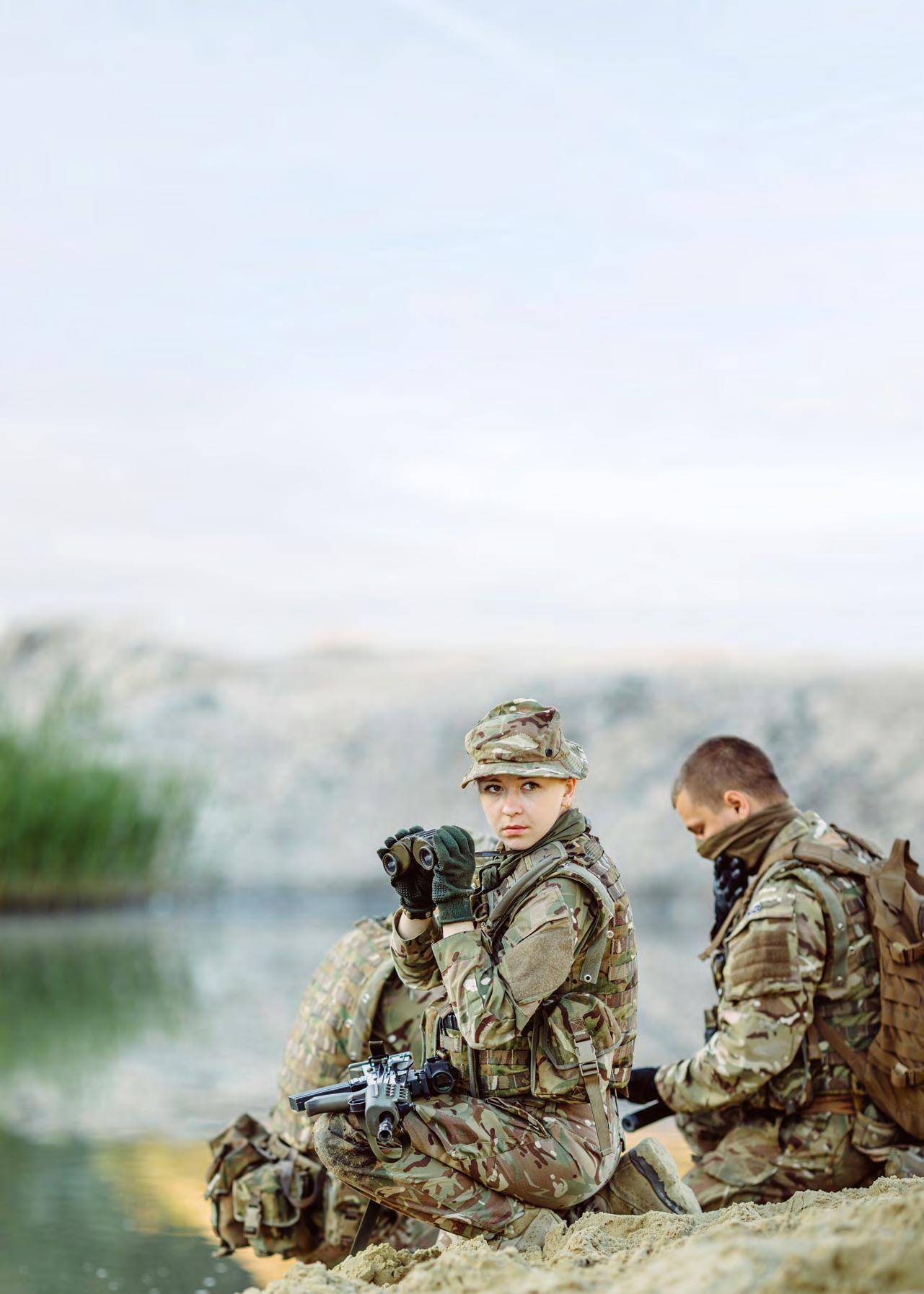

Find out more dhl.co.uk/ serviceleavers
































































































































































